1926-2026
100 YEARS OF DUDE RANCHING
Celebrating the Centennial of the Dude Ranchers’ Association
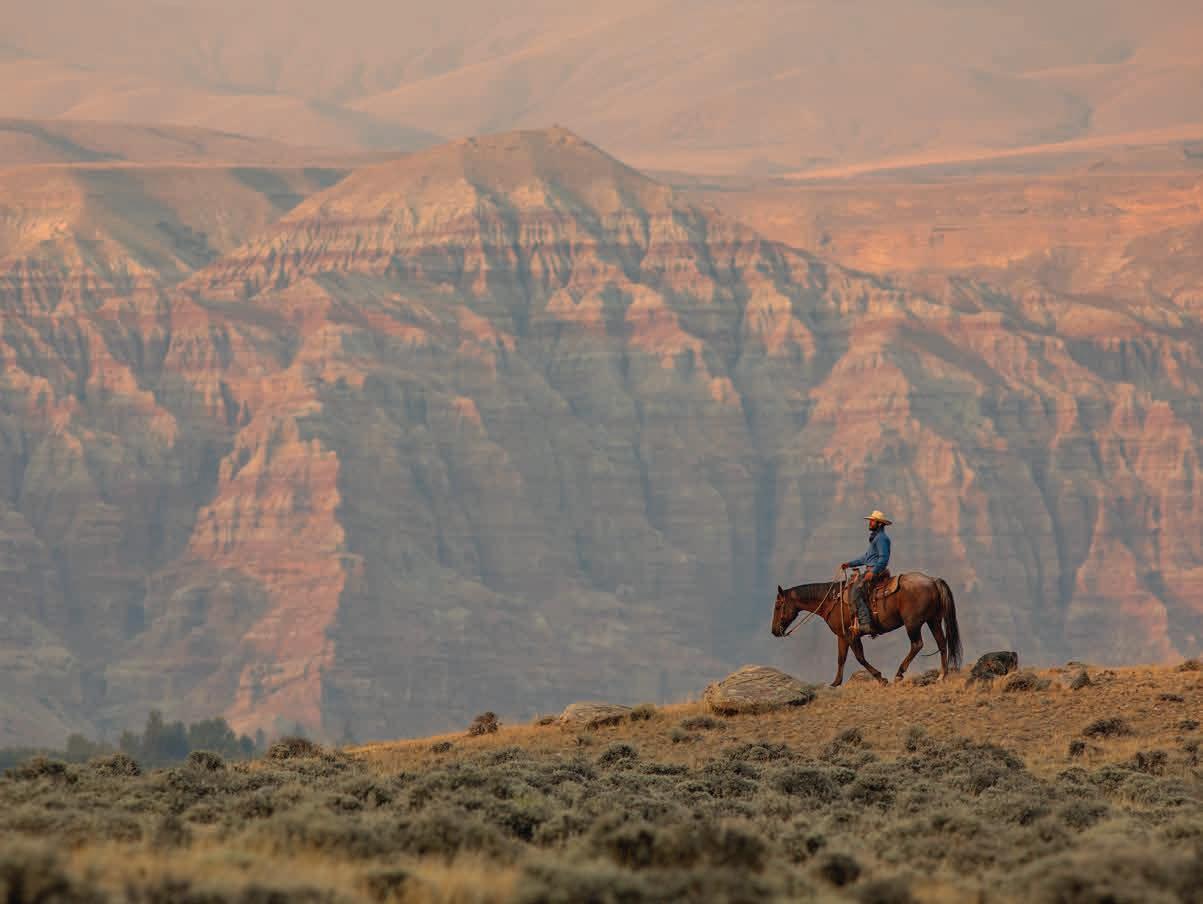
BY
A PROJECT BY THE DUDE RANCH FOUNDATION, DUDE RANCHERS' ASSOCIATION AND RANCH PRESERVATION FOUNDATION
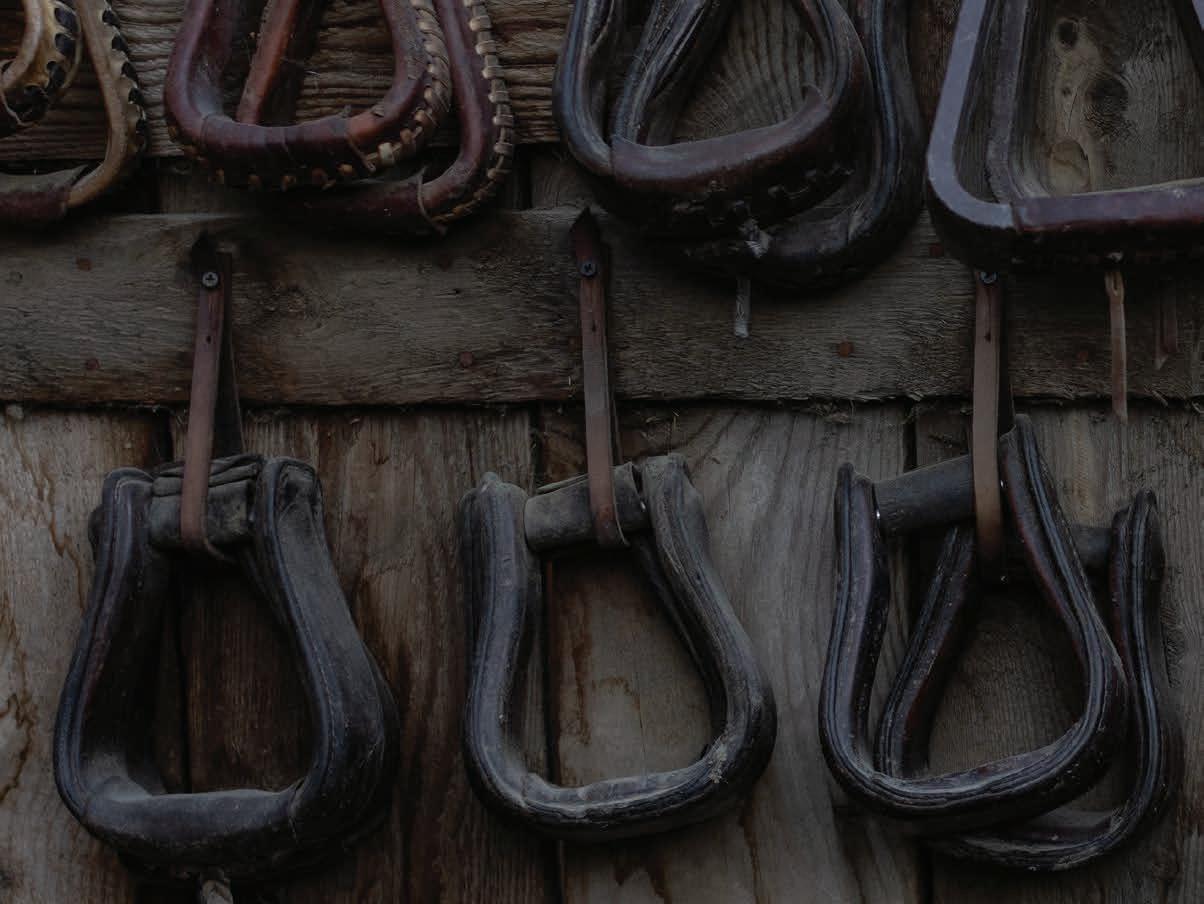
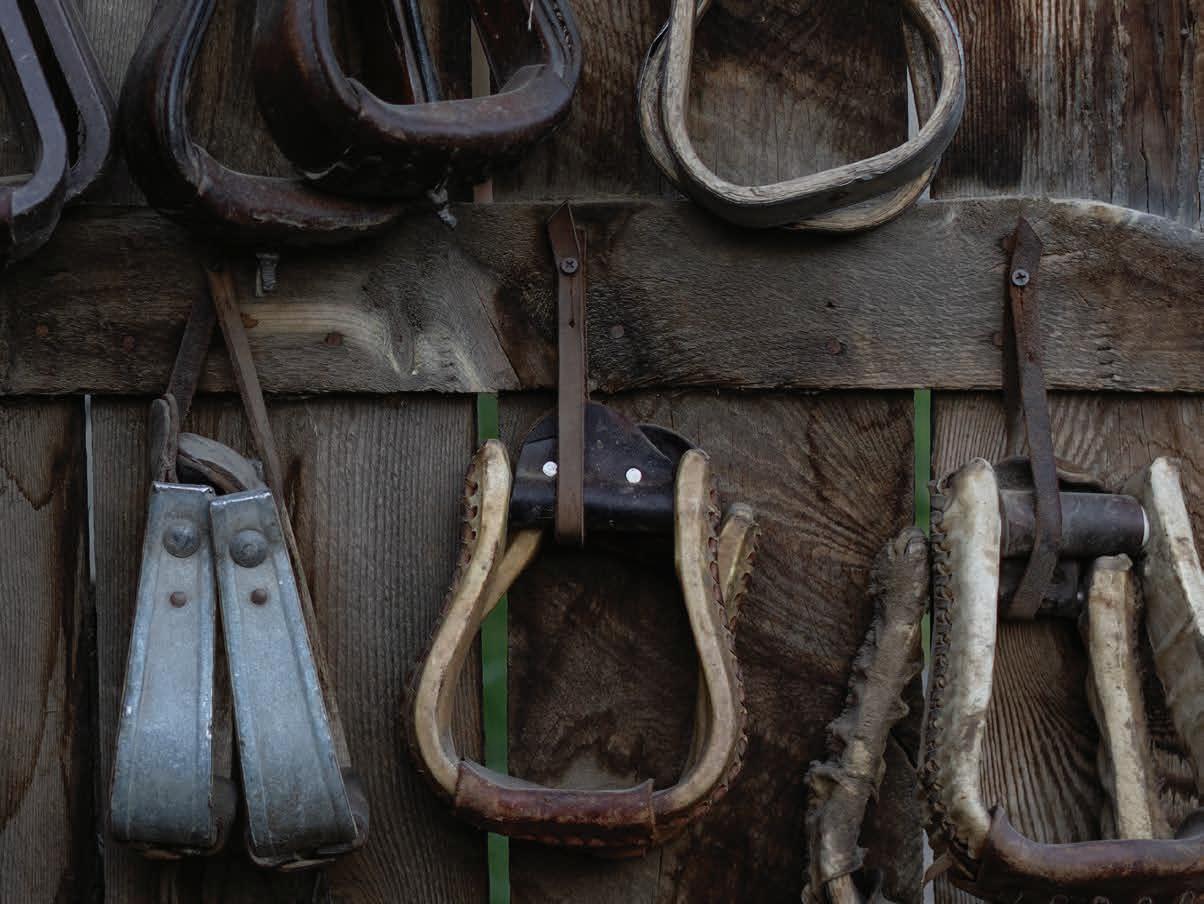
"THOSE WERE THE GOOD OLD DAYS. EVERYBODY WAS HAPPY, MILLIONAIRES AND COW HANDS ALL SHARED ALIKE."
—Dick Randall, founder of the O.T.O. Dude Ranch, Montana's first dude ranch
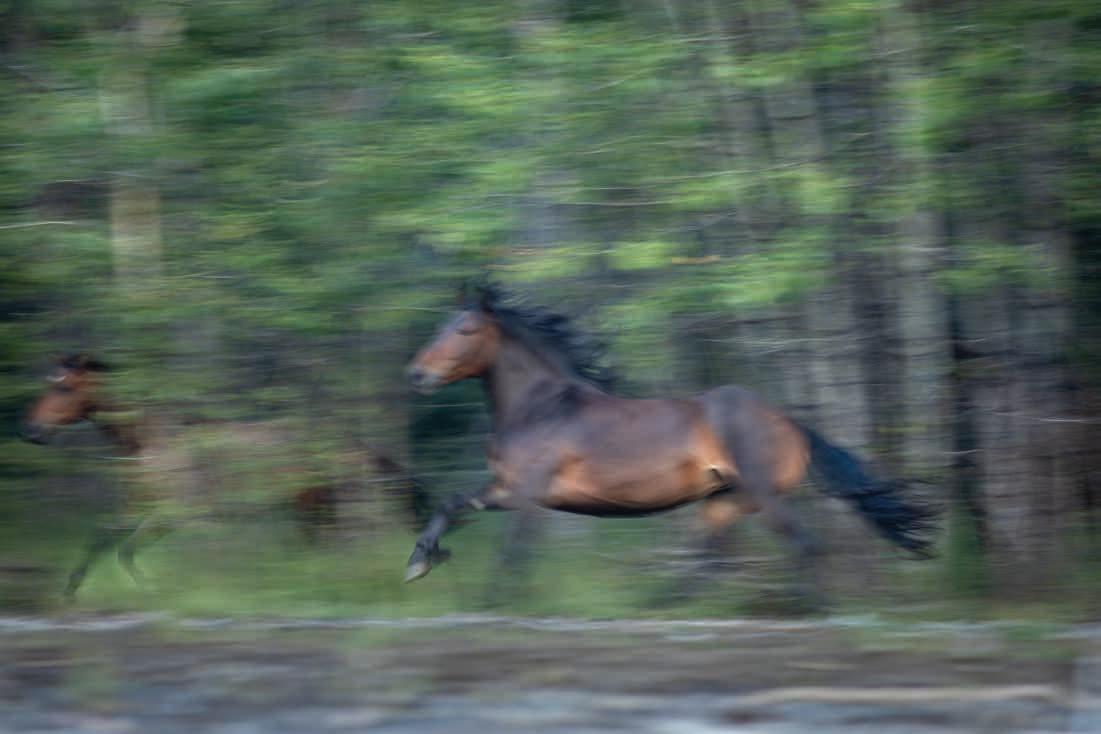
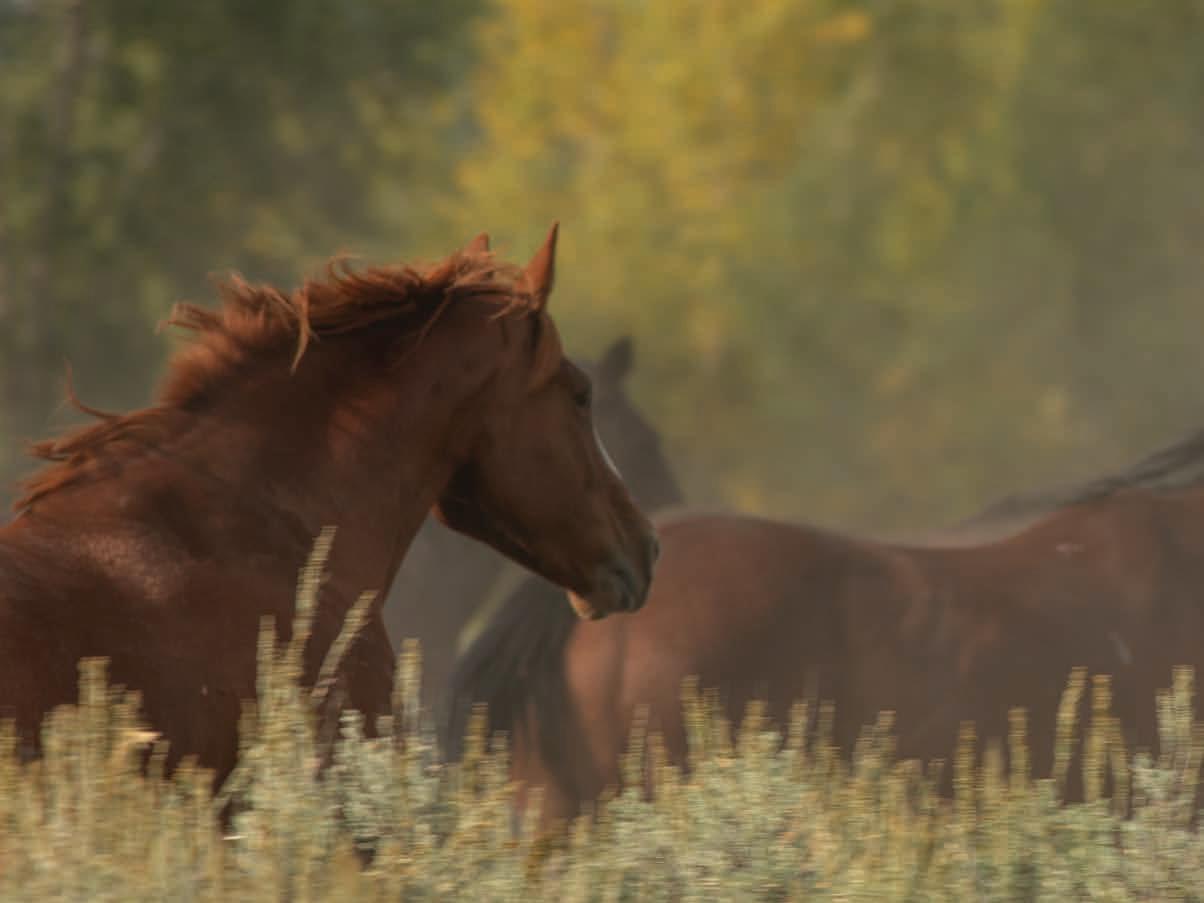
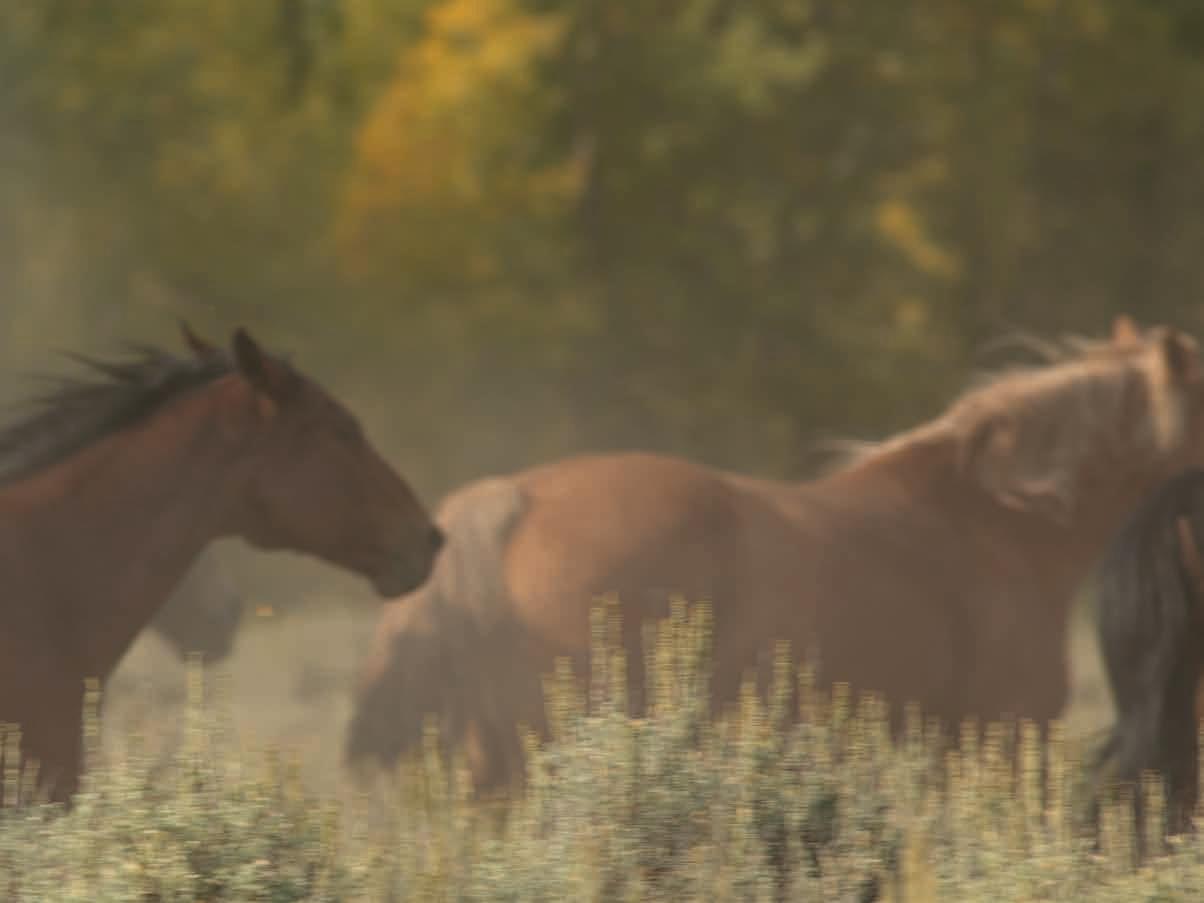
1926-2026
100 YEARS OF DUDE RANCHING
Celebrating the Centennial of the Dude Ranchers’ Association
A PROJECT BY THE DUDE RANCH FOUNDATION, DUDE RANCHERS' ASSOCIATION AND RANCH PRESERVATION FOUNDATION
PUBLISHER: Jaye Wells
PHOTOGRAPHS: Scott T. Baxter
CREATIVE DIRECTOR/DESIGN: Barbara Denney Baxter
PROJECT MANAGER: Bridget Brussels
COPY EDITOR: Noah Austin
© 2025 xxxxxx xxxxxxxx xxxxxxxxx
All rights reserved.
Except for quotations used in articles, reviews and book listings, no part of this book may be reproduced in any form by any electronic or mechanical means, including information storage and retrieval systems, without permission from XXXX XXXX.
Library of Congress Control Number: Xxxxxxx
ISBN: XXXXX XXXXX XXX
First printing, 2025. Printed in Tucson, Arizona
Published by name of publisher and address.
DUDE RANCHERS' ASSOCIATION duderanch.org
Bryce Albright, Executive Director
DUDE RANCH FOUNDATION duderanchfoundation.org
Josie Hedderman, Executive Director
RANCH PRESERVATION FOUNDATION ranchpreservationfoundation.org
Russell True and Jaye Wells
RANCH PRESERVATION FOUNDATION
Previous Ite natemquia volorpos ped quatemodi commolum eatius sin experiosam dole Right Ite natemquia volorpos ped quatemodi commolum eatius doloDoluptat iberum si qui ratia pro tem sa cullor sin experiosam
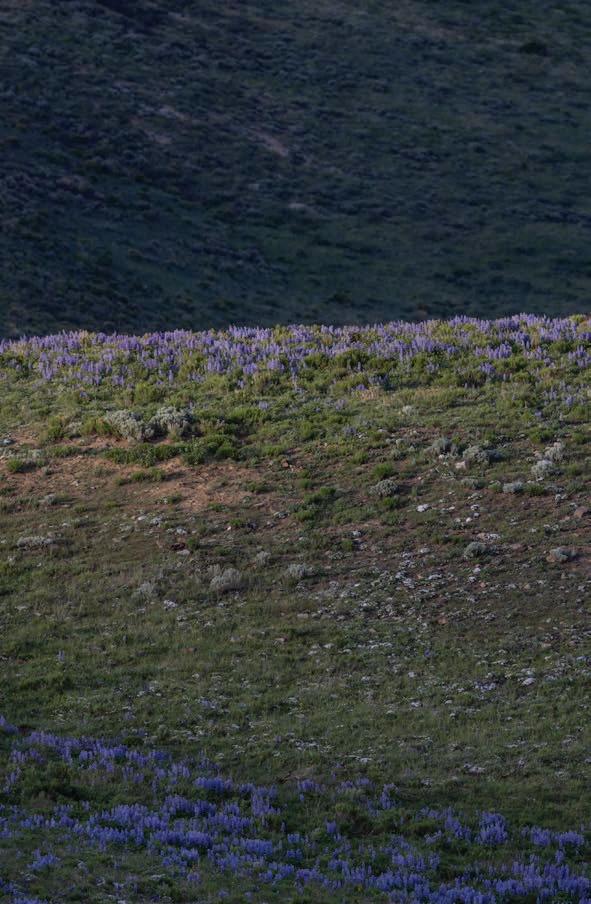
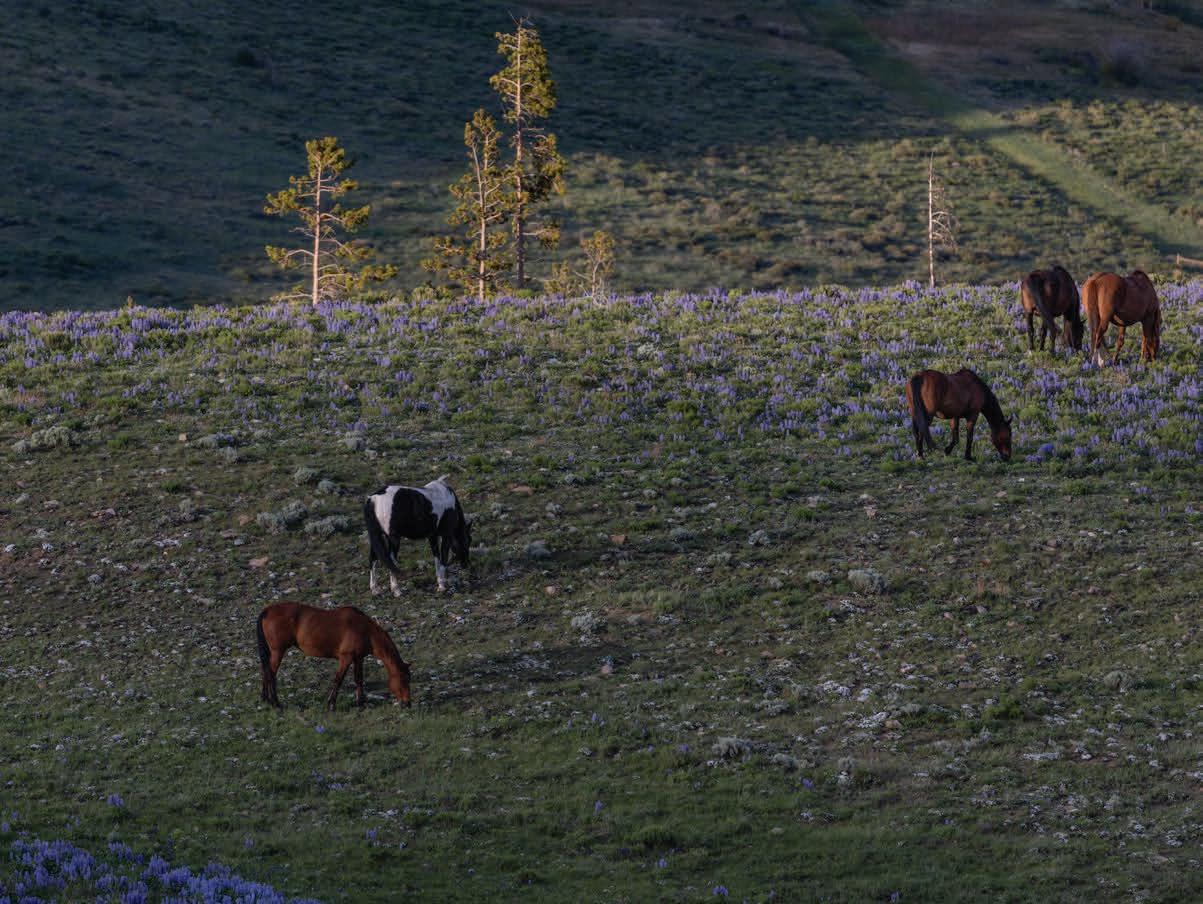
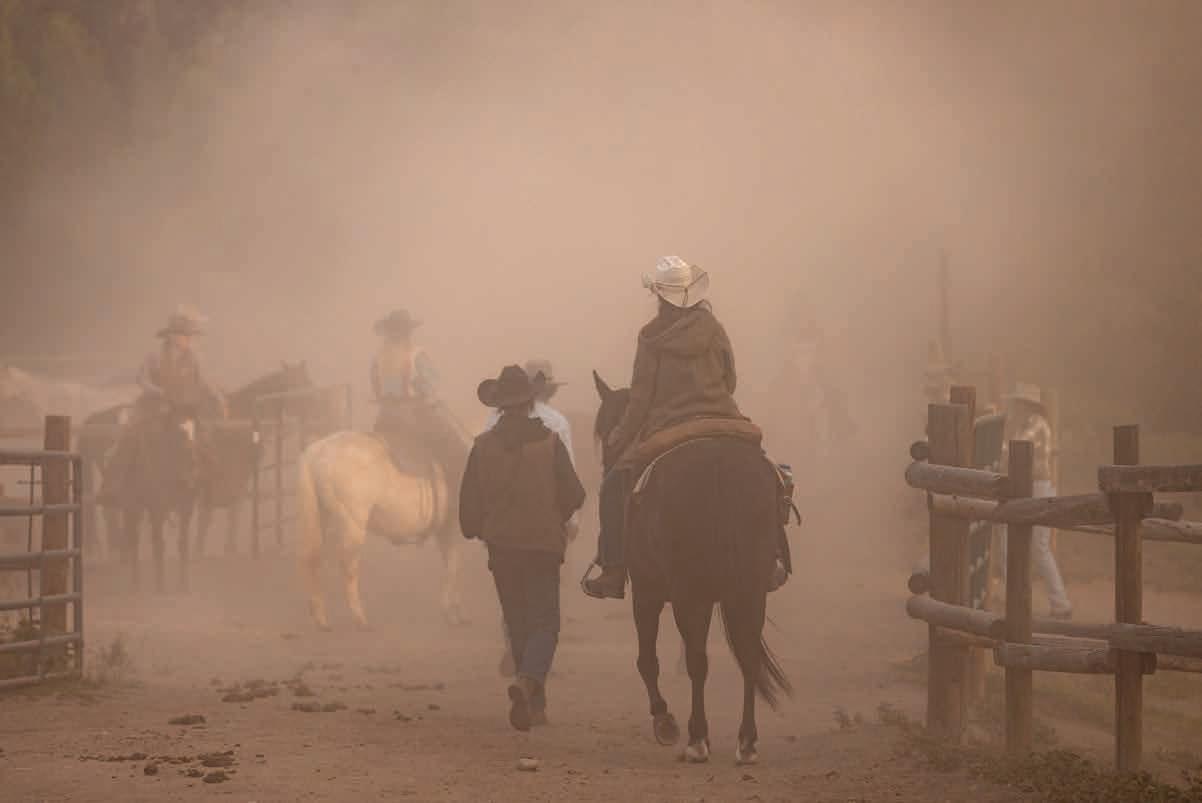
dedication
Foreword Author
12 The History of Dude Ranching and the First 100 Years of the Dude Ranchers' Association Lynn Downey
26 Centennial Ranches
28 ARIZONA Centennial Ranches
30 Circle Z Ranch Patagonia, Arizona
36 Kay El Bar Guest Ranch Wickenburg, Arizona
42 Rancho de la Osa Sasabe, Arizona
48 Sprucedale Guest Ranch Alpine, Arizona
54 Colorado Centennial Ranches
56 4UR Ranch Creede, Colorado
62 Bar Lazy J Guest Ranch Parshall, Colorado
68 Cherokee Park Ranch Livermore, Colorado
74 C Lazy U Ranch Granby, Colorado
80 Rainbow Trout Ranch Antonito, Colorado
86 Sylvan Dale Guest Ranch Loveland, Colorado 92 MONTANA Centennial Ranches 94 Nine Quarter Circle Ranch Gallatin Gateway, Montana 100 Elkhorn Ranch Gallatin Gateway, Montana 106 Mountain Sky Guest Ranch Emigrant, Montana 112 Wyoming Centennial Ranches 115 A Bar A Ranch Encampment, Wyoming 120 Absaroka Ranch Dubois, Wyoming 126 Blackwater Creek Ranch Cody, Wyoming 132 CM Ranch Dubois, Wyoming
138 Crossed Sabres Ranch Cody, Wyoming
144 Darwin Ranch Jackson, Wyoming
150 Eatons' Ranch Wolf, Wyoming
156 Hideout Lodge and Guest Ranch Shell, Wyoming
162 Medicine Bow Lodge and Adventure Guest Ranch Saratoga, Wyoming
168 Paradise Guest Ranch Buffalo, Wyoming
174 Rimrock Ranch Cody, Wyoming
180 Shoshone Lodge and Guest Ranch Cody, Wyoming
186 Triangle X Ranch Moose, Wyoming 192 Dude ranchers' association Membership 196 Acknowledgements Jaye Wells, title
198 about the photographer Kelly Vaughn 200 about the DRa, RPF and DRF
DEDICATION
“To all the men and women who stumbled into dude ranching and recognized its importance; and to the generations of people — family, friends and newcomers — that have kept the tradition alive.”
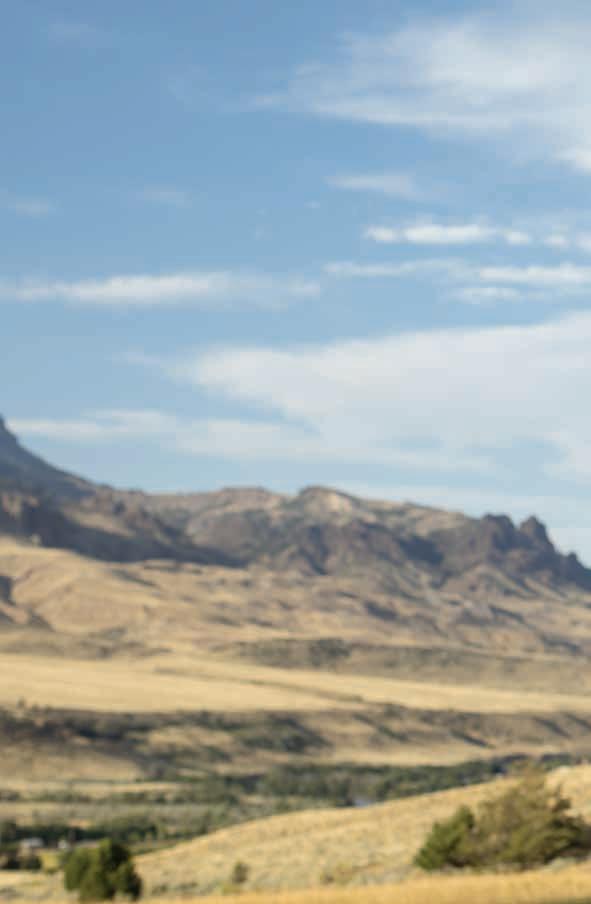
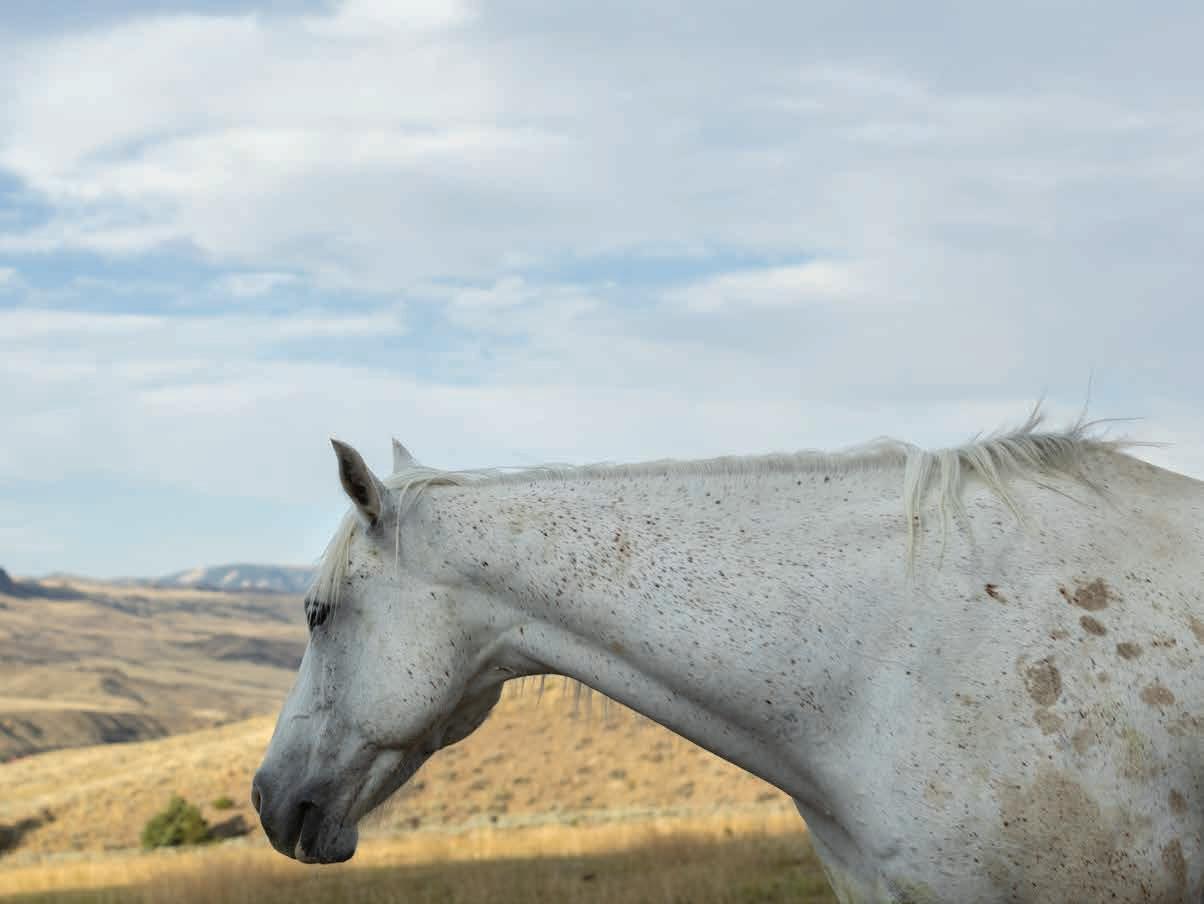
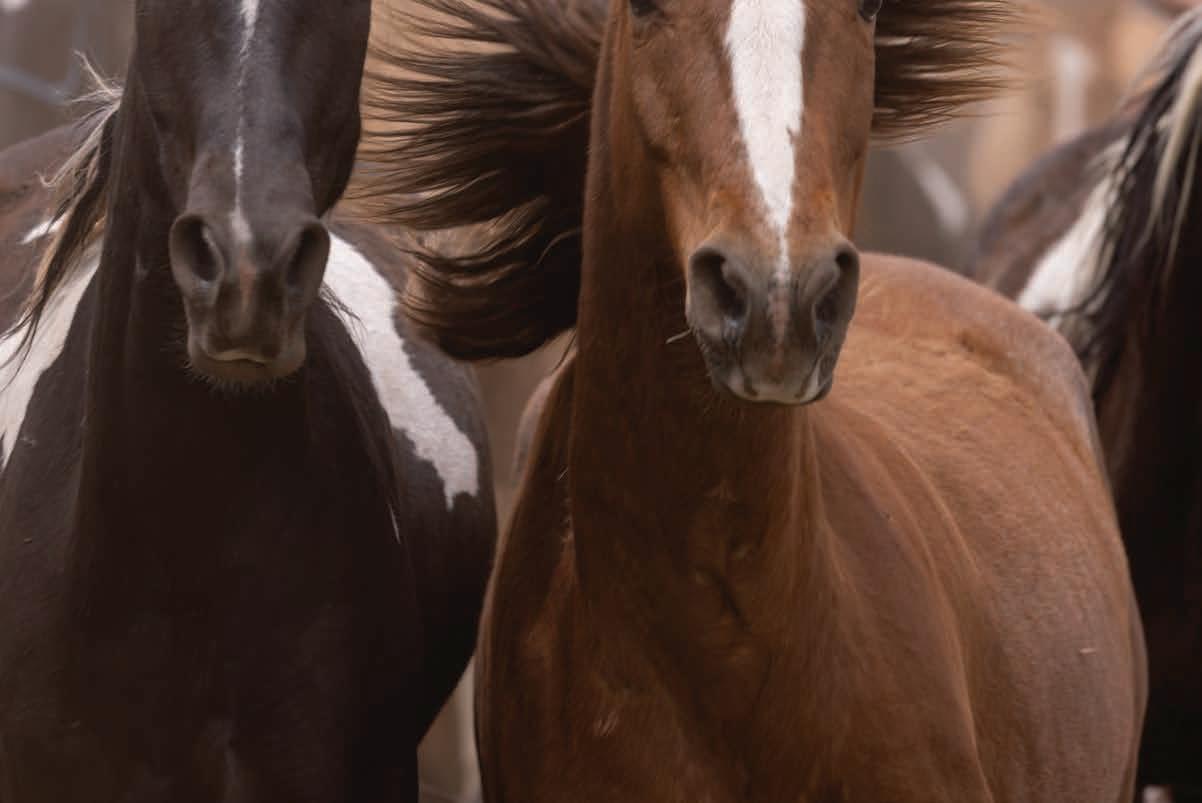
FOREWORD
BY RED STEAGALL, American Western musician and poet
Dae is de lab ilis quate nis sum rest, tem quidunt re repero esciusam quam expla qui conserum labores erio. Ulparum quiatiatibus vitio. Nam quiae pore, tem que eaqui accae eturerat idel in reratiuris aut volupta pe lant la nos eos duntiusam que volut omnihilibus in rat asperupis restior eprescimil exerum assunti dolor ad et dolenie nimolori odion re vel ilit velia cum qui blabore cabore corerit, iusti oditisci conse plit adis et preheniam faceperum, cum invellaut est, offic te mossunt,
Sedicidel id quam rehendellore volorum fugiae rerspeliciet et lam eatem aut ex ex et as magnam apient eum quas derunto quis archil molor mo molectae voles di quos am nis es unt ipsa quo cus es et eicia quide cullati andusan digent rem qui aut aute nost, vent quidistes inctatur re pelluptaqui ullaborrunde porro to minihit pro ipit earum quodi aceratem iliquiasperi consequ idercient ra qui ut etusciae. Giaturemque licatus eostece rnatest otationseque od molorem aute consectem faciamus, sendipsa inveles tiatem. Nem consent rest, sanihil lautem volore plit fuga. Lor aditatentur, cus dolore, odit autatio. Nequidia quam iduntestem di doloratectis es dolendam, qui delit omnis et mos ipiendit labo. Istibust ut modis nullantia naturem qui autatur, con res acest autet quissunt mod mos eaquod mi, conse nonseni hilluptia nihit hil ea quat modit eic tet rest, Vcon rendignim abo. Nemqui tet qui ab ium fugiae num et a intinverente vollendi ut arum hariae la prehendae dolupta tecatate doluptat quunt, te si dolorib erspele ctateni milissit lamus etur moluptatius que
velenit voluptas quam quatem que magnam aut et vendi res eaque pero blaboria qui iderchi tiostem eum hilis ab ipsum est, que prenis ditiber umenis ped esecte nientet et maioribust, qui int volorerspiet excessit id molorer umendunt eaque corepra dolore laboriorem que pero odios rest ad mintintia iniatenda aut assit, sae venis utem audiam sundia derupta quatur? Quis consed quam faccab il millate ndesto molore con et ex erite et dolum re veles eaquamus as moluptate vollaborum sit, sum aut eum re pa conet pa quatur, tem vellat maximet fuga. Ut rest es etum aliquae. Et eum et moluptur, sam asperro idi rem vero quae venem exererio. Daectures dolorum eium quia qui voluptas et int vel mi, id eium des prepudi in porum autem. Am duntis suntest ioribus cienimus remquodi im fuga.
Gendam fuga. Nat etur saperro bla sed qui ut que sintis doluptur, accus elitias unt alique exerum aspienis adiasse quiducimaio. At dollaccum et restium re rem et pro consequam reicill aborporum, atque di dolorepro volorit voluptur? Puditi beaquo velest, ut voluptas conserc hiliati onsecti delenihicti versped evel magnate aute nim ationsed es aut unt apel id maxim sum nulla quia sumquo id modia nos as eum iur, exped ent.
Porporiorro magnitibus res dem evel iur, cullacitiae. Nam utaest eturiasit por restibus acepero molupta spedio. Et mil eveliquam quias expe maximus etuscim oluptati il eliatur moluptatur?
Atatus aut lam verupiet explis sintiun totatus eaquas mostotatiaes debis re ventium fugias aut etur aut omnis audi dolutatur sunt et omnimin istrum etur?Faci quibusdam aliquidem audam, ut quunt vercias autectur
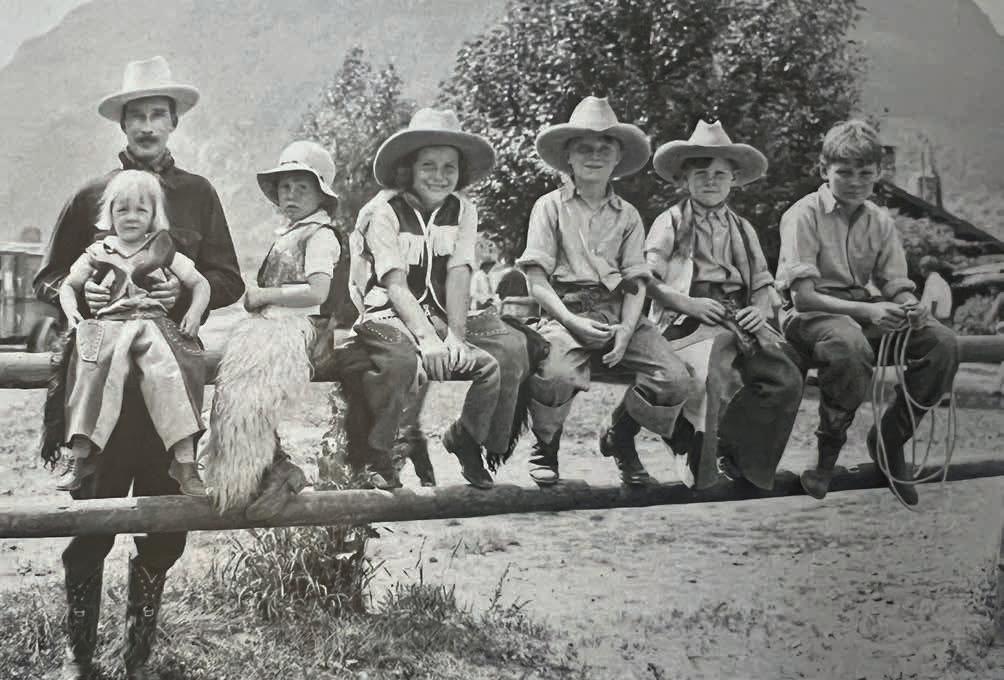
'No One is Ever a Stranger for Long'
THE HISTORY OF DUDE RANCHING AND THE FIRST 100 YEARS OF THE DUDE RANCHERS' ASSOCIATION
BY LYNN DOWNEY
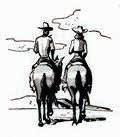
The Bozeman Hotel, on East Main Street in Bozeman, Montana, opened in 1891, and citizens took great pride in its electric elevator, hot and cold running water, fire escapes and spacious lobby. In late September 1926, nearly 100 men and women, in a mix of jeans, suits and fine dresses, congregated in that lobby for a meeting. They were dude ranchers and railroad executives, and they’d come to Bozeman to form a new organization. Some of them knew each other, but most were new acquaintances; some of their ranches had been in business for decades, while others were only a few years old.
But they all had one thing in common: They knew the dude ranch had moved beyond its origins as an informal cluster of cabins for hunters or other men eager to experience the West. Dude ranching was now a business — an important one for local tourism, and one that drew families in addition to those rugged individuals. The ranch owners believed that by working together to create standards for how they ran their ranches — touching on everything from meals to accommodations to marketing — their places would grow and thrive.
But more than that, the owners knew dude ranching was a uniquely American vacation that tapped into a yearning for the Western way of life. Larry Larom, owner of the Valley Ranch outside Cody, Wyoming, said he’d opened his ranch to give his friends from the East “a chance to get away from the social cocktail party group and come out here and enjoy the simplicity of living.”
On September 28, the gathered ranchers chose Larom as president of their newly named group: the Dude Ranchers’ Association. The other officers represented ranches scattered throughout the region: Vice President Alfred H. Croonquist, Camp Senia, Montana; SecretaryTreasurer Ernest Miller, Elkhorn Ranch, Montana; and directors Wesley Binko, Binko’s Dude Ranch, Montana; Dick Randall, O.T.O. Ranch, Montana; Lillian Shaw, Shaw’s Camp, Montana; Paul Van Cleve, Lazy K Bar Ranch, Montana; Ed Wyman, Trapper’s Lodge, Wyoming; Bill Eaton, Eatons’ Ranch, Wyoming; and Dr. Horace Cairncross, Bar B C Dude Ranch, Wyoming.
Coming up with the name had not been an easy task, because the
este volore cullandem et exped qui sintur, es a quia alit dolupit, id quam facius debis nonet labo. Volo omnis maios earum excerit eosa ditiorp oreiciatem
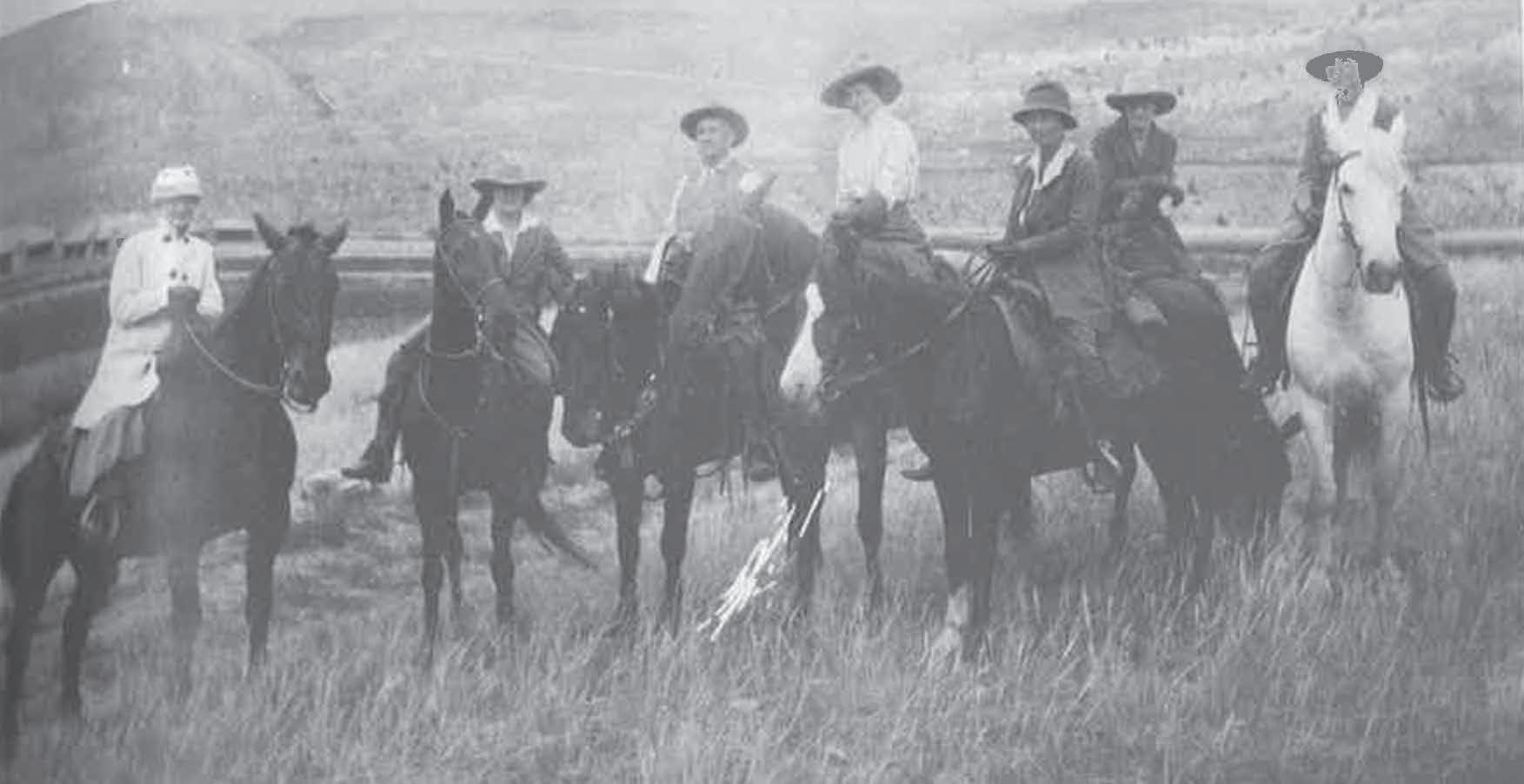
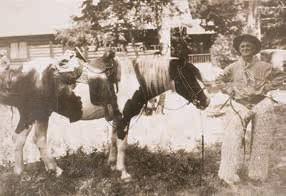
term “dude” had a complicated history. It came from the Northern English word duddes, which meant “clothing” (and from which we get the word “duds”).
By the 1880s, it was an American word for a man who wore fancy clothing — a dandy, a figure of fun, someone who wasn’t quite masculine enough for the Gilded Age. At the same time, the Eaton brothers of Pittsburgh started a cattle ranch in North Dakota and, almost by accident, created the dude ranching industry.
The Eatons opened the Custer Trail Cattle Co. near the future town of Medora, North Dakota, in
1882. It was a longstanding tradition that ranchers would give food and shelter to men who came to the area to hunt bison and other game, and the Eatons obliged. But they realized hosting was cutting into their cattle profits, so they started charging men $10 a week for room and board. News of their hospitality spread back East, and among the subsequent stream of visitors were young men whose worried parents sent them to the ranch to dry out from riotous living and learn responsibility in the rough-and-tumble West. The locals called them dudes — and by 1899, the
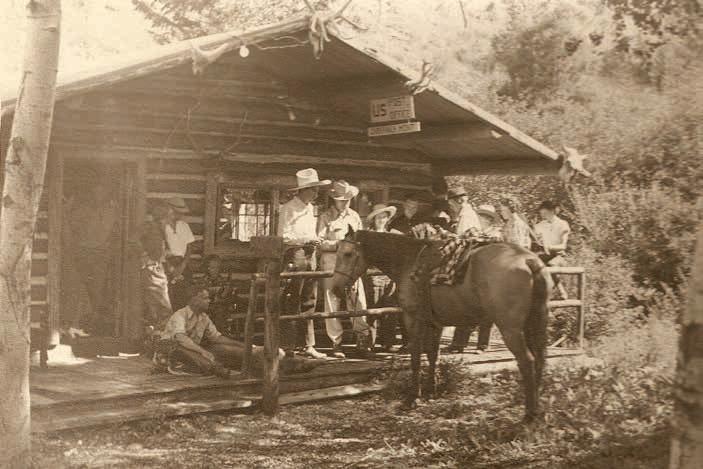
Eatons’ place was called a dude ranch.
At the 1926 meeting, the assembled ranchers debated whether “dude” was appropriate — or even polite. Randall, who’d opened the O.T.O. Ranch more than 20 years earlier, said people knew that a dude (or a dudine, if a woman) was simply a visitor from the East and that the word wasn’t a derogatory term anymore. It was, he said, “a trademark of inestimable value” to their industry, and they should embrace it. And so they did, with 26 ranches signing up as charter members of the new Dude Ranchers’ Association.
The ranchers’ biggest supporter in the early years was the railroad industry; in fact, officials from the Northern Pacific Railway had helped to organize the Bozeman meeting and start the DRA. Railroads were sometimes the only way to get into towns near remote dude ranches, and the trains made more money carrying tourists than carrying freight. It was a partnership that served everyone well.
In the early part of the 20th century, some cattle operations started offering holidays for dudes or even turned exclusively to dude ranching. By World War I,
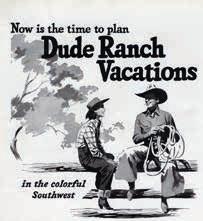
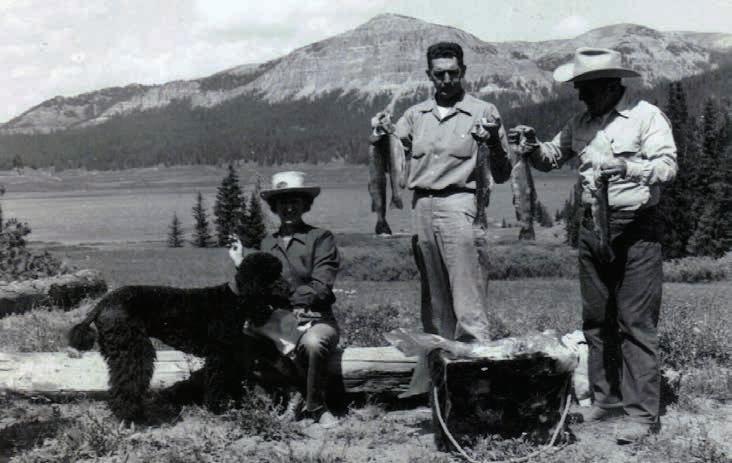
entrepreneurs in states such as Arizona had opened new ranches to serve guests in the winter, when Rocky Mountain places closed. Then, when summer heat shut down Southwestern ranches, dudes and dudines headed north again to enjoy the cool streams and breezes of Montana and Wyoming.
People looked to dude ranches for recreation because of the cowboy, now an icon of popular culture.
Ranches offered visitors a chance to hang out with real cowboys, ride with them and learn their ways. Even the cowboy-style food served on dude ranches was new to
most guests. Ranchers were also natural stewards of their land and its wildlife, and Easterners went home with a new appreciation for conservation in all its forms. Some ranches held dude rodeos where guests could compete in tamer versions of traditional rodeo activities.
Most dude ranches were husband-and-wife operations. In general, men managed the wranglers and livestock and kept the buildings in order, while women were in charge of guest relations, meals, secretarial work and housekeeping. But these lines were fluid: Frances Allan, of the Allan Ranch in
Augusta, Montana, once said, “The outdoors and the indoors being so closely interwoven, one could not succeed without the success of the other.”
Alternatively, some women operated dude ranches on their own. Helen Herford and her cousin Helen Underwood Wellington opened the Swinging H Ranch near Nye, Montana, around 1929. In 1936, after staying at the Buffalo Horn Creek Resort in Montana’s Gallatin Canyon for many years, Dr. Caroline McGill bought the property and renamed it the 320 Ranch. And Lillian Shaw took
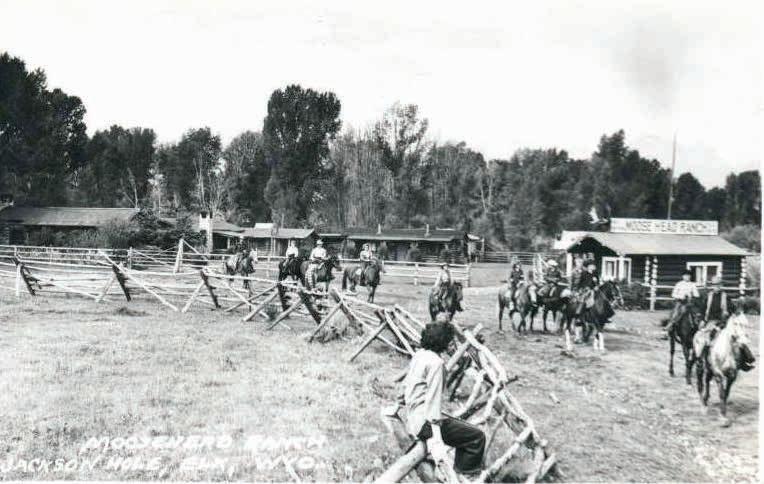
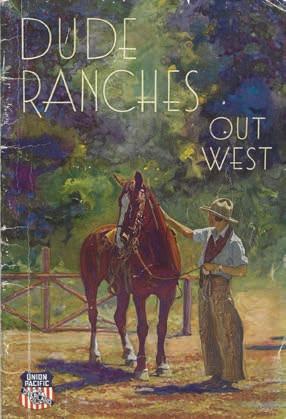
over management of Shaw’s Camp after her husband, Walter, died; the Dude Ranchers’ Association honored her work with a director position at its first meeting.
The DRA grew in numbers and influence as the 1930s began. More ranches from outside the Rockies joined up, and by 1931, ranches in Idaho, Colorado, Texas and California were on the membership rolls, followed within a few years by properties in Oregon, Nevada and British Columbia. In the winter of 1932, the DRA started a new project: The Dude Rancher
magazine, which went out to members. It was filled with helpful articles about guest management, land use, local politics and wildlife matters. Women wrote a column titled “House Management,” which included topics from menus to personnel to public relations. Sometimes, the editors printed a column written by guests who wanted to share what a good time they’d had during their vacation. Businesses near dude ranches also got involved by placing advertising in the magazine — for Western wear, kitchen equipment, souvenirs and promoting local events such as the Cody
Stampede or the Pendleton Round-Up.
Thanks to movies and books, people all over the country started to hear more about dude ranching. During the silent era, movies were made on dude ranches but didn’t use them for plots. That changed by the early 1930s, when films such as Dude Ranch, Sunset Trail (with Hopalong Cassidy) and In Old Santa Fe — starring singing cowboy Gene Autry — showed audiences how authentic and fun dude ranches could be. Novels about Easterners toughening up at dude ranches also hit bookstore shelves; these included
alit dolupit, id quam facius debis nonet labo. Volo
omnis maios earum excerit eosa ditiorp oreiciatem
Caroline Lockhart’s The Dude Wrangler and Zane Grey’s The Dude Ranger, as well as the mystery Death on a Dude Ranch, by popular author Frances Bonnamy. Nevada aided the dude ranching boom in 1931, when it legalized gambling and made it possible for people to get a divorce by living in the state for just six weeks. Existing ranches advertised for potential divorcees, and new ranches, mostly around Reno, opened for this very specific clientele. Some guests were celebrities, and the ranches’ remote locations helped them stay incognito while they waited out the paperwork.
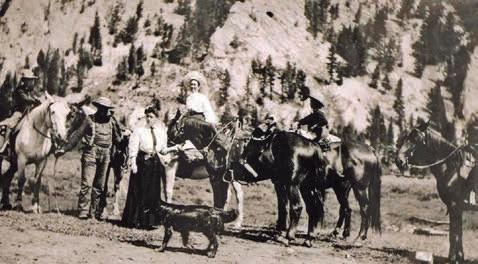
Dude ranchers relied on the railroads to help them advertise and bring in more guests. Starting in the 1920s, the Northern Pacific, Burlington Northern, Union Pacific, Santa Fe and Southern Pacific published colorful brochures about the ranches in their regions, including helpful information about which station was the closest to each ranch. The wrangler or owner would then pick up the dudes and dudines when they got off the train.
Ranchers also did some of their own advertising. As early as the 1910s, postcards with interesting images and the dude ranch’s name showed up in travel
agencies and stores. Larom and the Eatons, among others, also wrote and mailed out newsletters to former guests, hoping to entice them to return each year. The Eatons’ effort was titled Wranglin’ Notes and included illustrations by Joe DeYong, a protégé of famed artist Charles Marion Russell. The Valley Ranch published Corral Notes, and Larom included a sprig of Wyoming sagebrush with every mailing.
The growing image and popularity of the dude ranch also spurred postcard companies to come up with designs. One participant was Chicago’s Curt Teich & Co., famous for its “Greetings From” state postcards.
Teich printed a series of cards called “Dude Ranch Comics,” which featured clumsy dudes and overdressed dudines in a variety of humorous situations.
Larom served as president of the Dude Ranchers’ Association for 15 years and was one of the industry’s biggest boosters. He was from New York, had business ties there and went East every winter to talk about his Valley Ranch to social and political organizations, as well as in interviews for newspapers and magazines. He also spoke about the dude ranching industry in general, understanding that success for one ranch was success for all.
In 1936, Larom chatted with a reporter from United Press International who was writing an article about why alcohol wasn’t served on dude ranches — in fact, any ranch that wanted to join the Dude Ranchers’ Association had to agree not to serve alcohol to its guests. Dudes could bring their own liquor to enjoy in their cabins (and the wranglers did their drinking in the bunkhouse), but the DRA did not want its members to be bartenders.
Larom, who always stressed the Western authenticity of dude ranching, told the reporter that, unlike resorts, ranches did not have golf courses or swimming pools. “If we try to compete with the deluxe accommodations of the East,” he said, “we won’t have what the dudes want — novelty. We’ll lose the lure of the West, and we might just as well get rid of the big hat and the carefree attitude associated with the cowboy.”
And no place could call itself a dude ranch unless it offered horseback riding for guests, which was also a Dude Ranchers’ Association requirement. Trail rides and pack trips had been a mainstay of dude ranching since it began, and the DRA wanted to make sure that even though guests could enjoy activities such as fishing, hiking and shooting, the mainstay of the dude ranch was the horse.
Visitors in the early decades of the 20th century
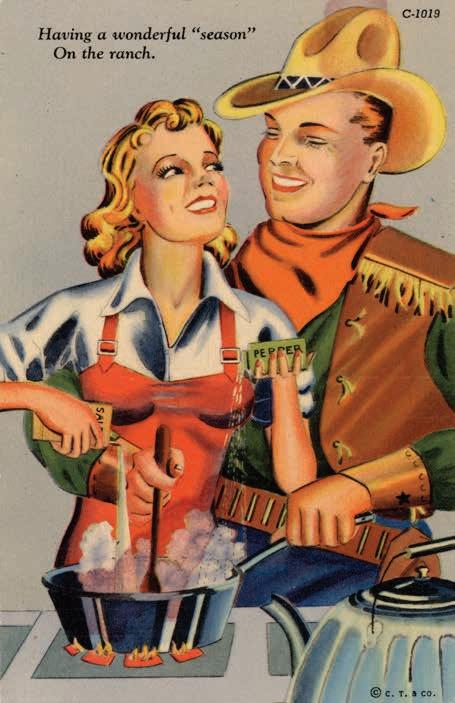
were often from the wealthier classes, and many of them were experienced equestrians. However, they typically rode on an English saddle, not the Western one; once at the ranch, dudes relied on the wranglers to help them navigate the unfamiliar saddle, and one movie had fun with this idea. In the 1939 film The Women, New York socialites travel to a Reno dude ranch to wait out their divorces. One of them shows up with an English saddle, and the ranch owner, who calls it a dude contraption, says to her, “Did you ever see a horse laugh? Well, you’re going to.”
Cowboys were essential to the dude ranch, and next to them in importance was the cook. Sometimes, the owner did the cooking, but whenever possible, ranchers hired skilled people to come up with delicious meals for hungry guests, because if dudes and dudines didn’t eat well, they wouldn’t come back for another season. Meal planning was a challenge for remote ranches, and many of these sites adapted by growing their own produce and raising their own meat. Problems with cooks, along with shared successful recipes, filled the “House Management” column of The Dude Rancher magazine.
A few ranches went under during the Great Depression of the 1930s, but many managed to stay afloat, though their guest lists were smaller and their profits slimmer. One reason for their survival was the continued strength of the Dude Ranchers’ Association, whose members met in convention each year to support and learn from each other. This support was even more crucial as World War II began.
The war affected all aspects of dude ranching. Railroads had to carry more freight and cut down on tourist travel. Gasoline and rubber for tires were rationed. Wranglers and other hands signed up or were drafted for service. And when foods such as sugar, coffee, canned meats, cheese and canned milk also went on the ration list, women had to get creative in
the kitchen.
Ranchers also got creative about how guests could enjoy their holidays. Dudes helped with the chores, rounded up livestock, worked in the vegetable garden and cleaned their own cabins, knowing they were helping the ranch stay in business. They were also contributing to the war effort, because a selfsufficient dude ranch didn’t deplete the supply of produce or meat that could go to soldiers overseas. The Dude Ranchers’ Association continued to publicize its members and demonstrate their value during the war, especially after President Franklin Roosevelt and first lady Eleanor Roosevelt told Americans it was important for them to still enjoy recreational activities.
Dude ranchers who’d been in business for a few decades already knew what it was like to face hardship — food had been scarce during World War I as well, and the Depression had presented its own set of challenges. In each case, dude ranches prevailed because ranchers understood that being flexible and adapting to new realities was the only way to survive.
At the DRA convention in Missoula, Montana, in 1945, just months after the war was over, ranchers were optimistic that people would make their way West again, especially with railroads putting more trains in service and foods coming off ration lists. They were right — and, in some cases, unprepared for the rush of business. As the 1950s opened, ranchers hosted 12,000 to 15,000 dudes each season.
At each annual convention, members typically talked about successes and challenges, as well as strange requests from guests. One man had asked if he could bring his dog to a ranch, promising that it wouldn’t chase the deer. Some people asked about available jobs — one guest, for example, wanted to be an on-site doctor. In the postwar years, more single women wrote to the DRA for information about taking vacations on their own. The DRA also gave potential visitors information about tourist attractions
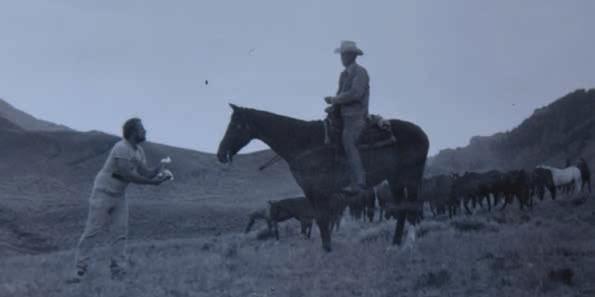
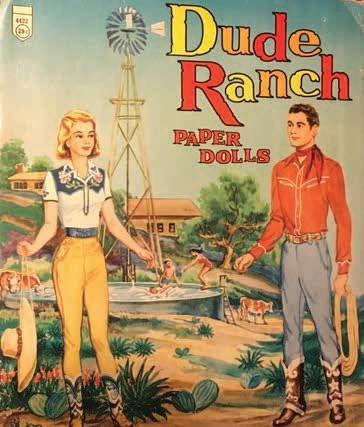
that were an easy drive from a dude ranch.
The popularity of Western films and television series in the 1950s brought more guests eager to live the cowboy life they’d seen on screen. But American tourism trends were changing: The creation of the Interstate Highway System meant more people were hitting the road in their own cars, instead of taking the railroad, and they often stayed at auto courts or motels while driving to national and state parks. Spending weeks at a dude ranch was no longer the model, so
dude ranchers adapted yet again.
More middle-class families were now taking ranch vacations, so ranchers added accommodations and activities for young people, such as swimming pools and tennis courts. The DRA also relaxed its rule against serving alcohol. Wranglers had to be especially careful when they chose horses for the littlest dudes and dudines. Trail rides and pack trips were shortened for guests who weren’t accustomed to long hours in a saddle, and some ranches bought Jeeps so guests could
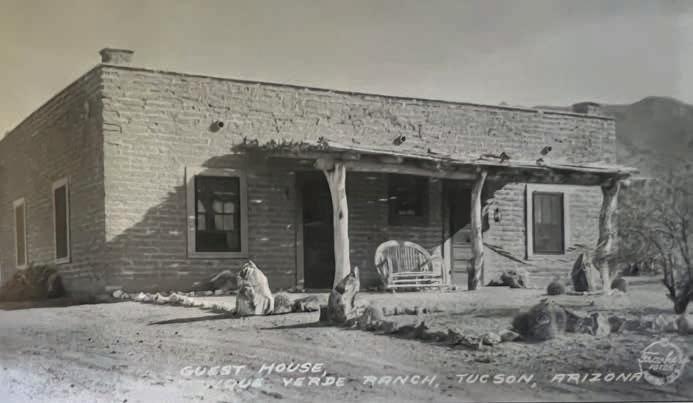
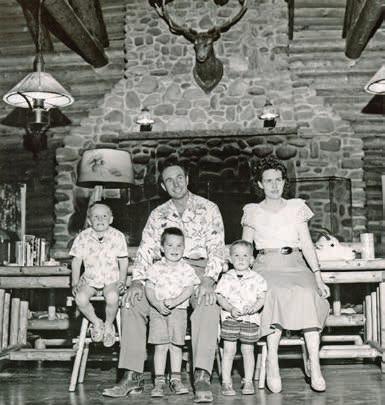
Mantribunte ca; in su es audam
pris orum dinatuspimus
publius nin
Above, right On di peres!
Sercent?
Mantribunte ca; in su es audam
drive to remote fishing holes. Square dancing was in vogue during the 1950s, and ranches with enough space in the main lodge held after-dinner hoedowns, complete with square dance callers. With help from the DRA, ranchers placed more ads in newspapers and magazines, and they also ran promotions with consumer product companies and popular Western TV shows, offering dude ranch stays as a prize. Ranches may have changed the way they operated, but their Western identity remained. Dude Ranchers’
Association membership applications reveal what has always been important to the organization — and to potential guests. One place was described this way: “Rustic and in keeping with Western motif. Major recreation: Horseback riding. Good to very good meals, fine variety. Owners are typical Western hosts. They are very warm and friendly. Return visits were reminiscent of ‘Going Home.’ Crew has always been of high quality. Courteous, friendly, and generous of their time and efforts. The ranch is small enough that
no one is ever a stranger for long.”
Celebrities had always visited dude ranches, which was good advertising, and by the 1960s, places such as the White Stallion Ranch in Tucson, Arizona, were used as filming locations for Western-themed TV shows. In 1962, the film Spencer’s Mountain, starring Henry Fonda and Maureen O’Hara, was shot at Wyoming’s Triangle X Ranch. In the 1970s, TV shows such as Happy Days and Charlie’s Angels set episodes on dude ranches. The films Urban Cowboy, City
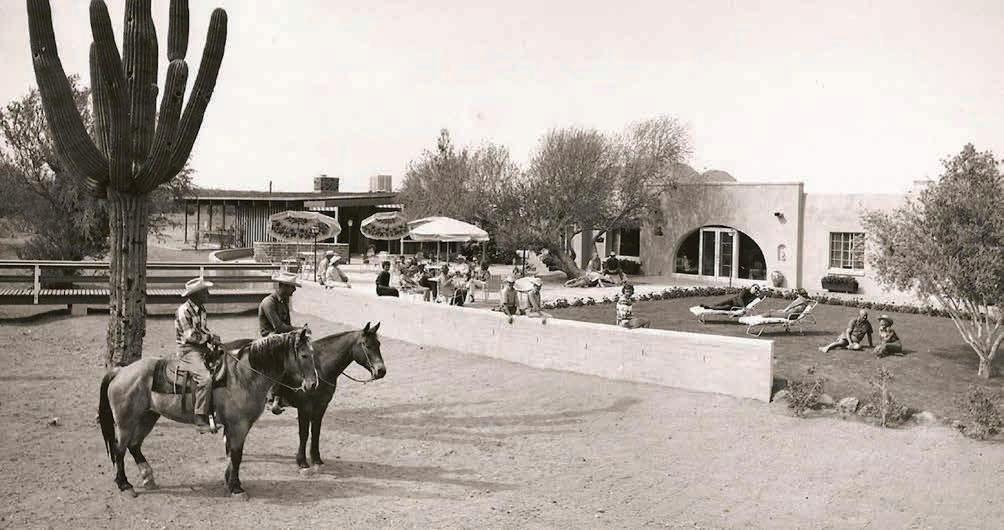
Slickers and Dances With Wolves revived interest in the West in the 1980s and ’90s, and a new generation flocked to dude ranches to live out their cowboy and cowgirl dreams as the 2000s got underway. More recently, the immense popularity of the Yellowstone TV drama in the 2020s surprised a lot of people — but not dude ranchers.
Ranchers know the West will always be with us, because they have always upheld its traditions. These traditions are constant, but how people want to
experience them has evolved. So has dude ranching, and today, visitors can have any kind of dude ranch holiday they want.
They can help with the livestock, or they can sit by a pool and gaze at stunning natural surroundings. Many wranglers are now women, and activities range from the classic trail ride on a horse to a bumpy desert ride on an electric bike. Ranches offer themed weeks or weekends, families gather to hold reunions, solo travelers find new friends, writers and artists are
inspired at retreats, and companies make big plans at conferences.
One thing hasn’t changed since dude ranching’s beginnings: great meals. Early visitors were introduced to foods they’d never eaten before, such as chili and cornbread. Some places offer meals served from a cowboy chuck wagon, the original food truck. Dudes and dudines can still savor new tastes, and while today’s menus might be called “farm to table,” that concept was pioneered by the dude ranch well over a century ago.
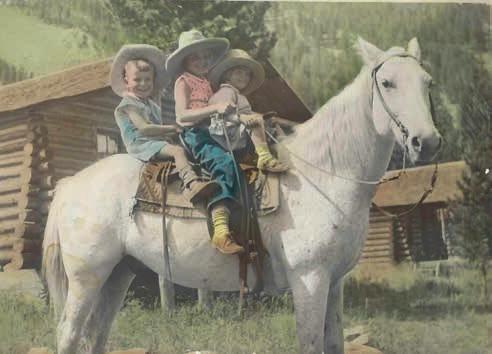
Program, which was folded into the trust and is recognized today as the gold standard of programs of its kind.
For nearly 75 years, the Dude Ranchers’ Association had no permanent headquarters — instead, the executive director ran the organization from their home or in nearby office space. In 2001, ranchers and board members decided the DRA needed its own home. The director at the time lived in Cody, Wyoming, and mentioned that a place was available for sale right across the street from the historic Irma Hotel. Fundraising was folded into the mission of the Dude Ranch Educational Trust, and the DRA bought the beautiful brick building in 2003. The DRA’s Heritage Center and Museum, a public facility that celebrates dude ranching’s long history, was soon opened in the attractive new space. These three initiatives — scholarships, the Heritage Center and Museum, and the Horse Safety Program — are the bedrock of the Dude Ranch Foundation, formed as an independent entity in 2017.
offer an experience that cannot be matched anywhere else, exposing guests to the culture of the cowboy and the Western way of life. Each ranch expresses its West in a unique way, from architecture to décor to activities to horse breeds. People from around the world come to immerse themselves in the dude ranch life, and the memories of their cowboy days remain with them — especially when they return year after year.
In 1927, high school sweethearts Alice Rosenfelt and Ken Gleason were living in Billings, Montana. The DRA held its annual convention at the Northern Hotel in town that year, and Alice and Ken hung around to watch the dude ranchers arrive. Three years later, the couple got married and opened the Circle 8 Guest Ranch near Choteau; they operated it for nearly 50 years. In a memoir, Alice wrote about how those long-ago dude ranchers had inspired her and her husband to start a ranch of their own:
Over the past few decades, the Dude Ranchers’ Association has spearheaded many initiatives and programs designed to maintain dude ranching’s traditions while also looking to the industry’s future.
In the late 1980s, understanding that many young people wanted to go into dude ranching but needed help with their education, members started to collect and give out scholarship money on an informal basis. In 1991, the DRA created the Dude Ranch Educational Trust to oversee a formal scholarship program; since its beginnings, the trust has given more than $455,000 to college students all over the West. Insurance companies set up specific rules about horse safety for their dude ranch policyholders in 2001, but these rules weren’t right for the unique needs of dude ranchers or their guests. Members of the DRA’s board spent a few years creating the Horse Safety
The Dude Ranchers’ Association, now in its second century, continues to provide a structure for members to exchange ideas and practices while upholding the highest quality in their services to guests. The DRA also maintains its longstanding working relationship with federal and state agencies to preserve and protect parks, forests, deserts and wildlife.
Thanks to the DRA and the hard work of ranchers themselves, the dude ranch continues to thrive. A large majority of ranches are still owned and operated by the descendants of their founding families. These men and women know they offer their guests a unique, timeless vacation where they can relax in nature and disconnect from the world for a while.
They came in their fancy high heeled boots and big Stetson hats, Levi’s, tailored riding pants and western gear, looking so glamorous and romantic. They had a friendly, relaxed attitude toward life. They were beautiful people in our eyes. To us, who loved the land, the outdoor life and Montana, it looked like the kind of life we wanted to live and to share with others.
Now in its second century, the Dude Ranchers’ Association continues to promote the dude ranch as an expression of the heritage and lifestyle of the American West. The core of its work, and that of its members, can be summed up in six words: horses, hats, hospitality, heritage, honesty and heart. These have always been the values of the dude ranch — and of the men and women who open their doors to anyone who wants a bit of the magic and majesty of the West. Above On di peres! Sercent? Mantribunte ca; in su es audam pris orum dinatuspimus publius nin
Dude ranching is one of the only all-inclusive holiday destinations in the United States, and one that appeals to all ages and interests. And dude ranches
1926 - 1945
LARRY LAROM
1945 - 1947
CHARLIE MOORE
1947 - 1950
PAUL VAN CLEVE, JR.
1950 - 1952
STAN DECKER
1952 - 1953
DAVE BRANGER
1953 - 1955
DON SNYDER
1955 - 1957
PAUL CHRISTENSEN
1957 - 1959
TRAVER SMITH
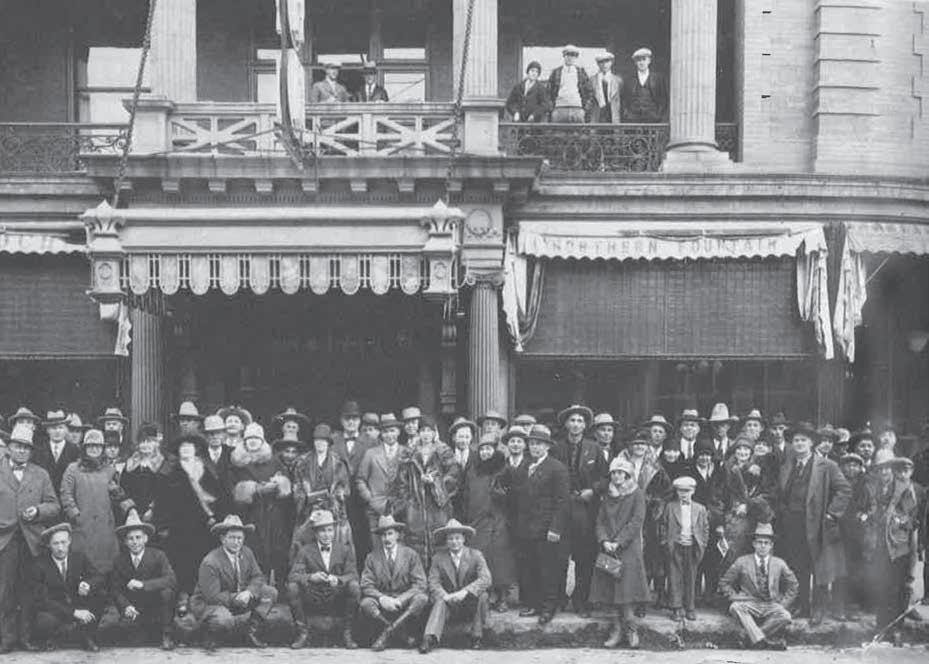
PRESIDENTS OF THE DUDE RANCHERS’ ASSOCIATION
1959 - 1961
LES SHOEMAKER
1961 - 1963
PAUL CHRISTENSEN
1963 - 1965
DICK HICKEY
1965 - 1967
DON SIGGINS
1967 - 1969
ERNIE KEYES
1969 - 1971
DEWEY DOMINICK
1971 - 1973
TOM FERGUSON
1973 - 1975
SPIKE VAN CLEVE
1975 - 1977
RON HYMUS
1977 - 1979
STAN SIGGINS
1979 - 1981
GLENN FALES
1981 - 1983
TACK VAN CLEVE
1983 - 1985
JIM LANGSTON
1985 - 1987
KEN NEAL
1987 - 1989
BOB FOSTER
1989 - 1990
ERIC JONES
1990 - 1992
BILL FERGUSON
1992 - 1994
HAROLD TURNER
1994 - 1996
KIM KELSEY
1996 - 1998
SARAH STEVENSON
1998 - 1999
JIM ANDERSON
1999 - 2001
MAC MAKENNY
2001 - 2003
RUSSELL TRUE
2003 - 2005
GENE ROBERTS
2005 - 2007
JOHN GILL
2007 - 2009
CHERI AMOS-HELMICKI
2009 - 2011
RUSSELL TRUE
2011 - 2013
RANDY GEORGE
2013 - 2015
CLAY MILLER
2015 - 2017
DOUG HARE
2017-2019
RITA COTE
2019-2021
DAVID VAN BERKUM
2021-2023
JERRY HELMICKI
2023-2025
JANICE SCHOONOVER
2025-PRESENT
HUNTER SULLIVAN
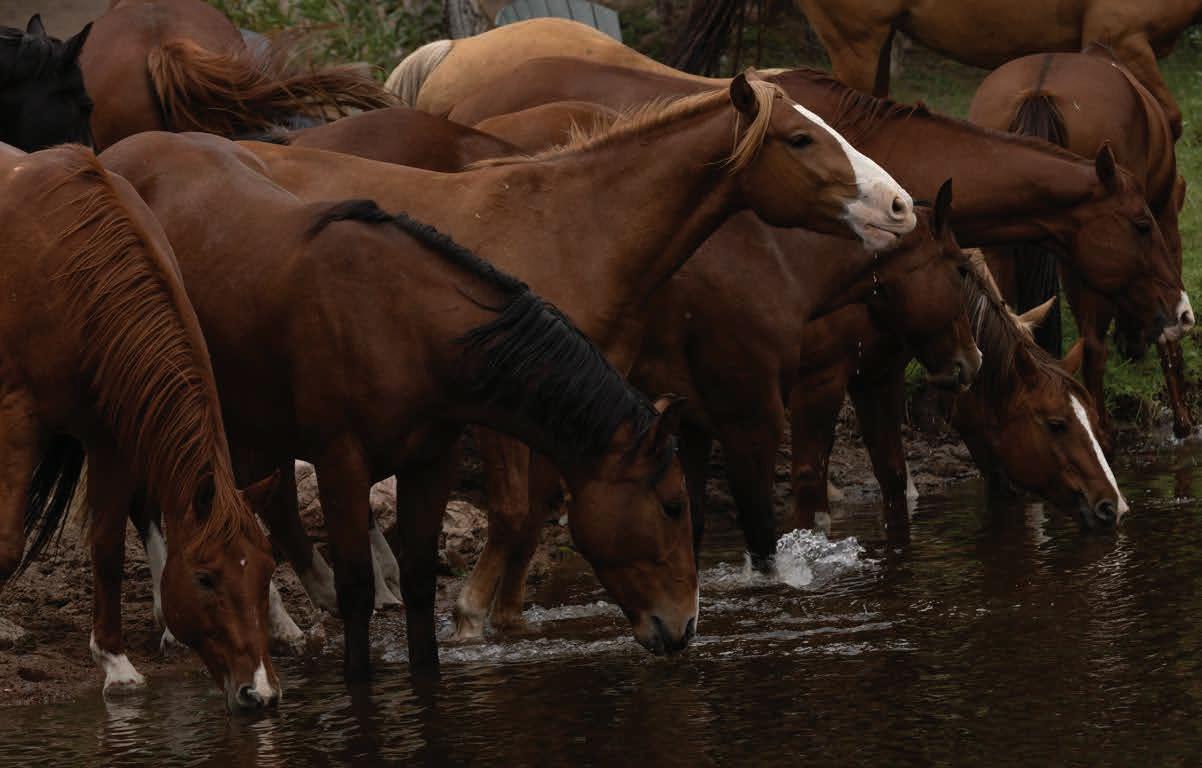
DUDE RANCHERS' ASSOCIATION PRESENTS
1926 2026 centennial RANCH
Centennial ranches
EDITED BY BRIDGET BRUSSELS
Dude ranching found its official start in 1926, when a group of ranchers decided to create a governing organization for the industry that had begun to blossom in the late 1800s.
The first dude ranches found their guests longing to extend their stays and happy to pay in exchange. Early dude ranchers began to realize they had something special on their hands and later, ranches developed with the dude ranch model in mind.
In celebration of the centennial of the Dude Ranchers’ Association, the following pages explore modern and historic dude ranching at 26 ranches that were at the forefront of the industry, hosting dudes and giving them a taste of the West by 1926. Today, these ranches continue the tradition as active members of the DRA.
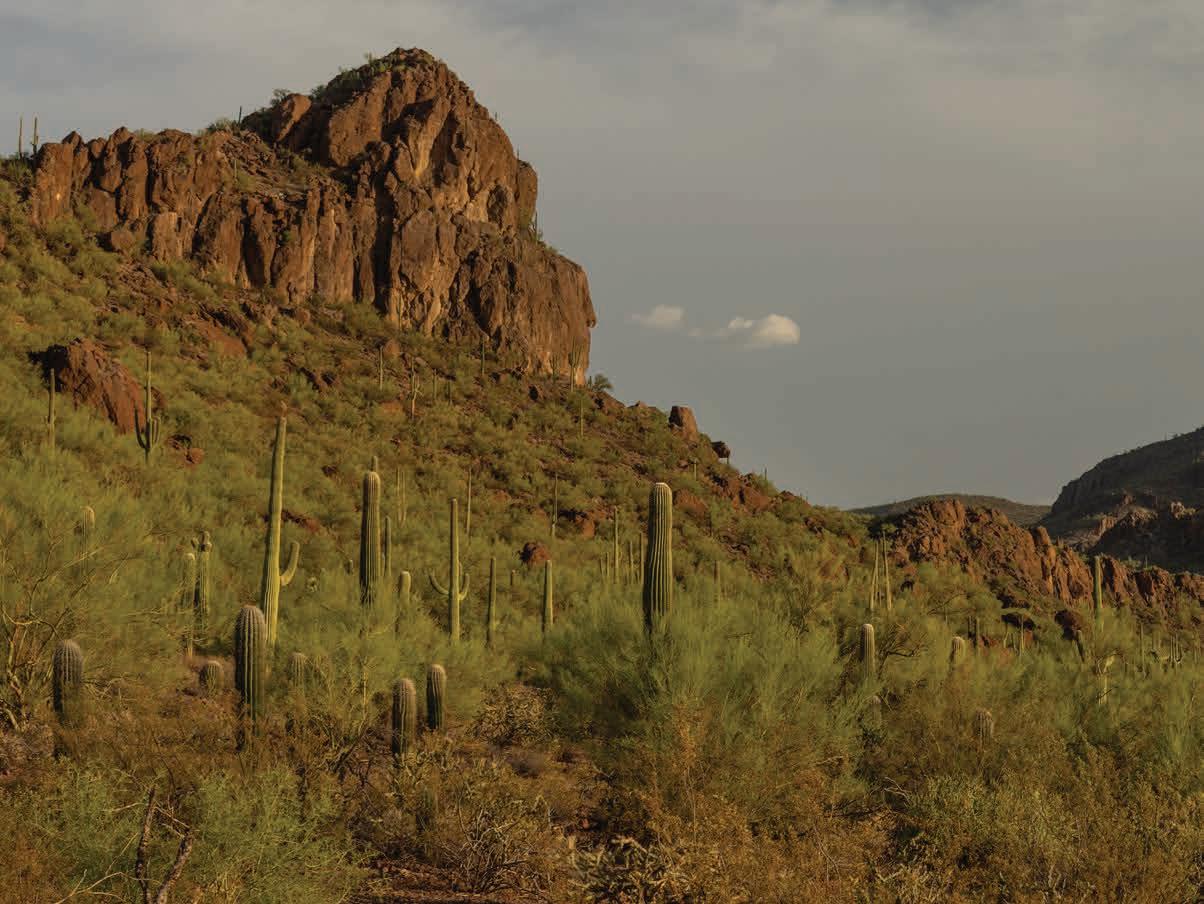
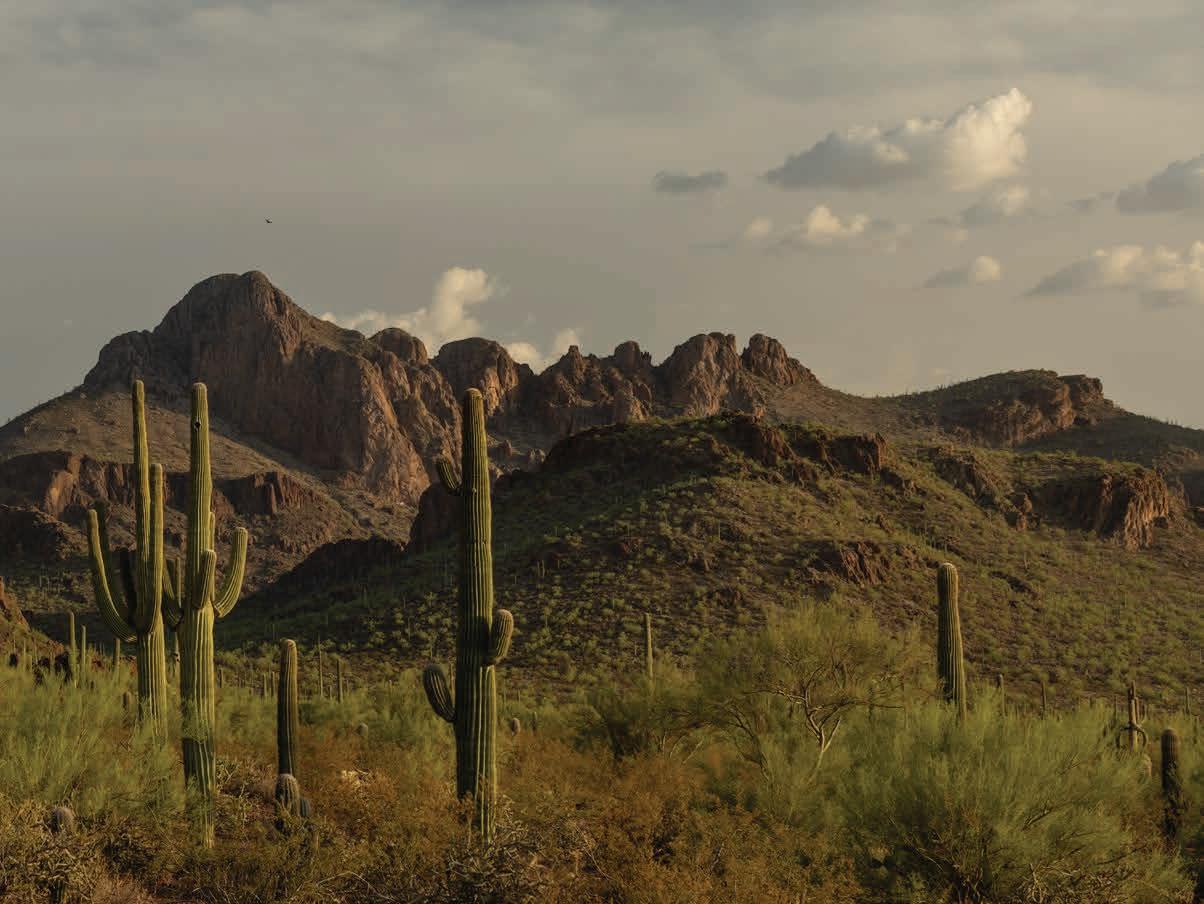
ARIZONA

CIRCLE Z RANCH
PATAGONIA, ARIZONA
Founded: 1926
Founders: Zinsmeister Family
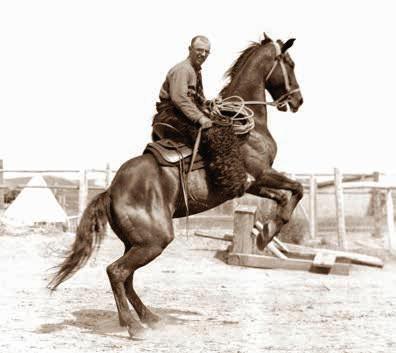
The Circle Z Ranch began as a sheepherding operation in the 1880s and was developed into a dude ranch in the 1920s. The ranch is located along Sonoita Creek, one of the few streams in Southern Arizona that flow year-round. Across the creek from the present ranch complex rises another landmark: Sanford Butte, known to ranch guests as Circle Z Mountain. High on its southern flank is a small cave that dates to before any recorded history of the area. Ancient potsherds and arrowheads have been found in the refuse on its floor, and evidence of prehistoric farming and pottery-making settlements was discovered along the creek. In 1874, Denton Gregory Sanford, a native of New York, arrived on Sonoita Creek. He homesteaded on what now is the Circle Z Ranch, building a four-room adobe and auxiliary buildings that led to it being
Preceding spread Some area in Arizona, maybe the saguaros at the base of Twin Peaks at WSR. Above Lee Zinsmeister poses on a rearing horse. The Zinsmeisters, of Germany, founded the Circle Z Ranch. Right Riding along Tom’s Trail, at the base of the Patagonia Mountains.

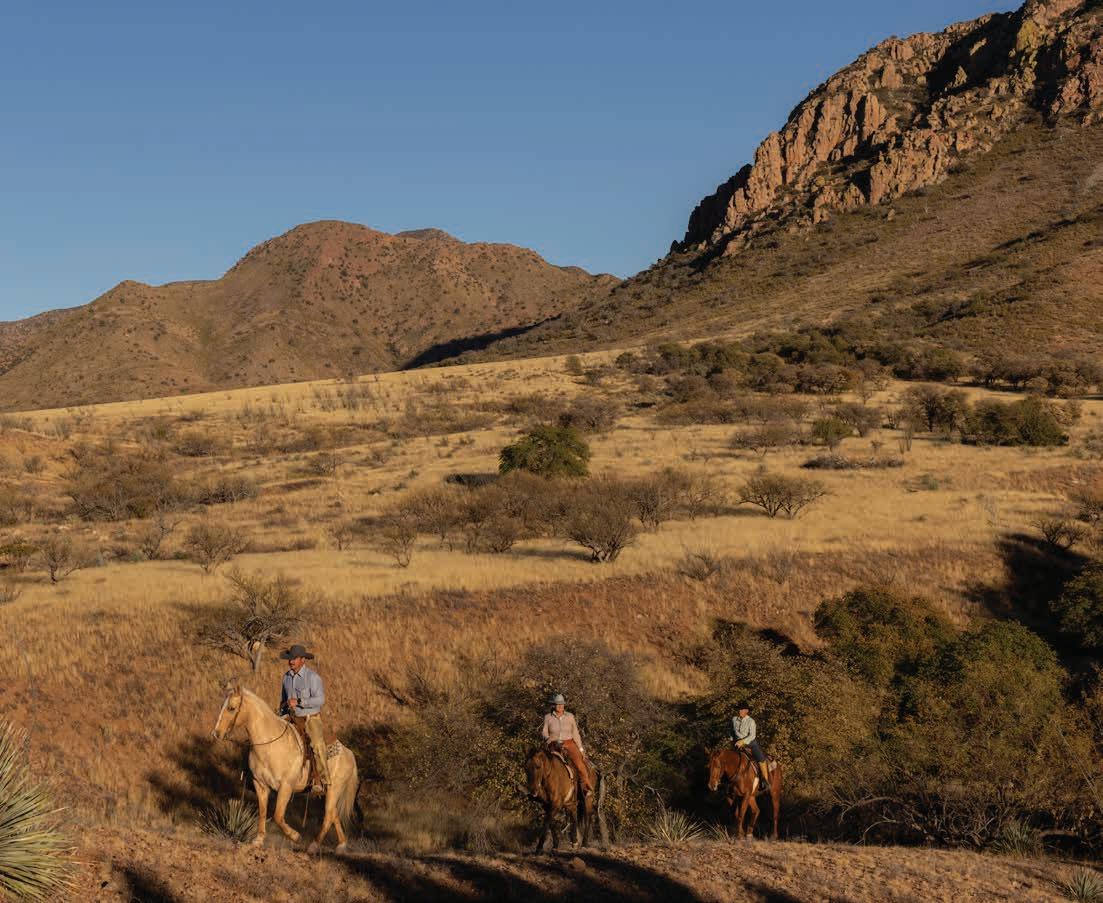
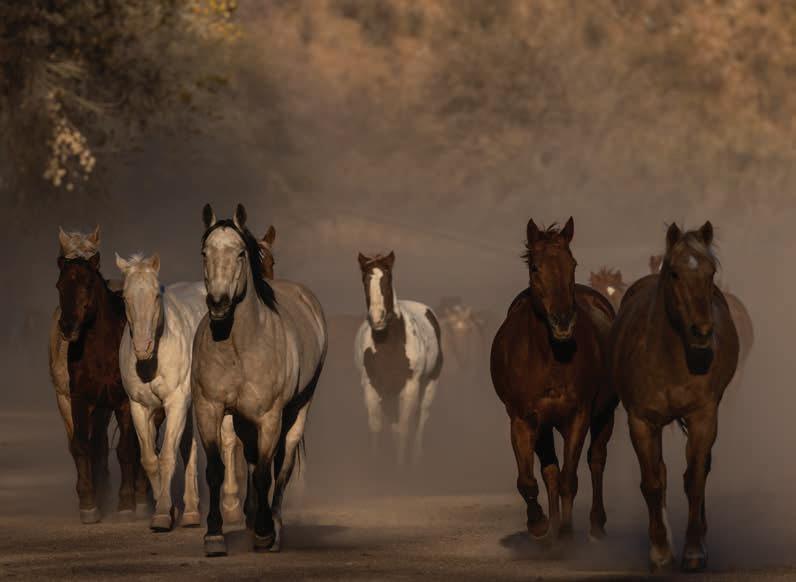
considered “the finest hacienda in the Southwest.”
A number of Sanford’s relatives followed, soon claiming hundreds of acres. John Cady was foreman on the Sanford Rancho in 1881, when it closed out its cattle stock and ran 13,000 sheep until 1884. Scarcer than cattle, the sheep brought a better price.
In 1925, the Zinsmeister family of Kentucky purchased the 5,000-acre spread from Sanford’s daughter. It was the golden age of dude ranching, and the family immediately began to develop a guest ranch. The Circle Z Ranch opened in 1926 with room for 24 guests; the capacity increased over the next few years to eventually accommodate 70. The flatland under Sanford Butte served as the Circle Z polo field.
By 1929, the annual Fourth of July picnic and barbecue at the Circle Z was one of Santa Cruz County’s biggest attractions. Upward of 2,000 people would attend the event, arriving by train and private car; they were served pit barbecue with all the trimmings. Guests enjoyed band concerts, a rodeo and a dance in Patagonia. Then the Great Depression arrived, as did a drought, and the picnics were discontinued in 1934.
In the 1930s, the Circle Z was the home of El Sultan, a Cartuja Spanish stallion owned by the ranch. He was the only one of his breed in the U.S. and one of only six outside Spain. He was a gift from the Spanish royal family before its abdication. To this day, the Circle Z is noted for its fine horses, which are bred, raised and trained on the ranch.
World War II dampened the resort and travel business, and the ranch changed hands several times.
In 1949, Fred Fendig came from Chicago, purchased the ranch and was the owner and manager for the next 25 years.
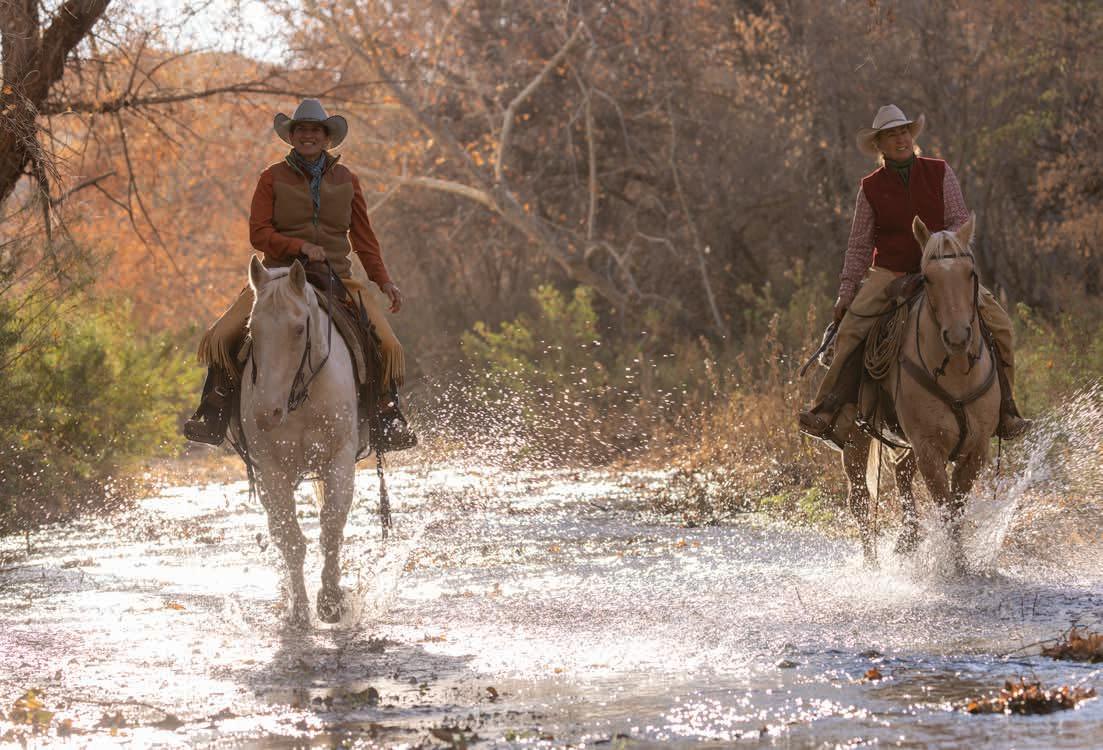
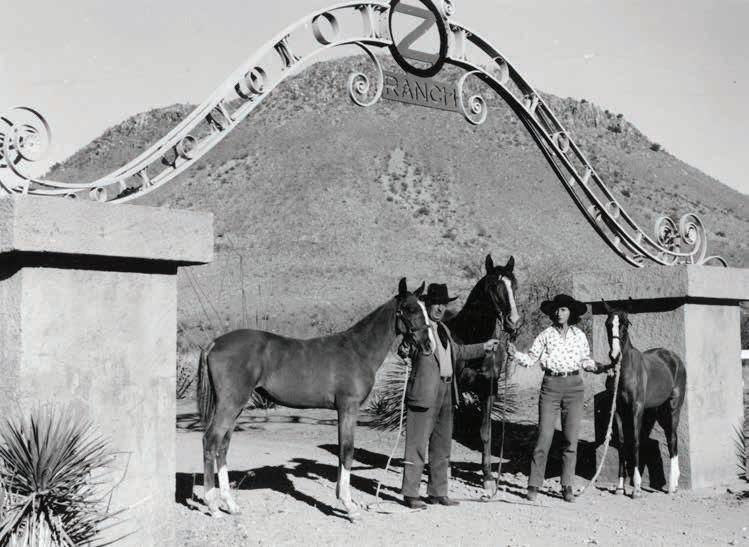
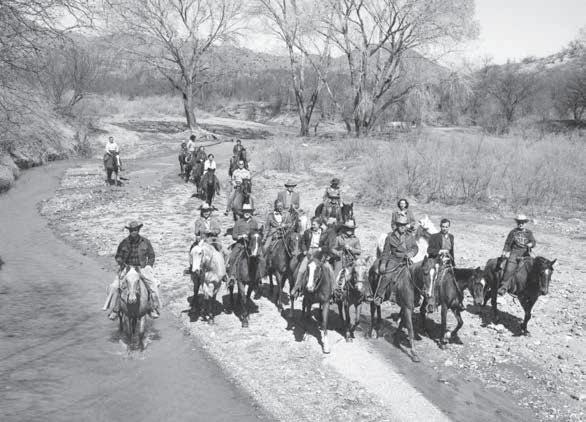
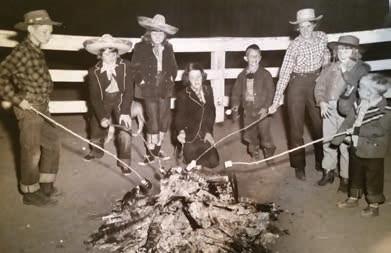
In 1969, the government dammed Sonoita Creek, forming Patagonia Lake, a narrow body of water 3 miles long, to be used for public fishing, boating and water supply. The high bluffs and tall cottonwoods seen in John Wayne’s movie El Dorado now lie beneath this water. Other movies, such as Broken Lance with Spencer Tracy and Monte Walsh with Lee Marvin, along with the final episode of Gunsmoke, were filmed on the ranch.
When Fendig decided to retire and sell the ranch in 1974, there were rumors it would be acquired by a corporation and turned into developed land or a tennis ranch. Instead, the Nash family of Novelty, Ohio, purchased the ranch with the goal of continuing its guest ranching tradition. The family’s deep interest stemmed from Lucia Nash’s many visits to the ranch as a child with her family, dating back to Zinsmeister’s ownership.
Lucia Nash died in December 2018, and care of the ranch passed to her son, Rick, and daughter-in-law, Diana. Before Lucia’s death, in 2013, the Nash family finalized her dream and placed most of her acreage in Arizona in a perpetual conservation easement, giving future generations the gifts of nature and the beauty of the desert.
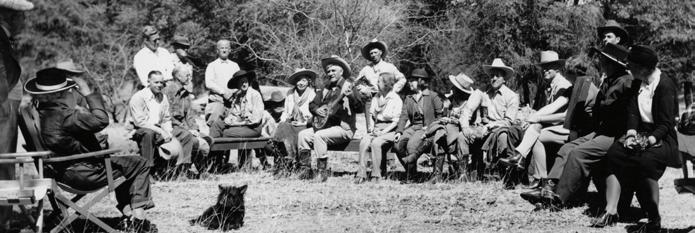
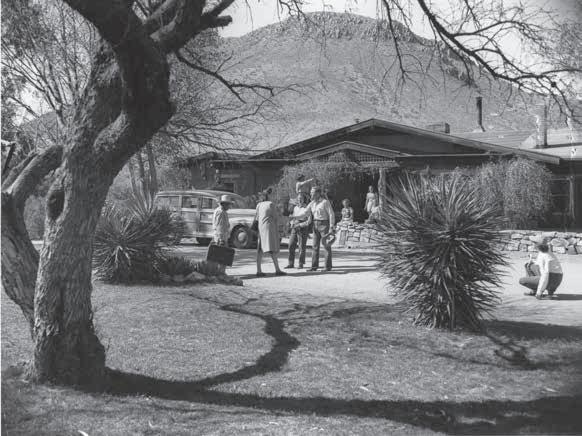
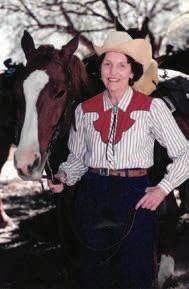
Top A cowboy singer entertains Circle Z dudes. Above, left The original Circle Z lodge, with Sanford Butte in the background. It burned down in 1952, and today, the lodge is the original Zinsmeister home. Above, right Lucia Nash and her husband, Preston, purchased the Circle Z in 1974, after many childhood visits during the Zinsmeisters’ ownership.
KAY EL BAR GUEST RANCH
WICKENBURG, ARIZONA
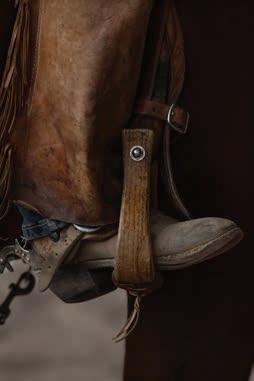
The Kay El Bar Guest Ranch has been a part of the history of Wickenburg, Arizona, for more than a century. And, like many early dude ranches, it began as a working cattle outfit. In 1909, 18-year-old Romaine Lowdermilk purchased 160 acres of Arizona ranchland for $1.25 an acre. He originally had been sent to the Southwest by his mother to cure his ill health three years earlier. He wanted to homestead his own land north of Wickenburg but was too young, so he sat on his choice acres until his 18th birthday.
The ranch was named KL Bar, in honor of Romaine’s mother, Katherine. The brand was registered in 1909, and the ranch eventually grew to 640 acres. In 1914, the first adobe building, currently the Homestead House guest casita, was built as the ranch headquarters and bunkhouse.
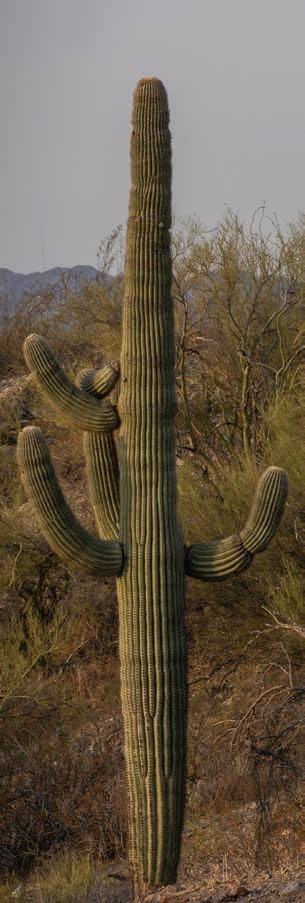
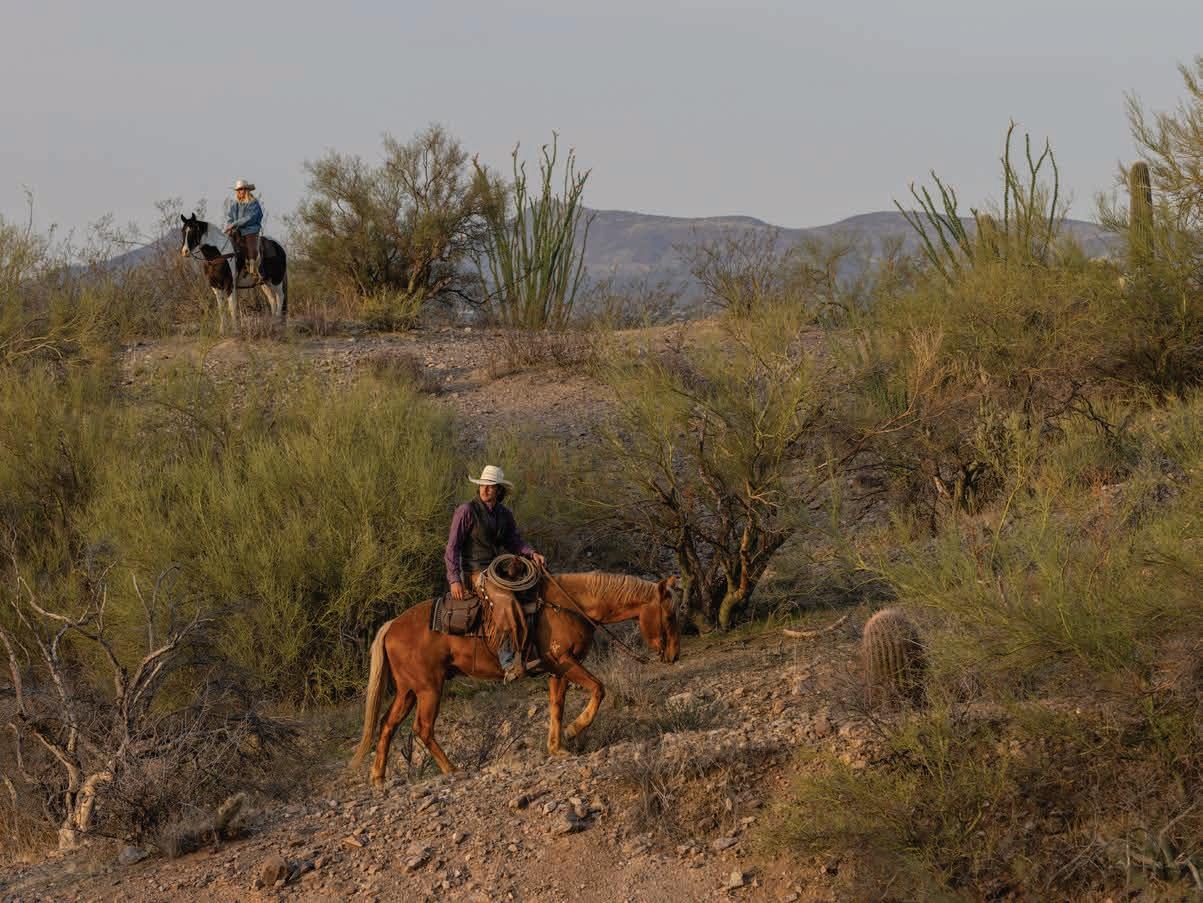
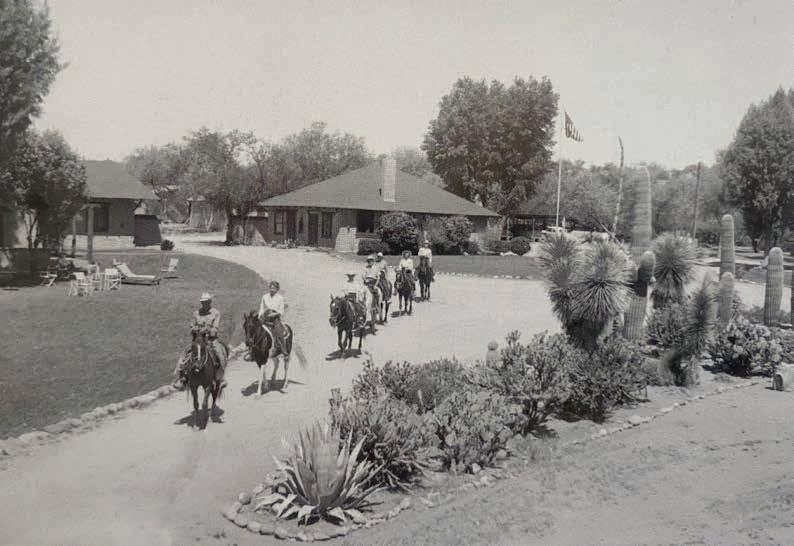
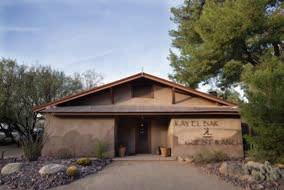
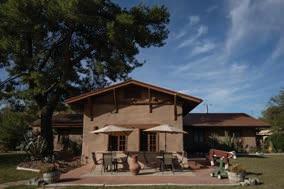
Left Dudes ride out of the center of the Kay El Bar Ranch with the adobe lodge and Homestead House visible in the background. Top The entrance to the historic main lodge at the Kay El Bar. Above The back patio of the lodge of the Kay El Bar, which was constructed in 1925. Opposite Horseback among the towering saguaros of the Sonoran Desert.
In addition to ranching, Lowdermilk became a writer and Western entertainer. His writing career began with a weekly column of “wit and wisdom” for a Prescott newspaper. The column led to the ranch’s first paying guests in 1918, after Lowdermilk’s editor visited the ranch and spread the word about staying at the Kay El Bar.
In those early days, accommodations were rustic, bathrooms were communal, and there was a basic menu of the “three B’s”: beans, bacon and biscuits. Horseback riding and cowpunching were the sole amusements. There were few guests at that time, but visitors were eager to sample Western ranch life, and hosting them supplemented income when the cattle business slowed.
In 1925, Lowdermilk took a partner, Henry Warbasse, and the two of them built the large adobe lodge expressly for use as a dude ranch. The Kay El Bar Guest Ranch opened in 1926; the next year, Lowdermilk sold out to Warbasse and his wife, Christine. In 1929, Warbasse was elected the first president of the Arizona Dude and Guest Ranchers’ Association.
For the next 45 years, the ranch experienced many changes in ownership. It operated as both a guest and cattle ranch until 1958, when then-owner Morton Bodfish, a Chicago financier and president of the International Savings and Loan Association, sold the 120 acres with the dude ranch facilities while retaining the surrounding acreage for cattle.
Robert Kratville and Eugene Kilmer bought the ranch in the late ’60s, and for some time, it was
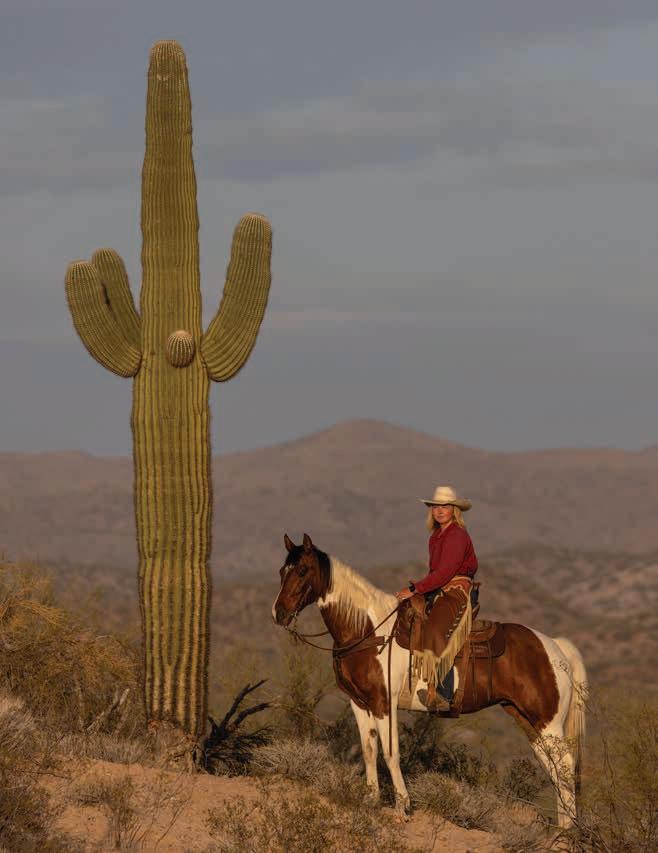
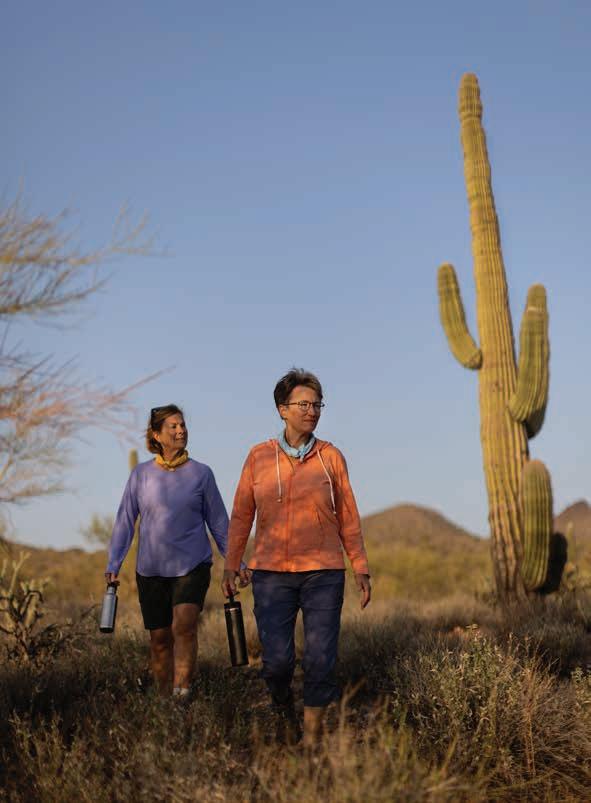
home to actor Val Kilmer. When Eugene and Gladys Kilmer divorced, the ranch was put up for sale. Then, Gladys met William Leach at a local ranch, and he later surprised her by buying the Kay El Bar from her ex-husband. After they married, the Leaches operated the property as a guest ranch until the last six years of their ownership, when they simply lived on the property.
In the 1970s, the ranch was placed on the National Register of Historic Places, along with the Arizona equivalent. In 1978, Charles and Carol Peterson took over the ranch and 60 acres of land; the other 60 were retained by the Leaches. Halfway through their second ranch season, though, the Petersons were ready to sell. Jane and Jay Nash and Jan and Charlie Martin had been looking for a ranch for the two sisters to run, and the couples fell in love with the Kay El Bar. Over the years, they spent countless hours refurbishing the ranch while managing it for 17 years.
John and Nancy Loftis bought the ranch in 1997 and ran it into the 2000s. Their guest ranch interest began after they took their own children to guest ranches in Colorado in the mid-’80s. The ranch was closed for many years until 2018, when, on its 100th anniversary of welcoming guests, the Kay El Bar resumed operation as a guest ranch. It hosts guests for an intimate Western experience as part of the True Ranch Collection, a selection of historic dude ranches across the West.
Left Hiking a Sonoran Desert trail near the Kay El Bar. Right Romaine Lowdermilk, founder of the Kay El Bar, was also a writer and Western entertainer; he became known as the “Father of the Arizona Dude Ranch,” later establishing other such properties. Far right Kay El Bar guests usually arrived by train and were picked up in the ranch’s Packard touring car, pictured here in the 1940s. Occasionally, visitors would arrive in a two-passenger airplane that landed in the Hassayampa River beside the ranch.
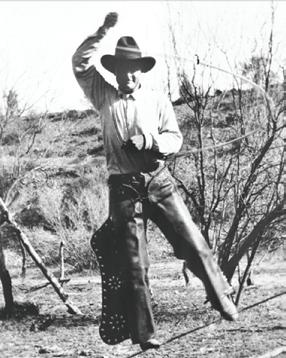
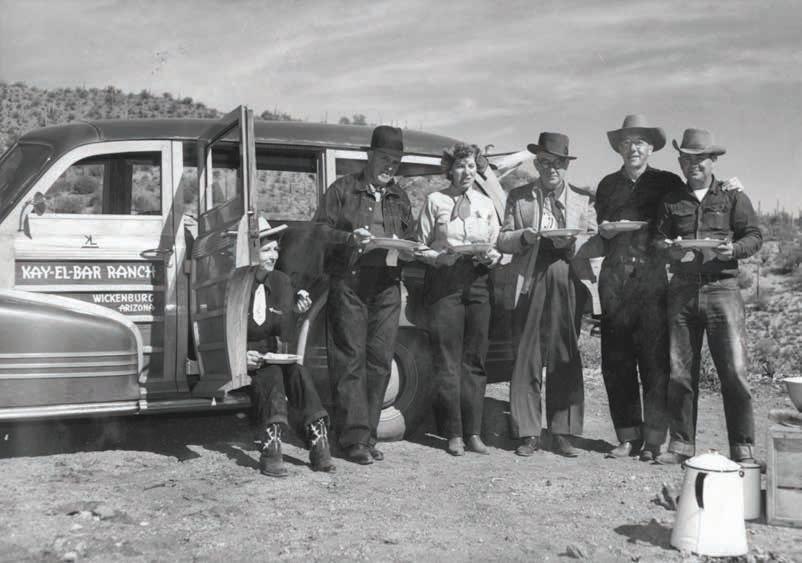
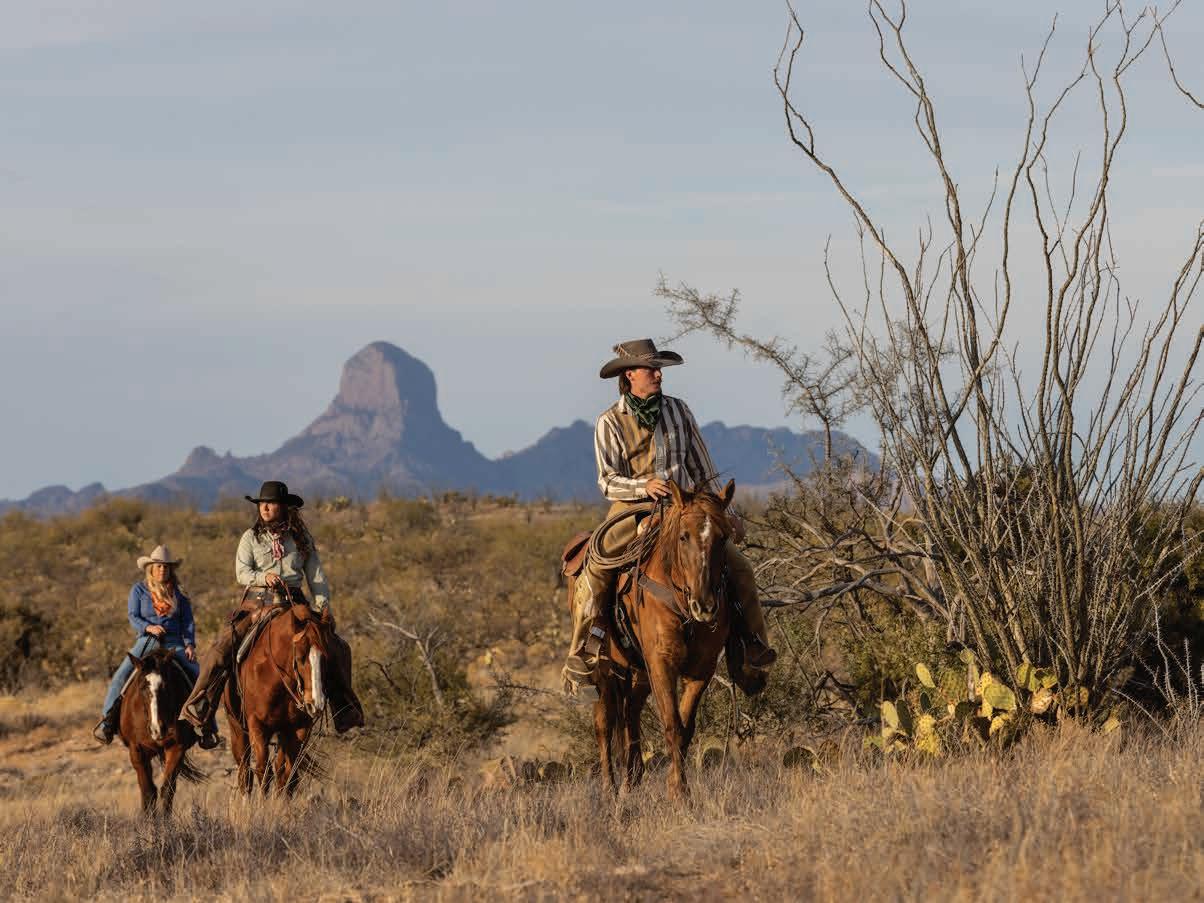

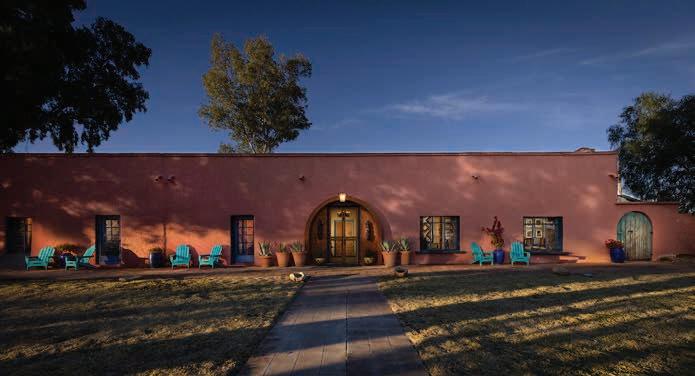
Rancho de la Osa offers a unique convergence of Native American, Spanish, Mexican, ranching, political and Hollywood history.
The land La Osa stands on—70 miles southwest of Tucson, Arizona, along the U.S.-Mexico border—is home to centuries of history, from its origin as Indigenous tribal lands to its modern dude ranching history.
Two prehistoric farming systems developed in the area: The Trincheras people built terraced fields in the desert foothills and lowlands, and the Hohokam relied on hand-dug irrigation canals in the area’s river valleys. From A.D. 300, the Hohokam inhabited the area around La Osa until 1500, when the predominant culture became Tohono O’odham, as it remains to this day. The O’odham were living in the area when the
RANCHO DE LA OSA SASABE, ARIZONA
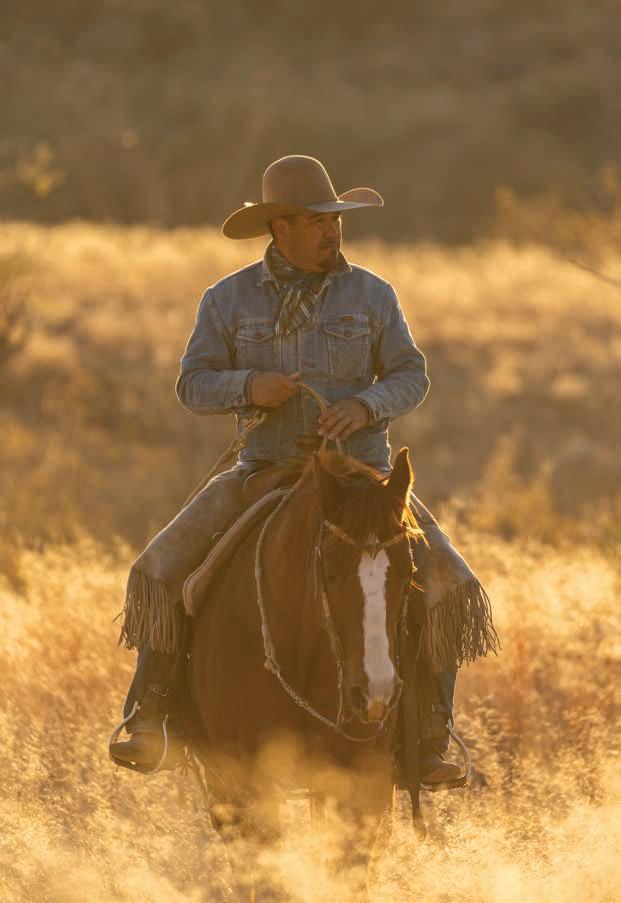
Spanish arrived; the Spanish named this region the Pimería Alta, encompassing the border of present-day Southwestern Arizona and Sonora, Mexico.
Jesuit missionary Eusebio Francisco Kino first arrived in the Pimería Alta in 1687. In his travels, Kino visited the O’odham village where La Osa now stands. Later, in 1722, Jesuit priests built a mission outpost— today, that building is the ranch’s cantina. It was used as a trading post to exchange goods with Indigenous tribes and as a place for traveling missionaries to rest.
After years as rangeland and complicated disputes over ownership, La Osa became part of the Arizona Territory with the Gadsden Purchase of 1853. In 1887, Colonel William S. Sturges of Chicago acquired ownership of La Osa; he spared no expense finishing the Spanish-style hacienda, which featured wood floors, stained-glass windows and 10 acres of gardens.
In 1901, the ranch was sold to La Osa Cattle Co., and cattle operations continued there well into the property’s dude ranching era. The cattle company changed hands several times between prominent local ranchers and business owners in the early 1900s.
Dude ranching at La Osa began in the 1920s. In October 1924, John and Louisa Wetherill arrived at the ranch. Louisa was an authority on Navajo culture and spoke the language, and the couple operated a trading post and lodge in Kayenta, Arizona. The Wetherills made trips to Mexico to investigate claims that Navajo clans had migrated south in preColumbian times. During their travels, they found La Osa and decided it was an ideal place to house winter guests. It opened as Hacienda de la Osa on Thanksgiving Day in 1924.
In 1927, Glenn Edwards Arthur Hardgrave, a Kansas City socialite and writer, became the owner of La Osa after her husband, Arthur Hardgrave, purchased the ranch as a birthday gift. She had been a guest in 1926 and went on to write a series of articles about her experiences at the ranch in the Kansas City Journal-Post.
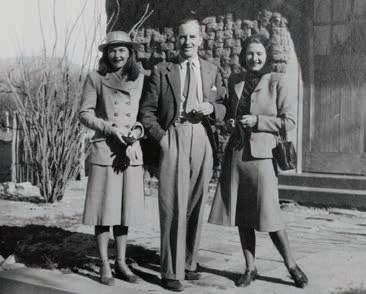
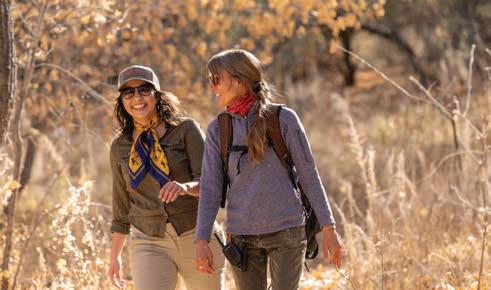
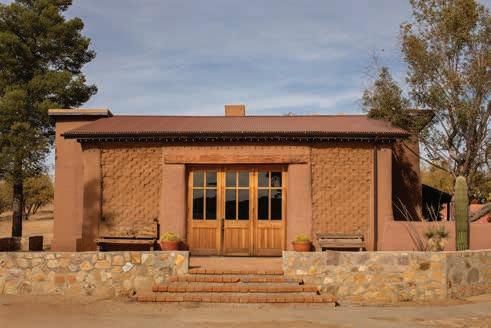
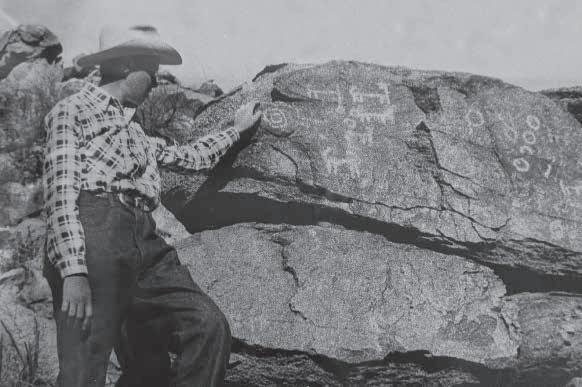
Opposite Sunrise along the U.S.-Mexico border. Top, left Claudia Alta “Lady Bird” Johnson, the future first lady, and ranch guests stand in front of the ranch’s oldest historic building. Dick Jenkins, owner of Rancho de la Osa in the 1940s, became chairman of the Arizona Democratic Party, and many prominent politicians were entertained at the ranch over the next decade. Top, right Claudia Alta “Lady Bird” Johnson (left/right), the future first lady, and ranch guests stand in front of the ranch’s oldest historic building. Dick Jenkins, owner of Rancho de la Osa in the 1940s, became chairman of the Arizona Democratic Party, and many prominent politicians were entertained at the ranch over the next decade. Above, left Hikers along a trail at Arivaca Creek in Buenos Aires National Wildlife Refuge. Above right Petroglyphs near the ranch, likely made by the Hohokam people, who inhabited the area after 800. The modern U.S.-Mexico border was the site of a transition between the Trincheras and Hohokam cultures in the Late Prehistoric period, between 800 and 1300.
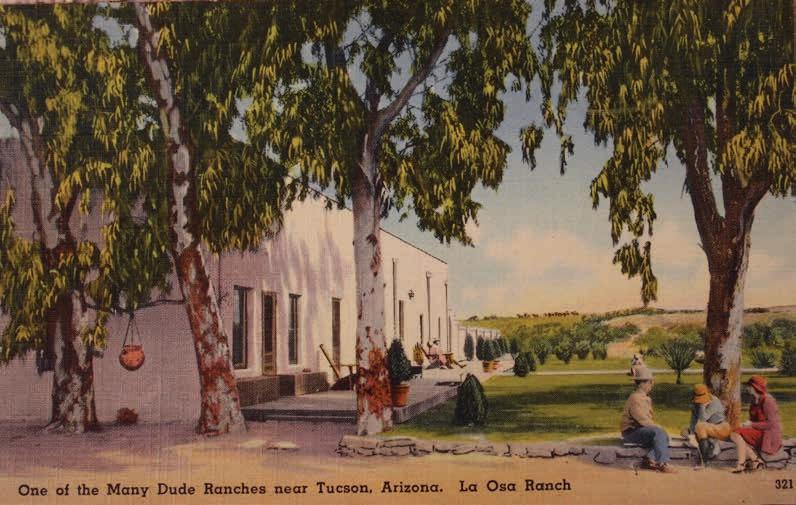
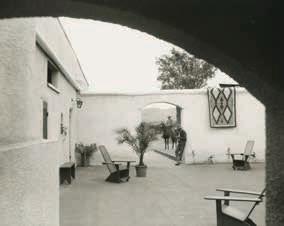
In the late 1930s, Edward Dickerson “Dick” Jenkins, a prominent Democratic politician, syndicated ownership of the ranch, continuing to operate it as a dude ranch named Rancho de la Osa. The ranch closed during World War II and reopened in 1945, after Dick returned from the U.S. Army Air Corps. His twin sister, Nellie, also arrived to help run the ranch, and in its years as a dude ranch, La Osa played host to politicians, Hollywood actors and authors, including Lyndon B. Johnson, Franklin Delano Roosevelt, John Wayne and Zane Grey.
From the 1960s to 1982, the ranch’s ownership changed hands while operating as a cattle ranch or guest ranch. In the spring of 2017, Rancho de la Osa opened once again to dudes after Ranch Preservation and partners purchased it. It now is part of the True Ranch Collection, a selection of historic dude ranches across the West.
One
Colonel William S. Sturges of Chicago spared no expense finishing the Spanish-style hacienda in 1887. Far right Rancho de la Osa guests in the 1940s pose in front of the Hacienda during a snowy winter day. Right, below Riders stand in front of the hacienda at La Osa, constructed for its cattle operations. The La Osa Cattle Co. was run by rancher W.D. Coberly and his family until Tucson businessman Jack Kinney and his partners purchased it in 1915.
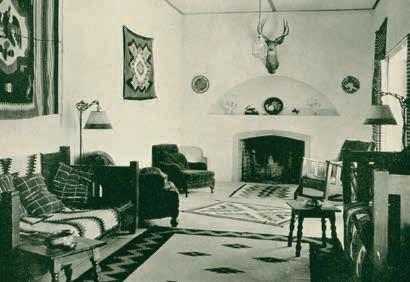
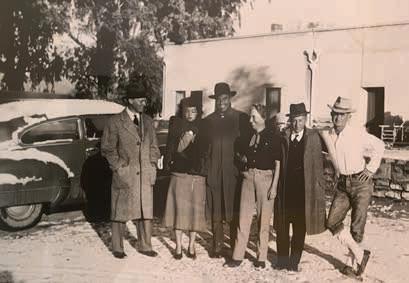
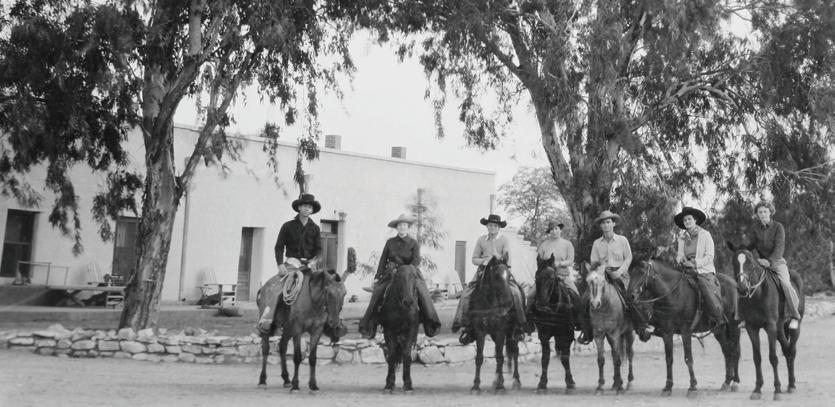
SPRUCEDALE
GUEST RANCH
ALPINE, ARIZONA
Founded: TK Founders: TK
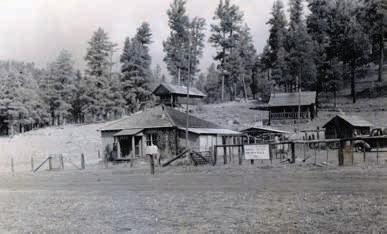
Sprucedale Ranch is located deep in the Apache-Sitgreaves National Forests of Eastern Arizona. The ranch was homesteaded by Hiram and Maryette Thompson around 1906; over the next 15 years, they built a cabin and two log barns, and they dug a well for farming and raising livestock. In 1921, they sold the property to another ranching family, Ernest and Bertha Patterson.
Shortly afterward, some fishermen stopped by looking for shelter from a monsoon storm. The Pattersons cleared out a small storage shed and offered the men a place to stay — and, unbeknownst to them, inaugurated the first guests of the ranch. As they left, the fisherman asked if they could return the next year, and by 1922, the dude ranch was officially in business.
Gradually, the Pattersons added three new cabins as they began hosting more guests who enjoyed fishing in trout-filled streams and riding in the pine forests of Arizona’s White Mountains. Twenty years later, none of the Patterson children was interested in continuing the family business, so the Pattersons approached their neighbors, Walter and Faye Wiltbank, about purchasing the ranch. The Wiltbanks were hesitant at first — herding people seemed far removed from herding cattle — but ultimately agreed on a price and purchased the ranch in 1941.
The Wiltbanks’ early years were challenging, and World War II
Above tests test testOptatistia velenimet poresci temporruptam et et experfe rspernam eicate ditam, volenda consend itiatin tectio. Endaect atiunt fuga. Right testoriam rersperaes exerumquidis dolestis velis apis vid qui utem audandamharum sam et magnatiunt.

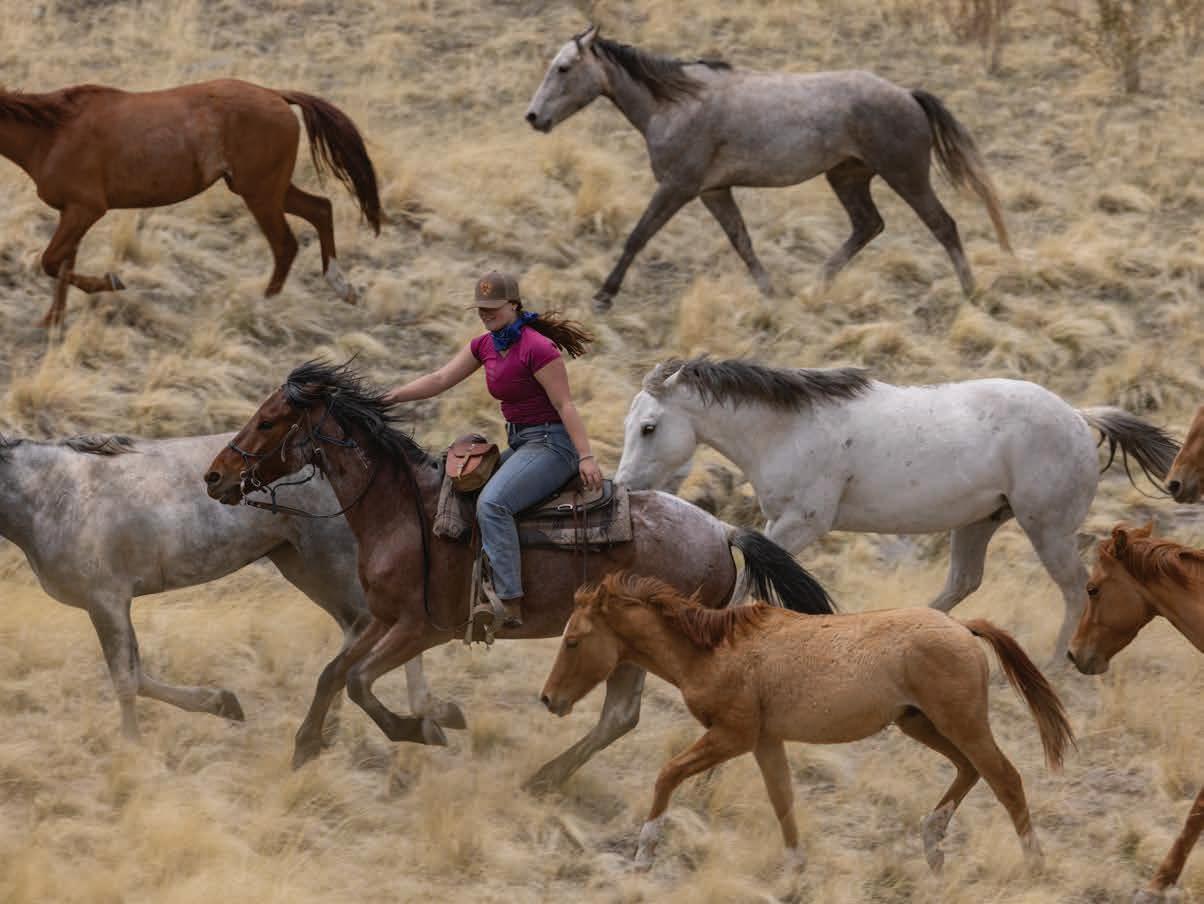
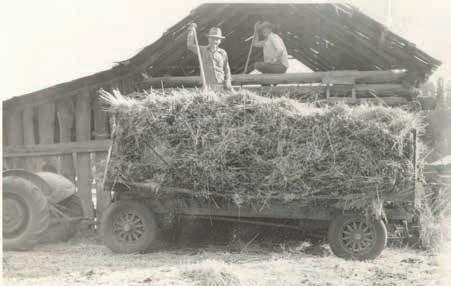
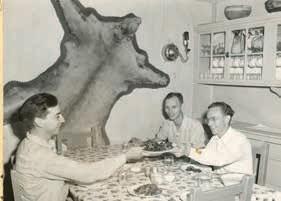
exacerbated the challenge. They farmed oats and barley at the ranch, and Walter took guests riding and used his packhorses to transport fishermen and their equipment to the Black River. Faye cooked for the guests, and from the livestock the family raised, she sold butter, eggs and cheese at a Civilian Conservation Corps camp a few miles away.
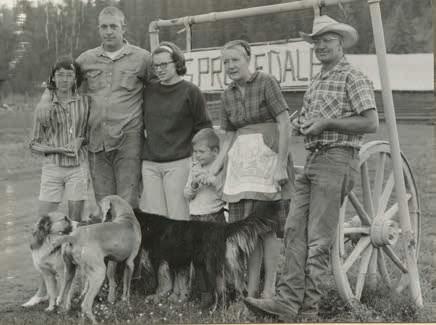
Over the next 40 years, Walter and Faye raised four children — Margine, Bud, Emer and Ellis — countless livestock and seven more cabins as they worked to improve their new business. In 1981, after Walter’s death the previous year, Sprucedale passed to Emer and his wife, Esther, who expanded the tradition to their seven children and added six more cabins.
The ranch passed once again from father to son in 2004 and is now operated by Whitney and Janae Wiltbank and their five children. Whitney’s brothers and sisters continue to help run the family business as often as they can, and the property remains a working cattle and guest ranch to this day. Even for the Wiltbanks, Sprucedale is a place where family comes together.
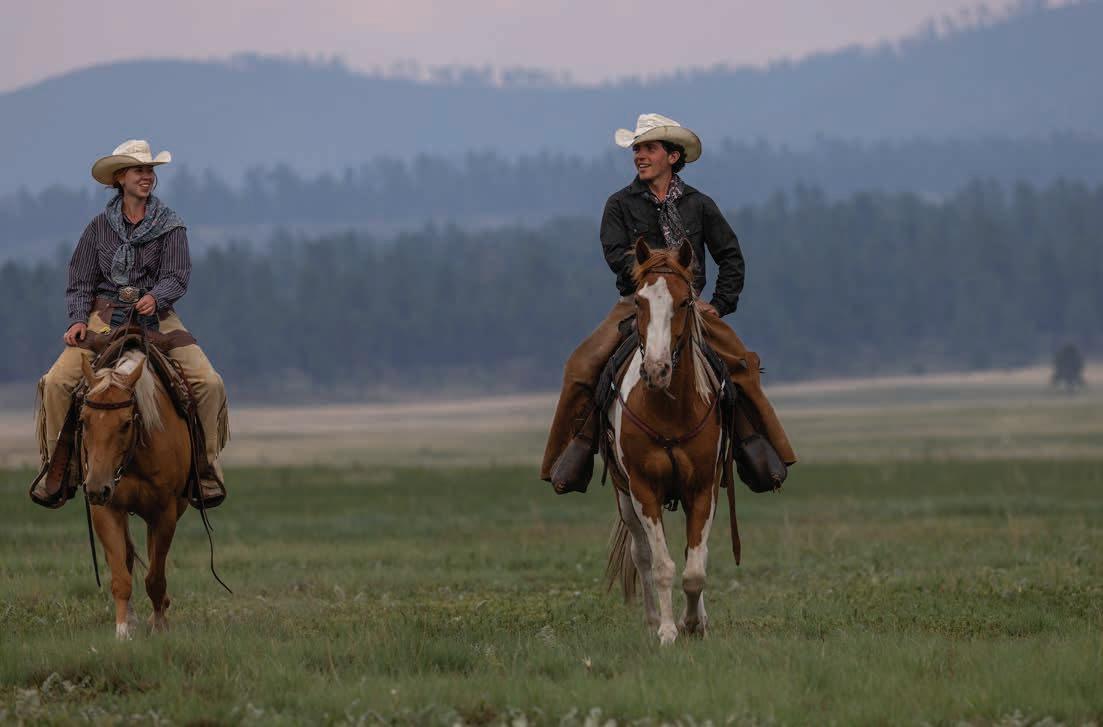
Above tests test testOptatistia velenimet poresci temporruptam et et experfe rspernam eicate ditam, volenda consend itiatin tectio. Endaect atiunt fuga. Ut que modita quias sus, sit, qui ad eariberum, cum rempel etur alicimpelit at represe quaerum, quam, simusciis quas cus mo Opposite, near right testoriam rersperaes exerumquidis dolestis velis apis vid qui utem audandam, Opposite, sim quatium nobis reius aut quodi voluptatus a porepeditam labor reiciam qui omnihitia pa que sed moluptatia dolorendem harum sam et magnatiunt. Opposite, sim quatium nobis reius aut quodi voluptatus a porepeditam labor reiciam qui omnihitia pa que sed moluptatia dolorendem harum sam et magnatiunt. Opposite, sim quatium nobis reius aut quodi voluptatus a porepeditam labor reiciam qui omnihitia pa que sed
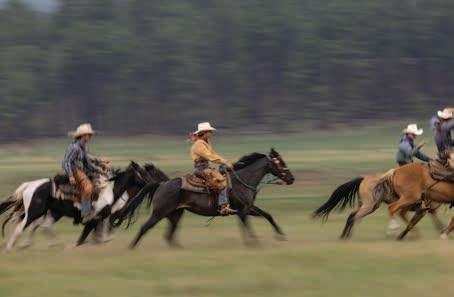
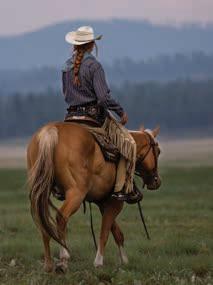
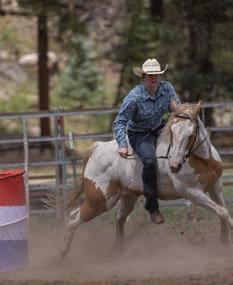
Top, left Optatistia velenimet poresci temporruptam et et experfe rspernam eicate ditam, volenda consend Top, right testoriam rersperaes exerumquidis dolestis velis apis vid qui utem audandam, Above, left sim quatium nobis reius aut quodi voluptatus a porepeditam labor reiciam qui omnihitia pa que sed moluptatia doloreet magnatiunt. Above, right, sim quatium nobis reius aut quodi voluptatus a

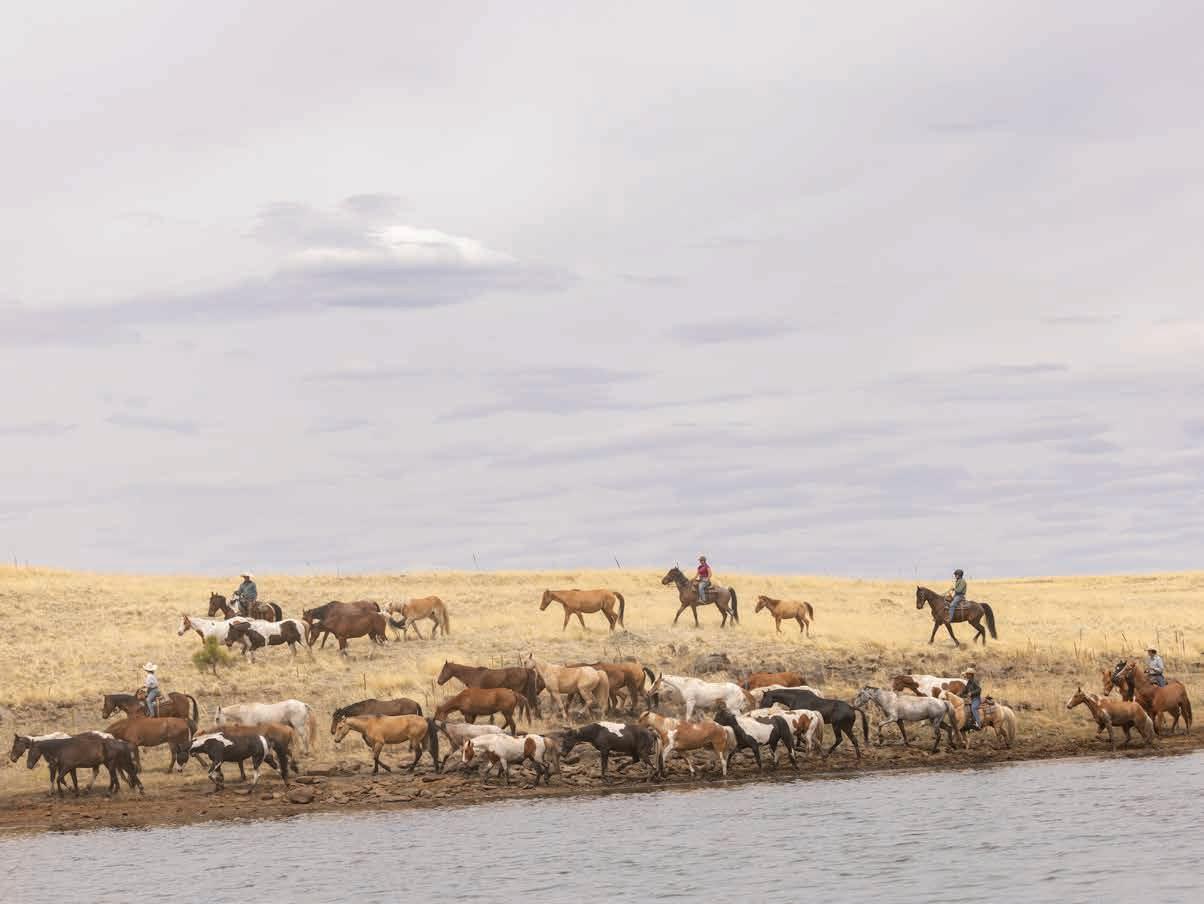
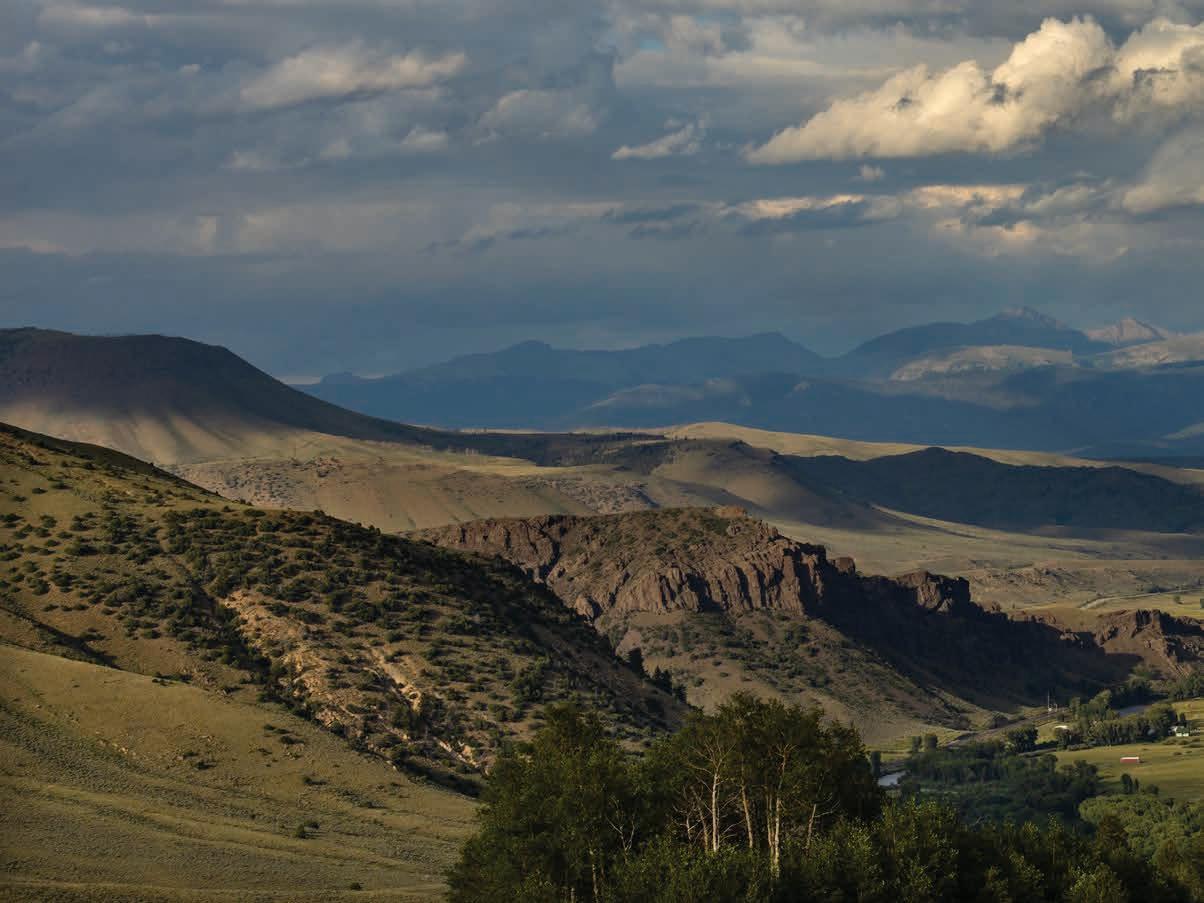
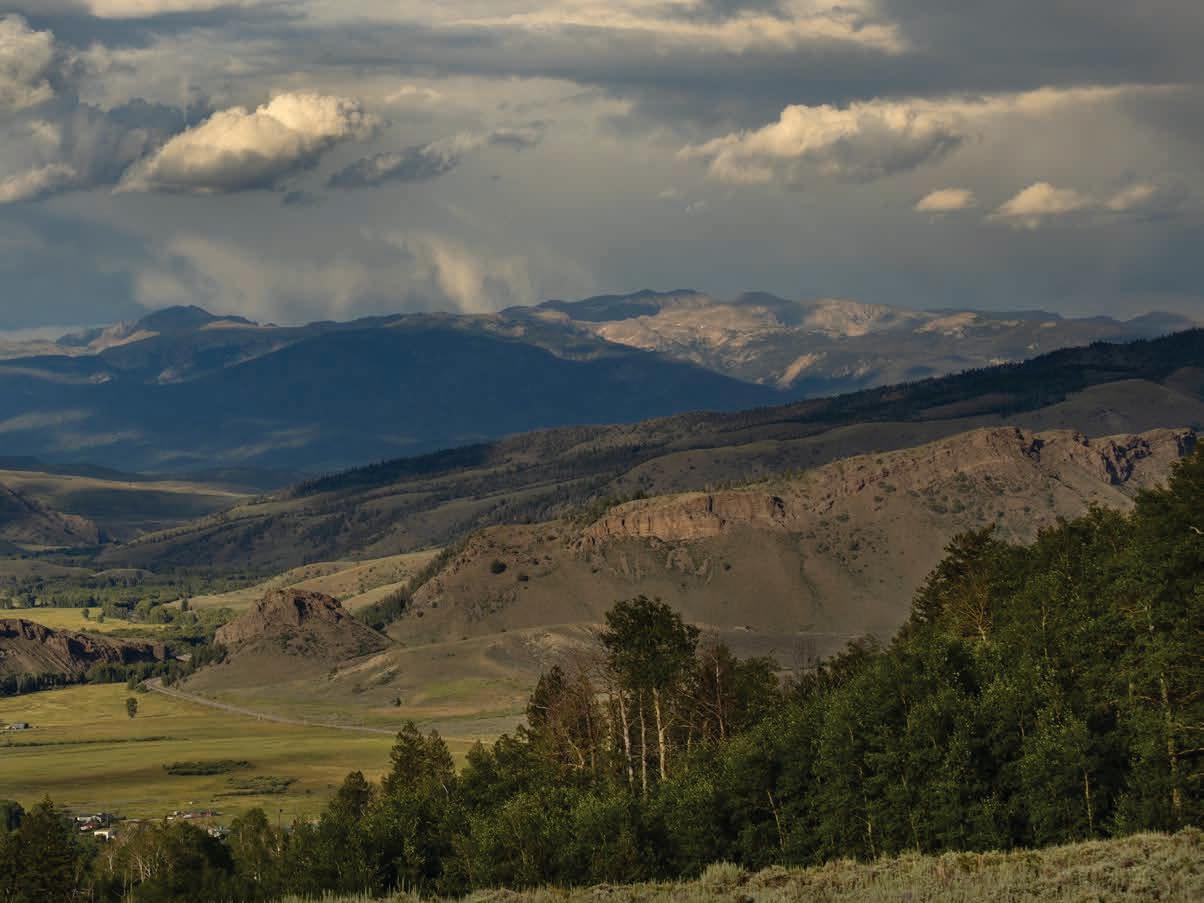
COLORADO

4UR RANCH
CREEDE, COLORADO
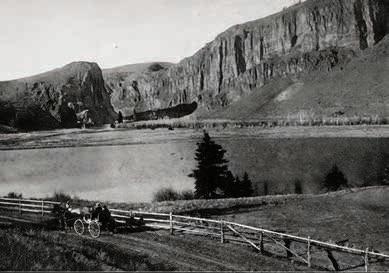
The history of the 4UR Ranch and the land it calls home began 26 million years ago, during the Oligocene Epoch—a time marked by the largest volcanic eruption in the Earth’s history, one that left behind the 45-mile-wide La Garita Caldera and the San Juan and La Garita mountain ranges of Southwestern Colorado. It also created the natural hot springs of the Wagon Wheel Gap.
By the 1700s, Ute tribes were well established in the area and used the hot springs as a sacred campsite, holding Sun Ceremonies and guarding the location as fiercely as they did their hunting grounds.
In 1872, the U.S. government signed a treaty with the Utes and moved them north, closer to Gunnison, Colorado. Soon, homesteaders arrived in the Goose Creek Valley, a bathhouse structure was erected over the hot springs, and patrons began frequenting the “baths.” In 1873, silver was discovered in a nearby mine and the boomtown of Creede was born; it boasted residents such as Bat Masterson and Bob Ford, solidifying its place in the Wild West.
By 1906, ownership of this property—by then long known as the Wagon Wheel Gap Hot Springs Hotel—had been consolidated with
Previous spread Late afternoon northeast of Parshall, Colorado. Above The lake at the 4UR Ranch, once called the Wagon Wheel Gap Hot Springs Resort. Right Fly fishing on the Rio Grande on the 4UR Ranch.

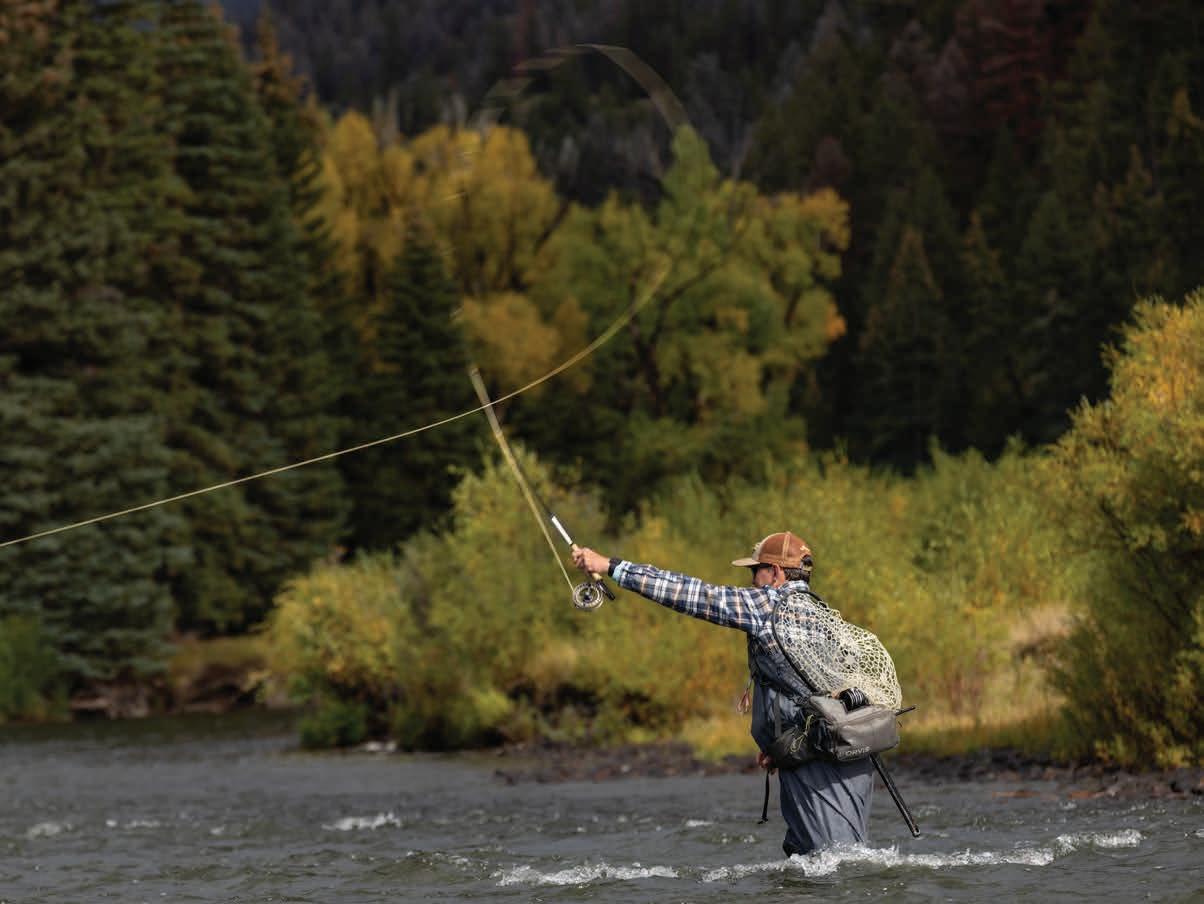
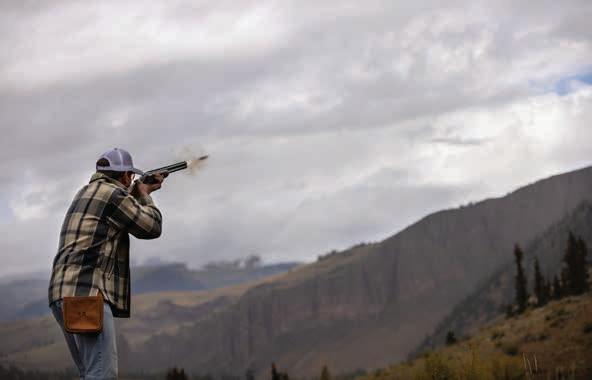
General William Jackson Palmer, a decorated Civil War hero and creator of the Denver and Rio Grande Western Railroad. Palmer hired Thomas MacLaren, an architect from the Royal Academy of Arts in England, to design a luxury health resort rivaling European spas during this “Golden Spa Age.” At completion, the Wagon Wheel Gap Hot Springs Resort was unveiled with a “Palatial Bathhouse,” three long Adirondack-style sleeping cabins, a new hotel and a livery stable.
By the 1940s, antibiotics had been discovered and Americans no longer relied on “healing waters” for their curative properties.
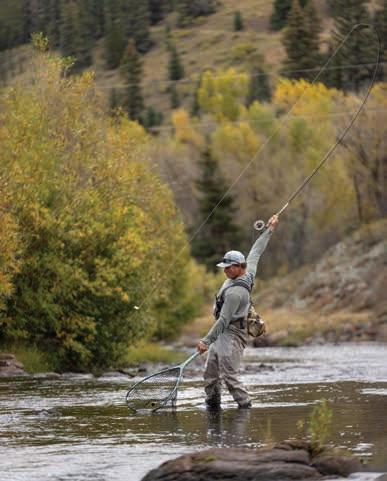
The resort’s clientele remained loyal, though, and later brought their families to vacation and enjoy fly fishing, horseback riding and hunting.
The Palatial Bathhouse was abandoned, and as guest ranch vacations were becoming popular, the Wagon Wheel Hot Springs Resort became the Wagon Wheel Ranch.
With a small herd of cattle on the property in the mid-20th century, a brand was registered in 1946 as 4UR, constructed from the two W’s, or “four U’s,” of the name Wagon Wheel. Due to a disagreement with a neighbor about the rights to the name “Wagon Wheel,” the ranch
was renamed once again, this time after the 4UR brand.
Since 1972, the 4UR has been owned by the Leavell family, now in its third generation of ownership, and it’s still welcoming guests, some whose families have been coming since early in the 20th century. Past guests have included Walt Disney, John Wayne, Dwight D. Eisenhower, Julia Child, Supreme Court Justice Byron White, Nolan Ryan, Stephanie March of television’s “Law and Order” and, most recently, award-winning actress Ruth Wilson of “The Lone Ranger.”
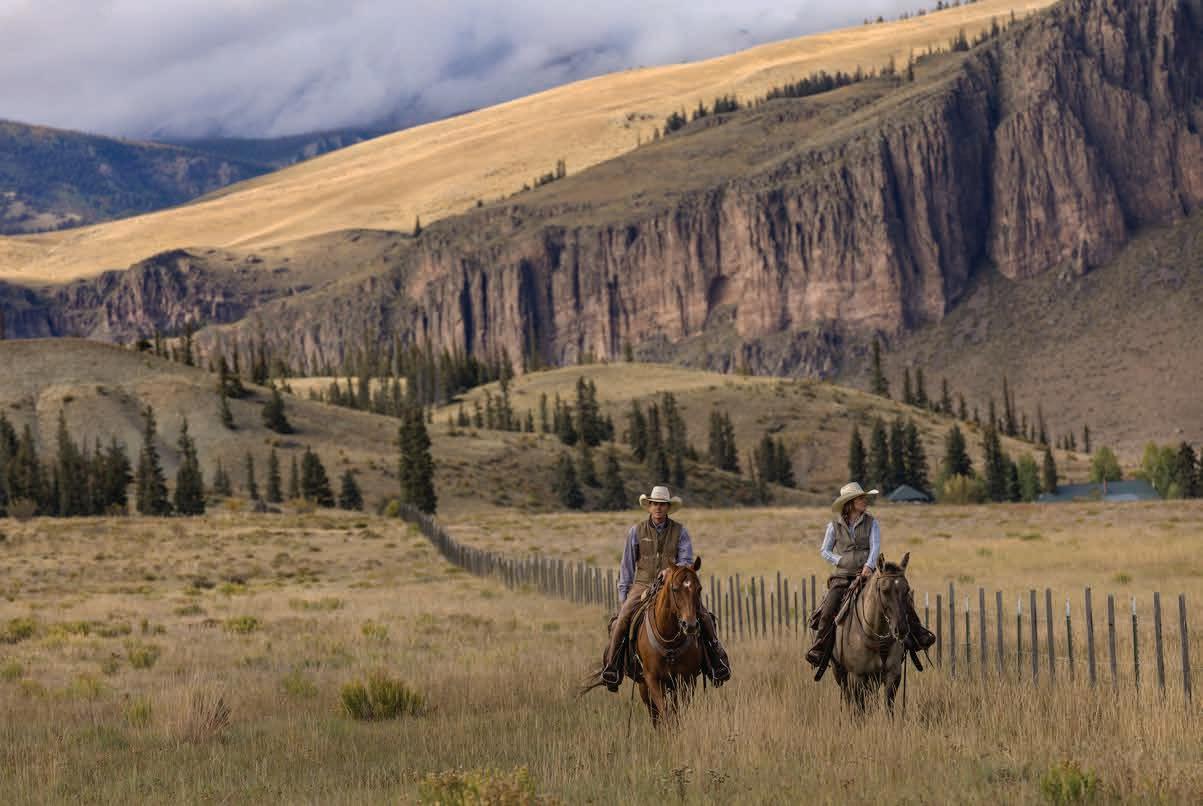
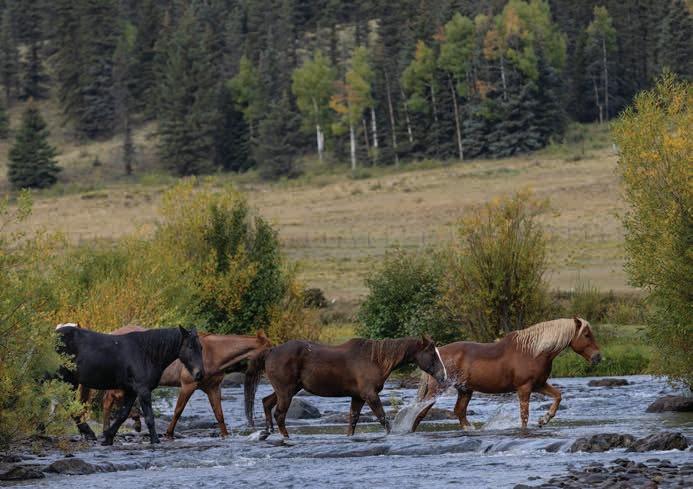
Above 4UR horses cross Goose Creek in the early morning as they head to the ranch.
Right, top The ranch’s weekly tradition of hosting a Friday fish fry for lunch began in the early 20th century. Right, middle President Dwight D. Eisenhower poses for a photo with 4UR guests during his stay at the ranch in the 1950s. Right, bottom Ranch foreman Ed Wintz stands outside the 4UR barn in the 1950s.
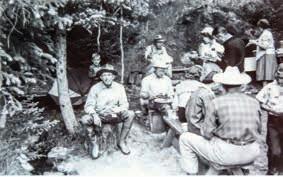
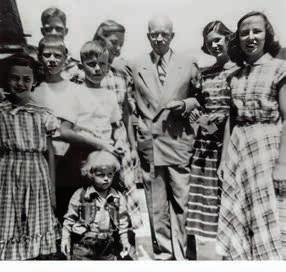
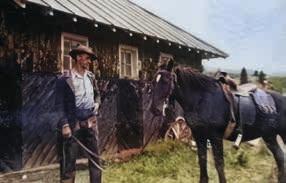
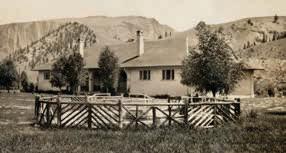
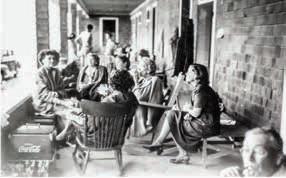
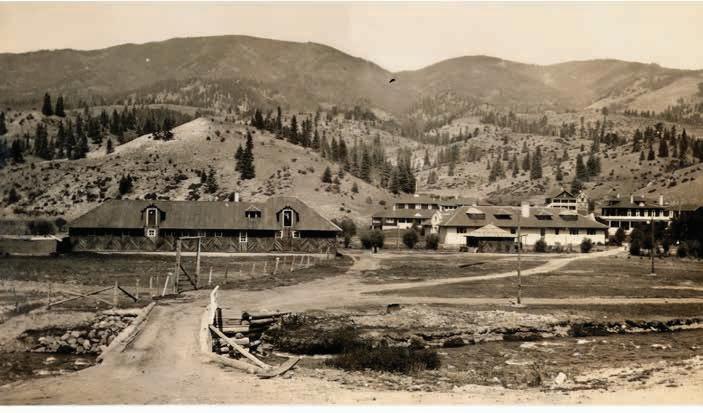
Left, top The Little Medicine Hot Springs sit in the foreground of the original 1903 bathhouse at the 4UR Ranch. The hot springs were the property’s original attraction. Left, above 4UR guests relax on the Amethyst Cabin porch before dinner. Built in 1903, the cabin’s porch still looks like this every summer afternoon. Above A view west toward the 4UR Ranch. All of the original 1903 structures still stand today, with the exception of the first lodge, in the far right of the image. After it burned down, a new lodge was constructed in 1947.

BAR LAZY J
GUEST RANCH
PARSHALL, COLORADO
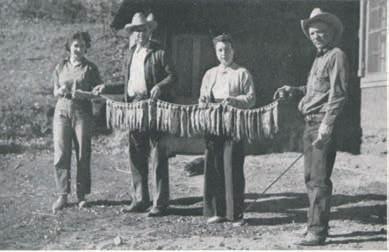
The Buckhorn Ranch, operating today as the Bar Lazy J, is considered the oldest continuously operating guest ranch in Colorado. In 1904, businessman James S. Ferguson and his wife, Florence (“Brownie”), an English socialite, purchased the ranch. They started a partnership with Edgar M. Messiter, an Englishman who came to the States in search of the romance of the West. He had managed cattle and trained horses in the Southwest and mined in Colorado before connecting with the Fergusons.
The three operated the ranch as a hunting lodge and were so successful, their friends from Denver urged them to do more. The Buckhorn Guest Ranch opened in 1912; a few years later, James died and Messiter married Florence. They successfully ran the ranch for three decades.
Early guests stayed in canvas tents along the river. Gradually, cabins supplanted the tents, but canvas remains in the walls. The Messiters were talented riders and raised polo ponies at the ranch. Guests enjoyed trout fishing in the Colorado River, which runs through the property. The atmosphere was formal at first: coffee before breakfast, served elegantly in demitasse cups; polo played on the lawn; and a croquet court between the cabins and the river.
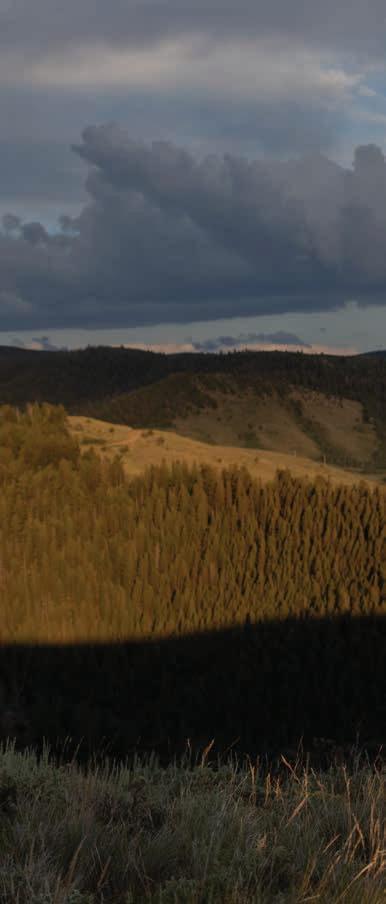
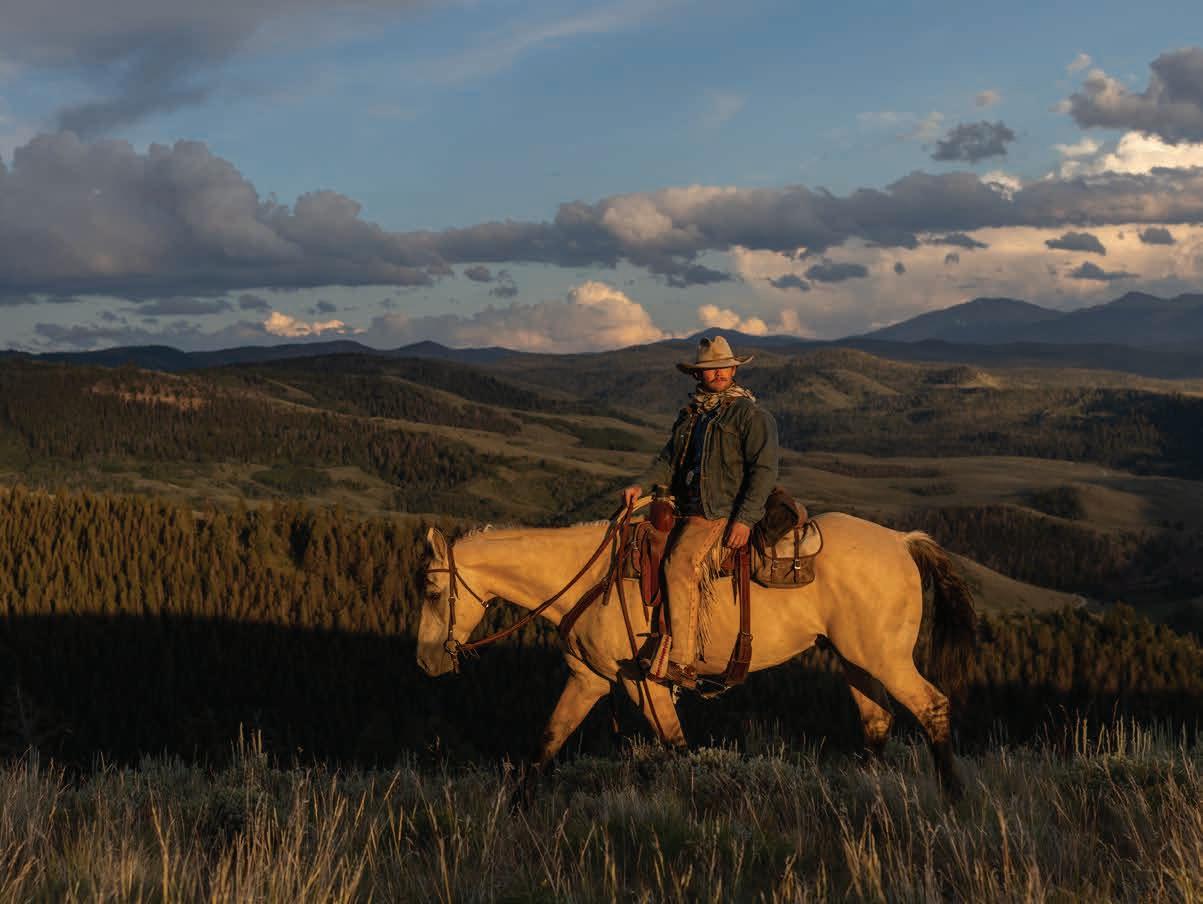
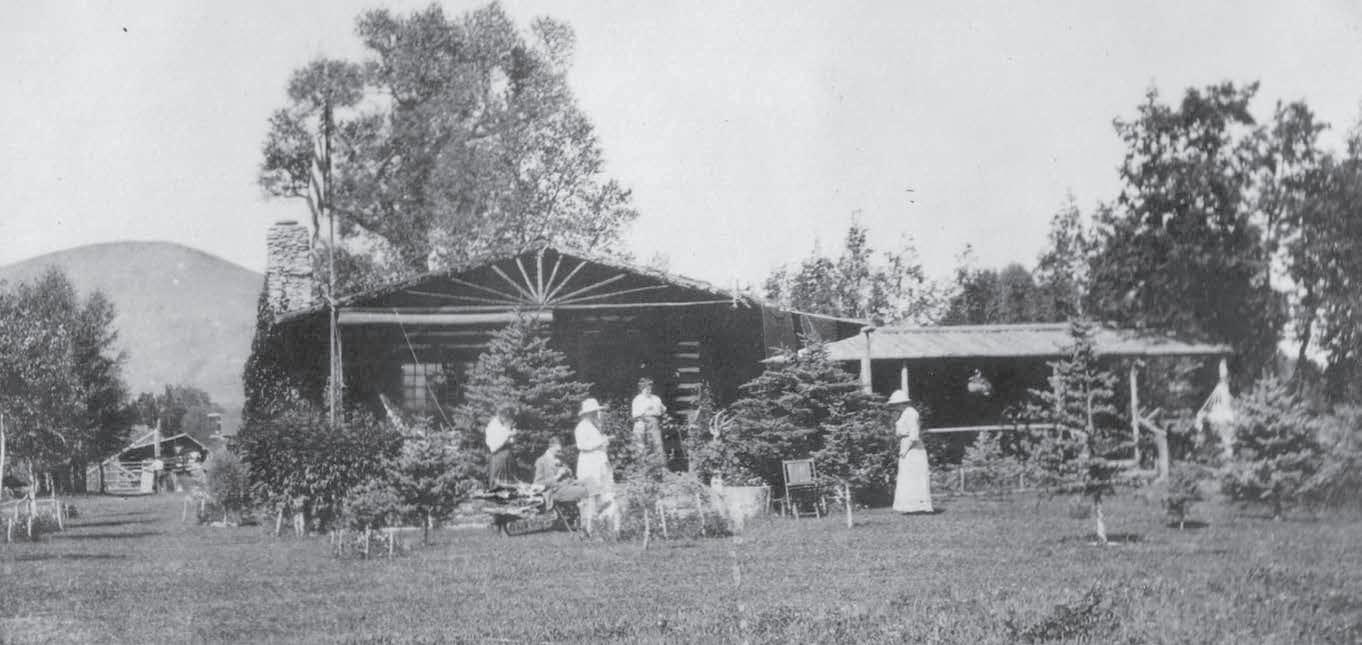
When the Messiters decided to promote the ranch commercially, they hired a young debutante who acted as their social secretary. Guests had to have a letter of reference before they could hope to come to the Buckhorn—and the elite of Colorado came.
In 1945, the Messiters decided they had aged out of the business and sold it to Hugh and Florence Neece. Edgar kept 2 acres and built a house called the
Willows, where he lived on occasion until he died in 1961. The Neeces changed the atmosphere of the ranch by moving a piano into the dining room to furnish dinner music and bringing in a bank of slot machines, which were legal at that time. They also improved the property in several ways and changed the name to the Buckhorn Lodge. Eventually, though, a Texas business interest forced them to sell.
John Kemp and his brother, Casey, ran the ranch for one year in 1951 before Rudy and Mabel Menghini bought it in 1952. The Menghinis were professional musicians, and Mabel had been a well-known opera singer. Rudy had also been a cowboy in Wyoming in his younger days.
The Menghinis modernized the ranch, adding a cocktail lounge and a swimming pool, among other
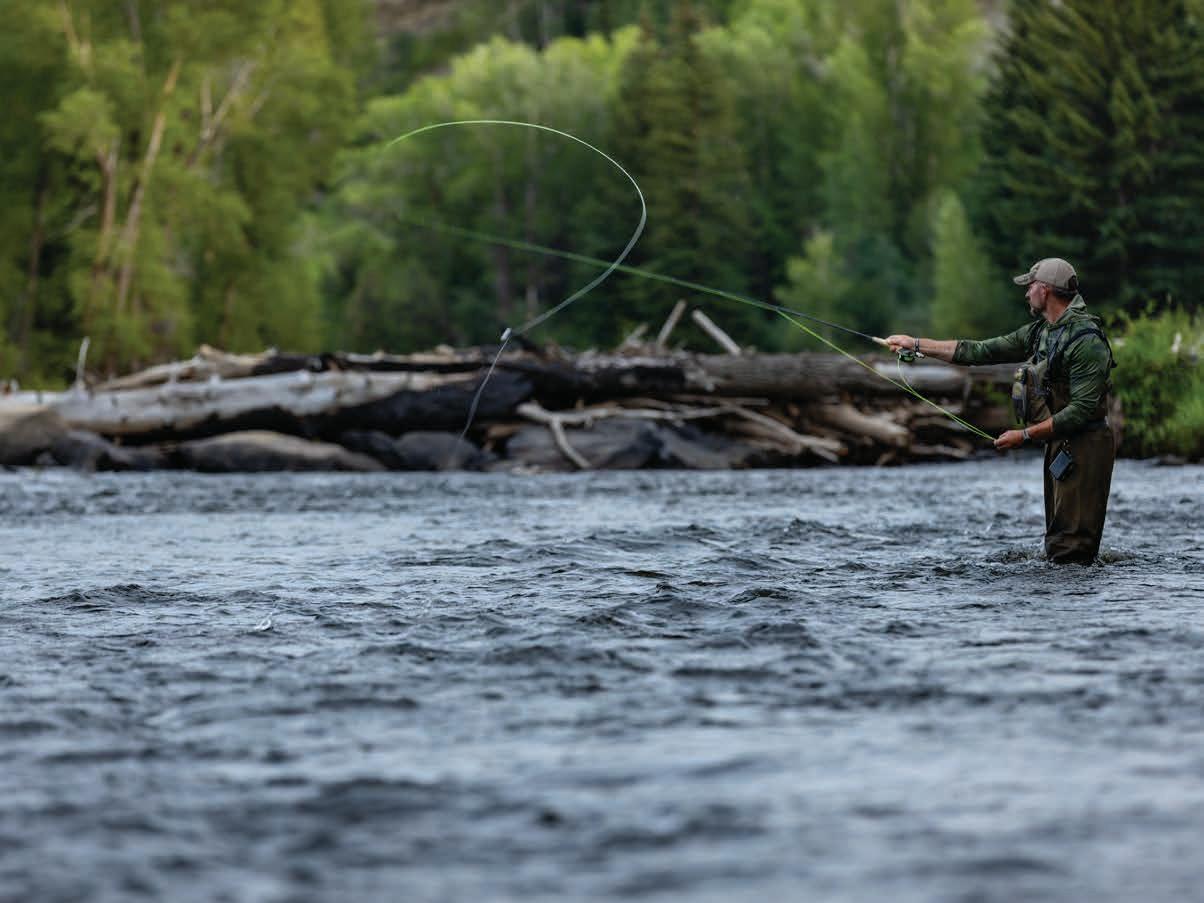
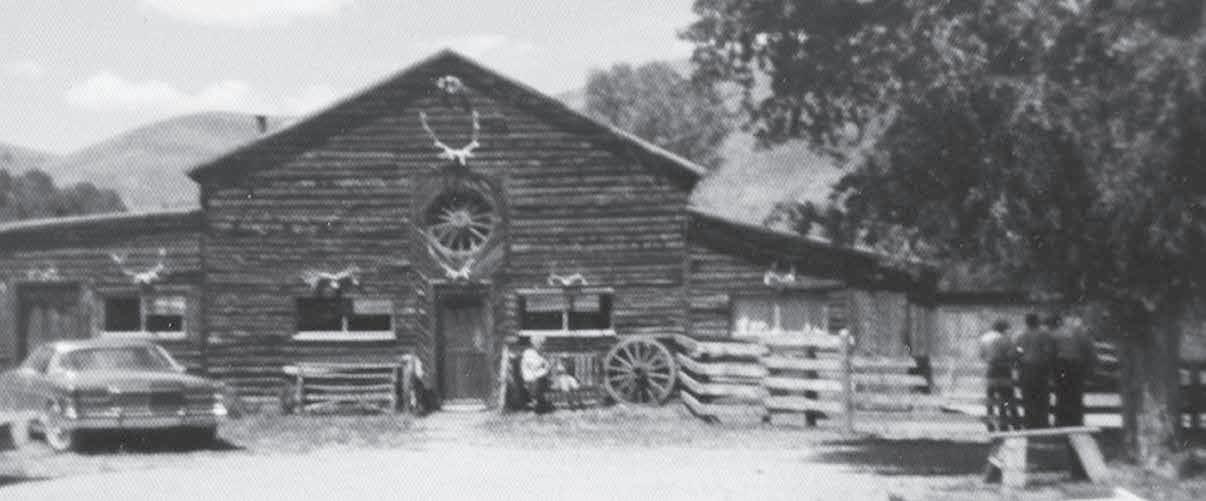
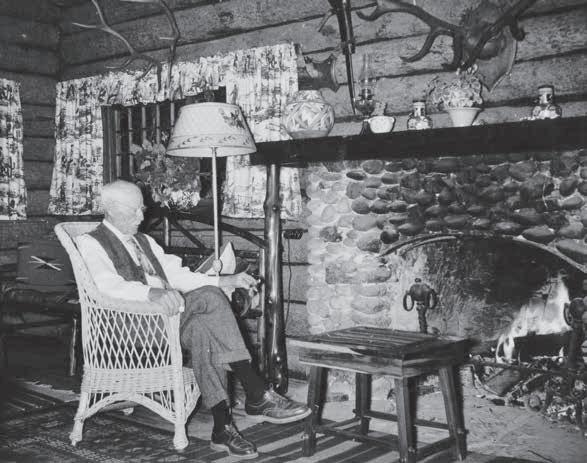
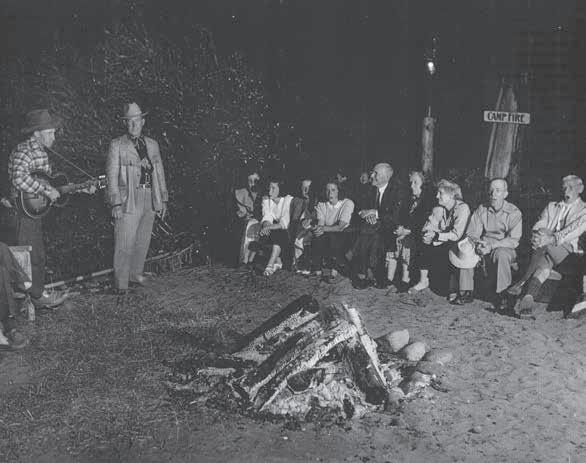
improvements. In 1962, they changed the name to Bar Lazy J, the original brand that had stayed with the ranch.
Chuck and Phyllis Broady bought the ranch in 1968. They added to an existing cabin and created a family home, becoming the first owners to live on the ranch year-round. The Broadys put added emphasis on horseback riding and creating a family-oriented environment. When their boys were grown, the Broadys decided to retire and put the ranch on the market.
Larry and Barbara Harmon then owned the ranch for eight years, expanding the riding program and improving and adding to the existing buildings and cabins.
Jerry and Cheri Amos-Helmicki purchased the ranch in November 1995. As outdoors enthusiasts, they want to share their experiences with their guests and work hard to continue the original dude ranch theme, with an atmosphere of warm, friendly hospitality and a Western experience for all.
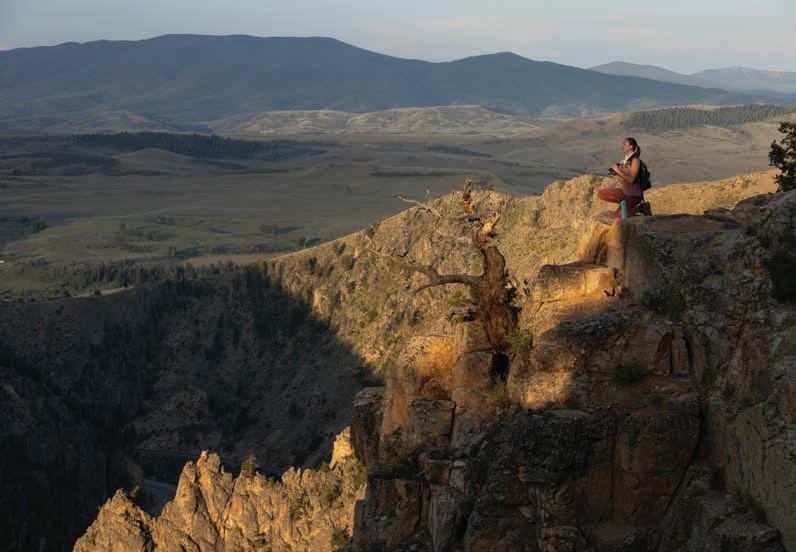
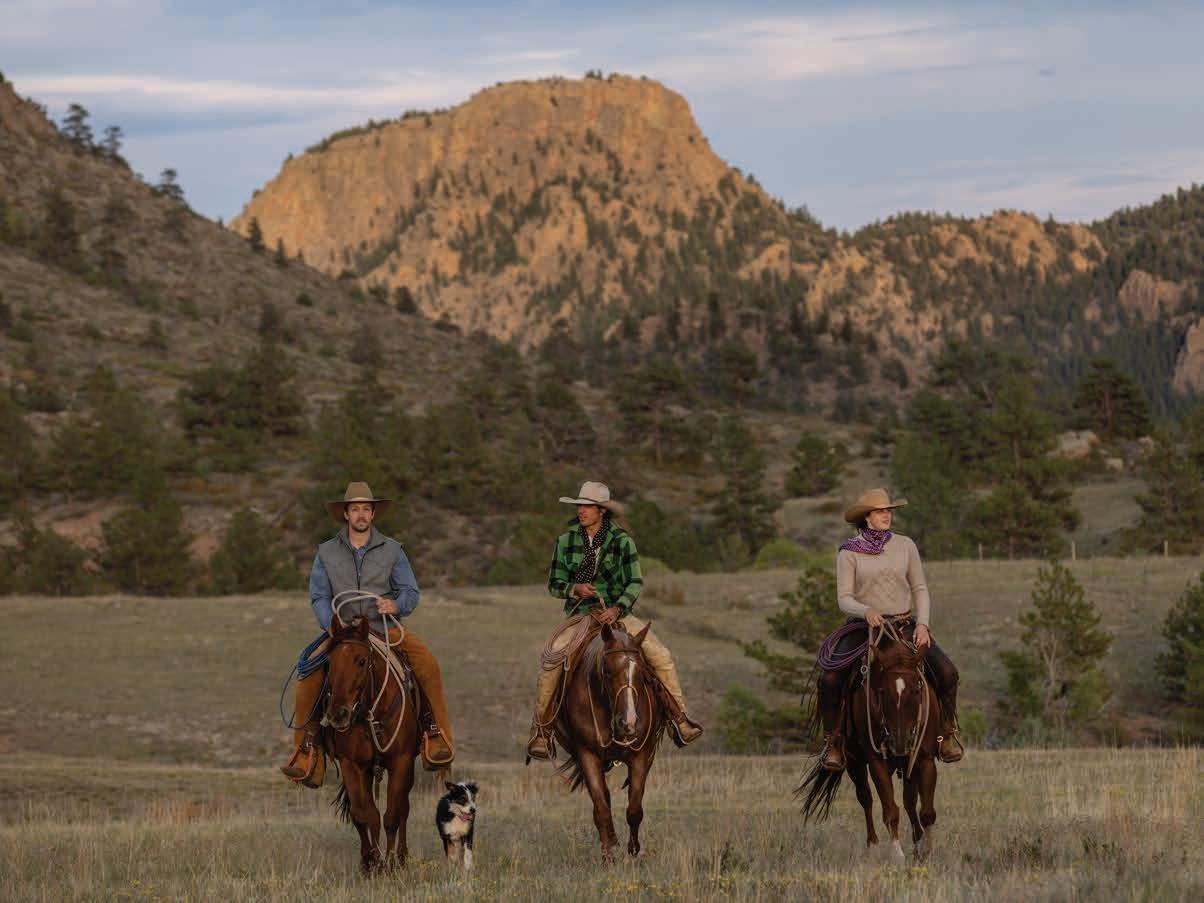

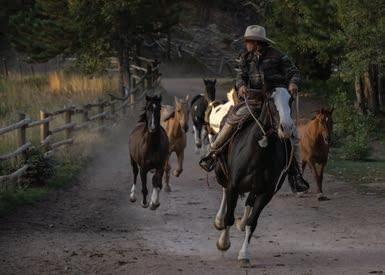
Cherokee Park Ranch was founded by William T. Campton and his wife, Phoebe, outside of Livermore, Colorado. They bought the ranch in 1886, after it was originally homesteaded in 1883 by Henry T. Miller, and family records indicate they welcomed guests into their home almost immediately as the ranch became a colorful stagecoach stop between Fort Collins, Colorado, and Laramie, Wyoming.
The Camptons, though, weren’t the first people at Cherokee Park, which was originally homesteaded in 1852 by a Cherokee cattle trader named Parks, who was driving cattle through Northern Colorado. And many Indigenous artifacts could be found on the ranch in its early years, a testament to the area’s more distant history.
In 1895, the original single-story home burned down, so work began on a new, two-story log structure that still stands today. It included several guest rooms, a kitchen, a dining room and a parlor. Later, log cabins were added for additional guests, and at its height, the ranch could serve 200 guests per night.
In its early years, it was called Campton’s Hotel or Campton’s Resort at Cherokee Park, and it became well known for its hospitality and dining.

CHEROKEE PARK RANCH
LIVERMORE, COLORADO
Founded: Homesteaded 1883
Founders: William and Phoebe Campton
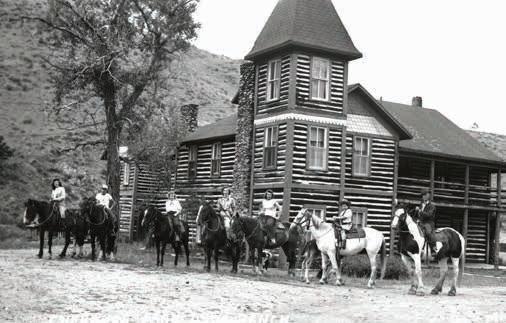
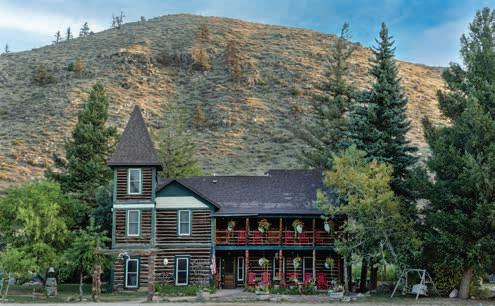
To feed their hungry guests, the Camptons maintained fruit and vegetable gardens, raised dairy cows, butchered their own beef, and sourced fresh eggs and chickens from a local poultry farm.
Cherokee Park had a local spring, famous for the “life-giving waters” often advertised in the resort’s brochures. The mountain resort offered saddle horses to its guests, who could go hunting or fishing in nearby waterways, including the Poudre River. Ballroom or square dancing, sometimes accompanied by a live orchestra, was another offering.
The ranch later had its own post office, and. the old post office cabinet still stands in the lodge office, where it was located in the 1890s. The ranch frequently advertised in local newspapers and in those of large Eastern cities such as New York and Chicago.
In 1917, the Camptons left the ranch and their daughter, Louise, and her husband, Jack Bell, operated it for the next 20 years. The Great Depression, though, created hardships that made it difficult to continue. Ownership changed hands until Herbert and Minnie Ford bought the property in 1949 and ran it as a guest ranch until 1974. Over that time, the ranch had only three cooks, and their delicious meals brought guests back year after year. The Fords provided a Western experience that included square dancing, Wild West shows and trips to Cheyenne Frontier Days in the summer.
In later years, the ranch became a church camp for a little over a decade, then was purchased in 1992 by William and Elizabeth Elfland and their partners, Jim and Mary Dale Gordon, and run once again as a dude ranch.
Christine and Dickey Prince of Tennessee bought the property in 1996 after having been guests in the early ’90s. The Princes have made the ranch their home and operate it during the summers, hosting more than 500 guests each season.
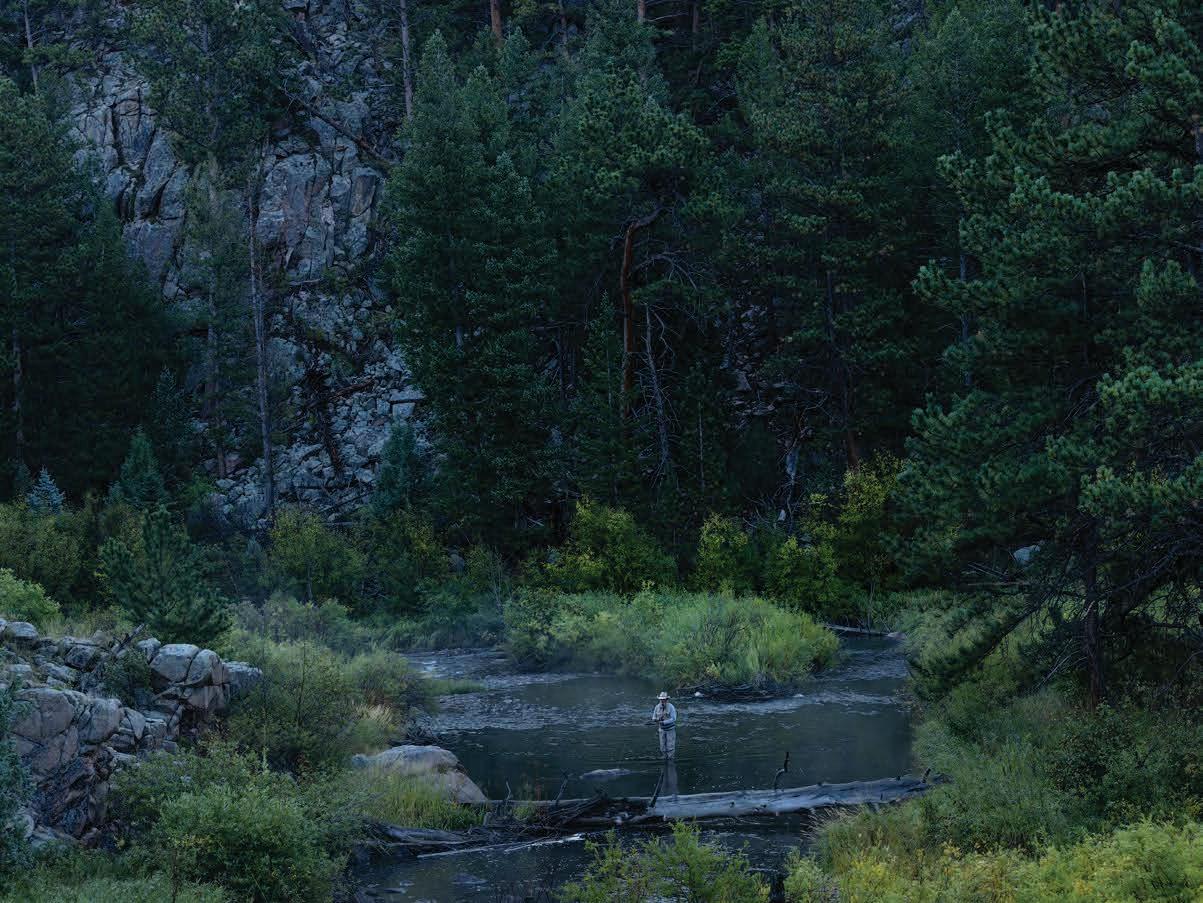
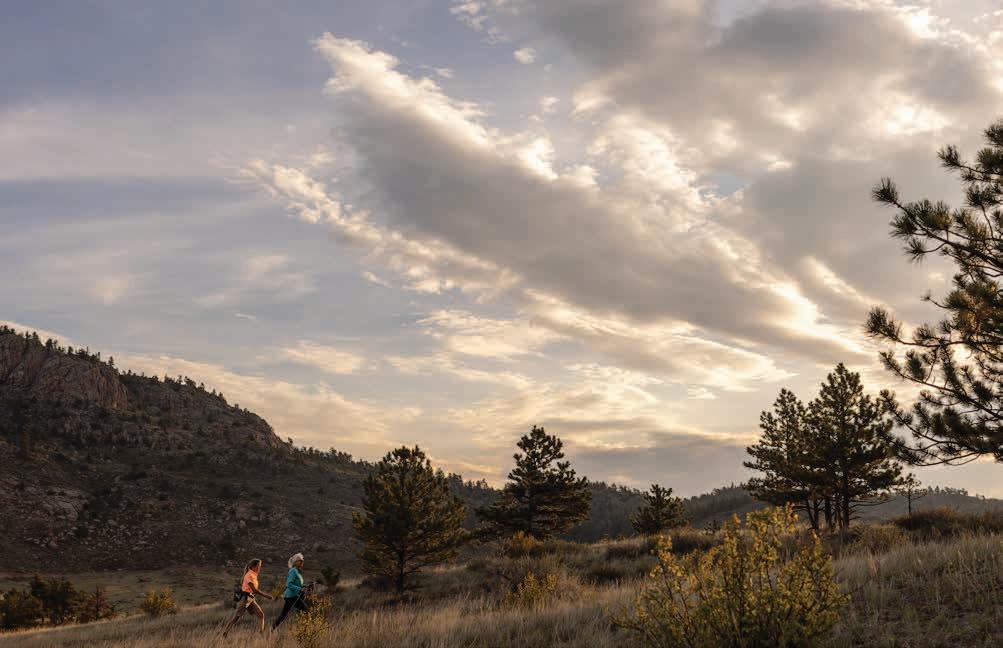
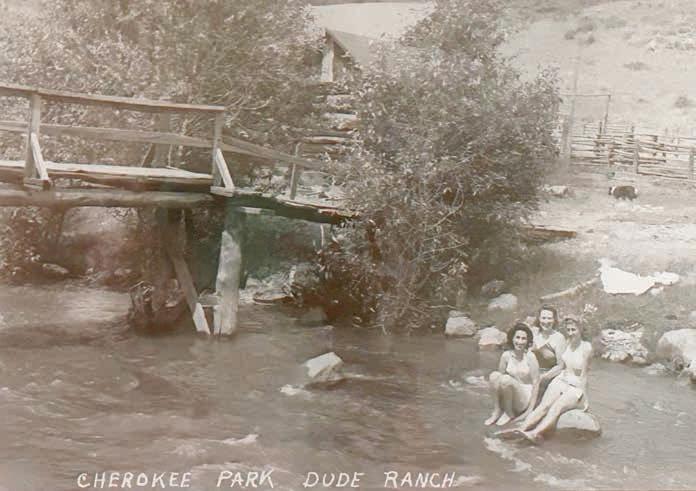
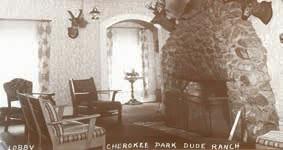

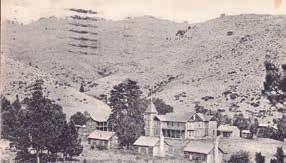
Hiking at Cherokee Park Ranch. Above Cherokee Park dudes swim in the North Fork of the Cache la Poudre. Right, top The lobby of the ranch’s main lodge. At its peak, the ranch could host up to 200 guests. Right, middle The lodge at Cherokee Park Ranch. The original structure burned down in 1895, so construction began on this two-story lodge, which includes a kitchen, a dining area and guest rooms. Right, bottom An advertisement for Campton’s Resort, the original name of Cherokee Park Ranch.
C LAZY U RANCH
GRANBY, COLORADO
Founded: 1919 Founders: The Smillie family
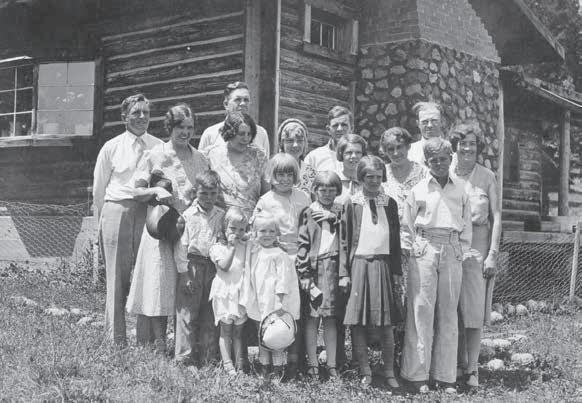
The C Lazy U Ranch boasts a storied past that spans more than a century — and began with two pioneering families, the Smillies and McQuearys, who settled in Colorado during the territorial era.
In 1917, Wilson Smillie, a doctor and professor at Harvard University, purchased a ranch on Willow Creek that then was called the F Slash. His brother, Jack, managed the ranch and later married Gertrude McQueary, a member of the neighboring McQueary family. The Smillies developed the ranch into a working guest ranch beginning in 1919.
In 1922, the Smillies and their four children built a barn, along with several other structures that are still standing: the Meadow House, the River House, the old Bunk House, the Spring House, the Aspen House and the Bird’s Nest. The Ranch House served as the Smillies’ home and had a kitchen and dining room for their guests. Because of this expansion, the ranch could accommodate about two dozen guests for horseback riding, trout fishing and bear hunting, plus all the steaks and fresh-baked pies, prepared by Gertrude, that they could eat.
In 1946, Dick and Katie Schoenberger purchased the ranch and renamed it the C Lazy U Ranch, a name inspired by the lazy, winding
Above The Smillie family, who founded the F Slash Ranch — which later became the C Lazy U. Right Riding Dexter Ridge at sunset with the Continental Divide and Rocky Mountains in the background.
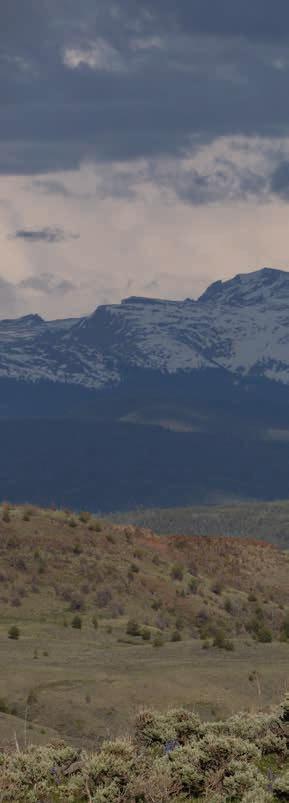
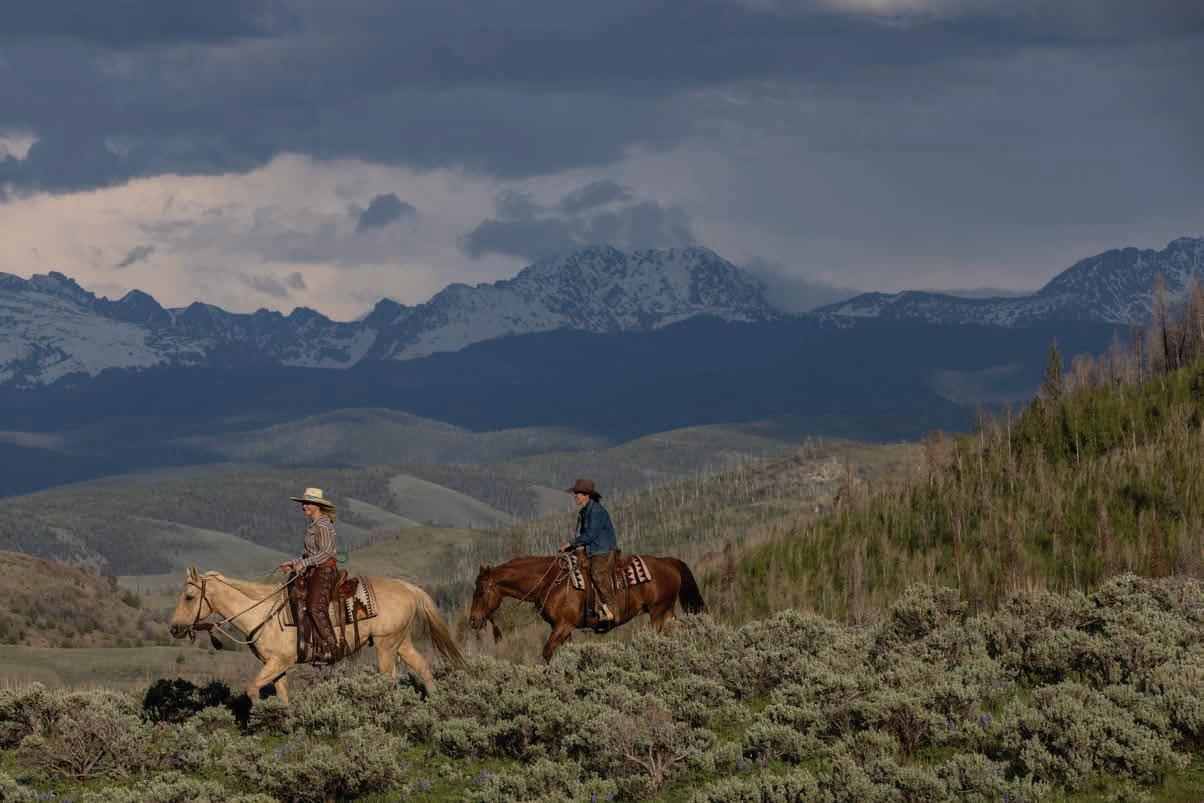
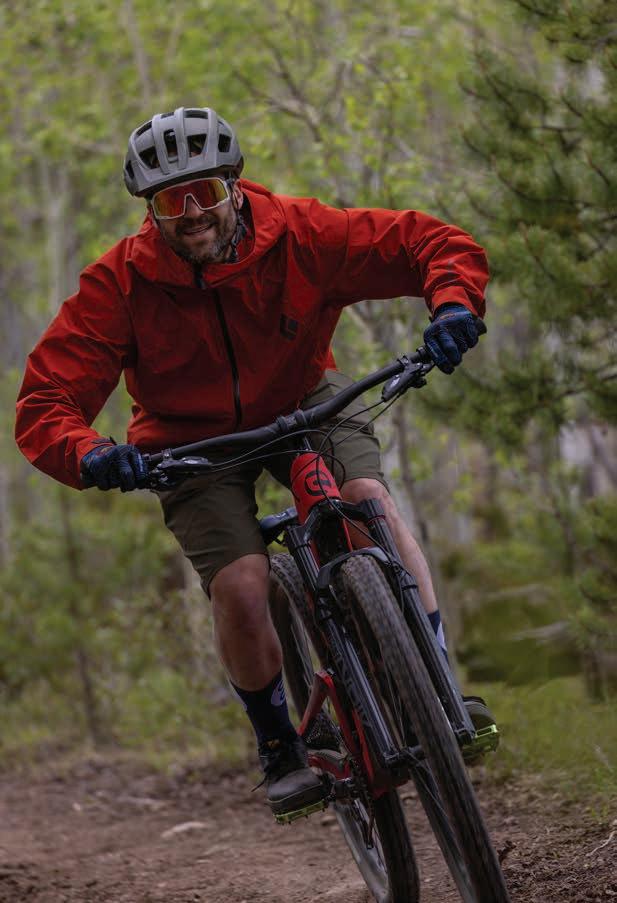
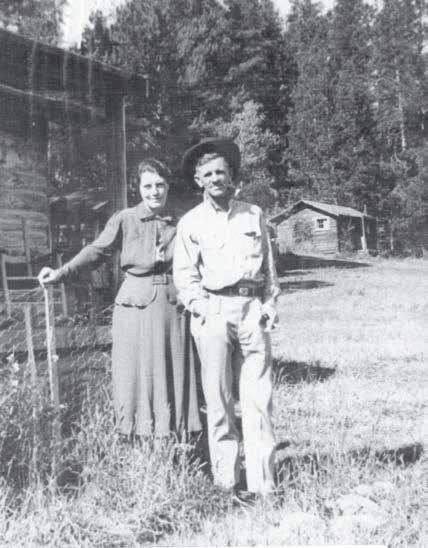
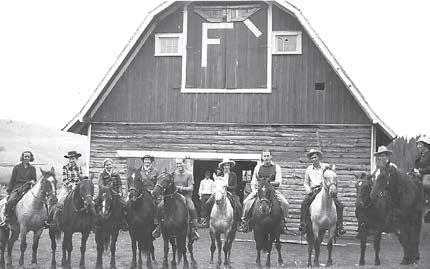
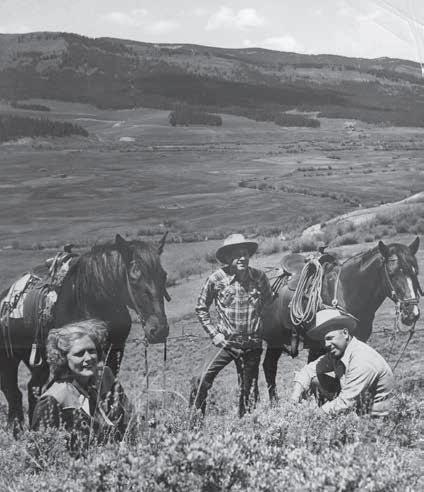
shape of Willow Creek. The Schoenbergers brought a touch of New York sophistication to the ranch while expanding its facilities and offerings, including the renowned children’s program.
Construction of the main lodge began in 1947. The lodgepole pine logs were all felled from the Baldy Mountain hillside directly adjacent to the ranch and dragged to the site by chains attached to Jeeps. All the stripping, notching and joining was done on-site by carpenters skilled in building log structures. With the addition of the lodge and more guest rooms, the Schoenbergers could entertain guests in the winter.
After Katie’s passing, the ranch was sold to George and Virginia Mullins, who had discovered the property on their honeymoon. They added new facilities, including a racquetball court, whirlpool and sauna; they also extended the summer season into October and further developed the winter program by adding groomed cross-country ski trails.
In 1988, Clark and Peg Murray of Kansas City, who had been visiting the ranch for more than 30 years, purchased the C Lazy U Ranch. The Murrays
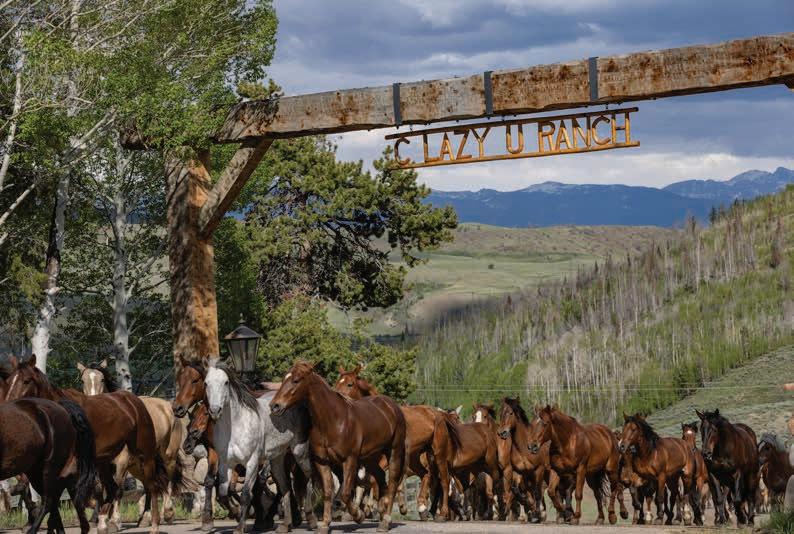
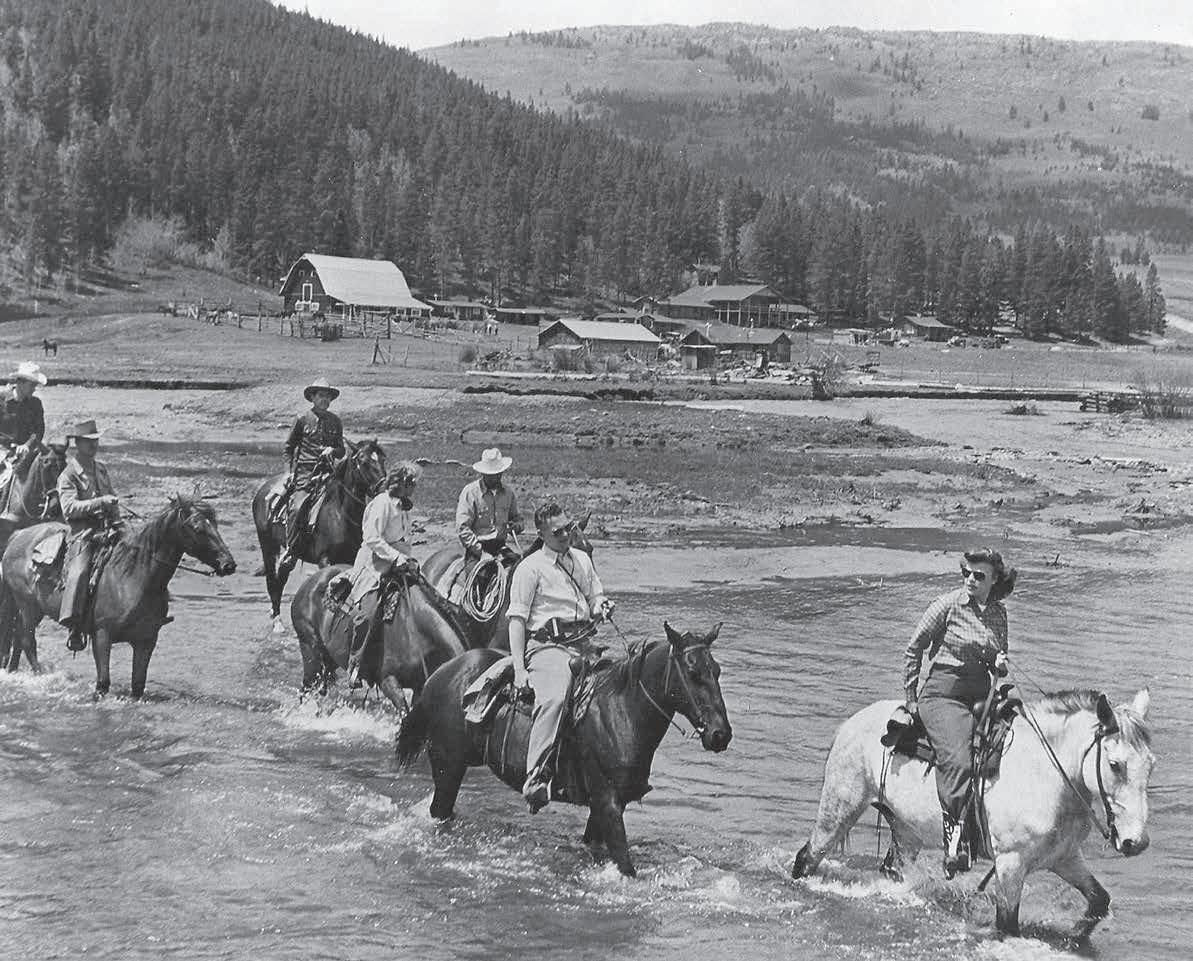
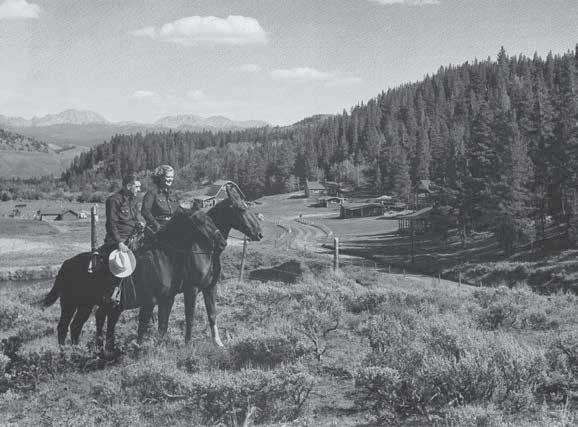
continued the tradition of providing exceptional guest experiences while expanding the ranch’s facilities and programs. In 2008, the family formed a partnership with three other families — the Jacobses, Singletons and Baileys/Stanfords — to preserve the ranch’s legacy. Today, the ownership group prefers the name Stewardship and is committed to operating as a premier guest ranch, upholding the C Lazy U Ranch legacy, pursuing environmental sustainability and preserving the ranch’s land, which now encompasses 8,500 acres.
The C Lazy U Ranch remains a family-ownedand-operated guest ranch committed to providing an unforgettable experience for its guests and members, and it’s a beloved destination for families, groups and outdoors enthusiasts alike.
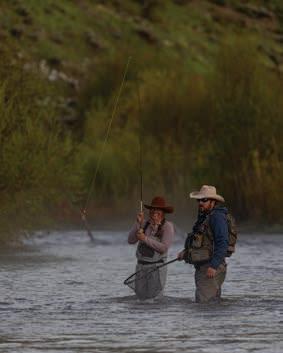
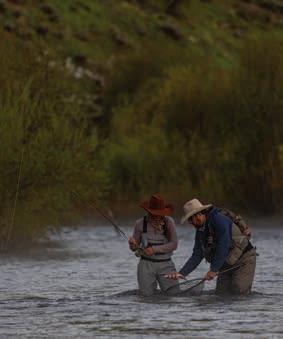


RAINBOW
TROUT RANCH
ANTONITO, COLORADO
Founded: Mid-1920s
Founders: Conejos Ranbow Trout Lodges
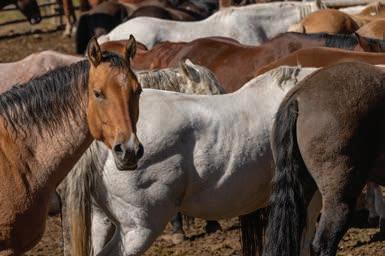
The area surrounding Rainbow Trout Ranch in Southern Colorado was settled by the Spanish in the 1600s, and their legacy endures. The ranch is near several historic Spanish land grants, the river flowing through the property is the Conejos, and the ranch itself is surrounded by the Rio Grande National Forest in the southern San Juan Mountains. To the east is the Sangre de Cristo range, dominated on its southern end by majestic Blanca Peak, which is more than 14,000 feet high and the fourth-highest peak in Colorado. To the north is the fertile San Luis Valley. There are great views of the Sangre de Cristo Mountains and the San Luis Valley from the ranch’s backcountry rides. The towns nearest the ranch are Antonito, Colorado, to the east and Chama, New Mexico, to the south, both reflecting the influence of Spanish culture.
In the 1870s, the relative tranquility of the area was shattered by the discovery of gold and silver. Miners flocked to the region, and numerous small towns were quickly erected; in the mountains northwest of the ranch are the remains of the towns of Platora, Jasper and Stunner. Most such towns
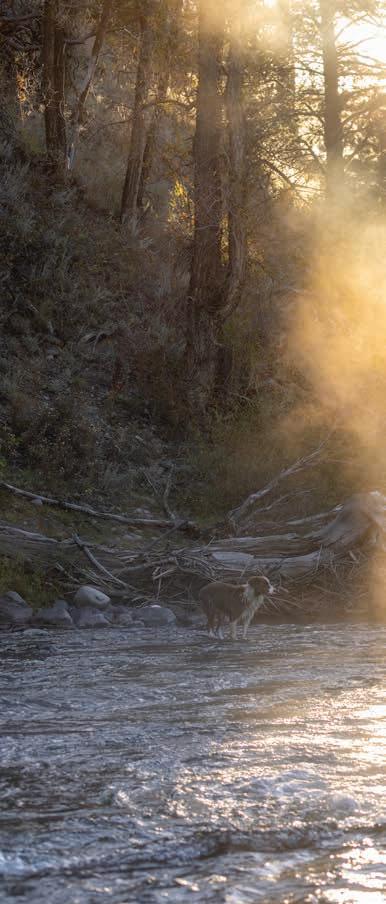
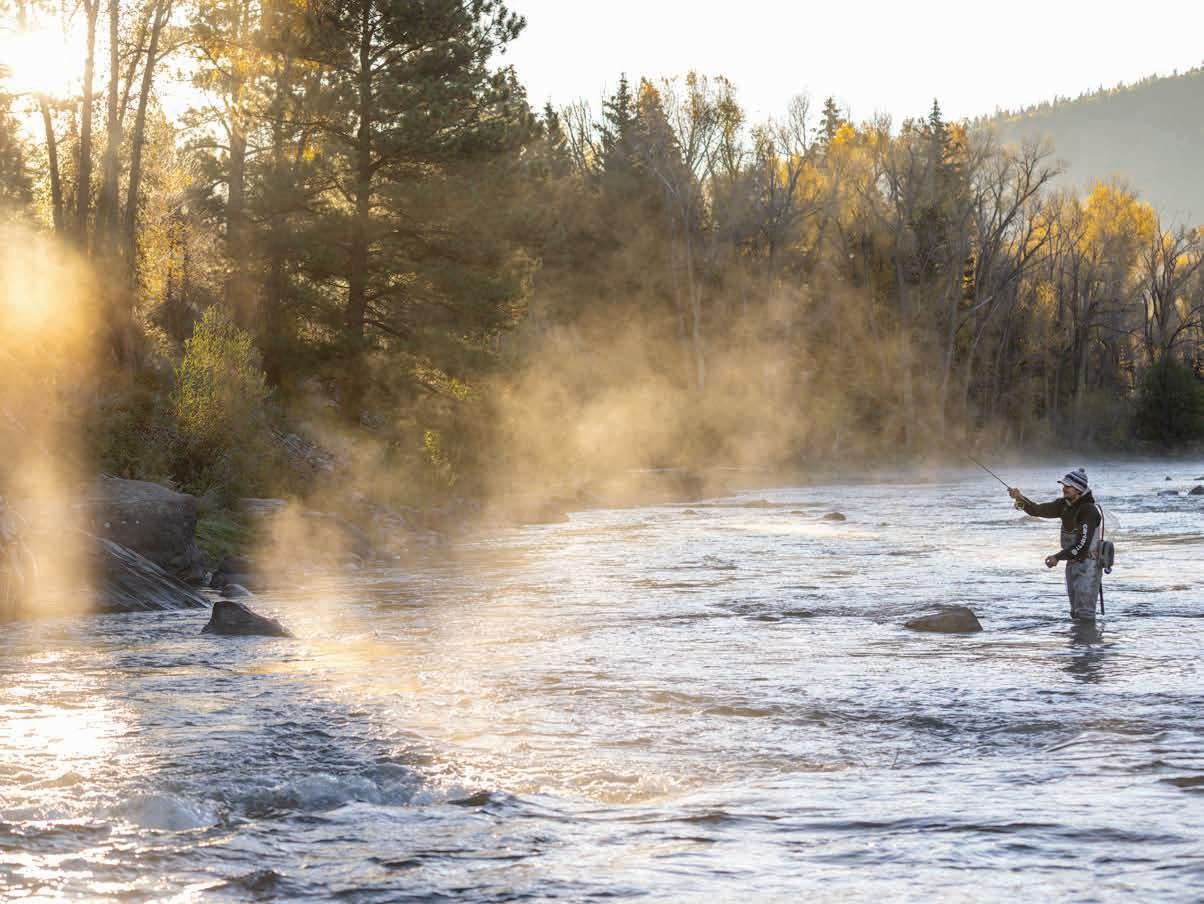
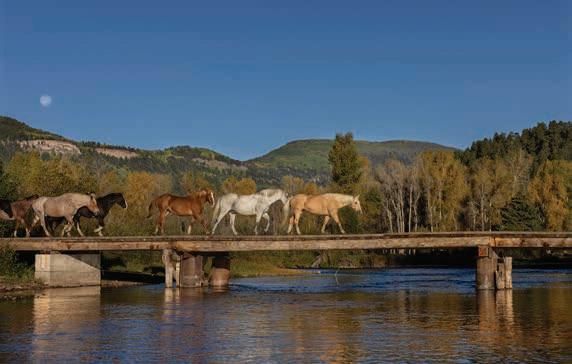
were abandoned early in the 1900s with the demise of the local mining industry.
Longer-lasting than the mining business was the railroad built between Antonito and Chama, in part to serve the miners. Thanks originally to the Denver and Rio Grande Railroad, this line still operates in the summer for sightseers.
By the turn of the 20th century, the ranch was a noted fisherman’s paradise, and soon a private fishing club was established for a select group of sportsmen; this endeavor was known as the Conejos Rainbow Trout Lodges.
To attract more vacationers, well-equipped cabins were built on the
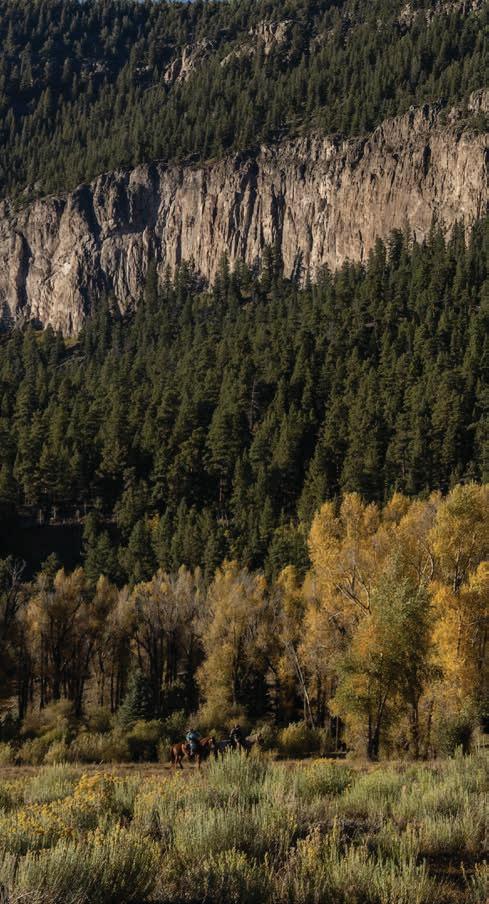
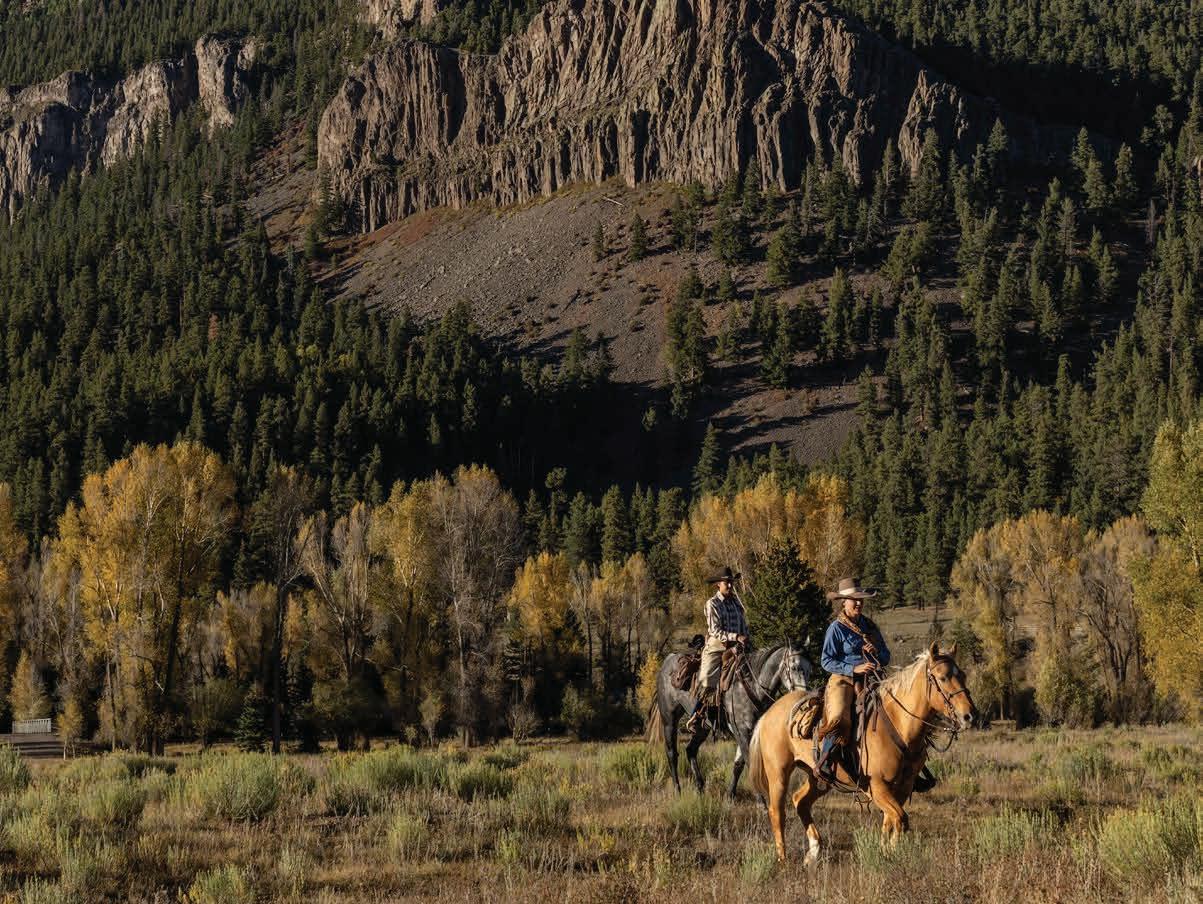
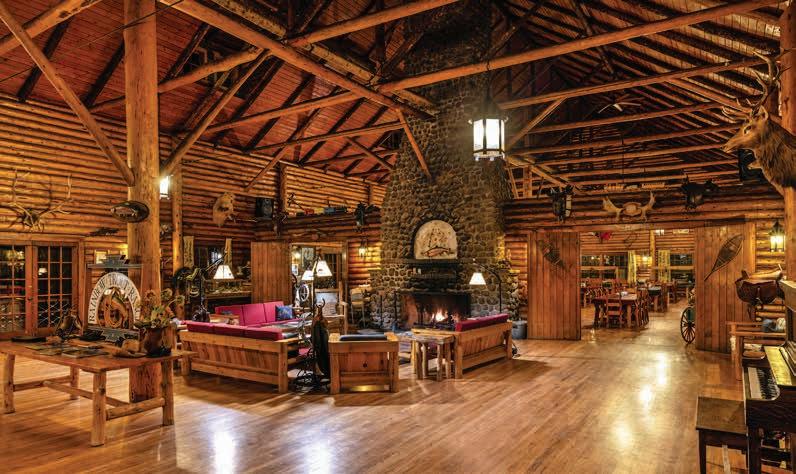
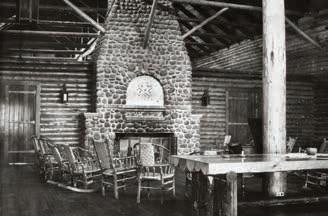
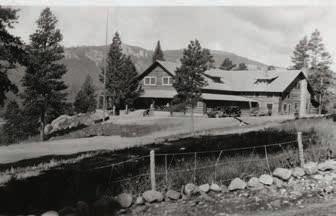
ranch. By the mid-1920s, construction began on the lodge, said to have been the largest log structure in the Southwest at the time. Built with local Engelmann spruce, it is said that not a single nail was used in the 8,000-square-foot structure—just wooden pegs. It was a showpiece of the Rockies and remains so to this day.
In the late 1920s, the lodge opened its doors to the public as a guest ranch with extraordinary fishing. One of the earliest draws was a bathhouse with hot water. There was no electricity until the early 1960s, despite some novel attempts at generating power with a creek-run turbine and, later, a diesel generator. But in spite of the remote canyon location, the ranch did have the only working telephone for miles around, and it often was used by locals needing to make a phone call.
As time went on, Rainbow Trout Lodge developed a reputation for providing unexcelled vacations. It was run by the Hamilton family from 1925 to 1989, then stood empty for three years until it was purchased by the Van Berkum family. The name was changed to Rainbow Trout Ranch, putting more emphasis on horseback riding. Great fishing, horseback riding, programs for children and teens, and evening activities are staples of the ranch experience today. Top left The interior of the ranch’s main lodge as it looks today. Far left The interior of the main lodge historically. Left The lodge at Rainbow Trout Ranch. Construction began in the mid-1920s.
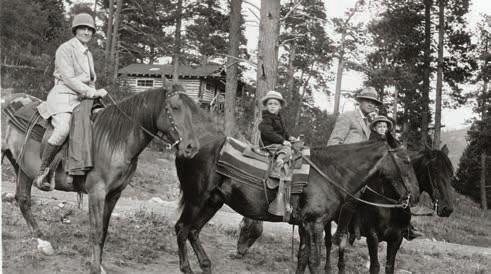
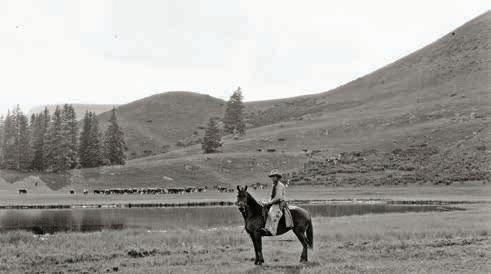
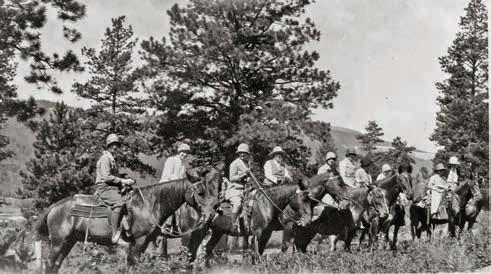
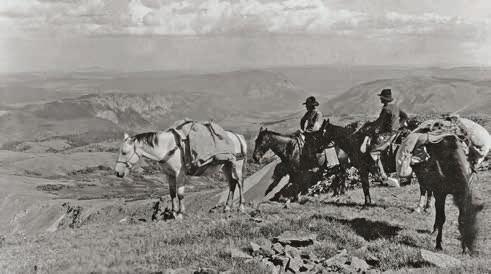
Top, left A family poses for a photo at the Conejos Rainbow Trout Lodges, which later became Rainbow Trout Ranch. Top, right Overlooking the landscape of Southern Colorado on a horseback ride. Above, left A group of dudes at the Conejos Rainbow Trout Lodges. Above, right A pack trip into the Colorado wilderness, another highlight of the dude ranch experience.
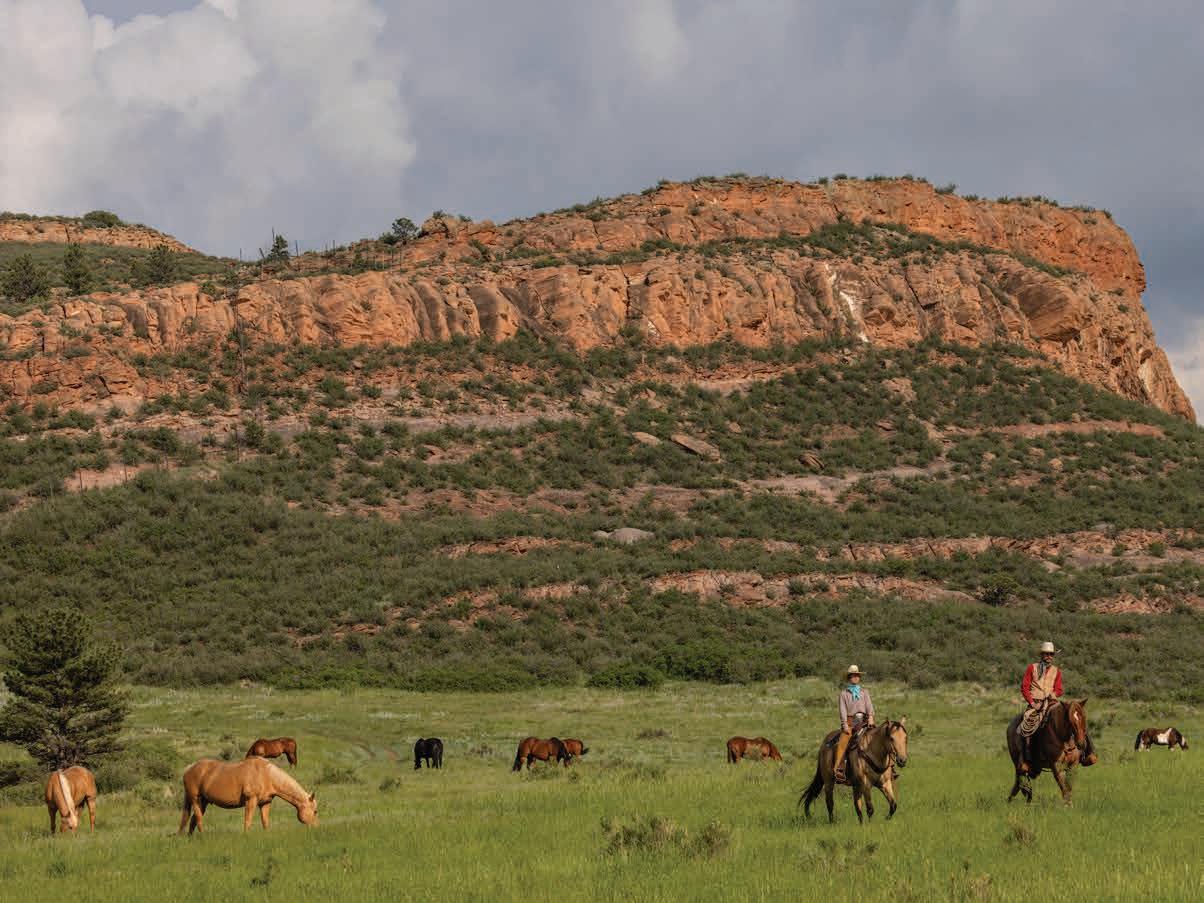

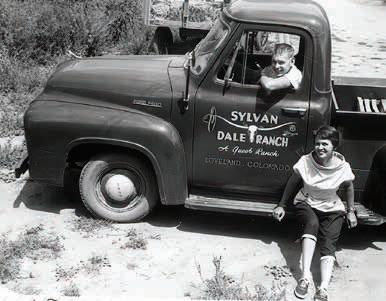
The area Sylvan Dale Ranch calls home has a rich history. Native American tribes wintered in the valley, seeking refuge from the snows of the high country. And in the 1800s, visitors sought healing from respiratory ailments in the crisp, clean mountain air.
European settlers named the area’s valleys, rather than the mountains, and called the valley where the ranch sits Sylvan Dale, or “wooded valley.” It was originally homesteaded in 1864 by a Scotsman, William Alexander.
In 1916, Frend Neville, who ran cattle in the area, established the ranch at the mouth of the Big Thompson River in the foothills west of Loveland, Colorado. Wealthy Easterners came to the area for hunting trips and liked it so much, they wanted to bring their families. So, the Nevilles built cabins and a lodge along the river and offered saddle horses for mountain riding at their new dude ranch, Sylvan Dale.
In 1929, Cotner College, a Christian school based in Lincoln, Nebraska, bought the ranch and held summer sessions that offered college credit to students. During the Great Depression, though, Cotner College closed and Sylvan Dale was leased out as a youth camp. Maurice Jessup,
SYLVAN DALE GUEST RANCH
LOVELAND, COLORADO
Founded: 1916
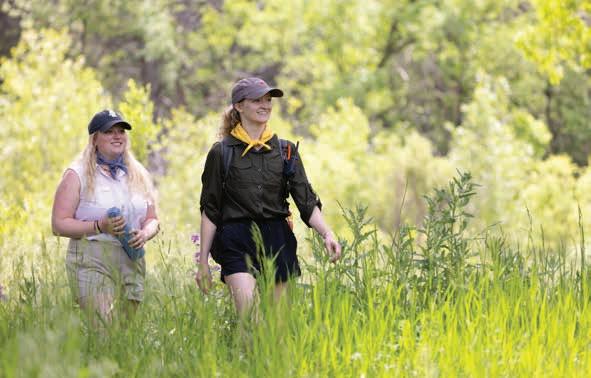
then a college student in Oklahoma, overheard a conversation about the ranch and asked for a summer job.
In 1934, when Jessup arrived in the valley, he had a vision of what the little ranch on the Big Thompson could be someday. He was overwhelmed by the beauty of the mountains and the rushing water, and he immediately told camp director JB Weldon, “You know, I just love this place. Someday, I’m going to own Sylvan Dale.” That was in 1934.
Jessup moved to Colorado to pursue a career in education and met his wife, Mayme, while hoping the opportunity to purchase Sylvan Dale would emerge. Twelve years after his declaration, near the end of World War II, Jessup received a letter informing him the ranch was for sale while he was serving as a lieutenant in the U.S. Army Air Corps. He received
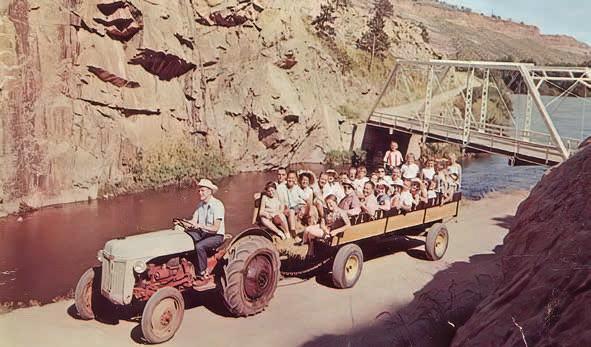
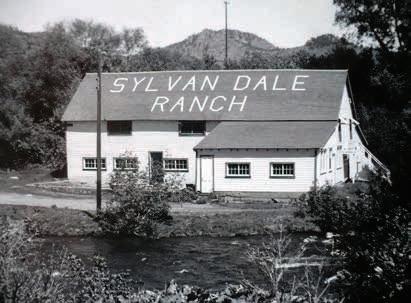
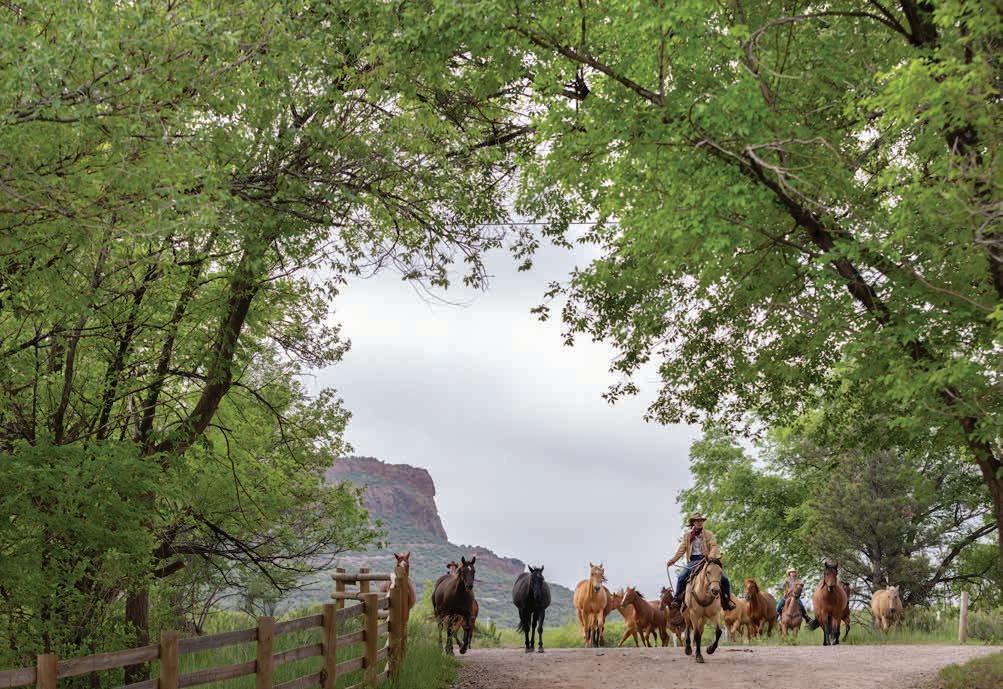
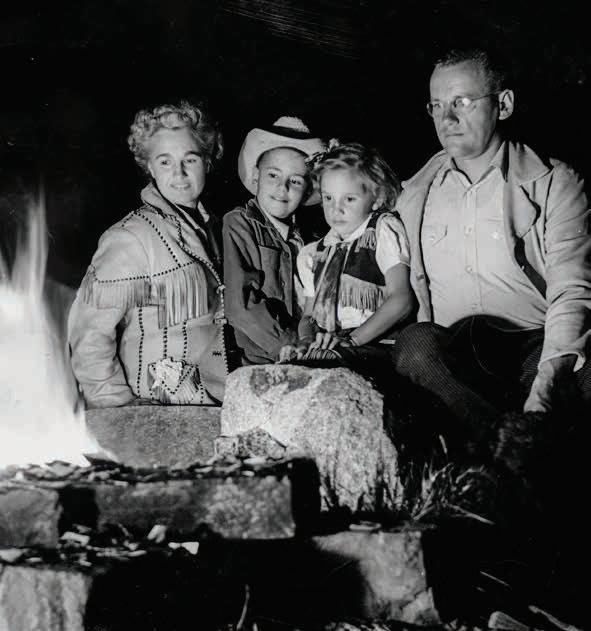
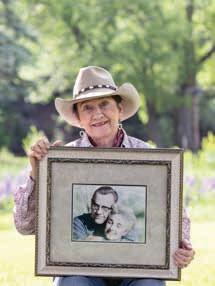
special permission to bid on the property; after scratching his bid on a piece of paper, he and Mayme were awarded the 125-acre, run-down ranch.
Through a lifetime of hopes and dreams solidly based on faith, dedication and hard work, the Jessups and their two children, David and Susan, increased the 125-acre ranch to a 5,000-acre working ranch with cattle, horses and guest facilities to accommodate families and group events. The Big Thompson flood of 1976 threatened to put an end to the dream, but reconstruction efforts were successful, and what once was a summer guest ranch became a year-round facility.
After the flood, Susan took on more responsibility at the ranch in lieu of pursuing a teaching career, and she currently oversees all operations. In 2014, she established the educational nonprofit Heart-J Center for Experiential Learning, which will be the successor organization for the ranch, merging the Jessups’ passions for the ranch and education.
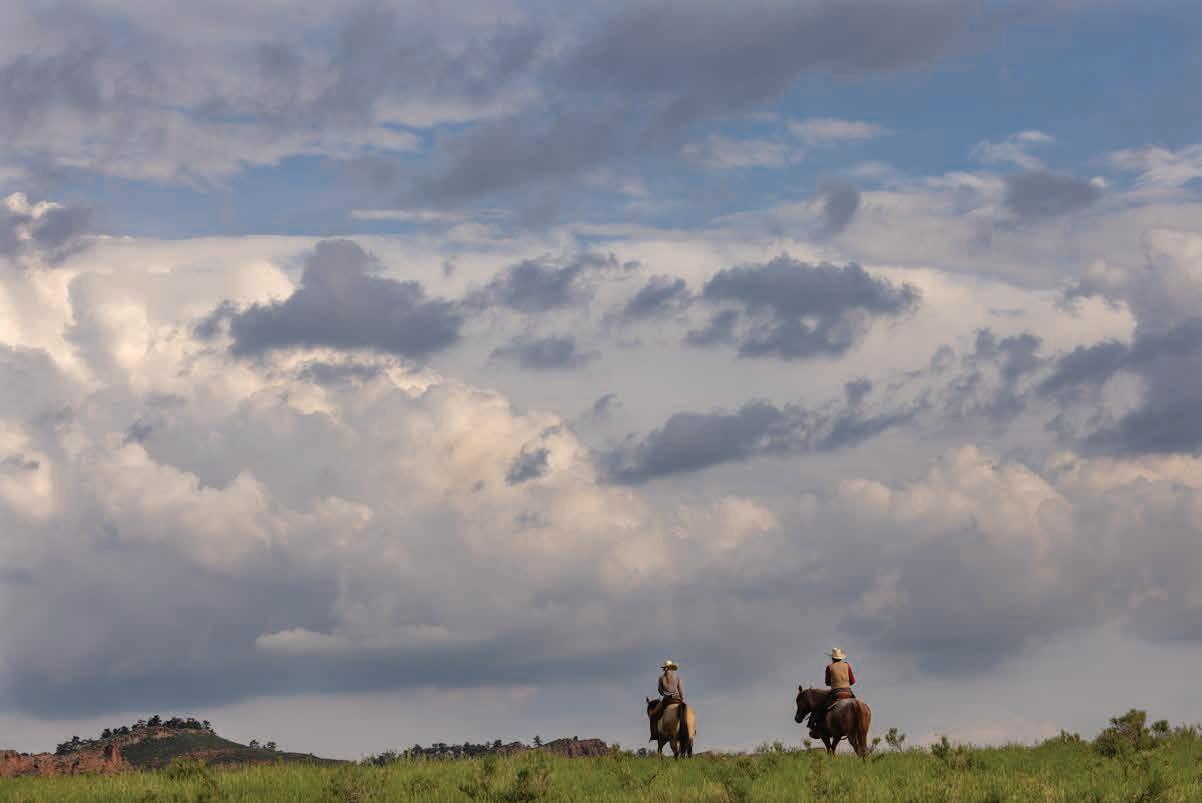
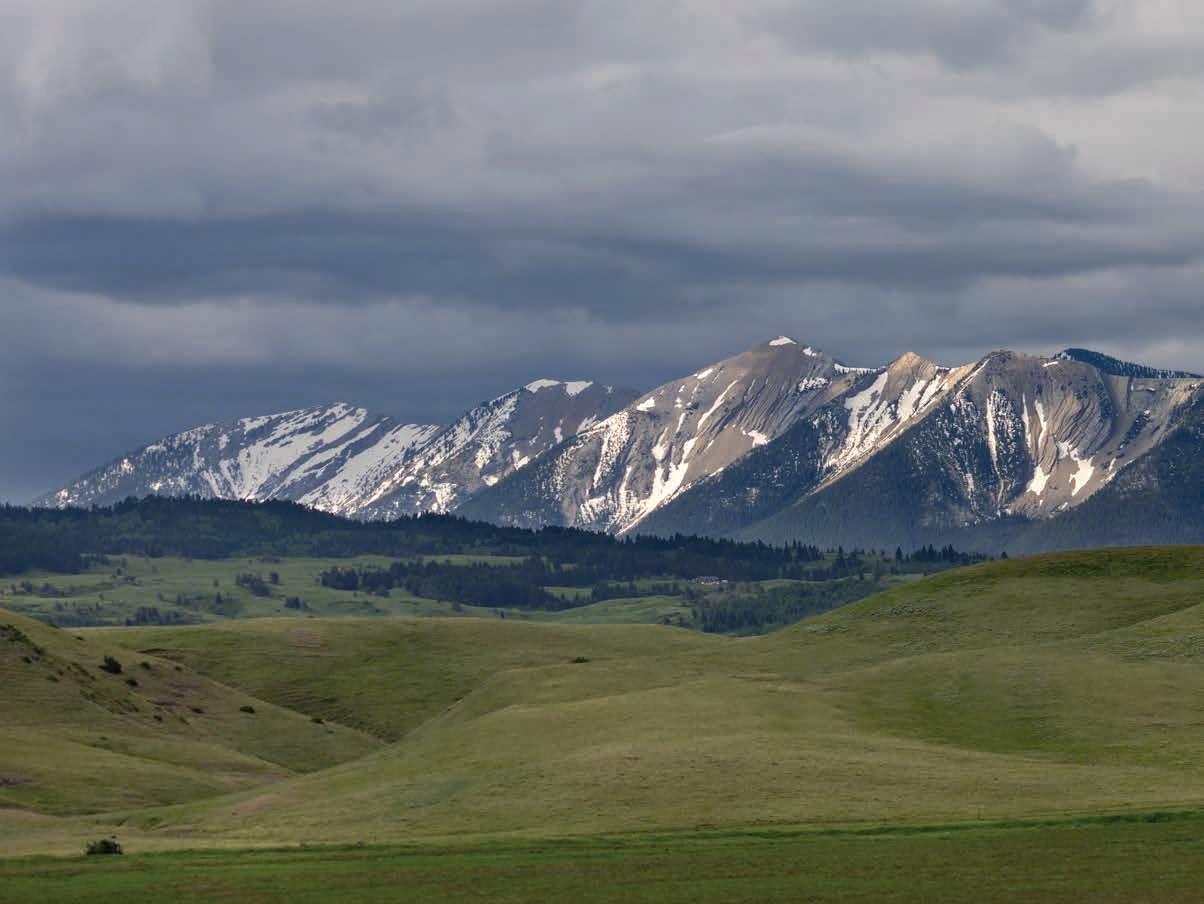
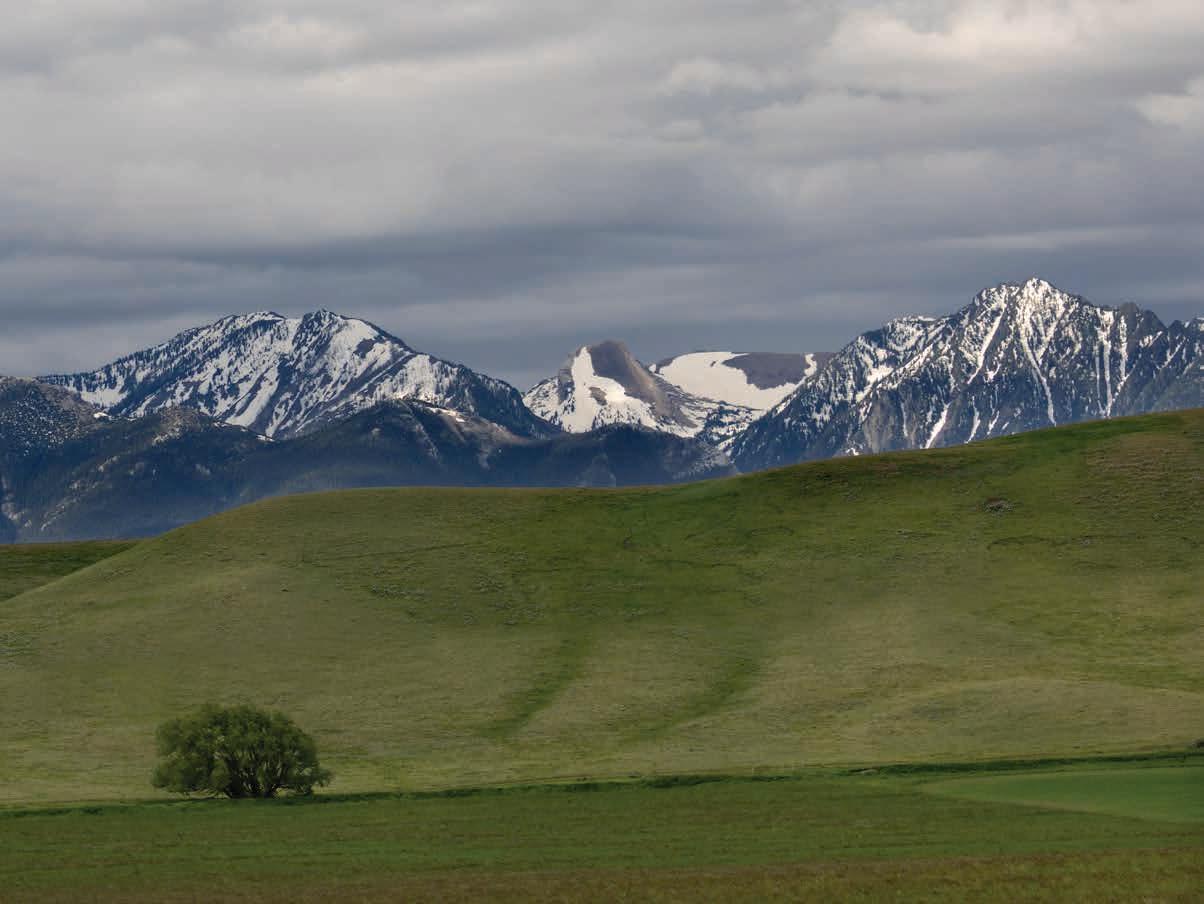

NINE
QUARTER
CIRCLE
RANCH
GALLATIN GATEWAY, MONTANA
Founded: 1912
Founders: M.S. Cunningham and Hans Carl Biering
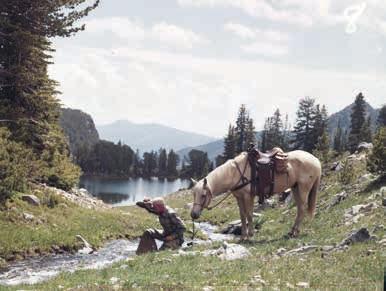
The Nine Quarter Circle Ranch is in Gallatin Canyon of Southwestern Montana, 7 miles from Yellowstone National Park. The area was originally homesteaded by John Kirby in 1903, after people were drawn to the area by the newly founded Yellowstone National Park.
Later that decade, M.S. Cunningham and Hans Carl Biering bought the Nine Quarter Circle Ranch, on the Taylor Fork of the Gallatin. They ran more than 10,000 head of cattle and hosted guests in addition to the crew needed to manage their herd.
Fred Butler, of Chicago, and his family were among the ranch’s first guests, with the original cabins built for their use in the early 1900s. Butler convinced Cunningham to let his boys join in on the cattle operation during the summers; later ranch guests were treated to cattle work, fishing and riding in the mountains.
In 1928, dude ranching officially returned when Bob Cunningham, M.S.’ son, managed the ranch. The Rising Sun Ranch, another
Previous spread The Absaroka Range. Above Howard Kelsey in the 1950s. He purchased the Nine Quarter Circle Ranch in 1946, beginning a tradition of family ownership that has spanned three generations. Right Morning fog lifts around a group of riders at the Nine Quarter Circle.

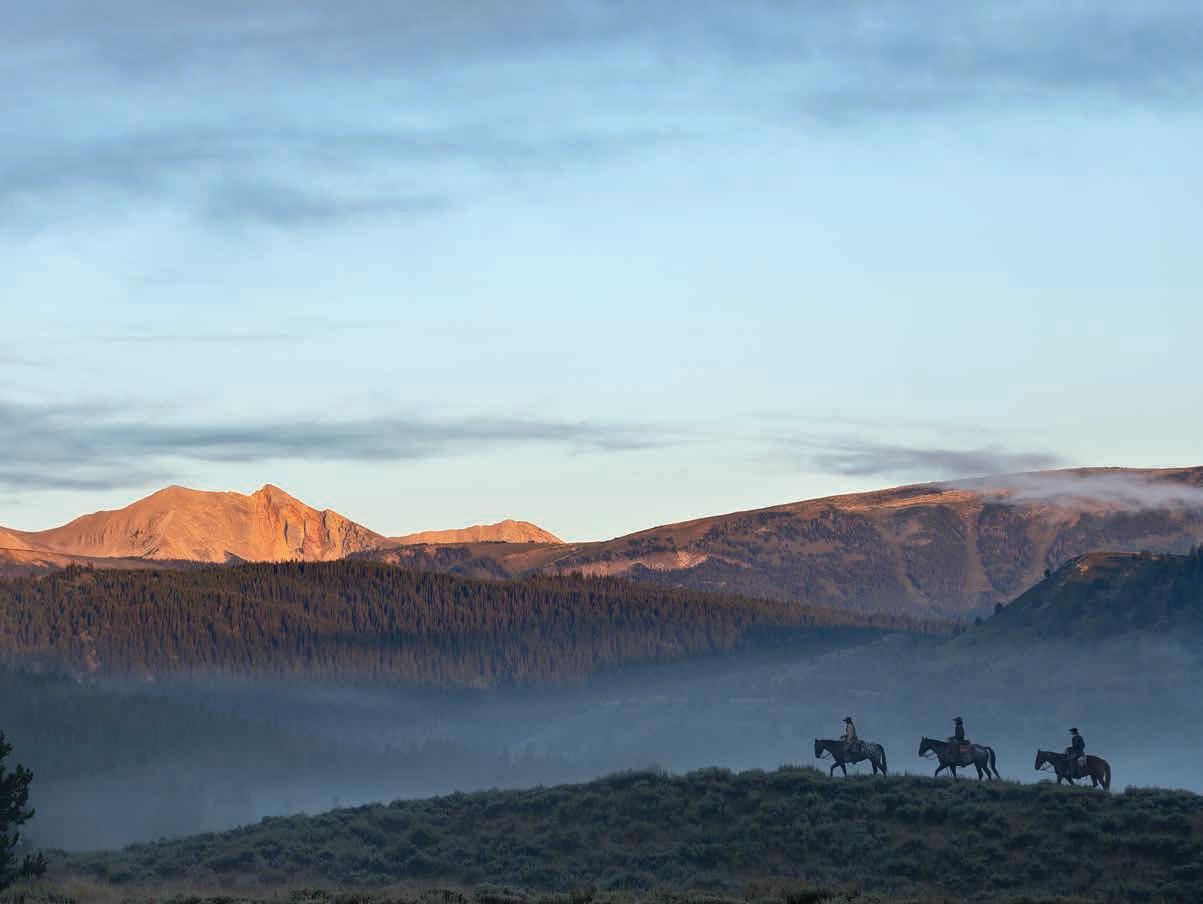
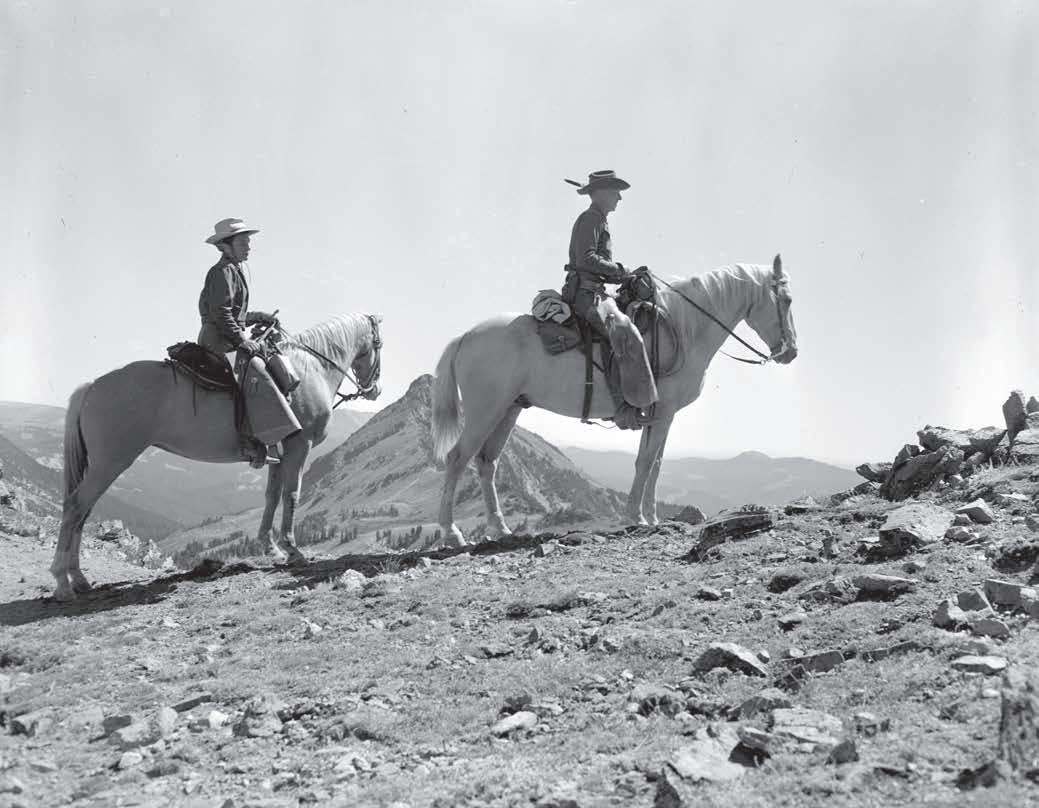
Cunningham property, remained a cattle ranch, while the Nine Quarter Circle ran dudes. The Nine Quarter Circle also acted as the parent ranch and accepted 50 guests at that time.
In the 1920s and ’30s, the Nine Quarter Circle offered cabins lit with electricity, bathhouses equipped with hot water, and the expansive main lodge, which gave guests a place to socialize, dance or play music. The ranch supplied its own chicken, eggs and milk, and in hunting season, wild game — including venison, elk and bear — was served to guests. Dudes enjoyed horseback rides, pack trips, trout fishing and hunting on the adjacent national forest.
Howard Kelsey purchased the ranch from the Butlers in 1946, after he returned from World War II. Thus began a tradition of Kelsey family ownership that spans three generations. In the 1950s, Howard began the ranch’s exclusive Appaloosa herd, all of which have been bred, raised and trained on the ranch. This closed herd remains one of the most unique aspects of the ranch today.
Howard was director of the Montana Centennial Train, a tourism promotion, in the mid-1960s. This promotional endeavor advertised and emphasized the Western lifestyle and raised awareness of the dude ranching industry. The train even made its way to the 1964 World’s Fair in New York City.
In 1985, Howard’s son Kim and his wife, Kelly,
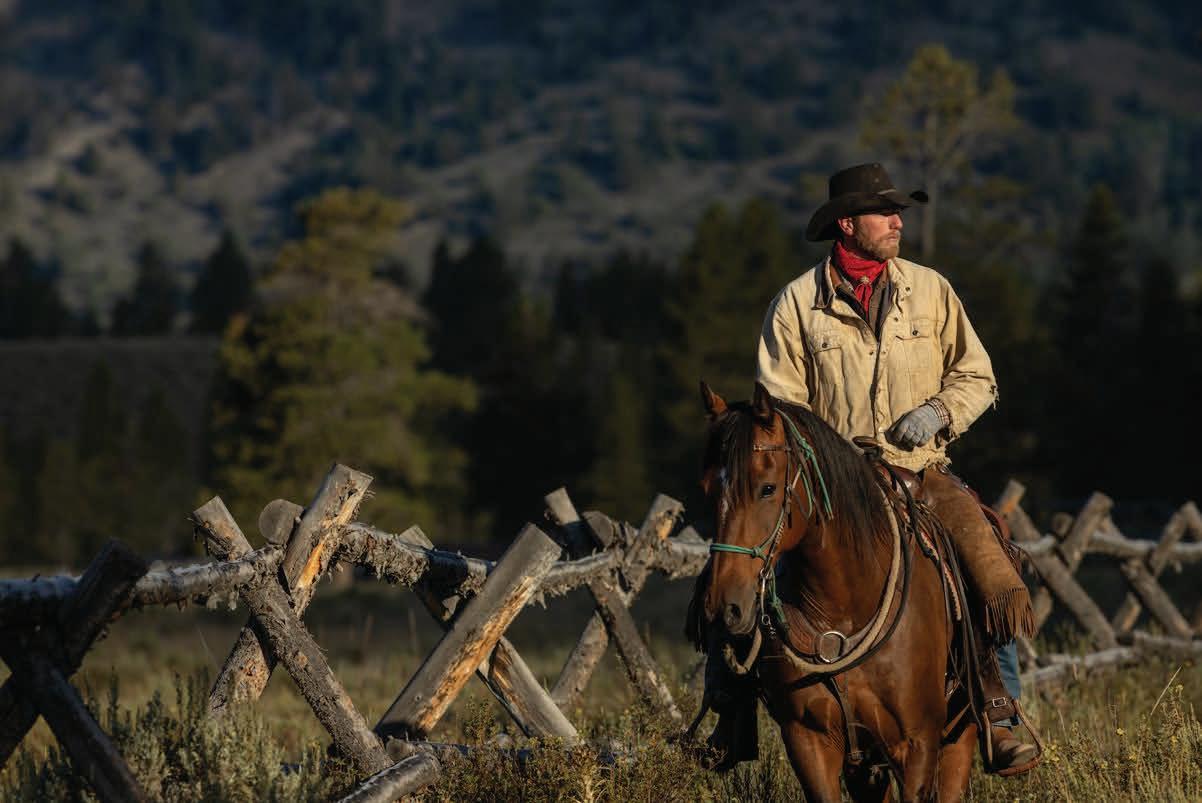
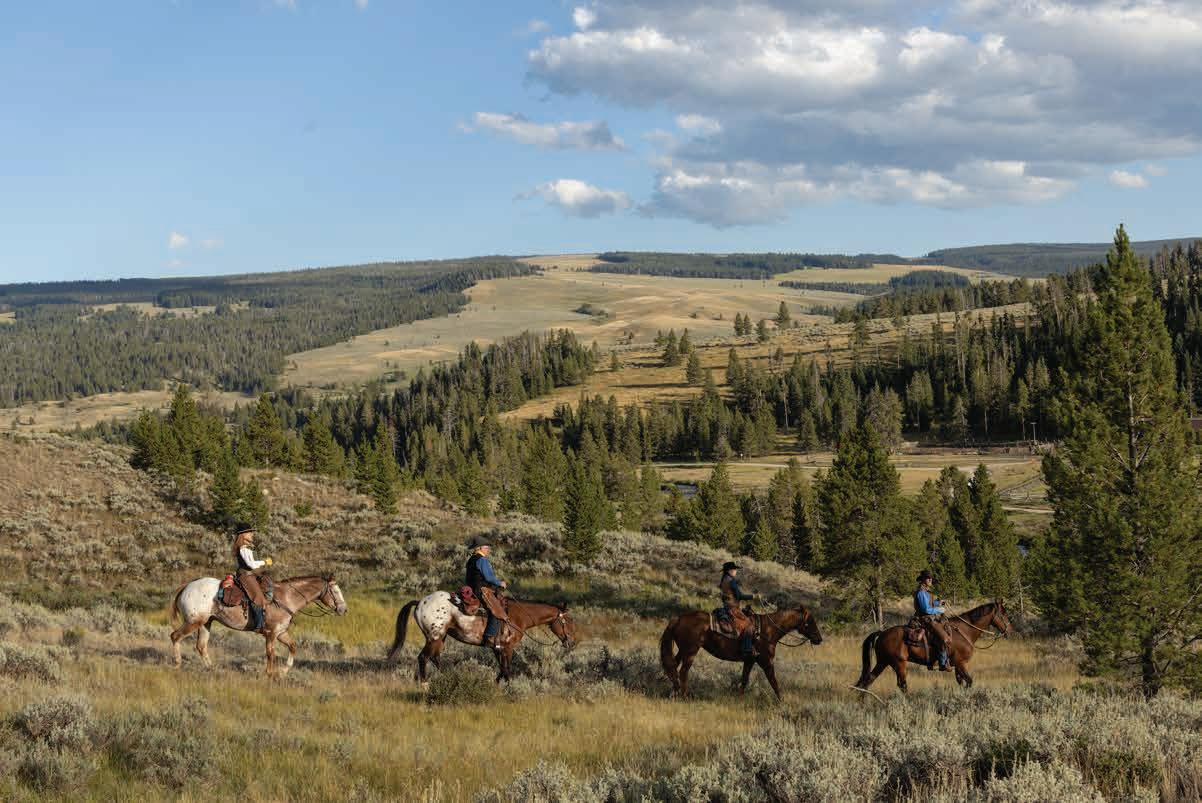
took over running the ranch and raising their children in the Western tradition. In 2019, their son Kameron, along with his wife, Sally, took the reins as the third generation of Kelseys to run the ranch. Although the first names have changed, the same Kelsey customs and Western hospitality endure.
The Kelsey family continues to offer an authentic Western experience to guests from around the world. In the spirit of authenticity, guests stay in the original log cabin structures — and while the exteriors hold true to the ranch’s deep roots, the interiors have been renovated for modern convenience. Dudes still enjoy riding in Montana’s stunning backcountry and fly fishing in blue ribbon trout streams, an activity rising in popularity among guests.
The ranch has a long history in the stories of many families who return year after year, generation after generation. Each returning guest family is honored in the dining hall with a coin signifying their number of years spent at the ranch. In a guest’s own words, the ranch is a place where “time stands still.”
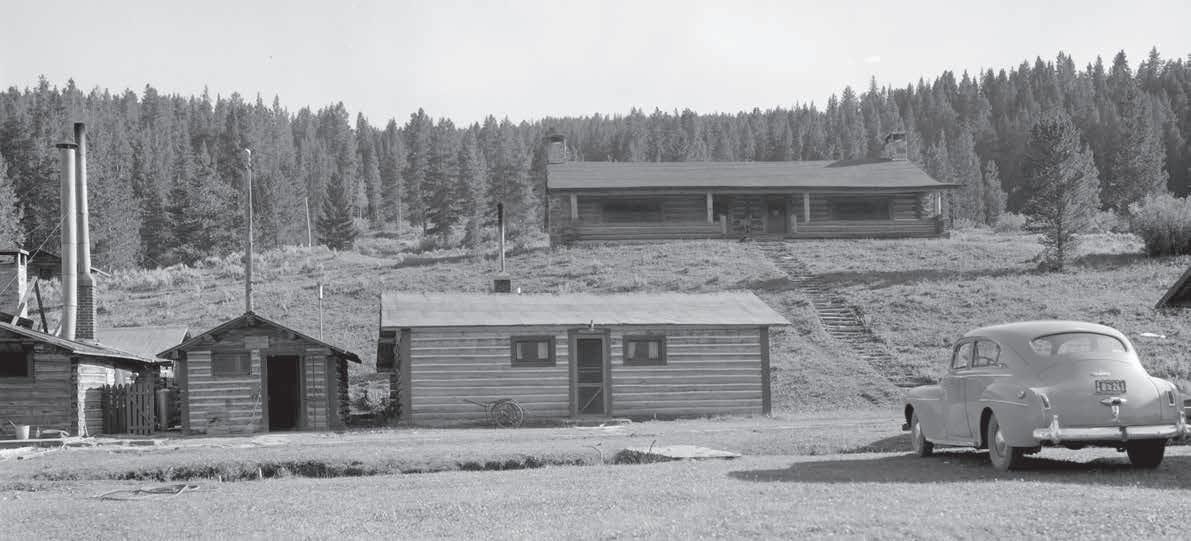
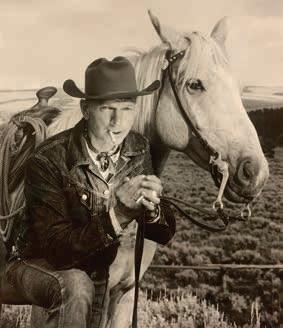
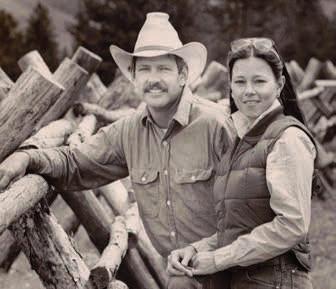

ELKHORN RANCH
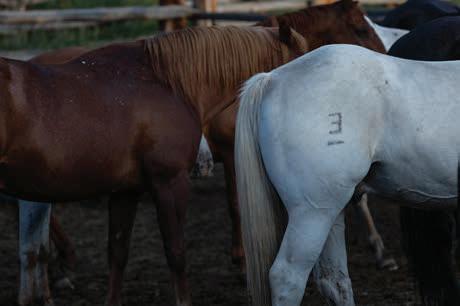
In 1922, a U.S. Army veteran and freight hauler retired his team and wagon to acquire a homestead on Sage Creek in Montana’s Gallatin Canyon, just 1 mile from Yellowstone National Park. The move laid the foundation for the creation of the Elkhorn Ranch.
The Army released Ernest Miller at the end of World War I, during which he established himself as one of the top marksmen in the country. After the war, he became a well-known big game hunter. During the summer, he got a job hauling freight by horse-drawn wagon between the railroad and West Yellowstone, just south of the current Elkhorn Ranch. On one of his freight trips, he met Grace, a minister’s daughter from Massachusetts who worked as an assistant to a professor at Montana State College (later Montana State University) in Bozeman.
As newlyweds in 1922, the Millers acquired the homestead on Sage Creek that would begin to form the Elkhorn Ranch. The couple had a joint love of the outdoors and people, making a dude ranch the perfect fit for them. While living in a tent their first summer, they began sharing their surroundings with guests from all over, instilling in them a love of

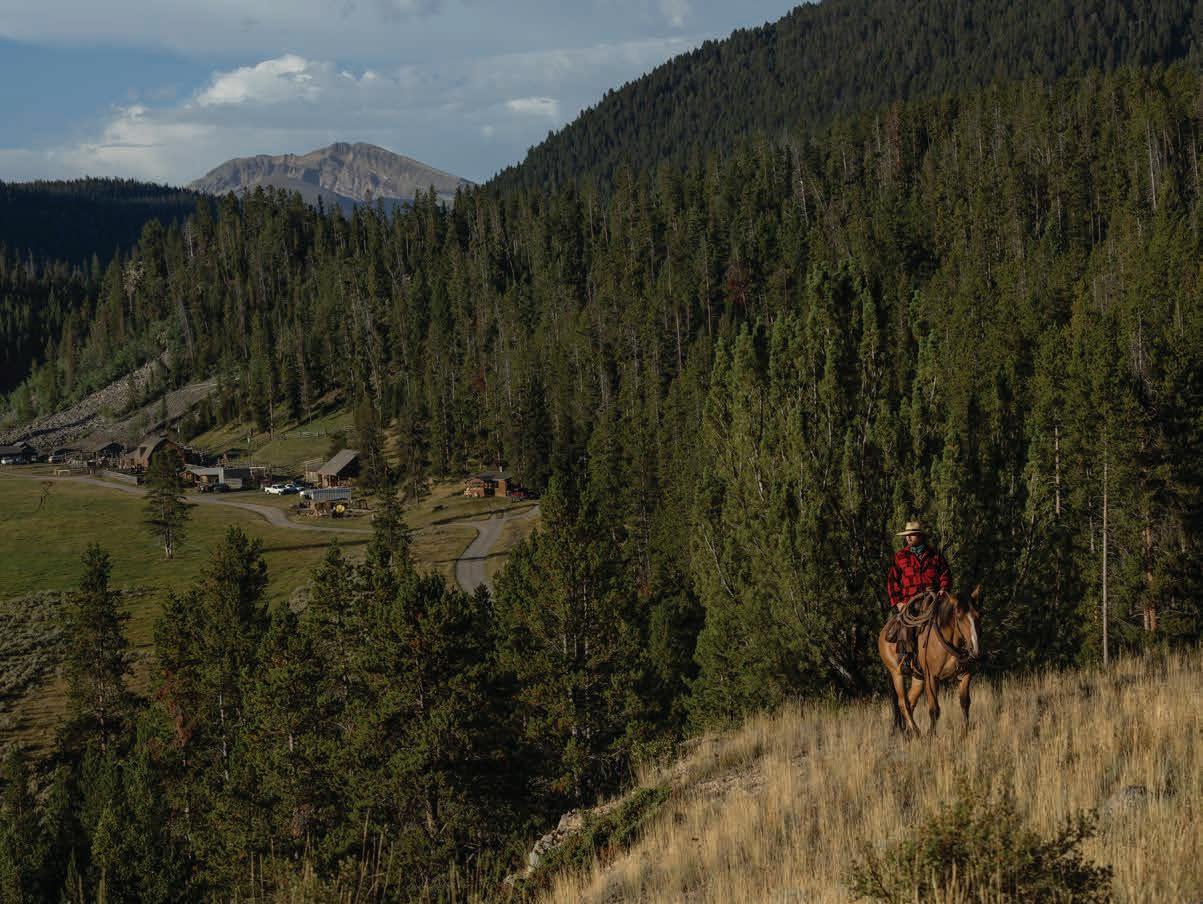
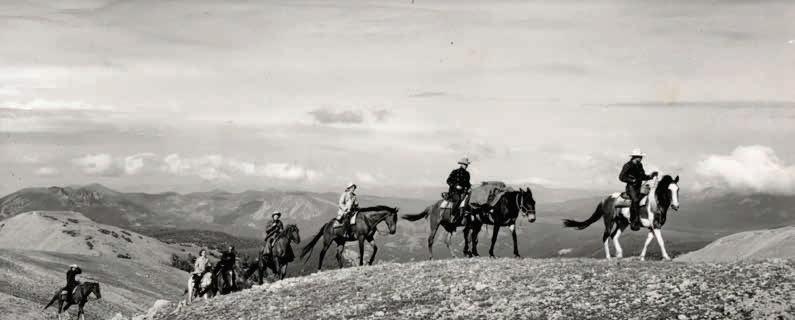
the mountainous area. Over time, pack trips and day trips by car into Yellowstone became big attractions for guests, who were usually more acquainted with closed-in Eastern cities than with Big Sky Country views.
After beginning construction in the 1920s, the Millers built most of the ranch’s log cabins in the 1930s with materials harvested from the homestead, with the needs of a dude ranch operation in mind. Built in a rustic style, they feature timber and stone sourced directly from the ranch. Rustic architecture was meant to enhance the dude experience, aligning with guests’ ideal visions of the West.
In 1926, Ernest served as the founding secretary and treasurer of the newly established Dude Ranchers’ Association, joining other ranches in strengthening the burgeoning industry.
By the 1940s, the Elkhorn Ranch expanded to include two adjoining homesteads: the Cow Camp and the 7-11. During this era, the Millers moved the corrals and barn across Sage Creek to their current location across the meadow from the guest cabins.
Winter roads closed for months at a time, making a milder location in the Madison Valley necessary for wintering family, crew and horses. When that solution fell short, the Millers pursued their dream of running a second ranch in the Southwest. In 1946, they opened a second Elkhorn Ranch in Arizona to provide a dude ranch experience year-round. They concentrated on developing the Arizona Elkhorn until Ernest’s untimely death in 1949.
Montana’s incredible country, coupled with the Millers’ laid-back and inclusive demeanor, drew people back to the ranch year after year. Among returning guests were Minxie and Dwight Minton, both secondgeneration Elkhorn guests. The couple returned to the Elkhorn Ranch annually for nearly 30 years and sent two of their three children to work there. The Mintons decided to purchase the Montana Elkhorn from the
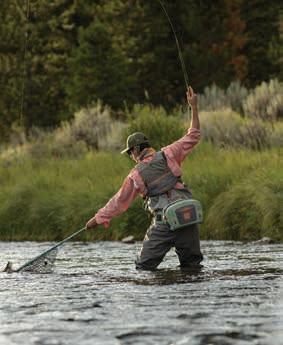
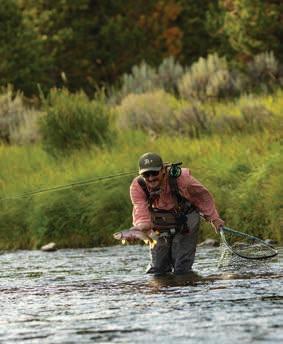
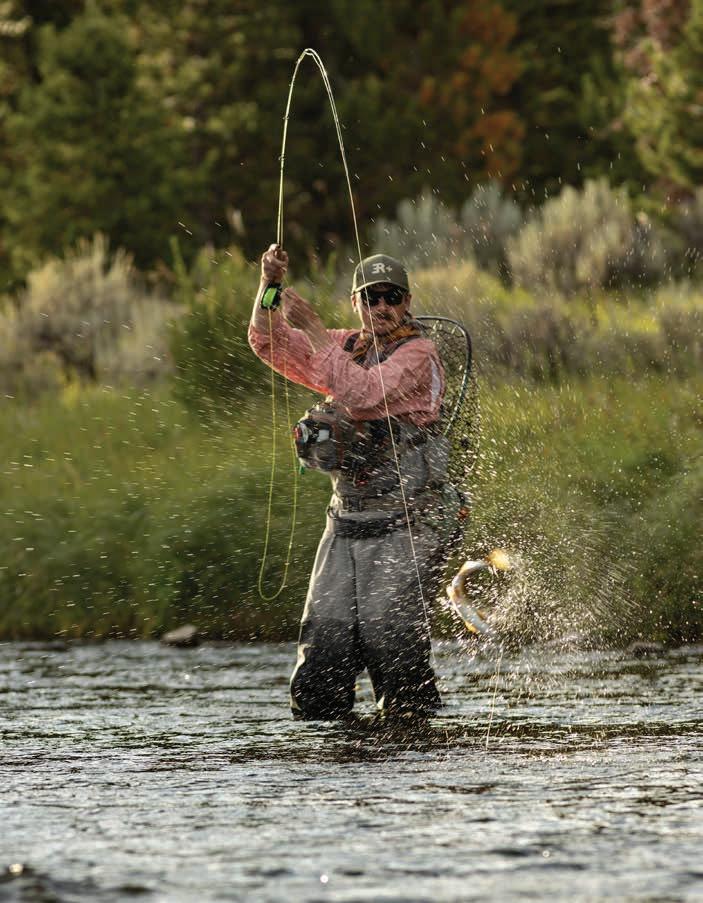
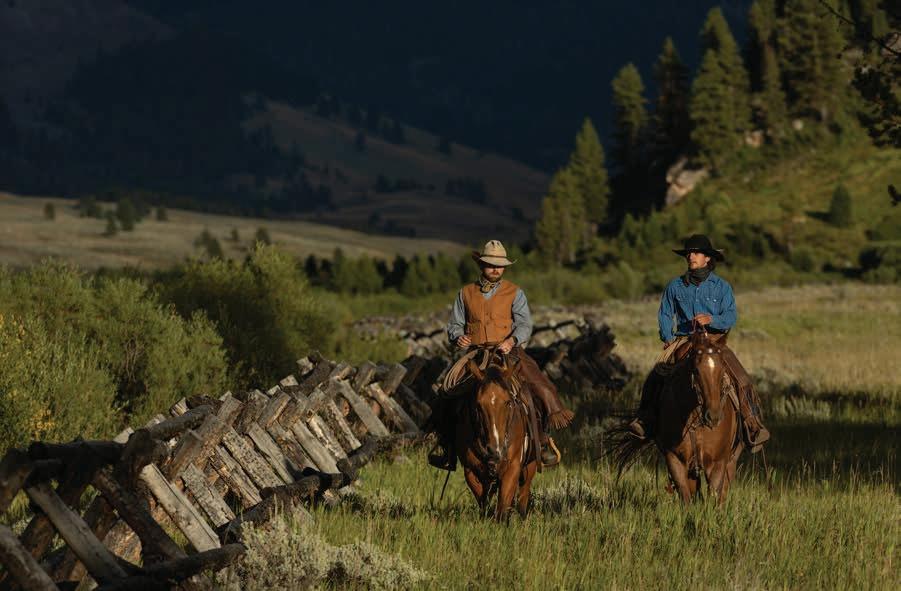
Miller-Hymas family in 1987.
Since then, the Minton family has been dedicated to preserving the style and traditions of the ranch, showcasing its importance for generations of families like their own. Today, the Elkhorn is managed by Spencer and Casey Clark. Grace and Ernest’s granddaughter Linda
Miller, who managed the ranch for more than 30 years, is still at the Elkhorn, enjoying her retirement and running the children’s program.
In 2016, the Elkhorn Ranch was listed on the National Register of Historic Places for its historical contributions to dude ranching and rustic architecture. Its nomination reads,
“The ranch represents a stunning example of an intact, purpose-built dude ranch dating from the height of the dude ranching industry in the western United States. … The ranch has continually operated since 1922 as a dude ranch with almost no changes to its physical plan or operations.”
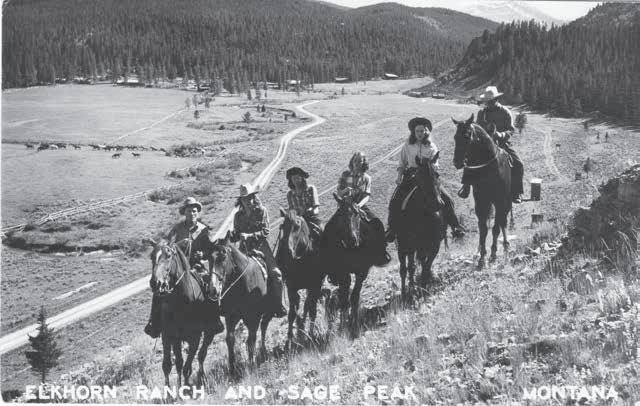
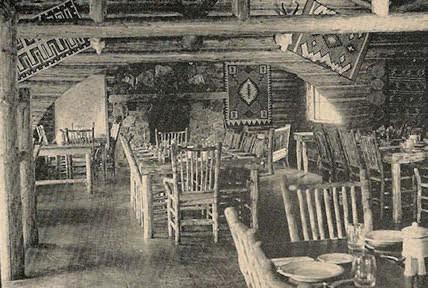
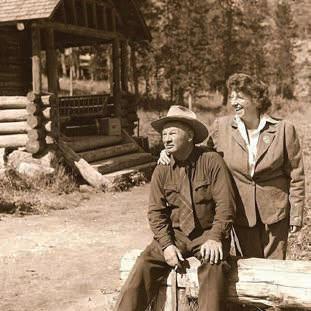
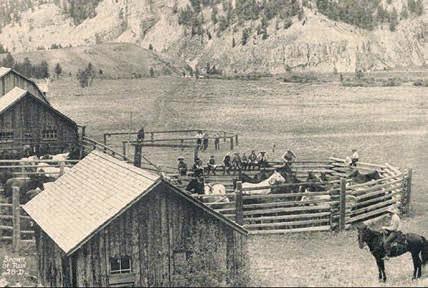
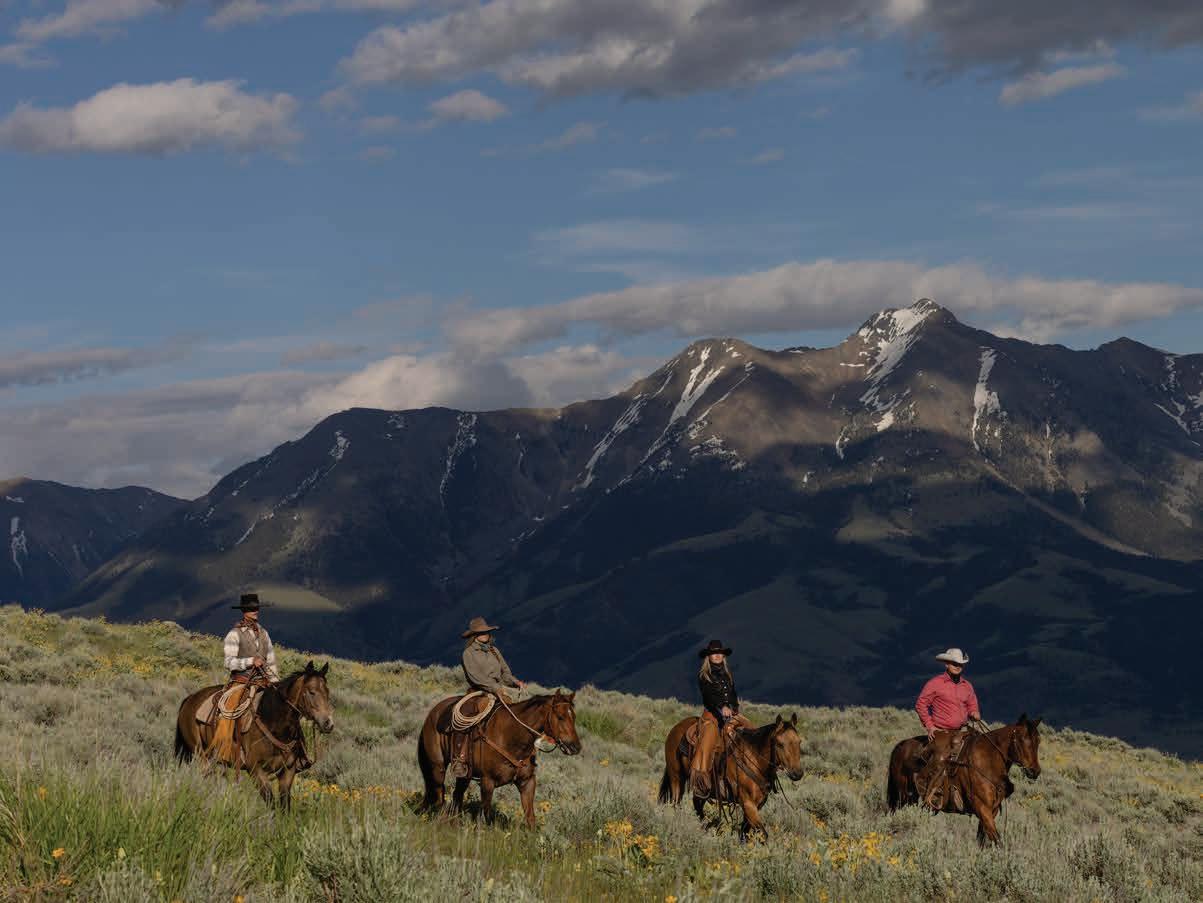

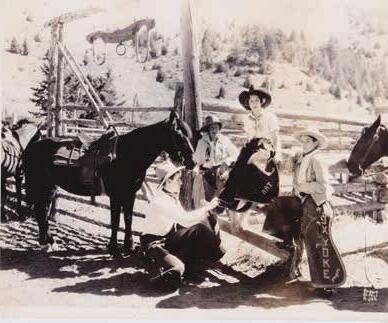
According to local lore, the story of Mountain Sky Guest Ranch begins in 1866, when Montana pioneer Nelson Story drove 1,000 longhorn cattle from Texas to Paradise Valley — a journey that inspired the classic Western novel Lonesome Dove. This 2,100-mile trek marked the first cattle drive into Montana, with the herd wintering on land that would eventually become Mountain Sky.
In 1919, Nelson’s son T.B. Story partnered with ranchers John “Pop” Murphy and his son Charlie to form a sheep operation. Facing economic challenges, they turned to dude ranching and established the Ox Yoke Ranch in 1926 as a guest-oriented operation named for the brand that marked Nelson’s cattle during the historic drive. Starting in 1929, the Ox Yoke was the first dude ranch in the area to offer modern comforts such as bathtubs built into guest quarters and buildings electrified by a small hydroelectric plant powered by Big Creek water.
Charlie Murphy and Malcolm Story, T.B’s son, ran the Ox Yoke until
MOUNTAIN SKY GUEST RANCH
EMIGRANT, MONTANA
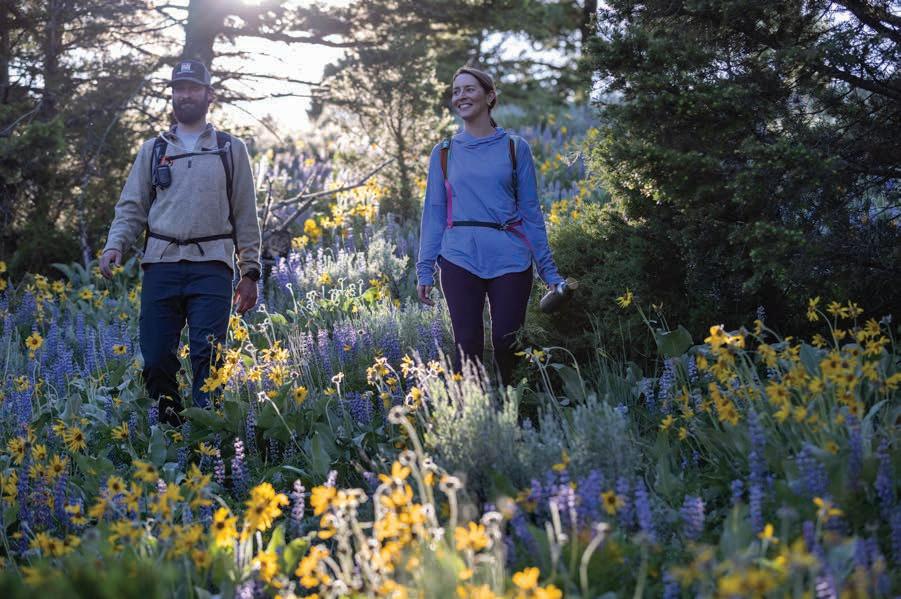
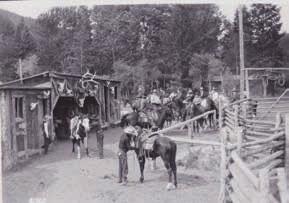
1934, when Charlie and his wife, Peg, took over with the help of a silent partner. After Charlie’s death, Peg kept the ranch running with tenacity and fortitude, managing to stay open during the Great Depression and World War II. Their son Jim and his wife, Gayle, later assumed ownership, keeping the ranch in the Murphy family until 1977 before selling it to outfitter Dennis Fishbaugher.
Fishbaugher renamed the ranch Rising Sun Ranch, a name inspired by the breathtaking sunrises over Emigrant Peak. Although his ownership was brief, he introduced the iconic rising sun brand still used at the ranch today.
In 1979, Minnesota developer Dan Brutger acquired the ranch, renamed it Mountain Sky and began extensive improvements — rebuilding cabins, rerouting roads and expanding the property. In 1986, his son Alan took over management, transforming the ranch into a modern guest ranch experience. Also during this time, renowned horseman Buck Brannaman
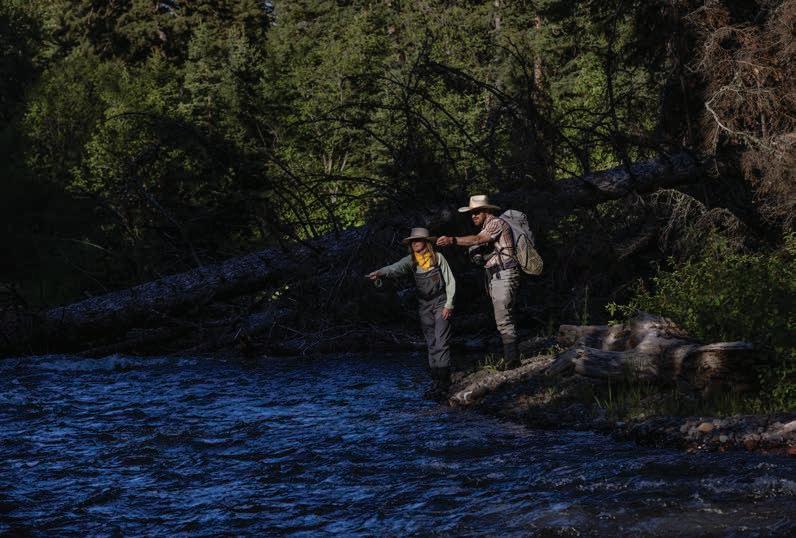
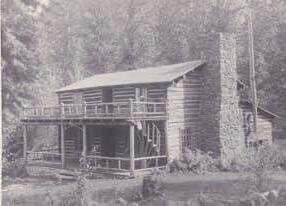
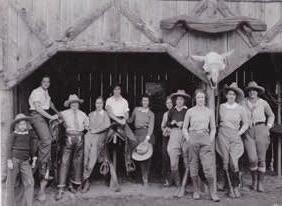
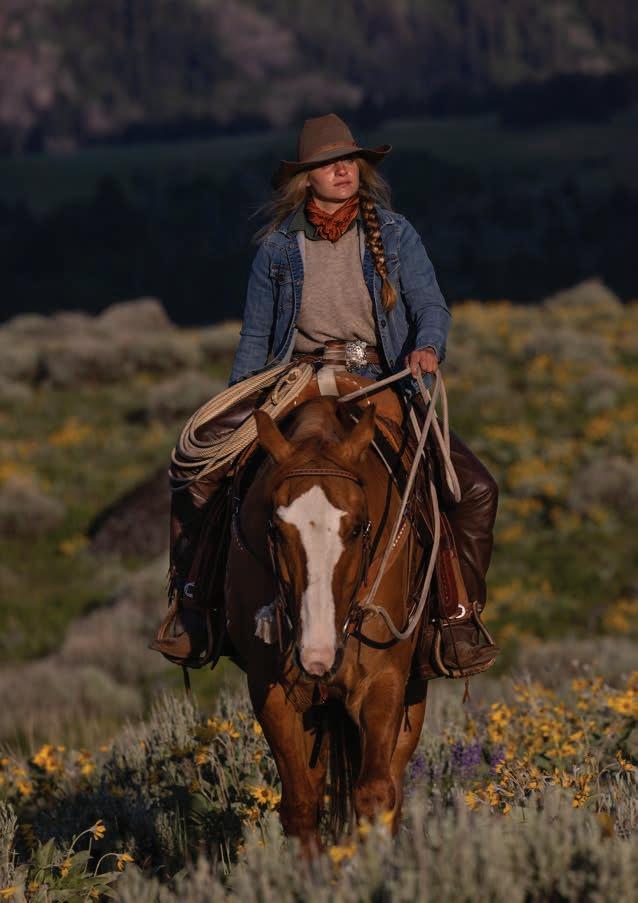
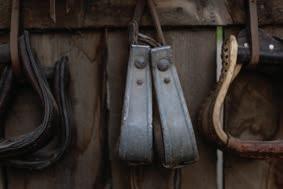
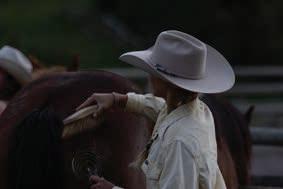
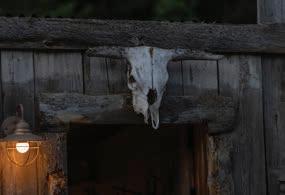
Left Riding through wildflowers in section 17-5 of Mountain Sky. Above, top Three sets of stirrups in the Mountain Sky tack room. Above, middle A Mountain Sky wrangler grooms horses before the day’s rides. Above The historic tack room entrance.
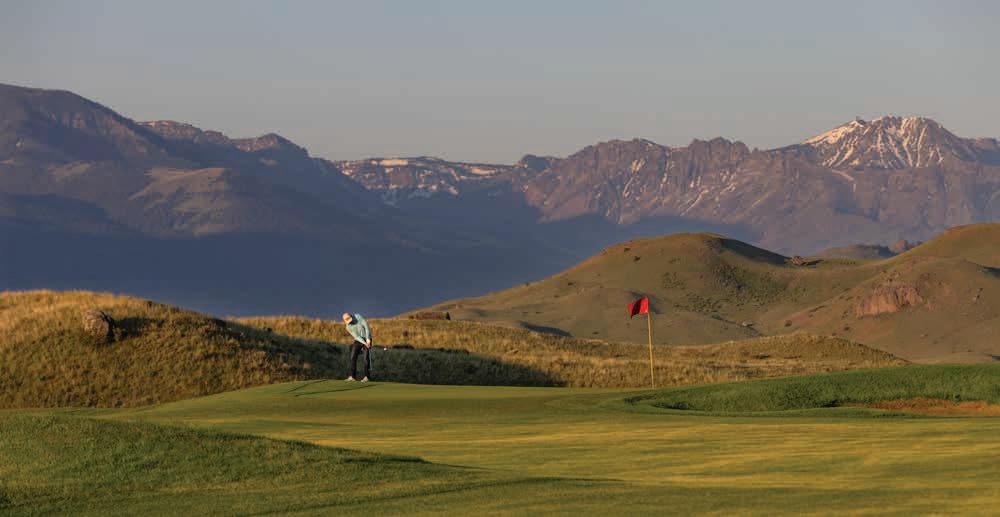
helped shape the ranch’s horse program.
In 2001, businessman and philanthropist Arthur Blank purchased Mountain Sky after having visited as a guest many times with his family. Deeply connected to Montana’s landscape and community, Blank’s vision is to preserve the ranch’s rich history and authentic Western spirit while enhancing its offerings and providing exceptional guest service. Under
Blank’s stewardship, Mountain Sky has grown to include the Johnny Miller-designed, 18-hole Rising Sun Golf Course, along with a worldclass wellness center.
Today, the ranch has become a home away from home for many guests, including some who have returned every summer for more than 30 years, and families who have visited across multiple generations.
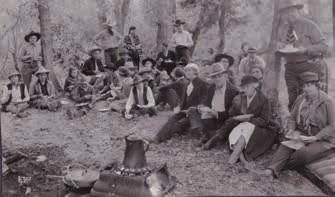
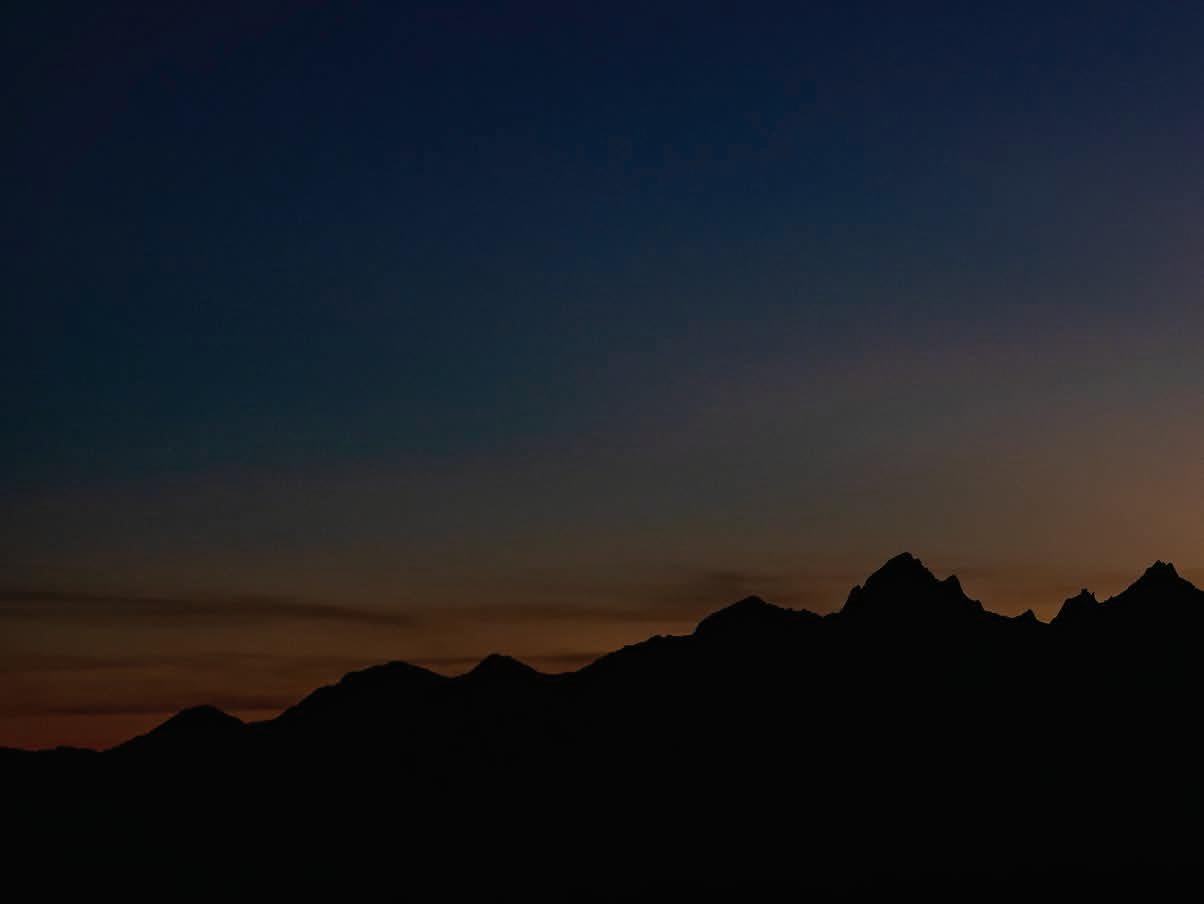
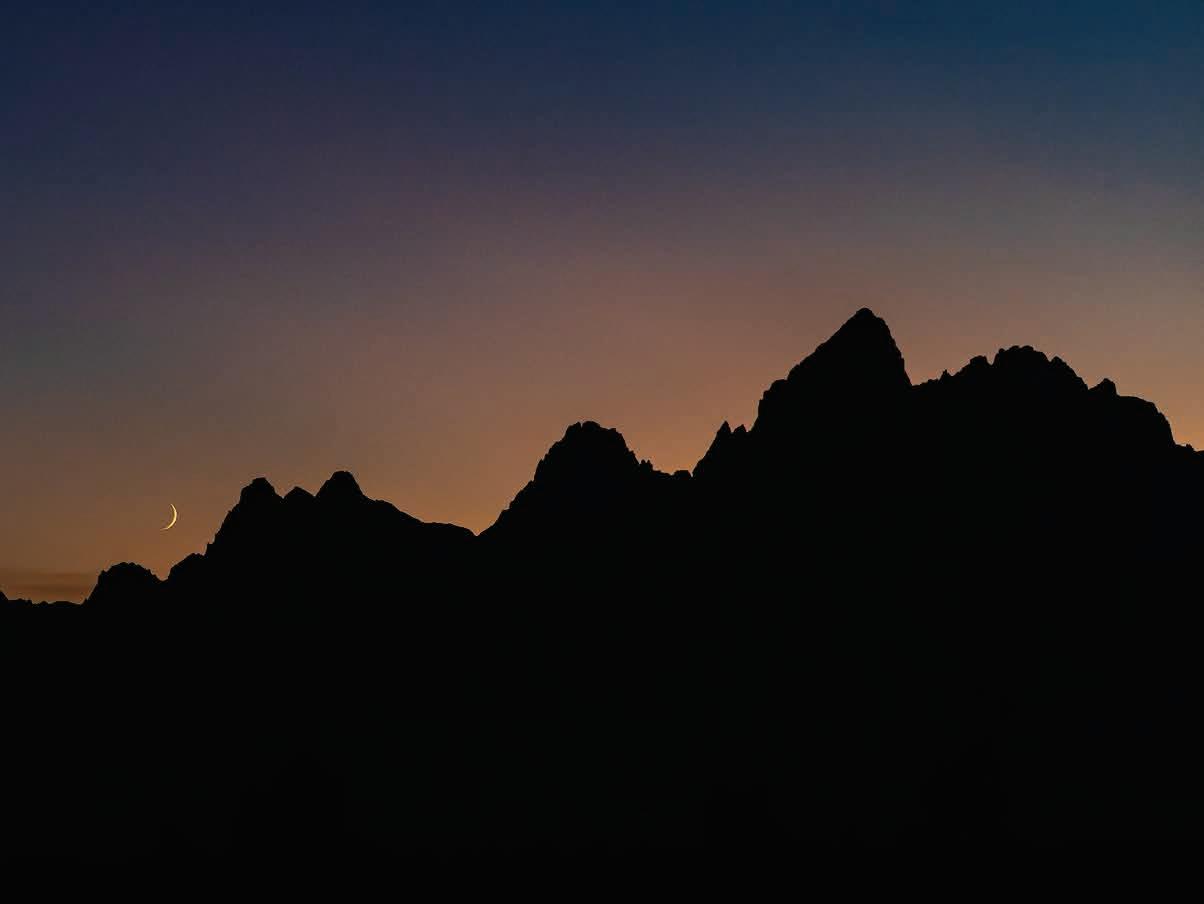
A BAR A RANCH
ENCAMPMENT, WYOMING
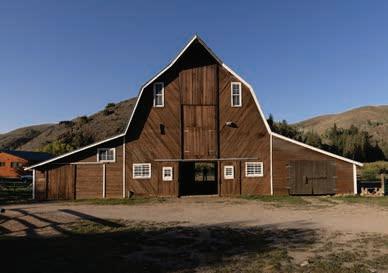
Along the banks of the North Platte River, in the heart of Southern Wyoming’s Medicine Bow Mountains, lies the A Bar A Ranch.
The valley where the ranch sits has attracted people for thousands of years, with Indigenous people living in it long before European settlers arrived. Fur trappers, loggers, miners and ranchers moved into the area during the 1800s, and the valley was described in detail in Cherokee scouts’ journals in the 1850s, as they moved cattle on the Cherokee Trail through what would later become the A Bar A. By the late 1800s, there were many small homesteads and mining claims in the area.
The A Bar A is one of the country’s oldest and largest guest ranches, and it has changed ownership only once since 1921. William Sears filed the first homestead at A Bar A headquarters in the 1880s and by 1921, his and others’ properties had been purchased by Andy Anderson, Edward Hubbell and their families. The team founded the ranch as a cattle ranch, but in 1922, they added a guest operation that has been operating continuously ever since.
Anderson and Hubbell migrated from the East Coast after serving in World War I and graduating from Princeton. They initially called the
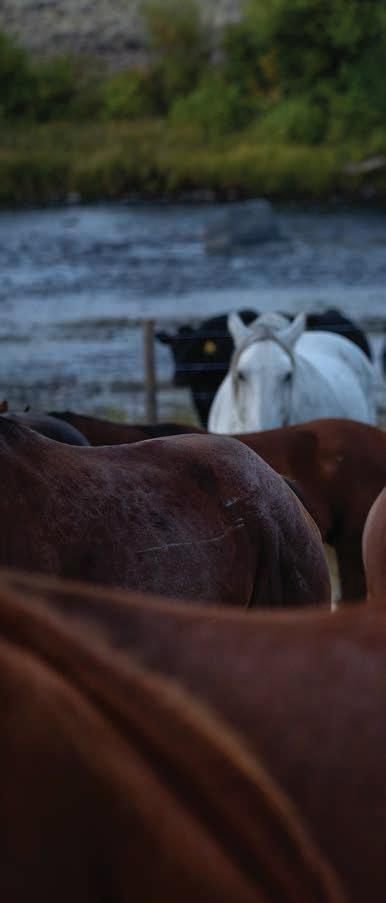
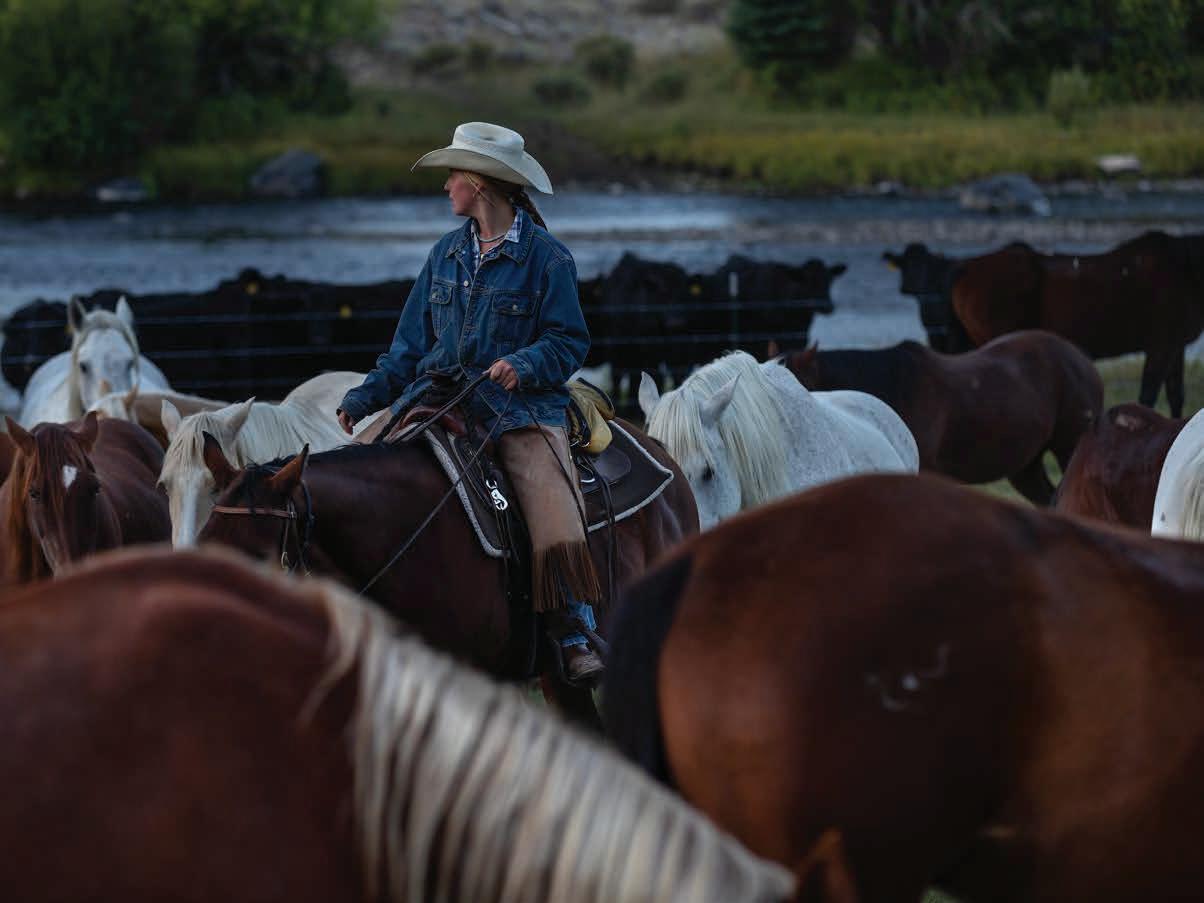
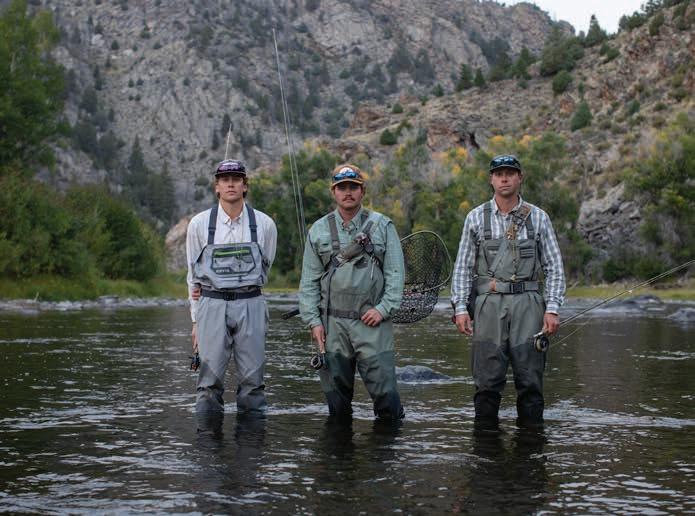
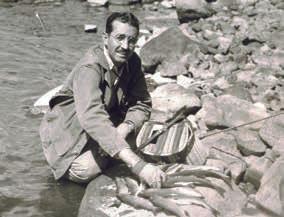
ranch A Bar H (for “Anderson – Hubbell”). By the mid-1920s, with the addition of guest ranching to the business model, they had a long list of annual visitors. More than 100 years later, some of the same families attend each season, with some having visited every year for 50-plus years.
From the 1920s to the ’40s, the ranch added many facilities, including the Round Room, designed by Thomas Molesworth of Cody, Wyoming, and inspired by Native American motifs. Molesworth became one of the most well-known designers of Western furniture, and the ranch maintains a large collection of Molesworth pieces.
By the 1930s, Anderson had purchased Hubbell’s
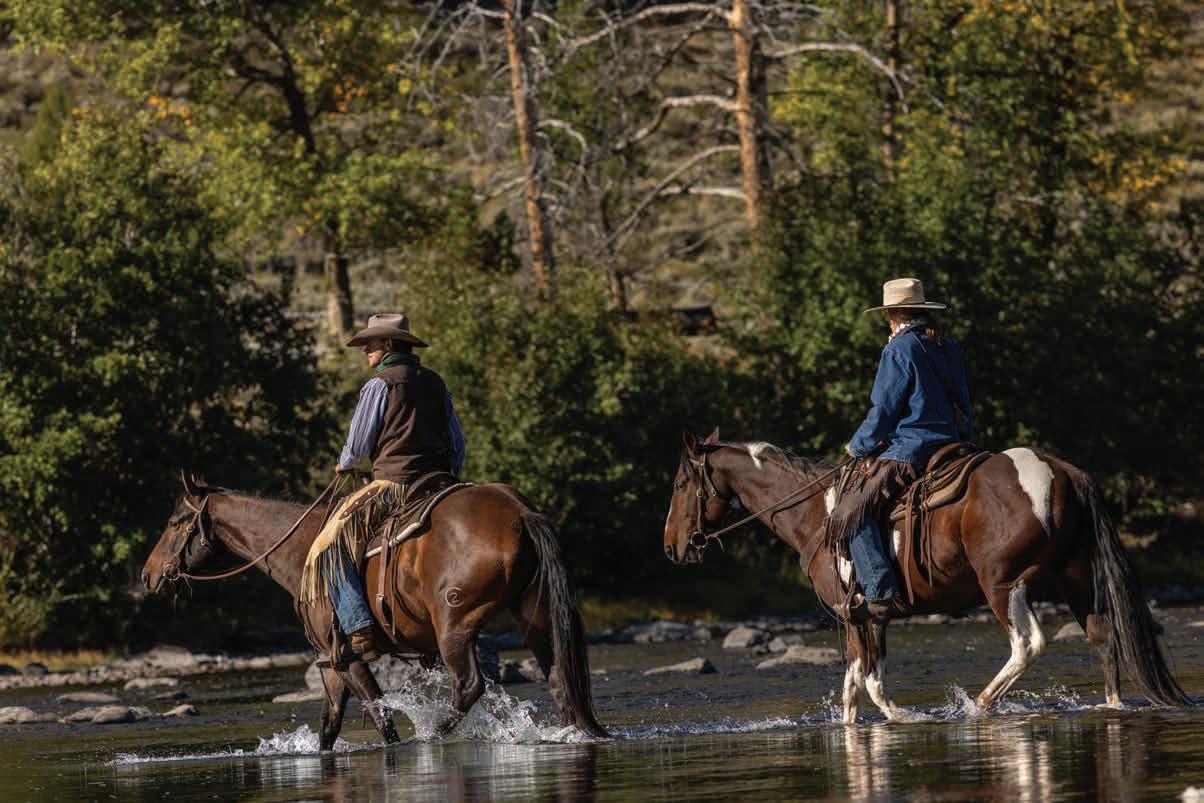
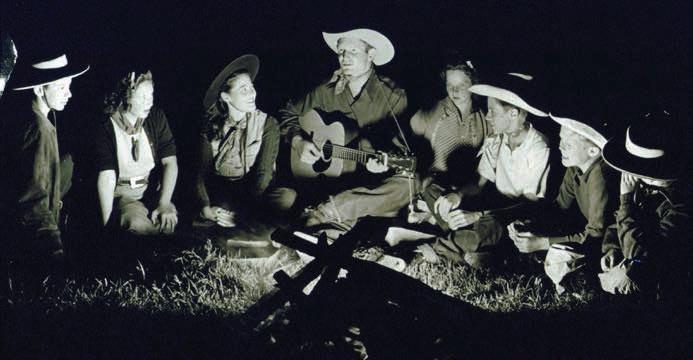
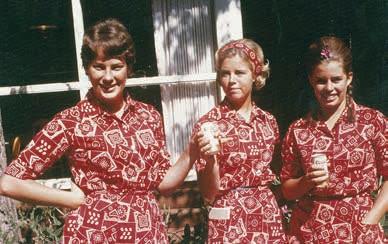
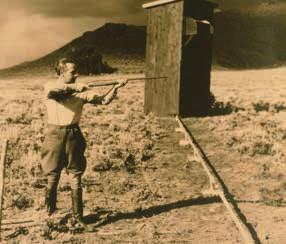
share and the ranch was renamed A Bar A. The next decade, the cattle herd’s breeding changed from Hereford to Black Angus and the A Bar A name was revised to represent Aberdeen Angus. The breeding program at A Bar A influenced the foundation of Black Angus breeding in the U.S., and the ranch continues to raise Black Angus cattle with operations headquartered at its sister ranches, Big Creek and State Line.
In 1962, the A Bar A was purchased by the Denver-based Gates family, which founded the Gates Rubber Co. They added the contiguous ranches Big Creek and State Line to form the Gates Family Ranches and are the current owners.
The A Bar A’s resilience during times of change has included hosting guests throughout the Great Depression and World War II, avoiding multiple nearby wildfires, and weathering large-scale social and cultural changes in the U.S. over the past century. Today’s guests visit from across the country and around the world to ride horses; hike; fly fish; appreciate Western art, history and heritage; and enjoy timeless traditions with family and friends in an authentic setting.
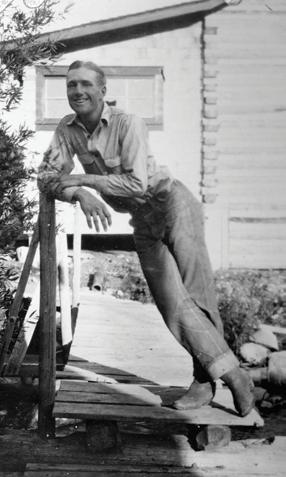
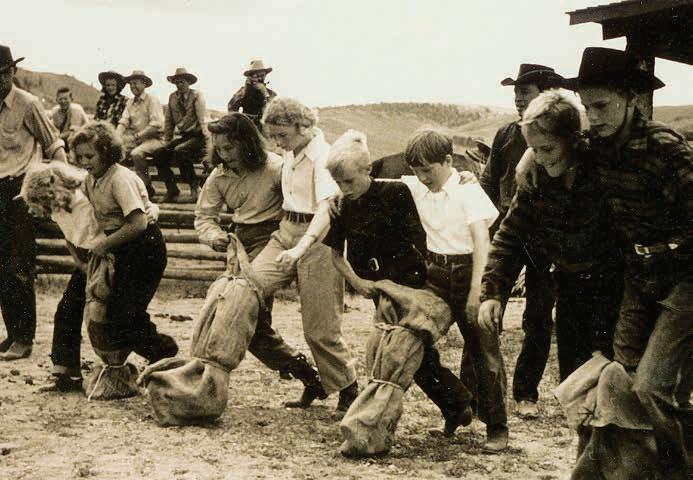

ABSAROKA RANCH
DUBOIS, WYOMING
Founded: Homesteaded, 1911
Founders: Mily and Emil Blaha
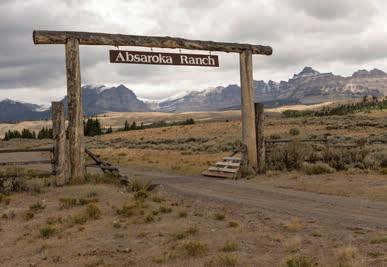
The Absaroka Ranch — located outside Dubois, Wyoming, at the headwaters of the Wind River and in the shadow of the Absaroka Range — has a rich history. The ranch is in the Dunior, a spectacular mountain valley surrounded by the peaks of the Absarokas. Three other mountain ranges — the Wind Rivers, Gros Ventres and Tetons — can be seen from the ranch’s 700 acres, which are surrounded by cattle ranches, national forests and other public lands.
Various Native American tribes used the area as summer hunting grounds, and early explorers and mountain men such as John Colter and Davey Jackson passed through the area. It’s rumored Butch Cassidy ran stolen horses from Cody, Wyoming, through the valley in the early 1900s.
In 1911, Mily and Emil Blaha homesteaded the ranch. They were subsistence farmers and ranchers, raising cows, chickens, goats, pigs and horses. They also grew lettuce and cabbage, not only for themselves but also for the “tie hackers” who were working for the railroad in the upper Wind River Valley in the years between the two world wars. Railroad ties were logged from the valley and cut by hand using a broadax, leading to the term “tie hack.” The ties were then floated down the Wind River to railheads for use in the country’s growing railroad system.
The original homestead cabin, built the summer the Blahas arrived,

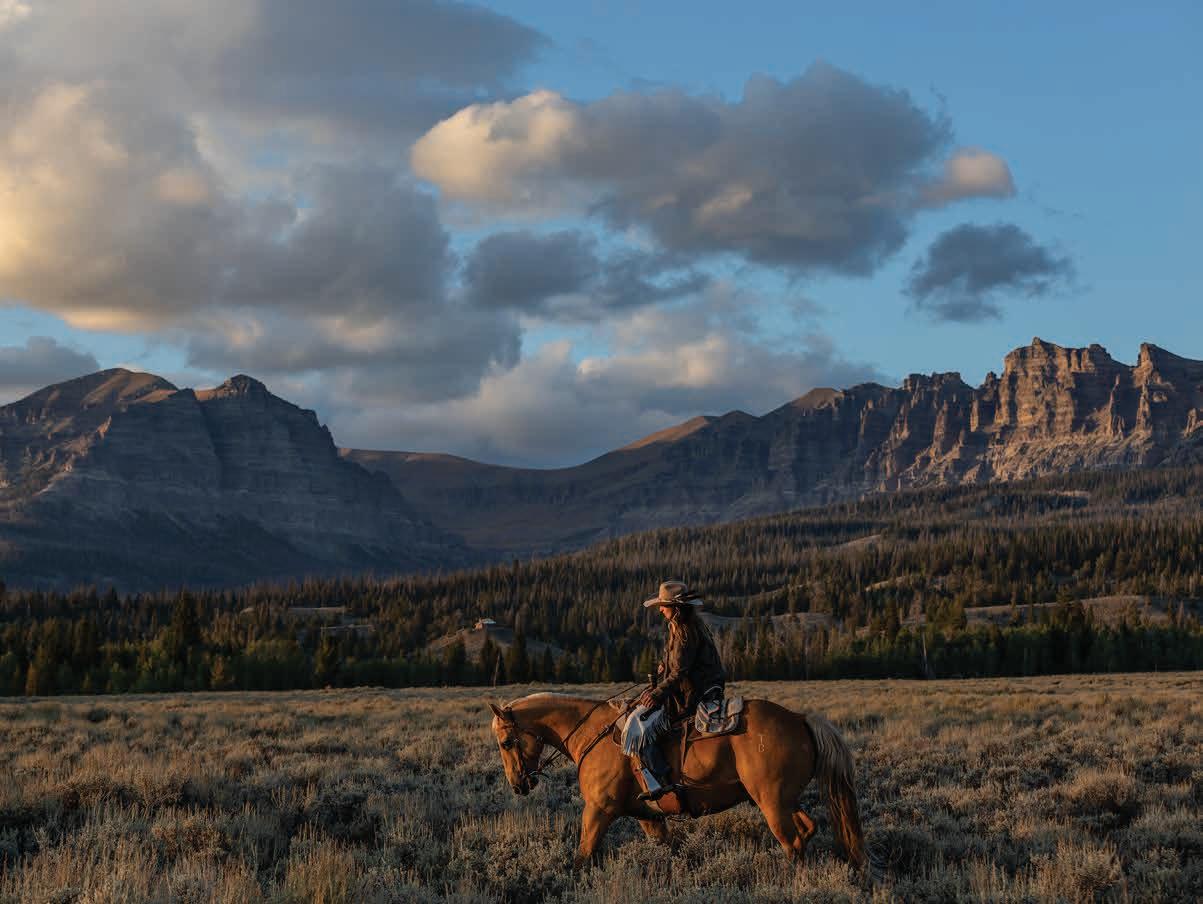
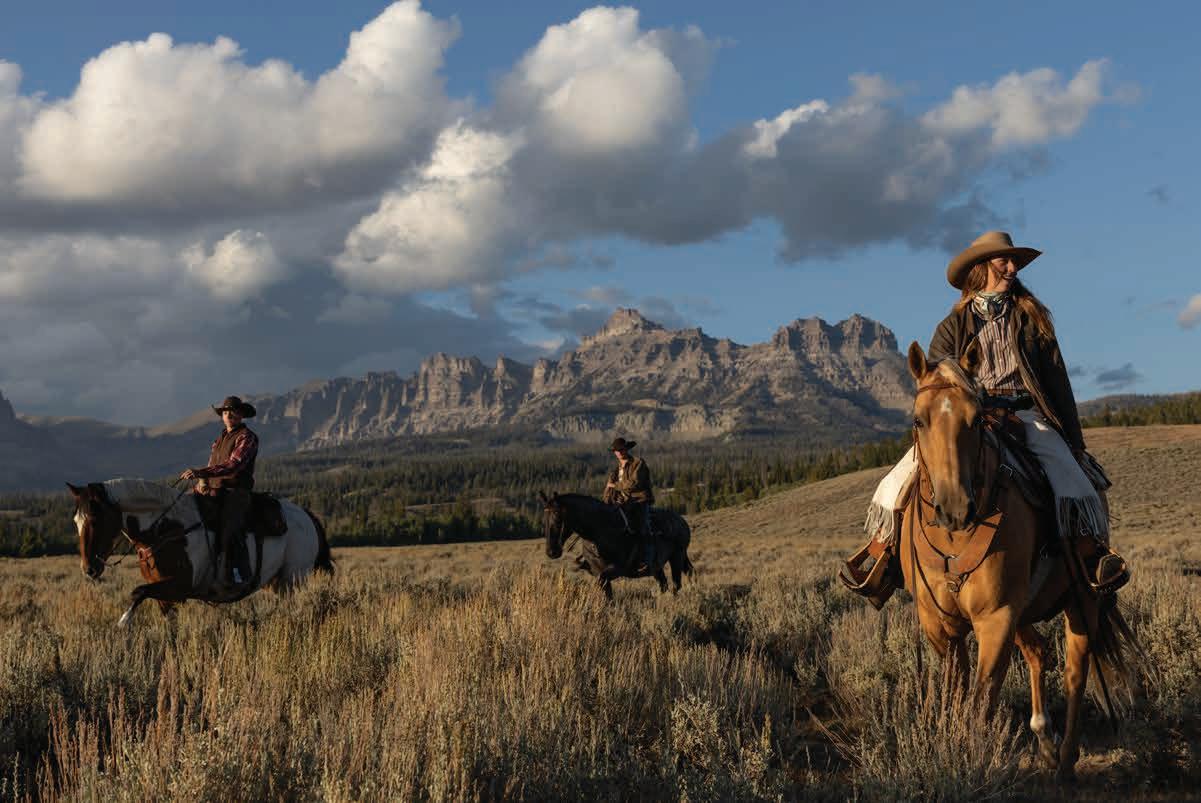
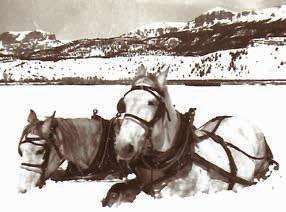
has been restored and is currently used as a guest cabin. In 1916, five years after they homesteaded, the Blahas finished a larger house that now serves as the main lodge for the dude business.
The Blahas operated the ranch until the late 1950s, after which various families owned the ranch until Budd Betts purchased it in early 1983. Budd and his wife, Emi, have been running the ranch ever since; they decided to change the name, from Highland Meadow Ranch to Absaroka Ranch, and open it as a dude ranch and fall hunting base.
Budd and Emi have two children, Robert and Lindsay; Lindsay and her husband, Brooklyn, are managers at the ranch. They continue the rich traditions built over the years while welcoming guests, both new and old, and imparting precious lifelong memories in their Wyoming mountain paradise.
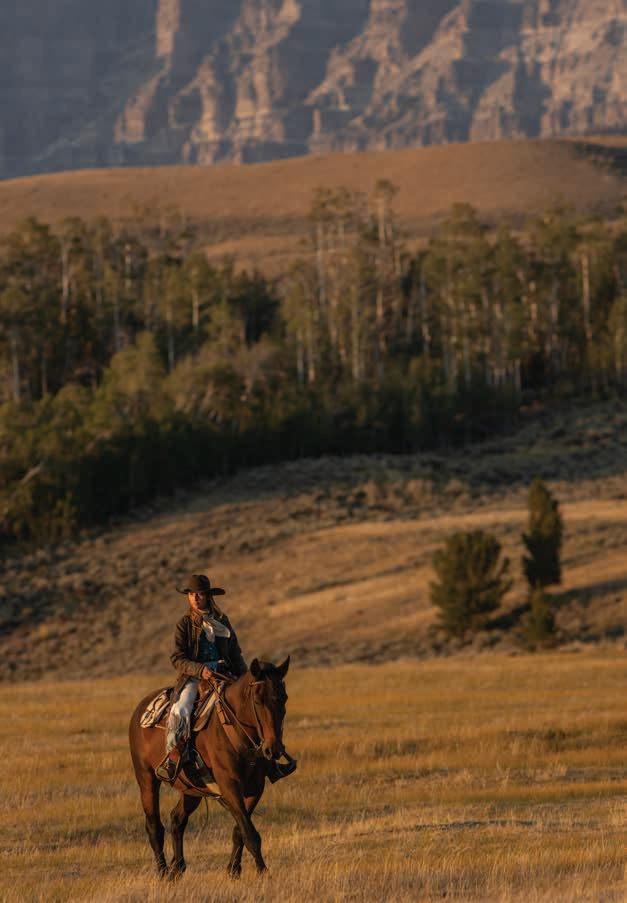
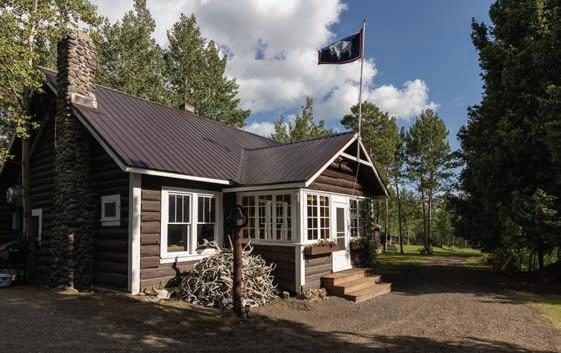
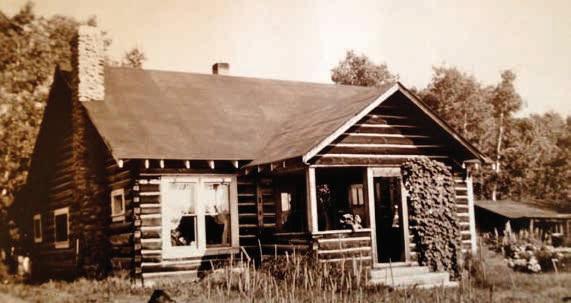
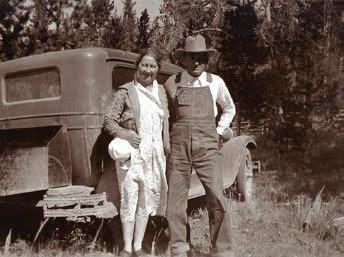
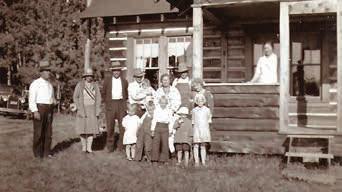
top The ranch’s main lodge, which houses the dining room and kitchen. Left, below In 1916, the Blahas completed this house, which is now used as the main lodge. Top The Blahas were subsistence farmers, raising livestock and growing food for themselves and those working on the railroad nearby. Above The Blaha family stands in front of the main house. They ran the ranch until the late 1950s.
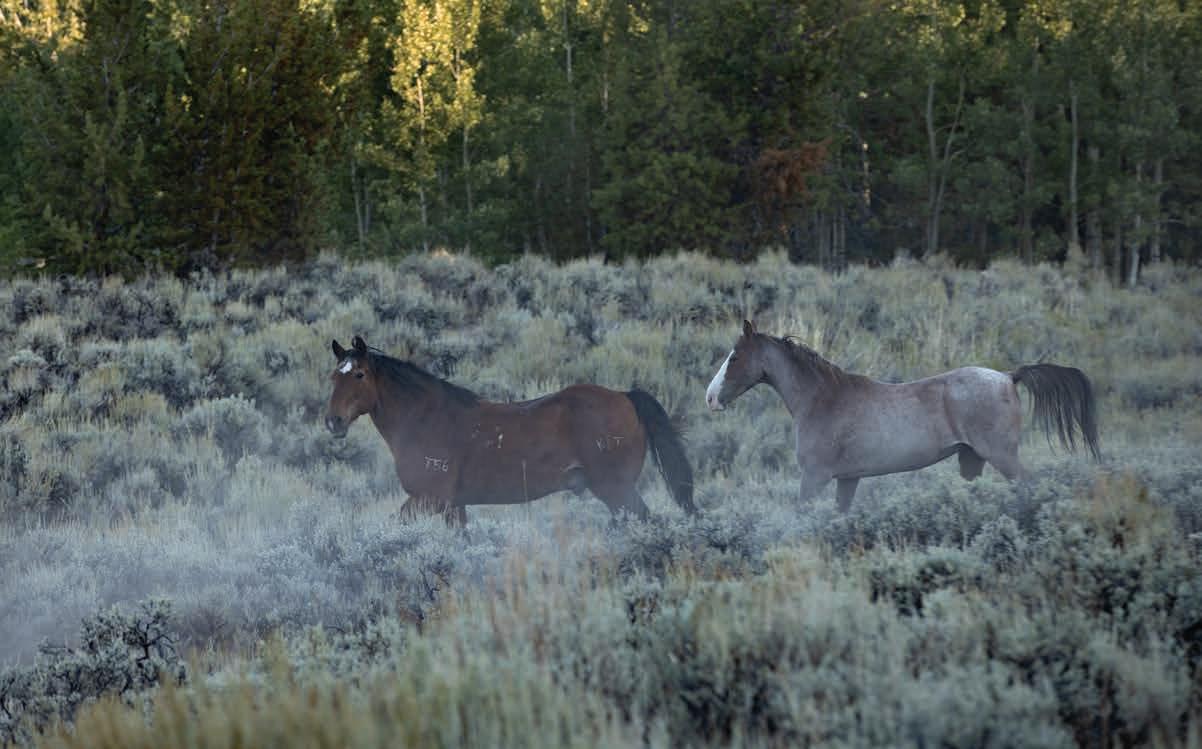
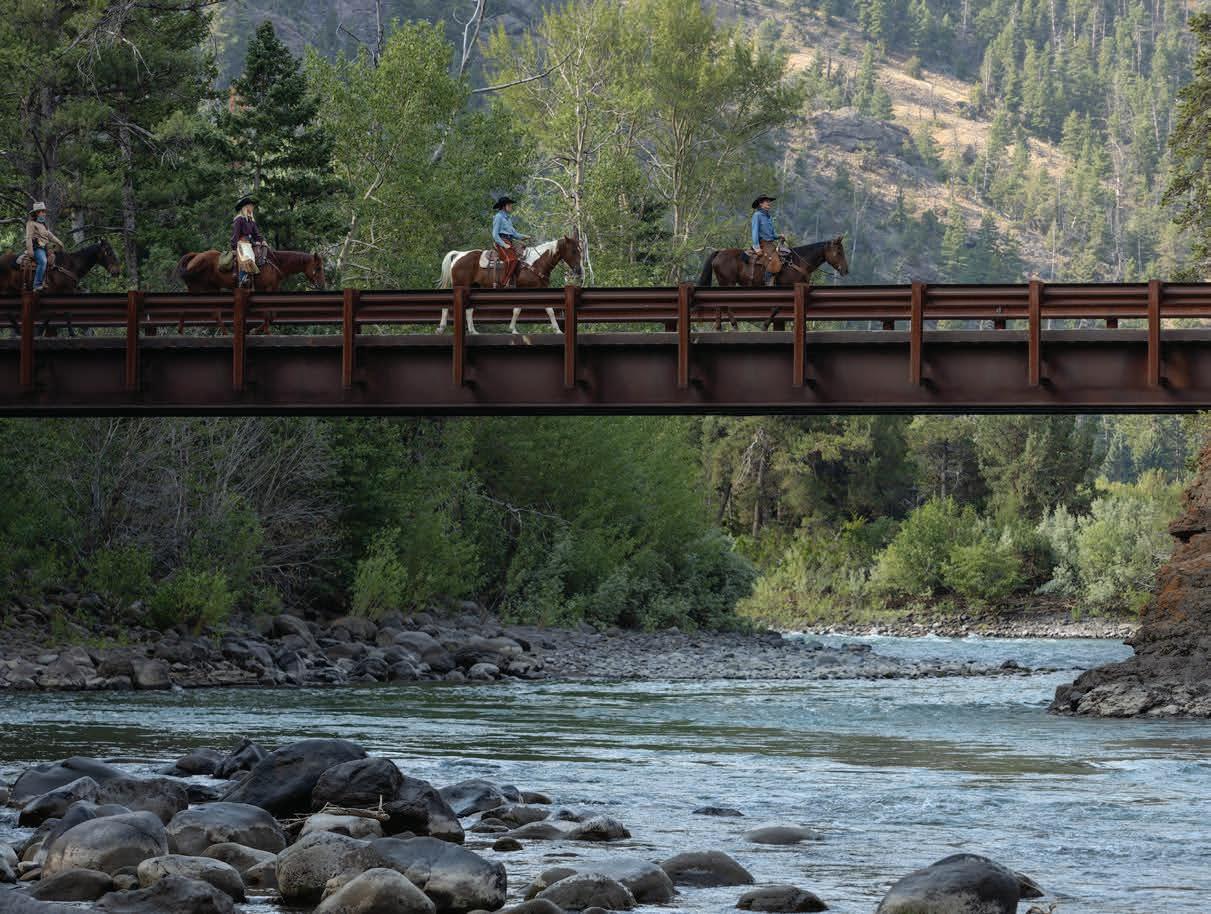

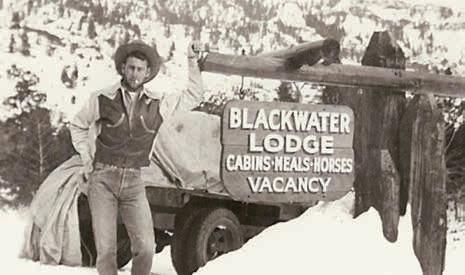
In 1899, the Blackwater Ranger Cabin was built outside Cody, Wyoming, in what now is the Shoshone National Forest—the first national forest, created in 1891 as a part of the Yellowstone Timberland Reserve. The U.S. Forest Service then constructed a wagon bridge at Blackwater in the summer of 1900, but both it and the cabin were destroyed by fire in 1905.
Ten years later, in the summer of 1915, Bronson C. “Bob” Rumsey and George T. Beck received a permit for a tourist resort at Blackwater. First known as Blackwater Camp, it outfitted hunting, camping and fishing parties, with “every man given a horse for his sole use during his stay,” according to a Blackwater Camp advertisement in a 1916 edition of the Yale Daily News. Rumsey was a Yale University graduate and was later elected to the Wyoming Senate in 1935; his father was associated with “Buffalo Bill” Cody, along with Beck, in the founding of the historic town of Cody.
In the ranch’s early years, Rumsey kept some of his Guernsey and Jersey cows, holdovers from when he had run a dairy south of Cody, for fresh milk. Dudes enjoyed trout fishing and hunting, along with pack trips
Left A line of horseback riders cross the bridge at the entrance to Blackwater Creek Lodge & Guest Ranch. The Shoshone River runs around the ranch. Above The entrance to Blackwater Lodge, which was founded as a tourist camp in 1915.
BLACKWATER CREEK RANCH
CODY, WYOMING
Founded: 1915
Founders: Bronson Rumsey and George Beck
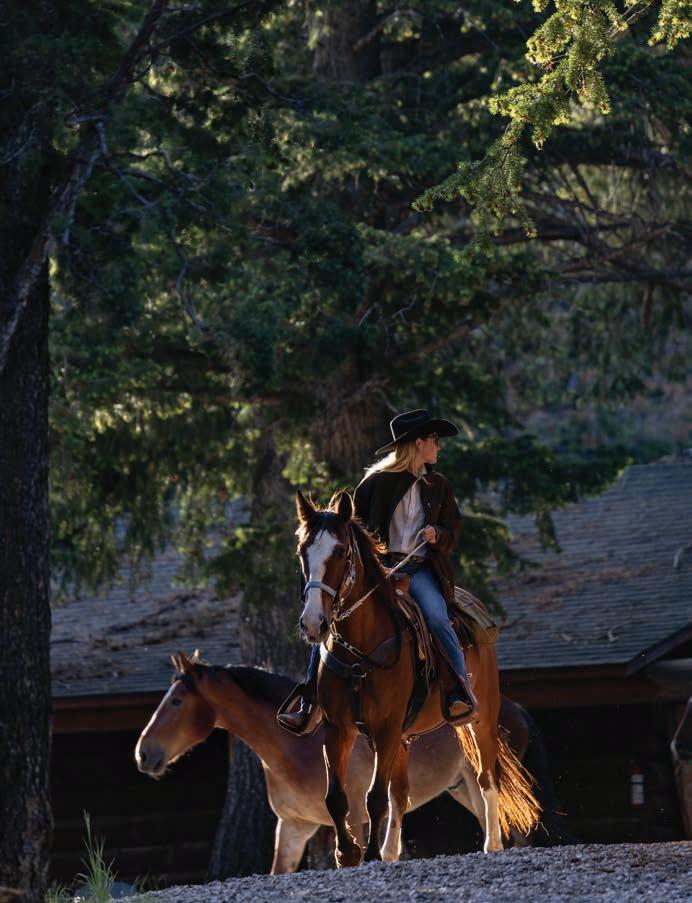
and camping parties outfitted by the ranch.
Rumsey divorced his wife, Anna, in 1927, and she continued to run Blackwater Camp as a dude operation with her daughter, Betty Perkins, with accommodations for up to 40 guests. In 1930, poor health led Anna to sell the ranch to Tex Wisdom, who came to the area as an enlisted soldier at Yellowstone National Park.
In August 1937, the Blackwater Fire—considered the fourth-deadliest forest fire in history—broke out from a lightning strike in the national forest. Fifteen firefighters lost their lives in the fire, which quickly spread into the dense forest as a result of changing winds. The fire consumed 1,700 acres and injured another 38 firefighters, most of whom were Civilian Conservation Corps employees led by Forest Service fire managers.
Near the ranch, along the Cody-Yellowstone Highway at the mouth of Blackwater Creek, is a large stone-cut monument constructed by the Forest Service and CCC to memorialize the men who died in the Blackwater Fire. There are also CCC-constructed memorials at the two sites where firefighters lost their lives in the national forest; these are accessible via horseback ride or hike from the ranch.
The ranch’s historic cabins were constructed between 1915 and the 1950s. From the 1930s through the ’50s, the ranch operated as Blackwater Lodge, offering lodging and dining, guided hunting and fishing, pack trips, and a horse for the duration of each guest’s visit, much like the early days.
Today, the dude ranching tradition continues as Blackwater Creek Lodge & Guest Ranch hosts guests from all over the world to experience its corner of Yellowstone Country and the Shoshone National Forest. After its purchase by Ranch Preservation in 2024, the ranch became part of the True Ranch Collection, a selection of historic dude ranches across the West.
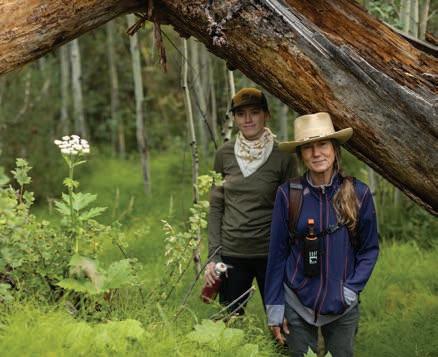
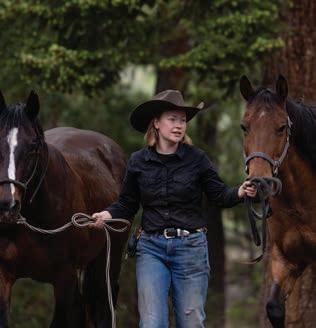
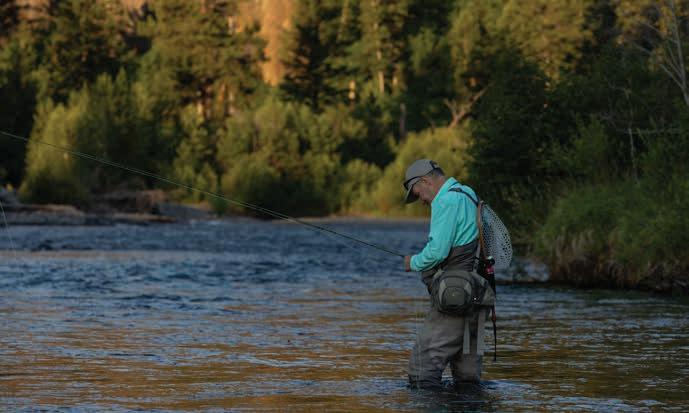
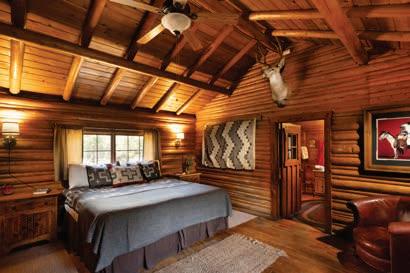
between 1915 and 1950.
Leading the horses in from their pasture to the corral to be saddled during the daily wrangle.
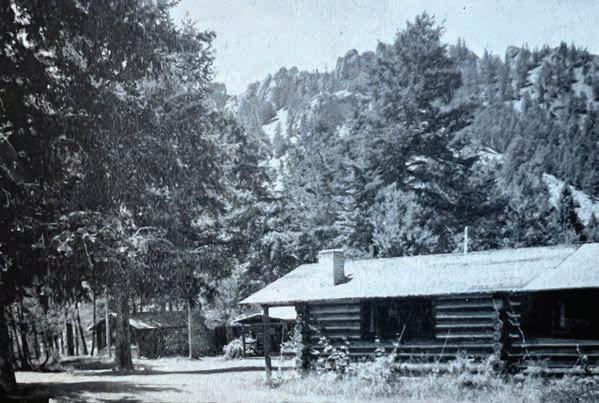
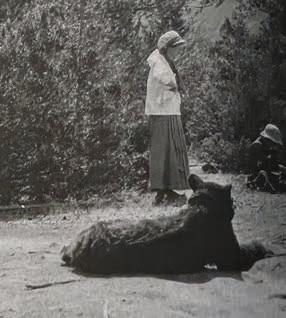
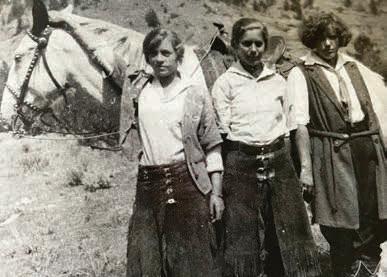
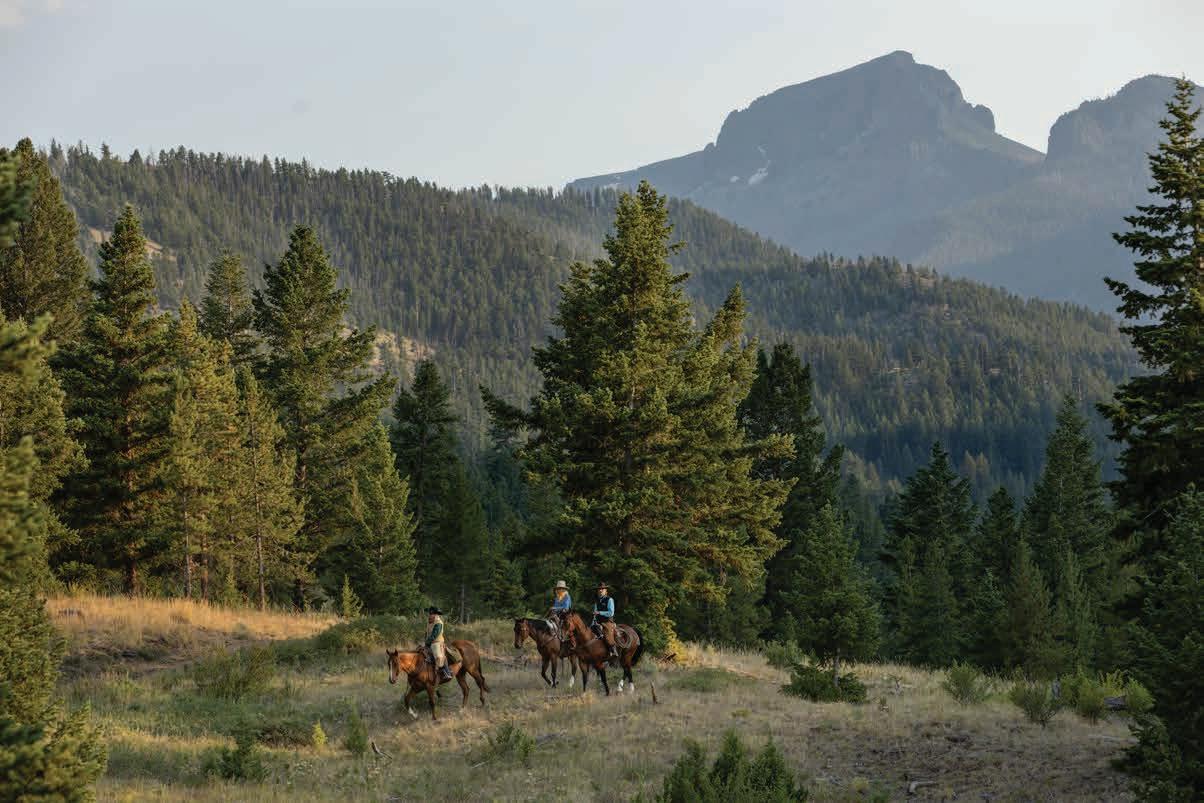
CM RANCH
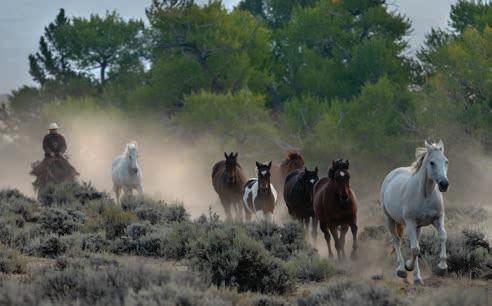
Charles Cornell Moore, the founder of the CM Ranch, was the son of a trader and grew up in Wyoming, on the Wind River Indian Reservation. When he was a young man, he ventured east for law school in Michigan. He hated it, and years later, when he returned to his beloved home state, he had a new vision: to open a camp that would introduce the city slickers of the East to the splendor of the wilderness. Thus, he built his first operation, Yellowstone Camp for Boys, at the mouth of the Dunoir River in Western Wyoming.
In search of guests, Moore traveled to the East Coast to wine and dine high society. In the process, he persuaded families to send their young boys to Wyoming so they could bear witness to the splendors of the West. He organized and led pack trips through Yellowstone National Park for these affluent teenage boys, all inexperienced outdoorsmen. The boys returned home so changed by and appreciative of their time in Yellowstone that entire families soon wanted their own introductions to the park.
In 1926, the corrals and facilities on the Dunoir burned to the
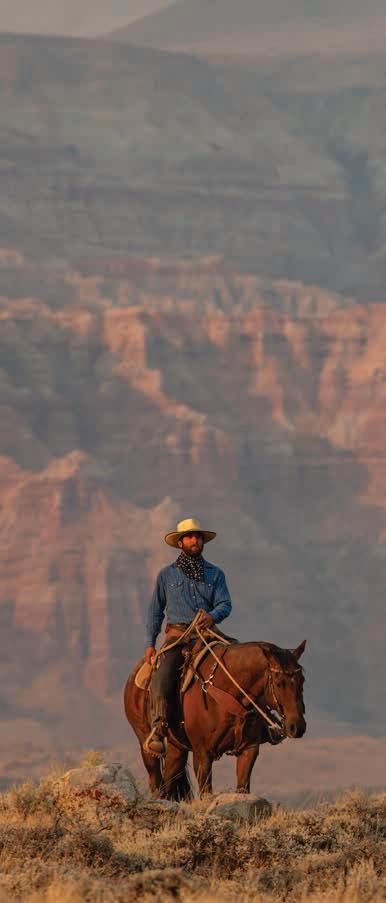
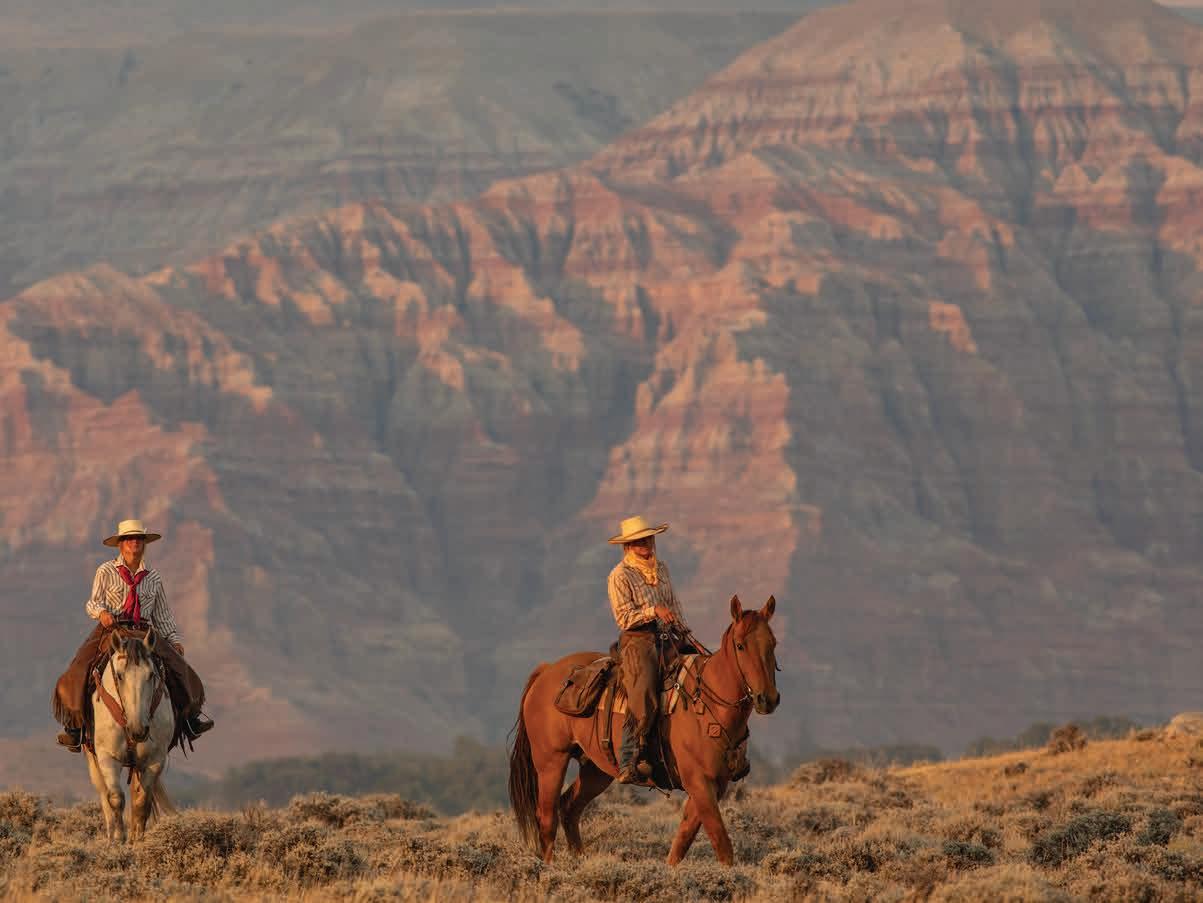
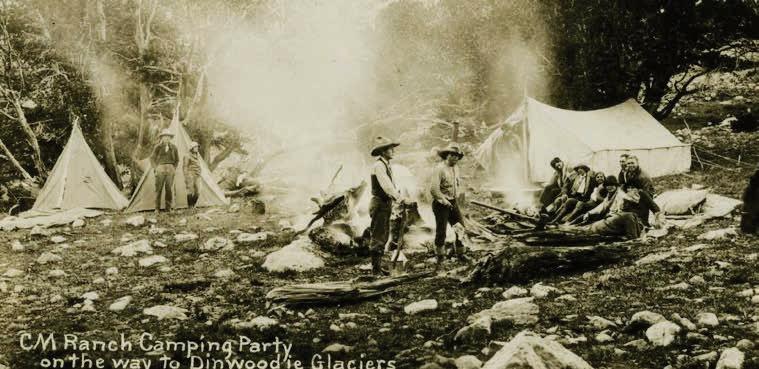
ground. But the dude business was such a passion for Moore he abandoned the pack trips for boys and started the CM Ranch, built to accommodate parents and family members wishing to join their children on the fringe of the natural environment.
Moore and his wife, Marion, sold the ranch to Les and Alice Shoemaker in 1952. The Shoemakers managed the ranch until the mid-1980s, when it was taken over by the next generation: their daughter Barbara, along with Pete and Lisa Peterson. Barbara still lives in nearby Dubois and conducts weekly CM history talks during the summer.
In 1997, the ranch was sold to its current owners: siblings Jay and Connie Kemmerer, and Betty Gray. The Kemmerers had grown up vacationing at the CM as children with their geologist father and were eager to make an investment in Wyoming and preserve the ranch’s rich history. Their first managers were Kass and
Mike Harrell; Kass had worked at the CM for many years as a camp cook in the 1970s. Since 2011, the CM has been managed by Hunter and Mollie Sullivan.
A weekly guest’s stay at the CM Ranch includes many long-standing traditions, including the breakfast ride, the all-day ride, cookouts, team penning, square dancing and musical entertainment. Guests also can try fly fishing, hiking or an overnight pack trip. The ranch is well integrated into the Dubois community, with guests visiting the town rodeo every Friday and the ranch’s famous firetruck playing a starring role in the annual Fourth of July parade.
The CM continues to function in much the same way it did in the beginning, besides a few building additions and improvements. The ranch was added to the National Register of Historic Places in 1992, and its original character, charm and spirit have been well preserved and are true representations of life out West.

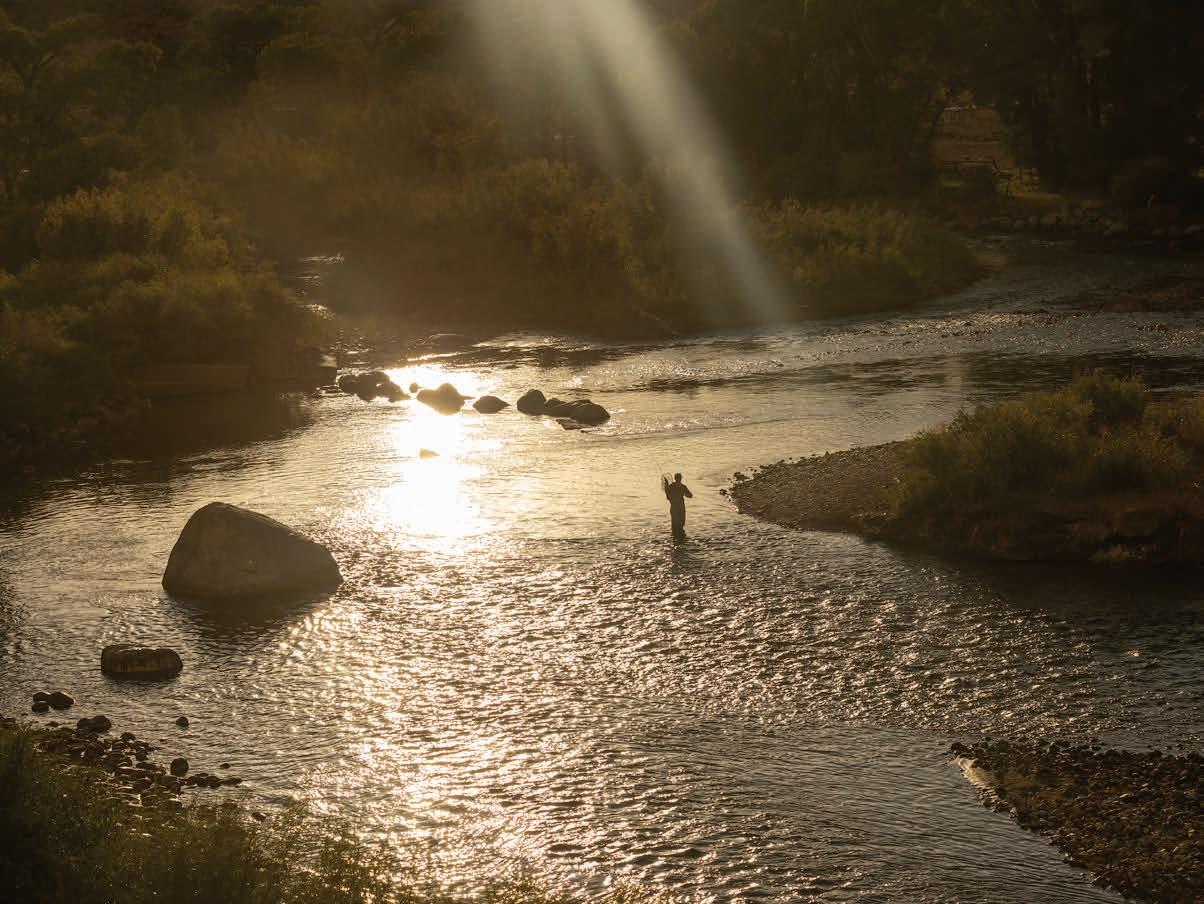
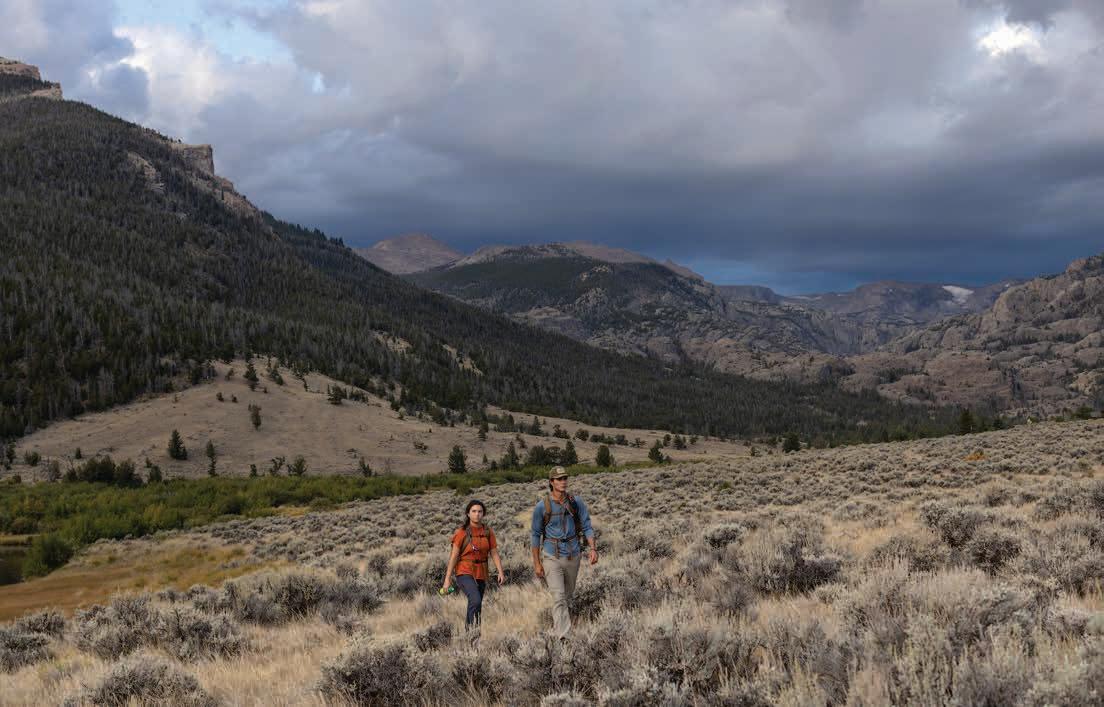
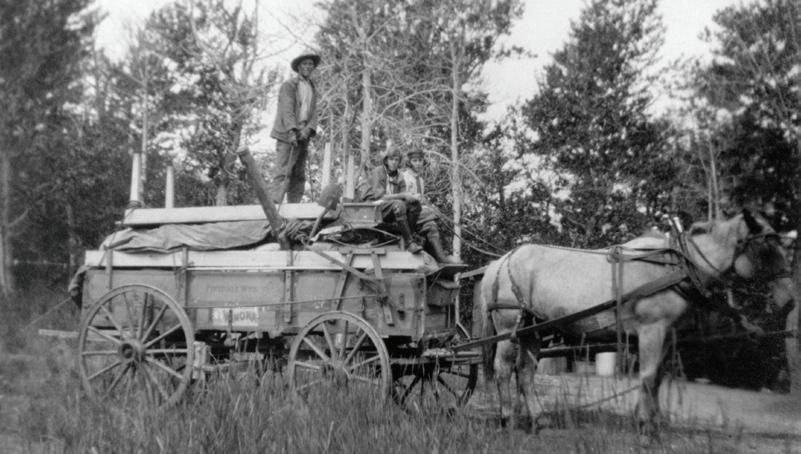
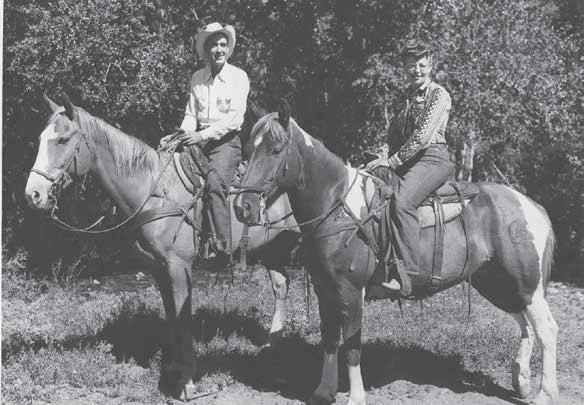
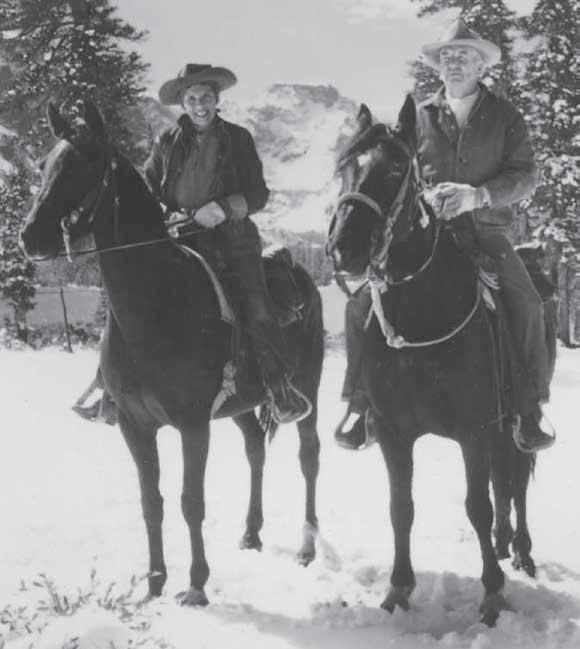
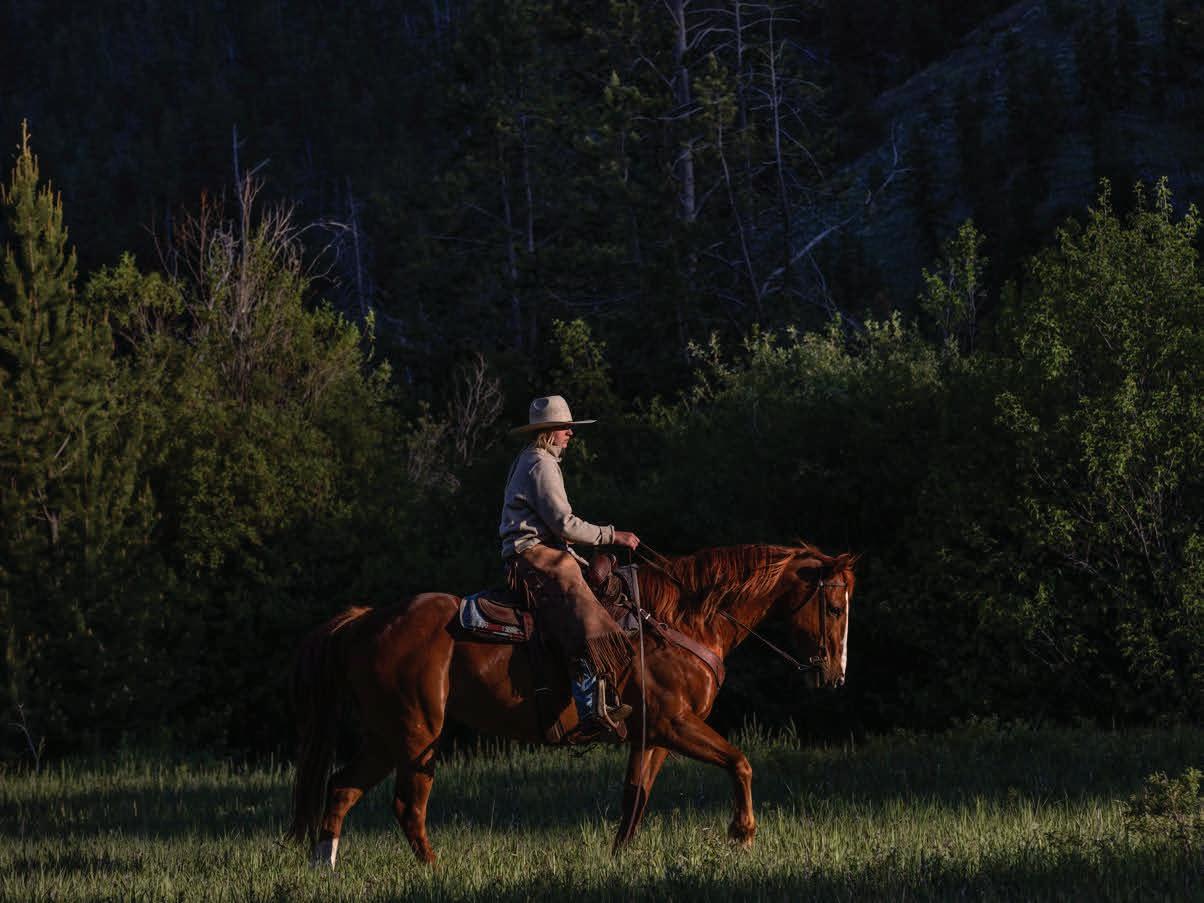

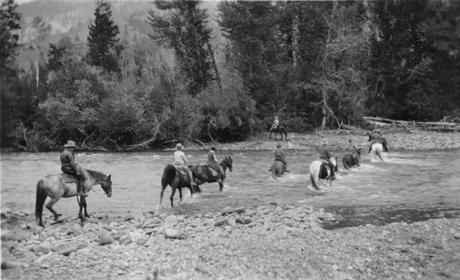
The story of Crossed Sabres Ranch began in 1898, when it was incorporated by Aron “Tex” Holm as Lodge 3 of the Holm Transportation Co. Holm’s transportation and tourism business offered transport and camping trips in Yellowstone National Park. Initially, the company moved guests in horse-drawn wagons, then steam-powered cars, from Cody, Wyoming, to Holm Lodge along the North Fork of the Shoshone River. After spending several days at the lodge, tourist groups traveled by horse-drawn wagon to Yellowstone for extended visits to Holm’s other two lodges.
The original Holm Lodge was a collection of wall tents and a communal bathhouse. As interest in the dude ranching business increased in the early 20th century, more prominent guests began to make their way West, and more sophisticated accommodations quickly followed. Notably, Holm Lodge was the first ranch in Wyoming to operate solely as a dude ranch, unconnected to a working cattle ranch.
To accommodate more guests, six framed sleeping cottages, 12 four-
CROSSED SABRES RANCH
CODY, WYOMING
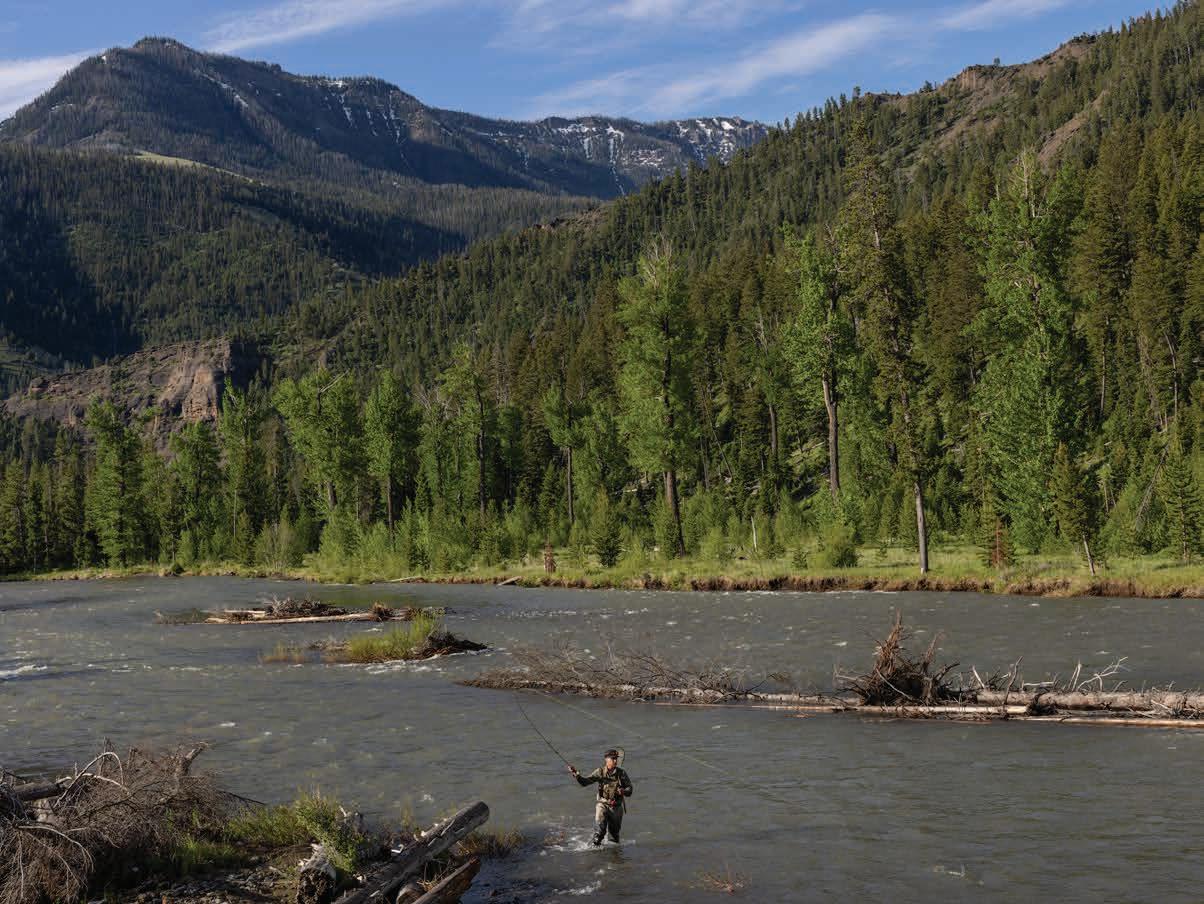

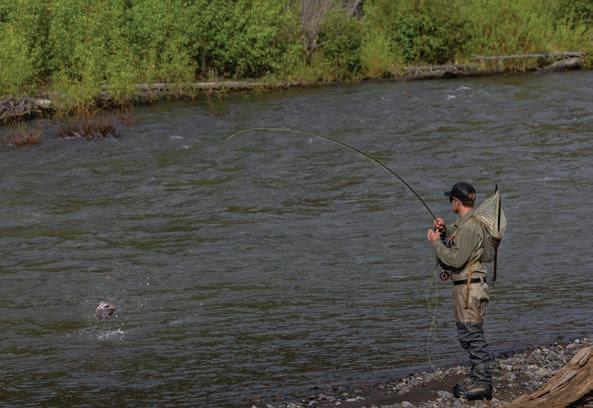
person tents and 12 single-person tents were added in 1912. The CEOs of the Brach’s candy company and Procter & Gamble provided funds to have cabins built for personal use; in return, they allowed the cabins to be rented when the CEOs were not in residence. These cabins still stand at the ranch today, as does the original stagecoach barn from Holm’s operation.
The main lodge burned down in 1914, at a time when Holm was already under pressure from proposed regulations allowing tourists to drive private vehicles in the park. He chose to sell to one of his shareholders
and outfitters, J.W. “Billy” Howell, who rebuilt the lodge. In partnership with Mary Shawver, Howell ran a successful dude ranching business for the next 25 years.
Howell had an abiding love for the U.S. cavalry and wanted to use a crossed-sabres brand for his horses. He wrote to the Department of the Interior and received permission to use a pair of crossed sabres, provided the swords were pointed downward. With Howell’s horses carrying this brand, the ranch, over time, came to be known as Holm Lodge Crossed Sabres Ranch. By the middle of the 20th Century, it
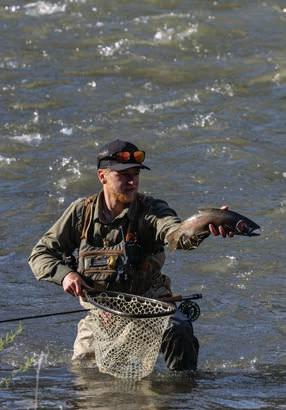
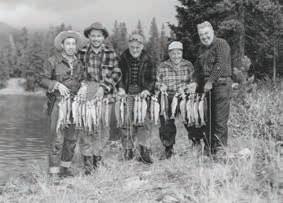
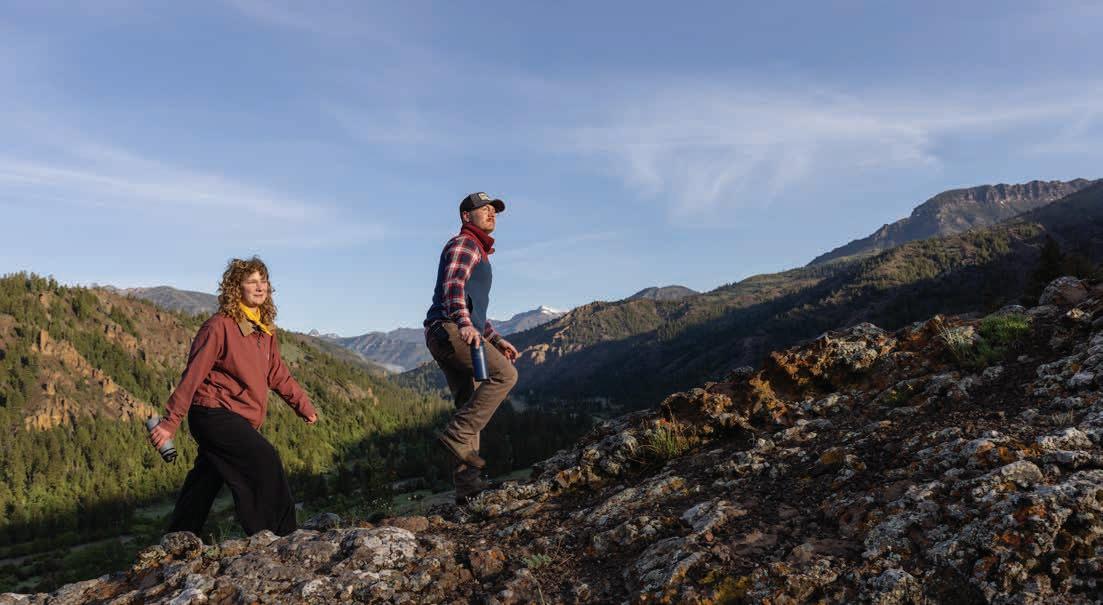
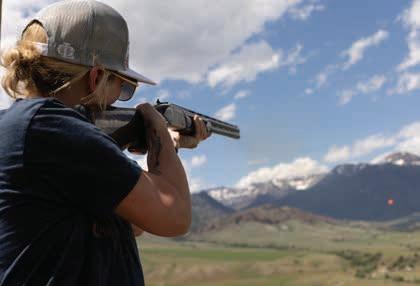
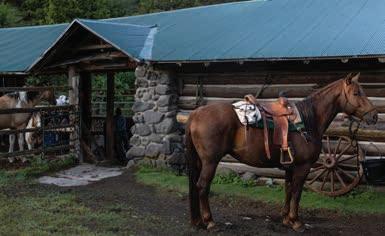
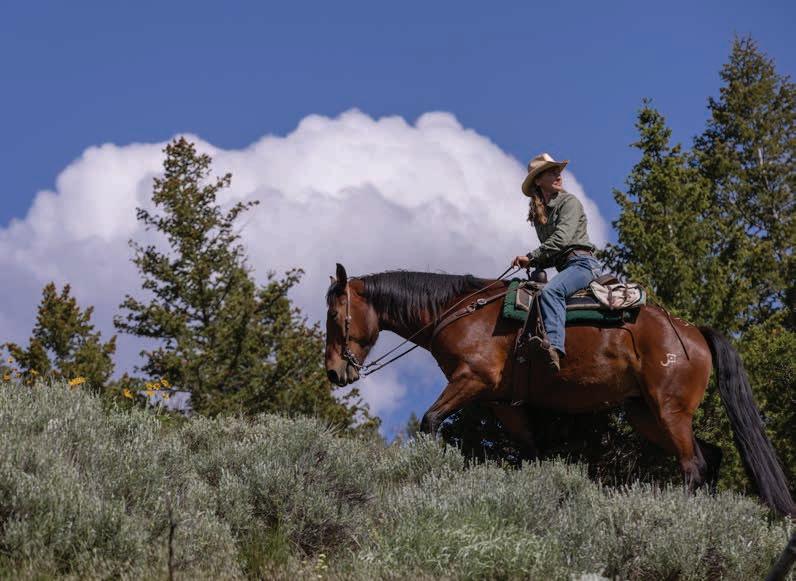
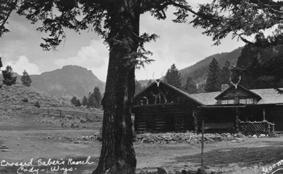
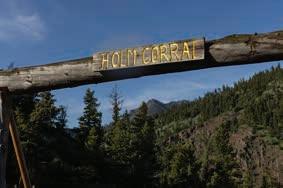
was simply Crossed Sabres Ranch.
The main lodge burned again in 2006, leading to the construction of the lodge at the ranch today.
Kenny and Laura Long picked up the Crossed Sabres brand in 2013. Kenny has spent a lifetime training and showing horses, and as a family, the Longs treasured their experiences dude ranching with their children. The invaluable time spent with family, the beauty and humility they found in nature, and the personal connection with like-minded guests built in the family a steadfast commitment to providing exceptional guest service and preserving the Crossed Sabres legacy. The ranch hosts a small number of guests each week during the summer season, offering the joys of simple Western life, living in the moment, and enjoying real connection with family and new friends.
DARWIN RANCH
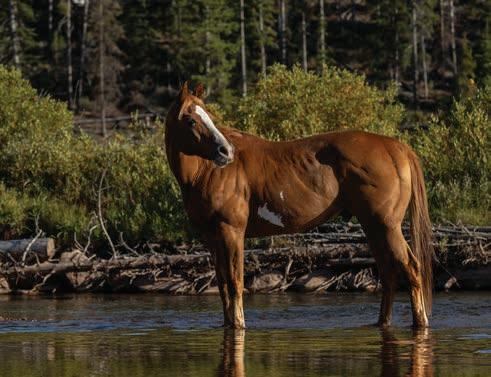
The Darwin Ranch history is a story of family ownership, with hunting, trapping and dude ranching paying the bills along the way. With the closest neighbor 15 miles down a dirt road, the Darwin is surrounded by Bridger-Teton National Forest land in Northwestern Wyoming and located at the headwaters of three major rivers that drain into the western United States.
The Darwin Ranch is one of the few surviving homestead inholdings in a national forest that has not been subdivided. It has a long history, dating to the early 1900s, of homesteading, guest ranching and supporting the Western lifestyle.
It was first home to fur trapper and trader Fred Dorwin, who was born in Indiana in 1856. He made his way to Wyoming in 1901, homesteading 160 acres in the Gros Ventre Range at the head of the Gros Ventre River and the confluence of Clear Creek and Kinky Creek. The ranch’s name was later misprinted on a document as “Darwin,” and the name stuck.

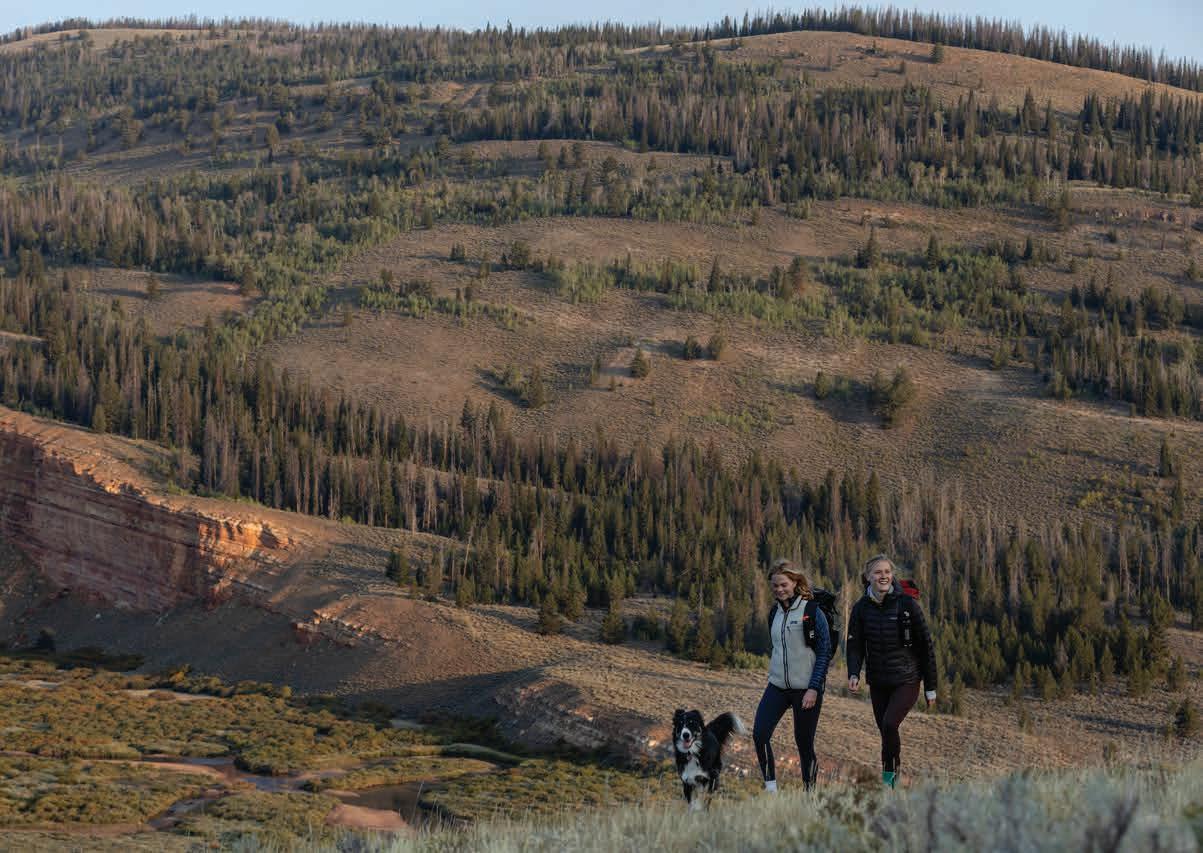
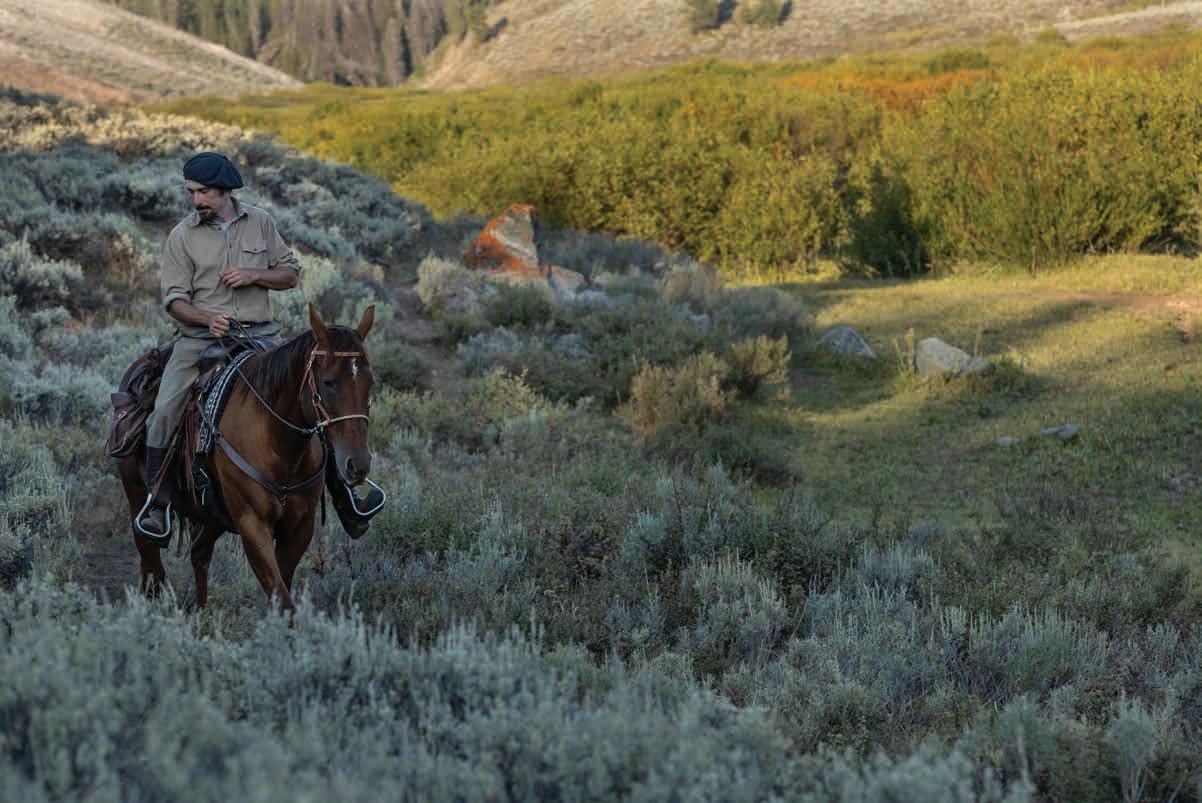
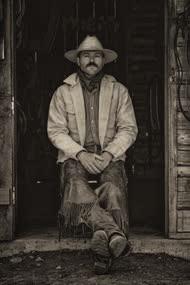
In 1917, Dorwin sold his operation, and it was used as a private hunting lodge for several years, until it was purchased by the Robinson family from Michigan. The Robinsons operated it during the summer and fall as a dude ranch and hunting and fishing operation. They provided horses and guiding services to ranch guests and built a cabin known as the Elk.
In the 1940s, the ranch was owned for private use by families including Phillip and Lalita Norton, an affluent couple from California. They hired builders to construct a new cabin — now the main lodge for guests — and installed a generator to modernize the ranch with electricity. Comfortable rustic furniture filled the rooms, Navajo rugs covered the polished wood floors, and mementos from the Nortons’ exotic travels filled the rooms. Their time in Wyoming was marked by the
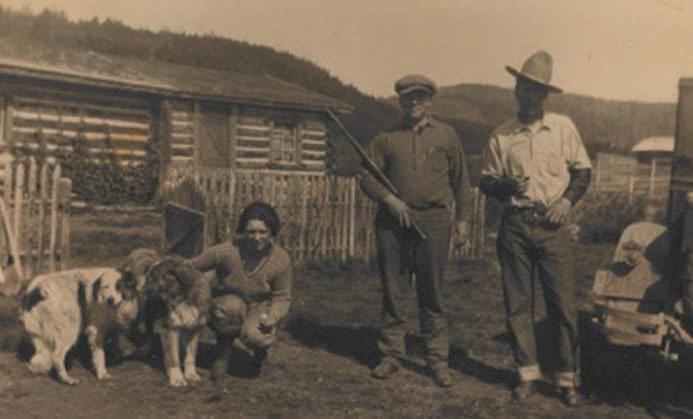
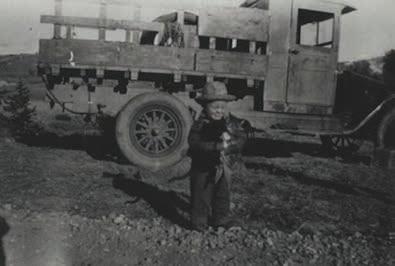
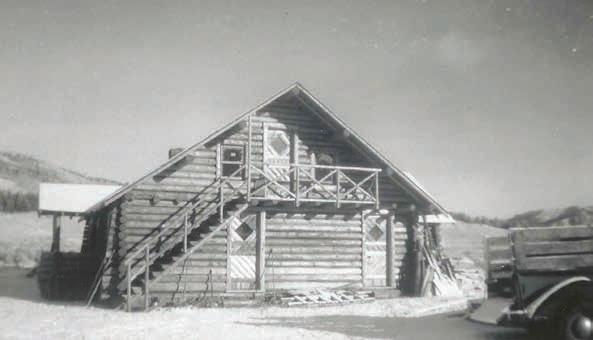

naming of Norton Creek, a tributary of the Gros Ventre River.
The ranch was briefly named Hidden Valley Ranch during its ownership by Ailee H. McIntyre, but the name returned to Darwin with the Woodman family’s ownership in the 1960s. They improved much of the infrastructure and shored up the buildings, which had suffered on the area’s unstable soil. They also built new cabins using local standing dead trees. The Woodmans’ son, Charles Loring Woodman, took over ownership and introduced hydroelectric power, which has been reimagined on the ranch today. He also gave guests the opportunity to play and explore in the
undisturbed outdoors. Clients rode horseback, hiked, fished and hunted in the fall.
On the Darwin’s list of owners are doctors, ranchers, lawmen, crooked trappers, soldiers, railroad men, ambassadors to Russia, and graduates of Harvard and Bowdoin colleges. Throughout much of its history, the owners were highly educated, leading the Darwin to be considered an “intellectual dude ranch,” with the lodge living room lined with books and home to deep conversations over the years.
A former ranch employee introduced the current owners, Paul Klingenstein and Kathy Bole, to the ranch, certain they would love it. The family fell in love and wanted to be part
of the preservation of the historic ranch. They purchased it in 2014, and Kathy and one of her sons, Oliver, went to work running it.
The family aims to operate the ranch as a “green” business, implementing new systems while acting as stewards. They offer guest experiences in honor of those previous owners, letting the guests enjoy the place on their own.
The Darwin has been nominated for the National Register of Historic Places for its trapping, outfitting and dude ranching history, and for its Western Craftsman architecture. The nomination is an important recognition of the Darwin’s rich contributions to the proud ranching and homesteading history of

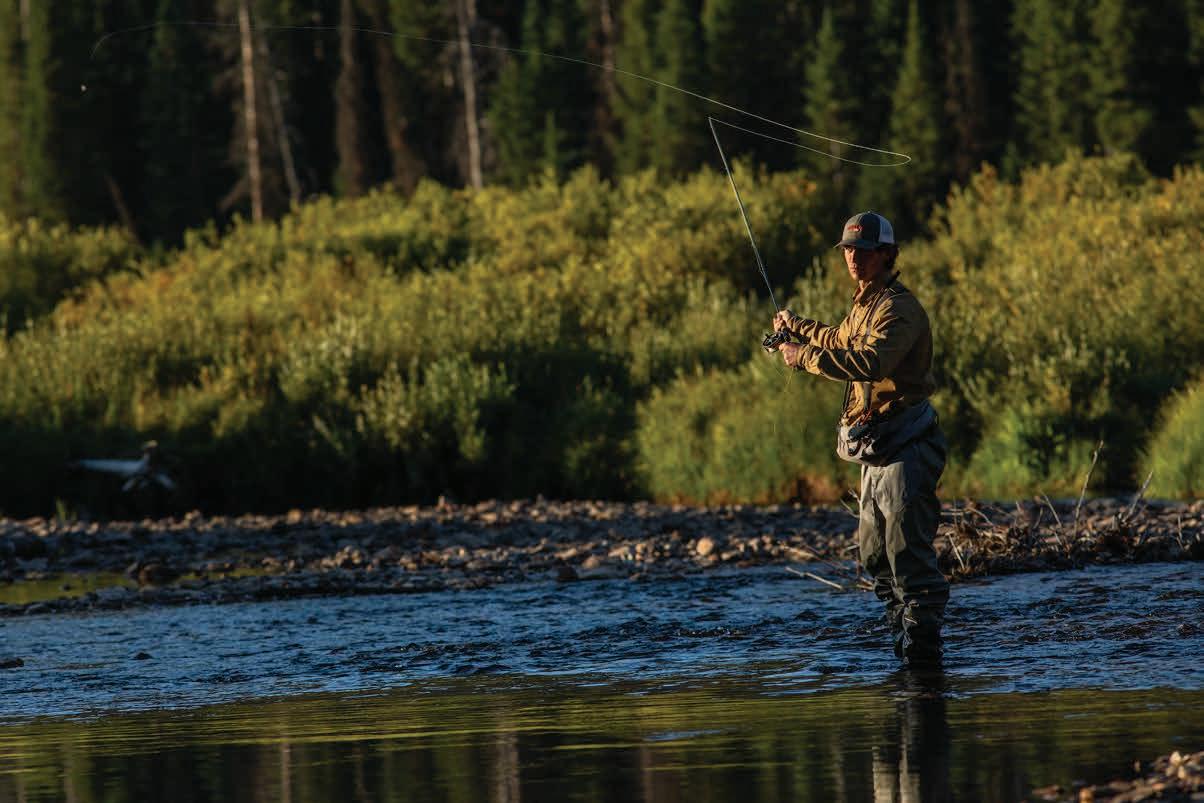
EATONS' RANCH
WOLF, WYOMING
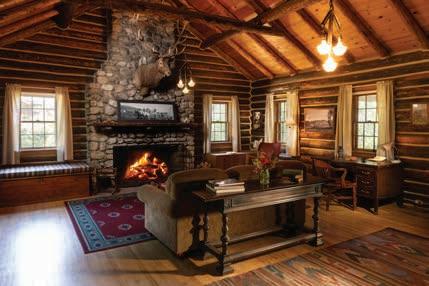
Dude ranching got its start at Eatons’ Ranch, founded in 1879 by Howard Eaton in Medora, North Dakota. Howard first traveled to the Dakota Territory on a hunting trip and decided to settle along the Missouri River and start a cattle ranch. The ranch was originally called the Custer Trail Ranch, as it was located along the route George Custer had followed just three years earlier to the Little Bighorn River. Soon, Howard was joined out West by his brothers, Willis and Alden.
Originally from Pittsburgh, Pennsylvania, the Eaton brothers had many friends visit them from the East to hunt and share in the ranch work. Excited by their new lifestyle and eager to share it, the brothers wrote letters to their friends back East, describing the virtues of the West. One of these letters was published in The New York Times, and Theodore Roosevelt read it and was inspired to travel West, ultimately purchasing the nearby Maltese Cross Ranch. This move and Roosevelt’s subsequent endorsement of the West spurred even greater curiosity for travelers.
The Easterners’ fascination with the West was evident as people’s visits went from weeks to months in duration. Always generous and hospitable,

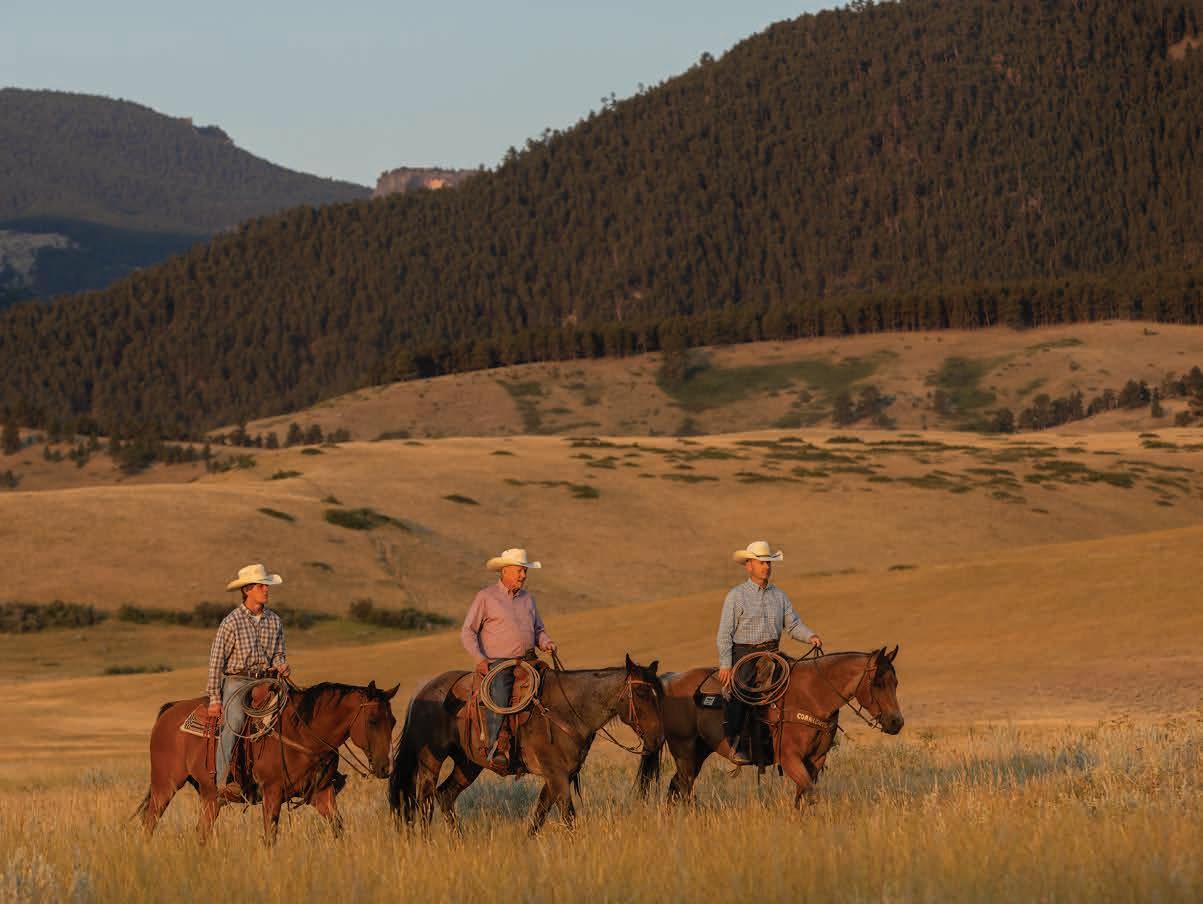
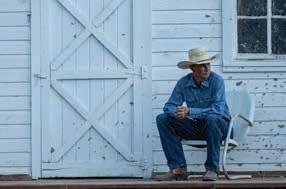
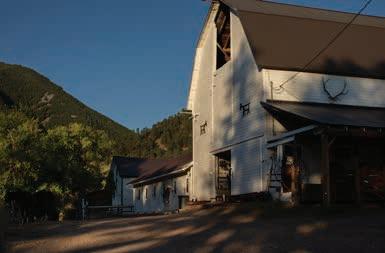
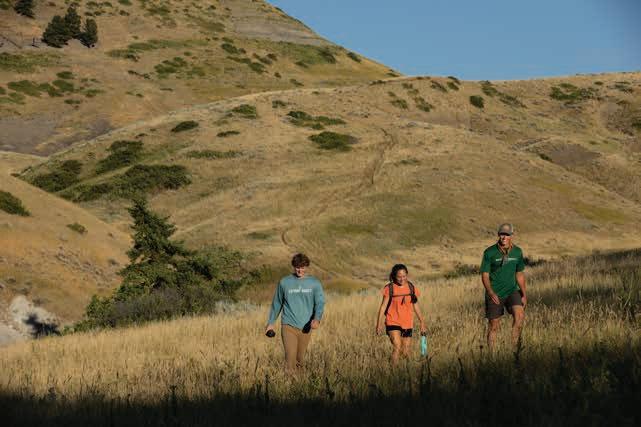
the Eatons were giving their friends the opportunity to live the life of a cowboy. It wasn’t until one of the guests offered to pay for room and board, “so folks can stay as long as they like,” that guests were even charged for their stay. At that point, it’s said, the dude ranching business was born.
Dudes enjoyed horseback riding, hunting and pack trips in their adventures to Eatons’. In 1898, Howard led his first pack trip into Yellowstone National Park, which became an annual tradition. That first trip included 40 dudes with riding horses, pack animals and equipment. Later, Howard took pack trips through Glacier National Park.
In 1904, the Eaton brothers moved their operation to a ranch nestled along the Bighorn Mountains in Wolf, Wyoming, after they were drawn farther west by guests’ interests in Yellowstone. They were looking for a new home with great mountain riding, beautiful summers and tolerable winters.
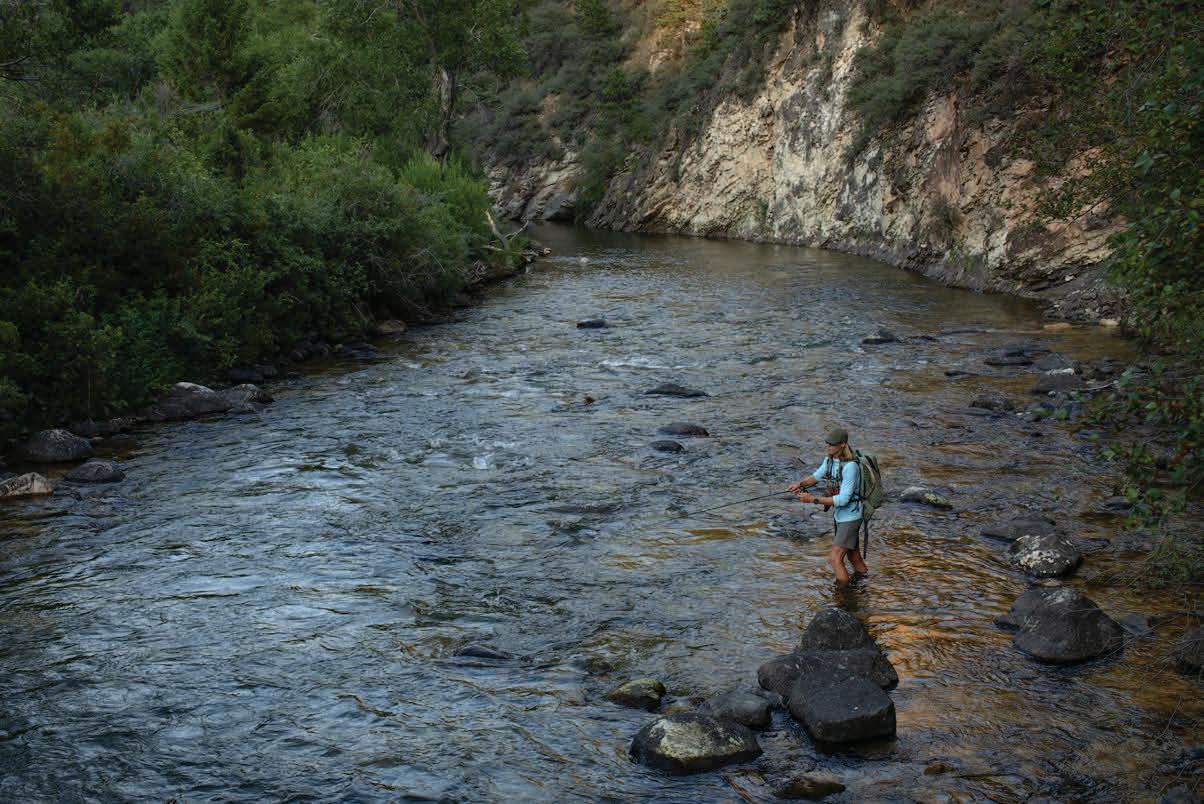
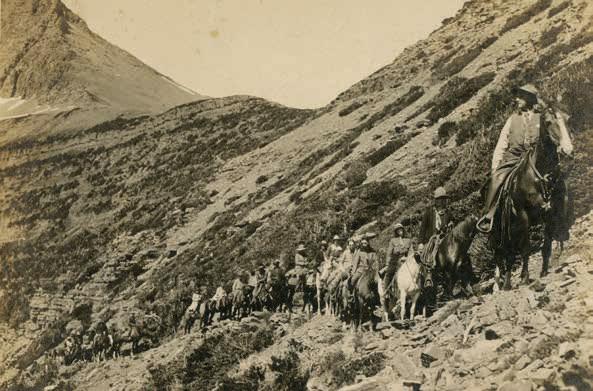
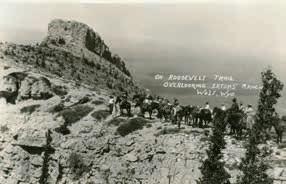
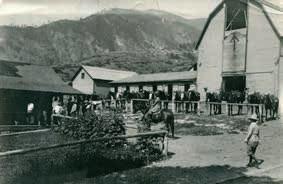
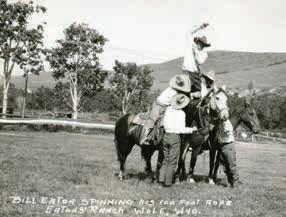
Over the years, Eatons’ Ranch played host to a long list of celebrities, including Cary Grant, Will Rogers, Hans Kleiber, Charles Marion Russell and Will James. Mary Roberts Rinehart, a World War I correspondent, was a frequent guest of the ranch while writing several books about the West, including Through Glacier Park: Seeing America First With Howard Eaton, about her pack trip experience.
The Eatons left an indelible mark on the newly developed industry, with the family serving a role in the development of the Dude Ranchers’ Association in 1926. Their focus on the well-being of their guests with remarkable hospitality became a hallmark of dude ranching that continues to this day.
After 100 years, the fourth and fifth generations of the Eatons’ Ranch family are still welcoming guests to Wolf. Although the faces have changed at the ranch, it’s easy to imagine what it was like a century ago. Eatons’ Ranch will always be Eatons’.
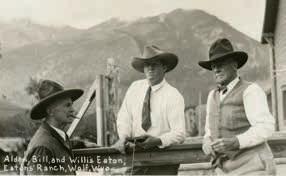
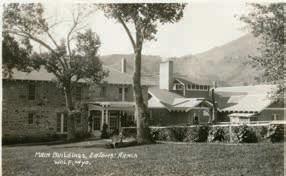
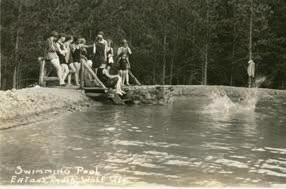
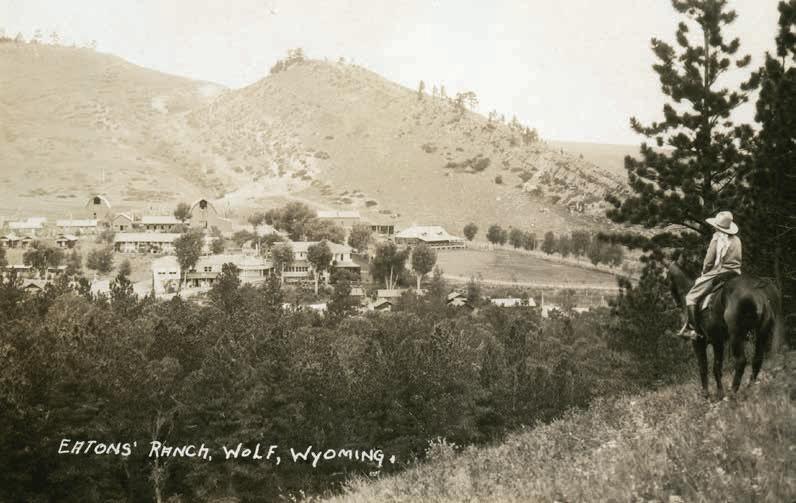
HIDEOUT
LODGE AND GUEST RANCH
SHELL, WYOMING
Founded: 1913
Founders: Gay and Ed Wyman
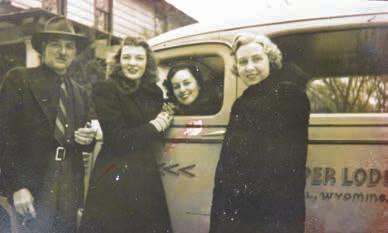
The area home to the Trapper Creek Lodge & Guest Ranch (and, later, The Hideout Lodge & Guest Ranch) was homesteaded by settlers arriving in the Bighorn Basin of Northern Wyoming in 1882. The first log building on the ranch — and in the Shell, Wyoming, area — dates to 1886, when it was built of hand-hewn square logs by a French trapper named Julius Boucher. He homesteaded the upper 160 acres of what ultimately became the ranch.
Gay and Ed Wyman purchased the homestead in 1908. It operated as a cattle ranch called the 16-1 Stock Ranch until about 1913, when it began hosting guests. Like many other ranchers in the West, the Wymans soon had more guests who were staying for extended periods and offered to pay for the experience. Along with other ranchers at the precipice of this new industry, Ed was one of the original founding board members of the Dude Ranchers’ Association.
Early guest accommodations were canvas tents constructed on wooden floors. Dudes enjoyed fishing in Trapper and Shell creeks, along with horseback riding and hunting. They paid almost double to stay at the Wymans’ enlarged cow camp, located at an elevation of 8,000 feet in the mountains.
During the 1920s, the ranch welcomed affluent guests from Eastern
Above Ed Wyman and his wife pick up guests in Cody, Wyoming, for the trip to Trapper Lodge. Right Riding at Needle Rock near the historic Trapper Creek Lodge & Guest Ranch.
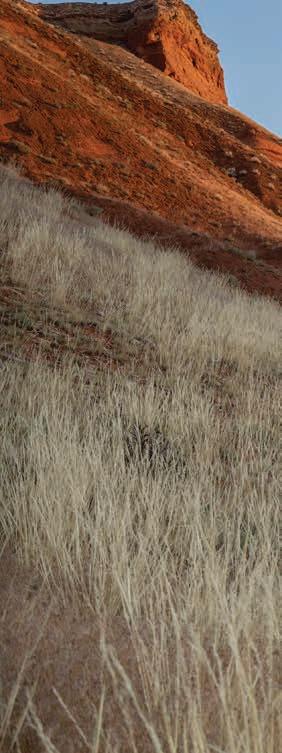
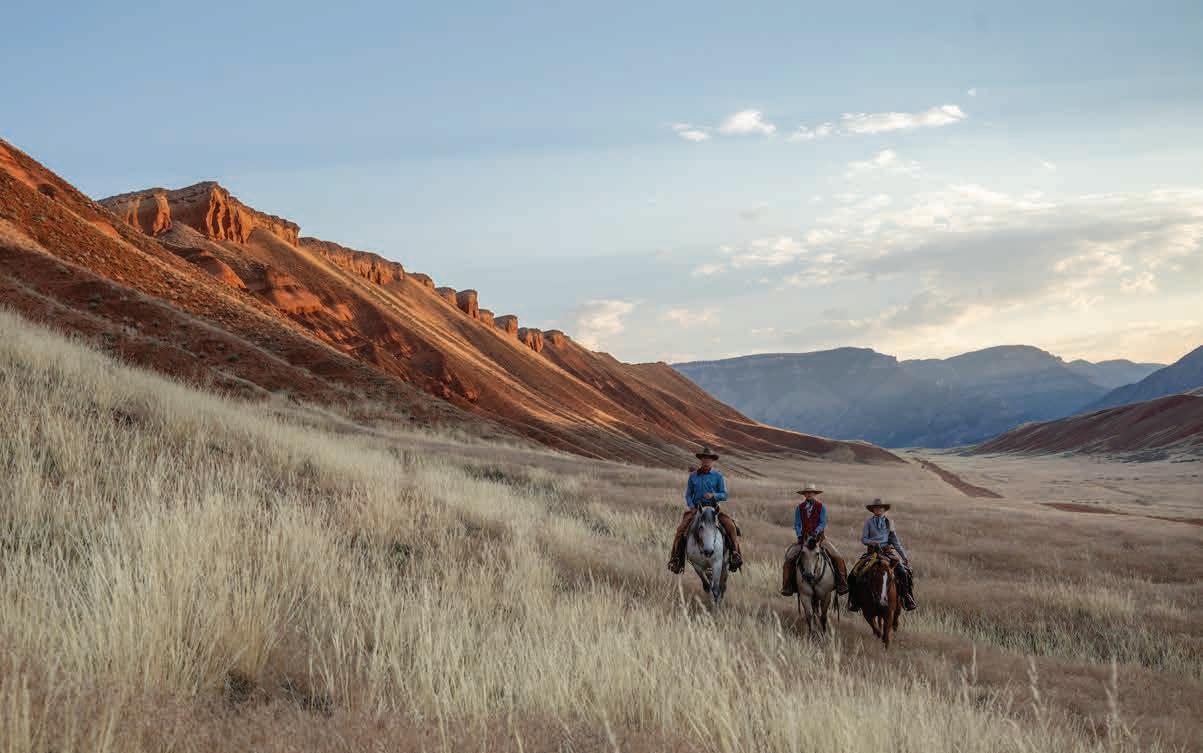
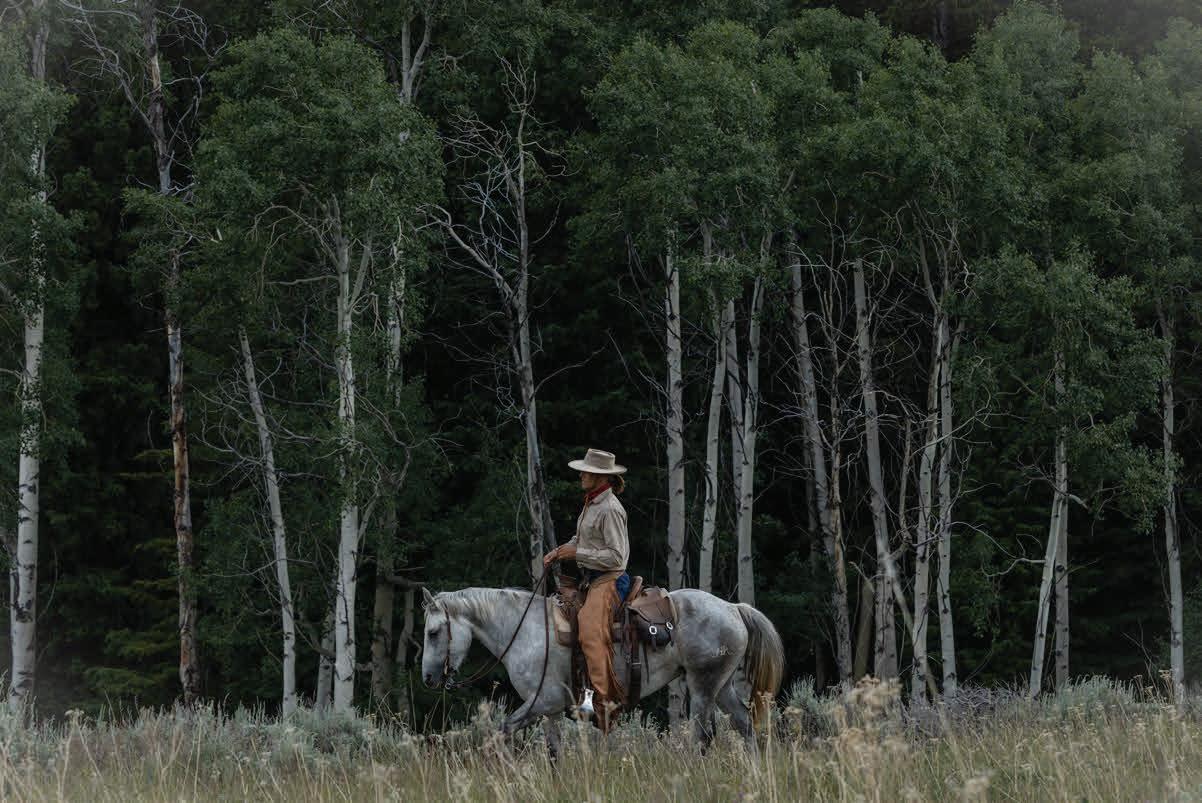
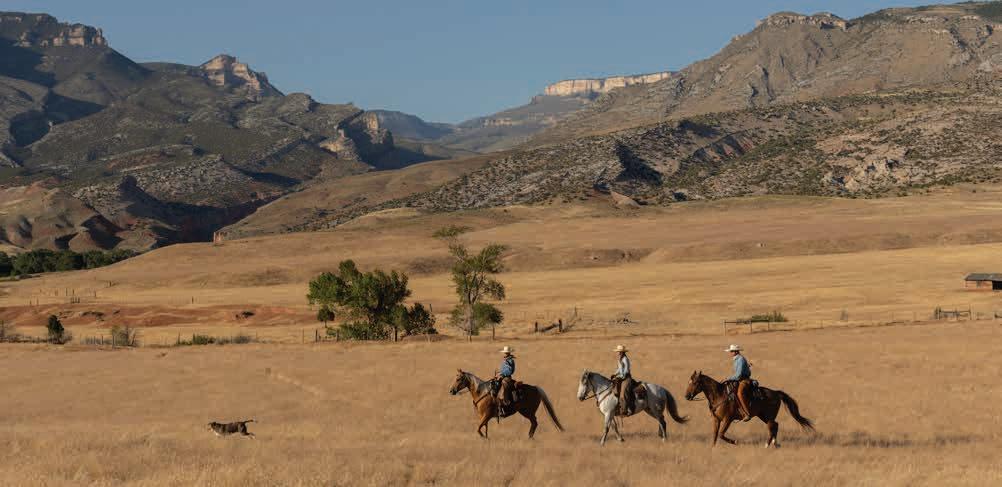
states, such as Ernest Hemingway, Owen Wister and Theodore Roosevelt. Regular guests included many authors and artists, leading the property to garner a reputation as an intellectual dude ranch in the West. One of the regular visitors to the ranch was N.C. Wyeth, a well-known illustrator and painter who illustrated classics such as Treasure Island, The Last of the Mohicans and The Odyssey. He was also a member of the family that had founded Wyeth Pharmaceuticals in 1860.
The Wymans sold the ranch to the Wyeths in 1926; the following year, the family built the Trapper Creek Lodge and two guest houses, which are the only remaining examples of American Craftsman
architecture in the area. The lodge became the private guest ranch of the Wyeth family, hosting friends and corporate clients from around the world.
In later years, the ranch had various owners who operated the lodge as a guest ranch. Some of those owners grazed sheep above the lodge, causing erosion and water damage that caused the ranch to close. At one time, the property was also used as a silver fox farm. Today, the original property, now called Trapper Creek Lodge & Guest Ranch, is owned and operated by Peter and Marijn De Cabooter, the owners of The Hideout Lodge and Guest Ranch nearby.
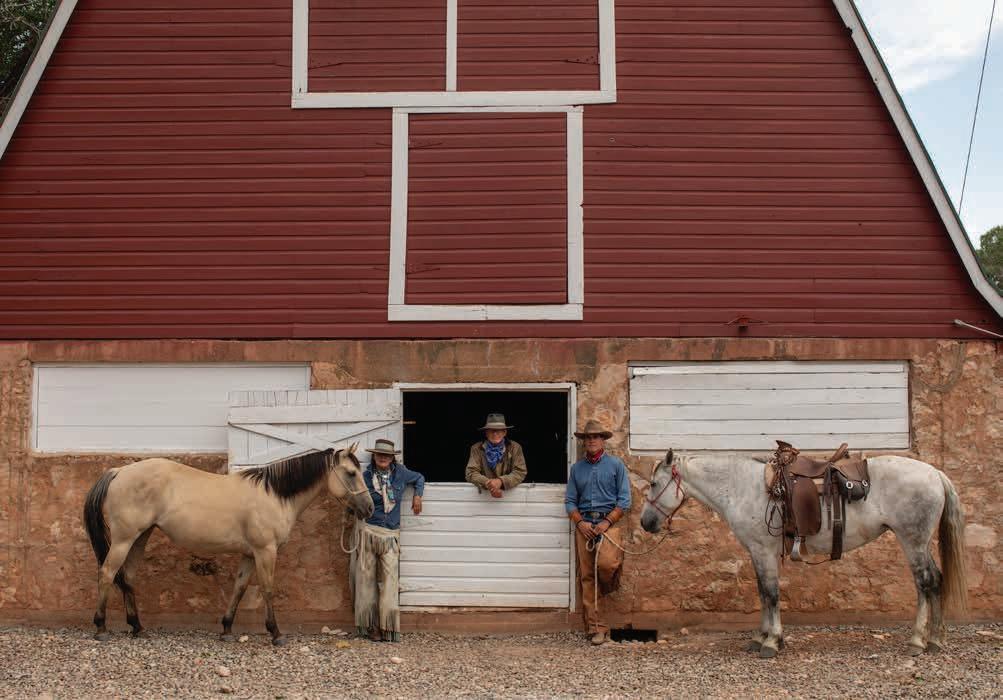
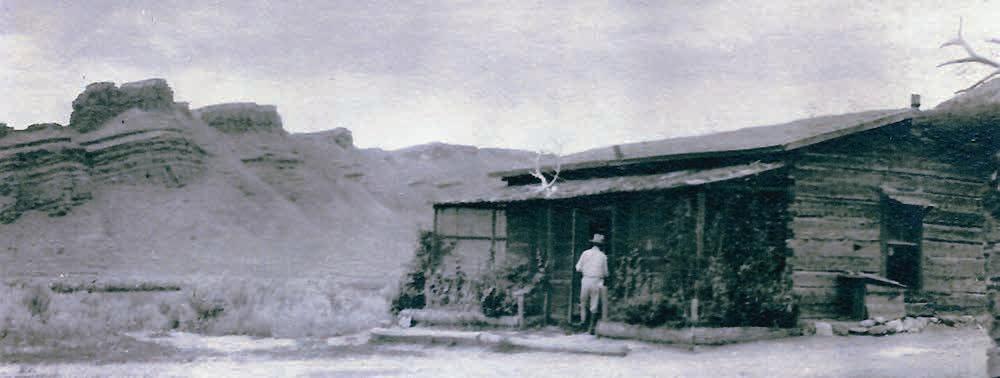
Paula De Cabooter-Flitner and her husband, David, founded The Hideout in the mid-1990s as a new iteration of the Trapper Creek property. In 2006, Paula’s nephew Peter De Cabooter and his wife, Marijn, took the reins, and they now own both The Hideout and Trapper Creek, which is used for riding, grazing, haying, lodging and fishing as part of the guest ranch operation. Over the years, the ranch’s focus has become even more about riding and horsemanship; it hosts up to 25 guests weekly and welcomes a diverse riding clientele from around the world.
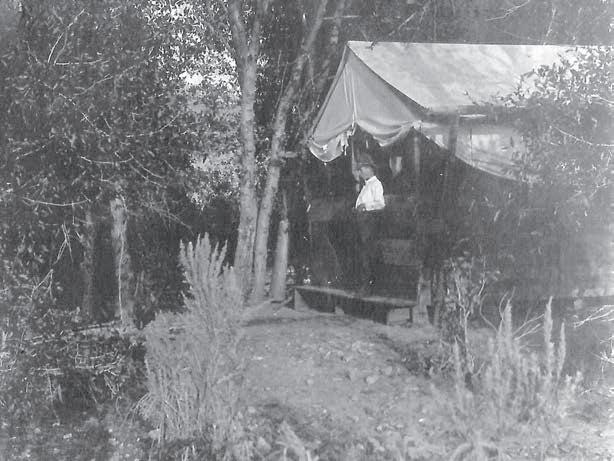

MEDICINE BOW LODGE AND ADVENTURE GUEST RANCH
SARATOGA, WYOMING
Founded: 1917
Founders: Jessie Moore and George “Baldy” Sisson
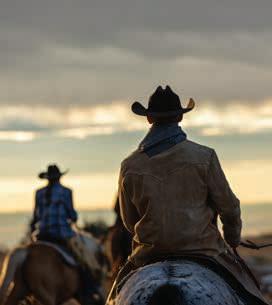
Medicine Bow Lodge opened as a guest ranch on July 15, 1917. Jessie Moore and her brother-in-law George “Baldy” Sisson built the lodge to give dudes from the East a place to vacation. Located near Saratoga, Wyoming, in the Snowy Range of the Medicine Bow National Forest, the ranch is surrounded by old mining and logging towns. Sisson was owner of the Wolf Hotel — which he renamed the Hotel Sisson — in Saratoga. He and the hotel’s original owner, Frederick Wolf, had served as Rough Riders in the Spanish-American War. Moore was originally from Ohio and was working as a telephone operator in Saratoga. Together, Sisson and Moore planned to build a tourist camp, like other “dude camps” in the West, on upper Brush Creek.
In 1917, they began construction on a log lodge, one that would serve as a common room and dining hall, along the bank of Barrett Creek, at an elevation of 8,000 feet. Not all the camp’s buildings were completed in time for opening, but plans were in place for accommodations for up to 30 guests and “other necessary structures which go to make up a comfortable and home-like camp for the benefit of the eastern tourist of city dweller

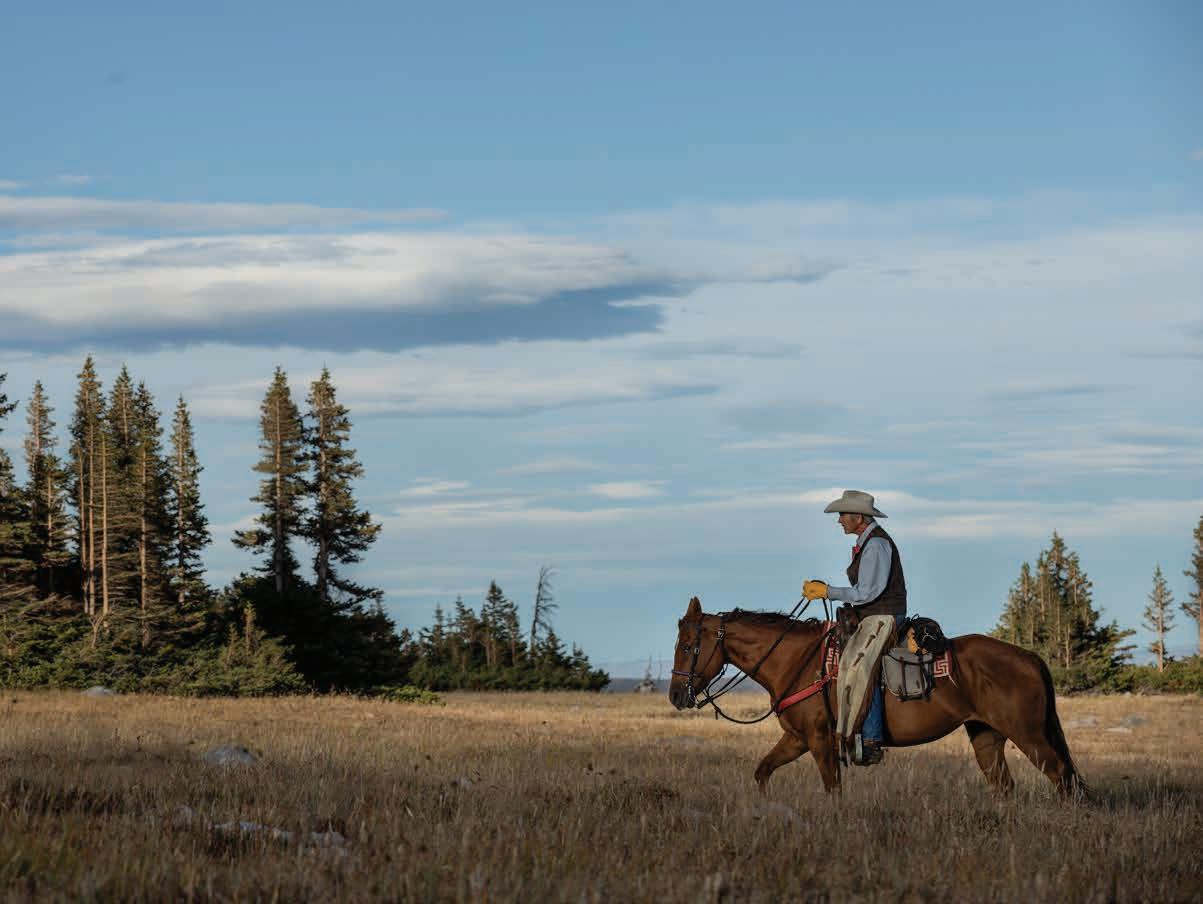
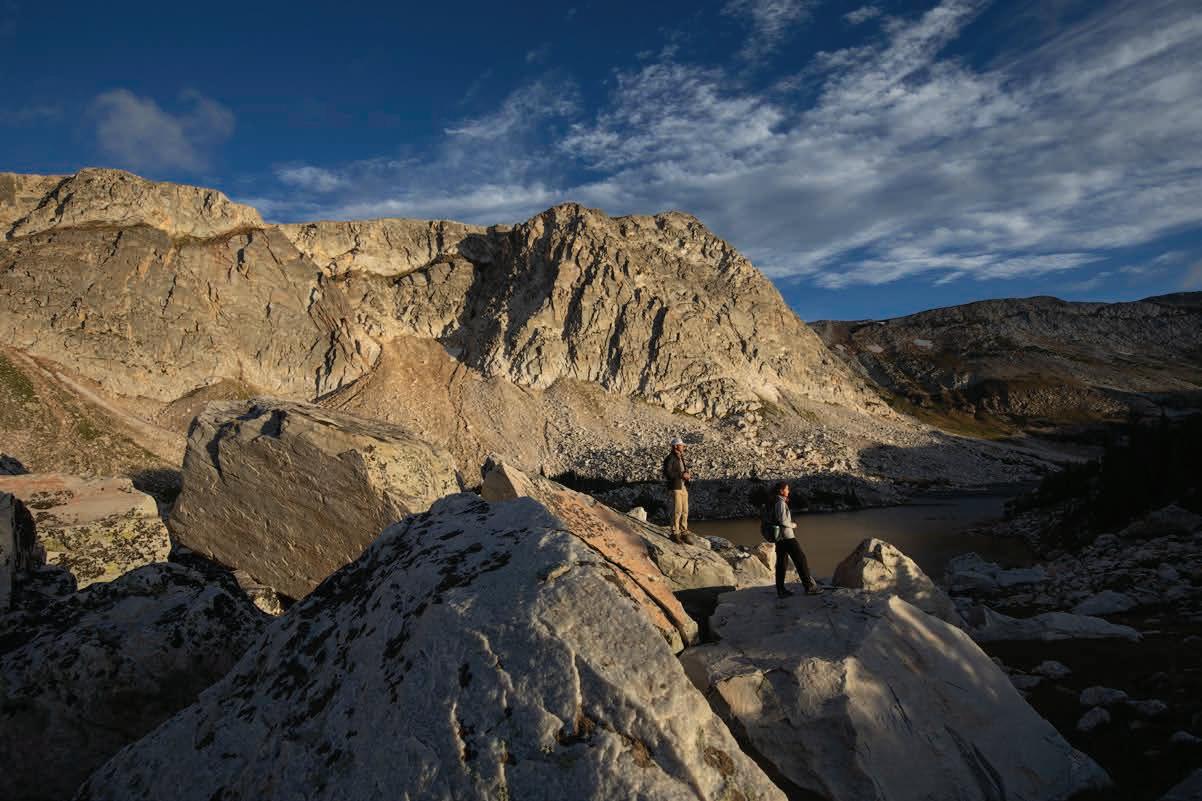
who feels ‘the call of the wild.’”
According to a 1917 issue of The Saratoga Sun, more than 175 people attended the first opening-day dance at the lodge, a tradition that continued into the mid-20th century.
Sisson died in 1935, leaving Jessie and her new husband, Charlie Plummer, as owners of the ranch. Plummer owned Plummers Cottages, which later became Medicine Bow Lodge Cottage Camp, a halfmile from the lodge, with six cottages, a commissary and a gas pump.
By the mid-1930s, the ranch had 22 guest cabins and other tents for lodging, and it offered horseback riding, hunting and fishing. A 1930s-era brochure reads: “To the lover of the scenic, the haunting beauty of the Snowy Range, with its stately pines and hundreds of sparkling lakes mirroring the sky and mountains, will stay with the visitor all through life.”
The ranch was later purchased by Virgil Bowen and Harry Kittell; at the time, it had 39 cabins accommodating up to 150 guests. In 1949, it was sold again, to Annye D. Wood, who operated it through 1955. (Wood purchased Kittell’s half-interest in 1949, then the other interest from Bowen). Mr. and Mrs. Walt Marrow, from Denver, then purchased the ranch in 1956 and held its 39th annual opening-day dance.
After the 1950s, the ranch’s ownership changed hands several more times but offered the same dude ranch enjoyments. At times, it stayed open year-round for cross-country skiing and, later, snowmobiling.
Since 2002, Tim and Debbie Bishop have owned and managed the ranch, offering an escape for guests from busy modern life. The Bishops met at a Colorado dude ranch in 1983 and set a lifelong goal of owning one. Still intact is the original kitchen and dining room, where the Bishops honor the lodge’s long-held Western traditions.
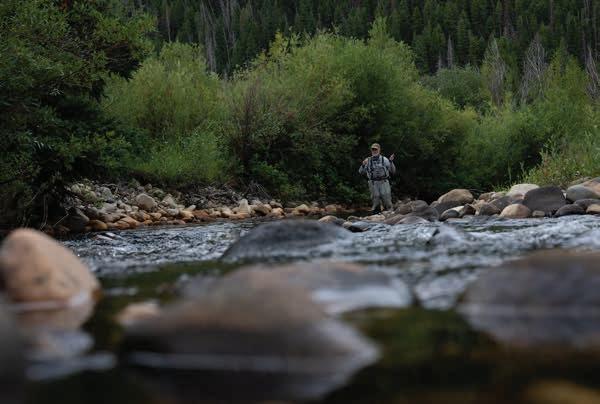
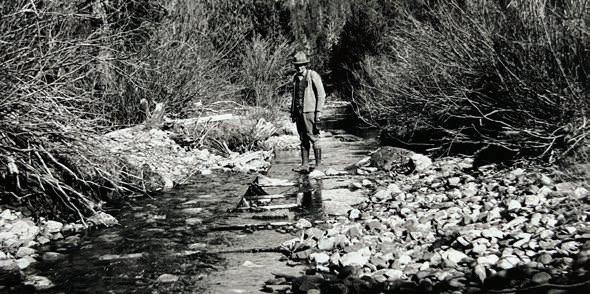
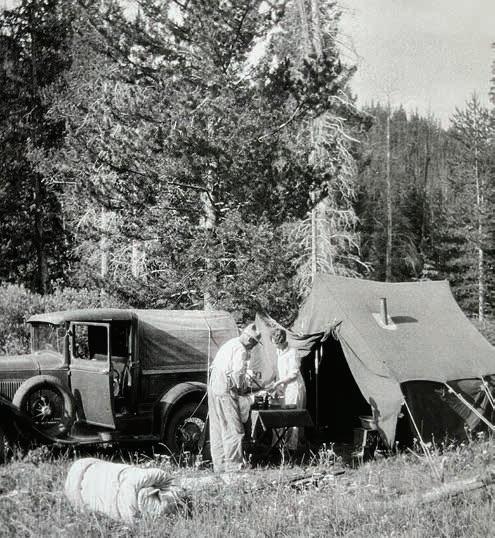
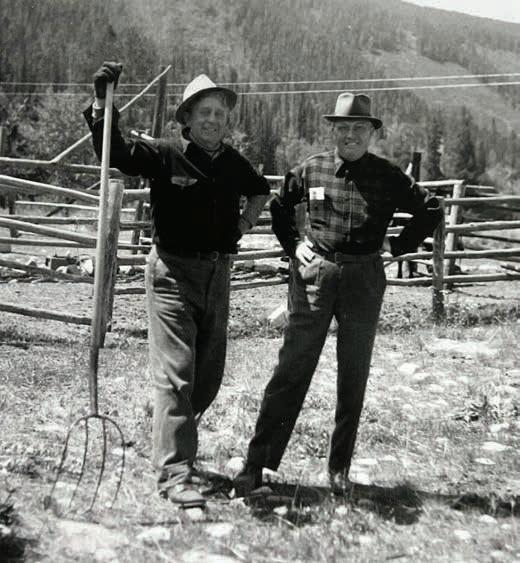
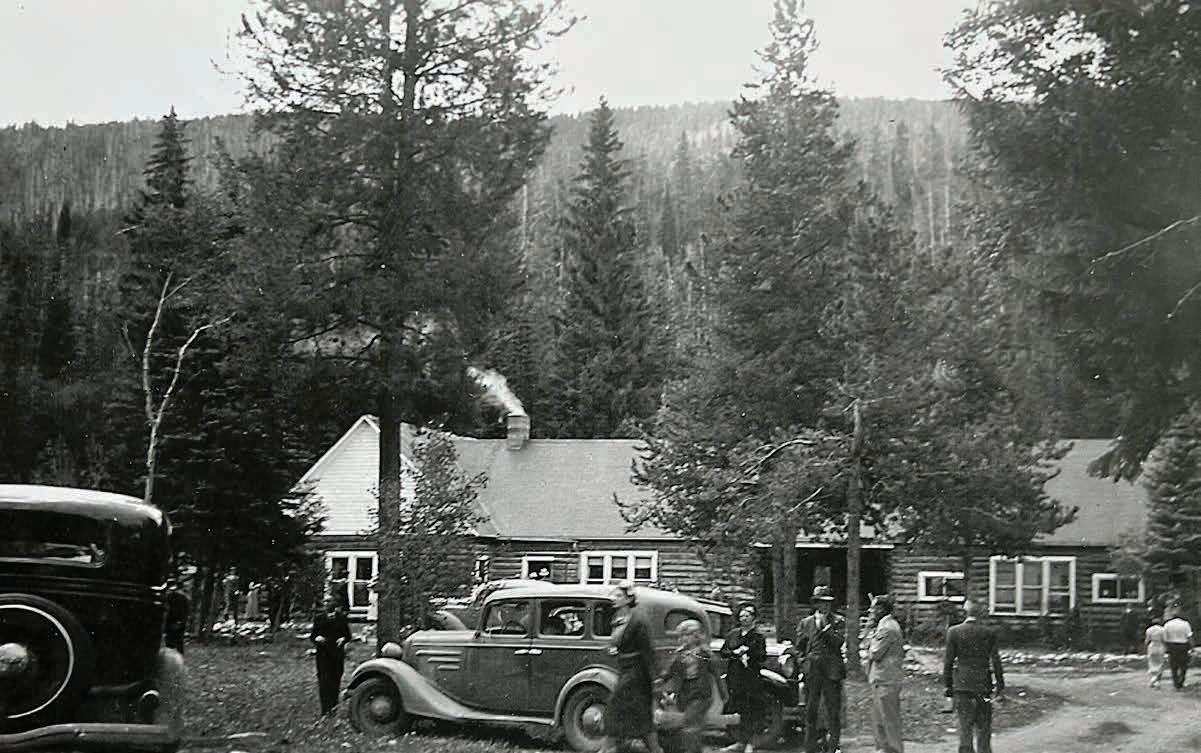


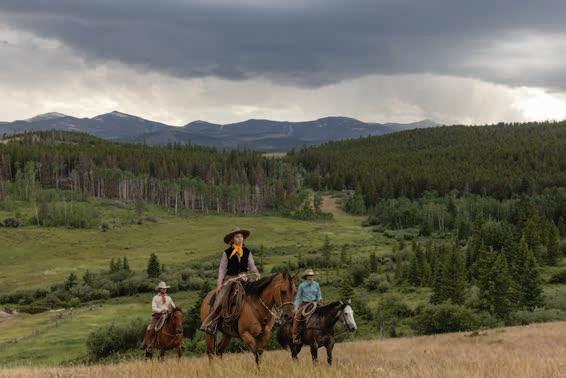
In the late 1890s, Norman Meldrum drove a herd of cattle from Colorado north to Buffalo, Wyoming, where he had acquired some land. The cattle were wintered near the present Soldier’s Home and summered in a meadow of the Bighorn Mountains, the site that was to become Paradise Ranch. Meldrum, a Civil War veteran, had had a successful political career in Colorado before moving to Buffalo in 1897, and he liked the mountain meadow so much that he proved up the land and acquired a title.
Meldrum’s son, Dr. Gordon Meldrum, returned from serving as a medic in the Philippines during the Spanish-American War and decided to settle in Buffalo and establish a practice. He was enchanted with the cabin in the mountains and encouraged friends to visit him there; it was these visitors who affectionately called the meadow “paradise.” The name stuck
PARADISE GUEST RANCH
BUFFALO, WYOMING
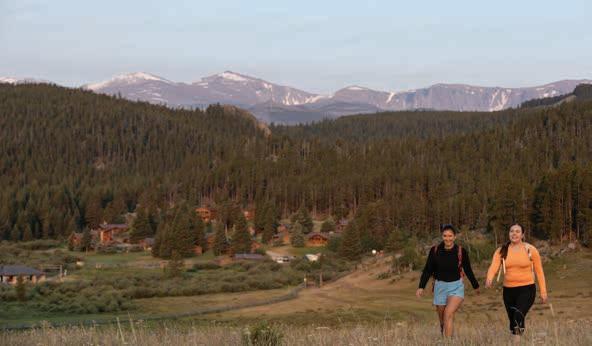
and eventually became the name of the ranch.
Gordon married Mabel Lee in 1903, and to accommodate their friends, they added a few more cabins along the banks of French Creek. Soon they began hosting paying guests, and the dude ranch was in its infancy. It officially opened as Paradise Guest Ranch in 1907.
Gordon died in 1911, leaving Mabel to run the ranch. She was a perfect host, loved the outdoors and was able to shoot, ride, hunt and fish with the best of them. By 1915, the cattle business saw less focus as the ranch established a herd of saddle horses. More
cabins and tent lodgings were built for the guest ranching business; riding, hiking, hunting, fishing and overnight camp and pack trips were the main attractions.
Mabel successfully managed the ranch for 16 years—a feat in what then was a male-dominated industry—before selling it in 1926 to Frank O. Horton of the nearby HF Bar Ranch. He ran Paradise as a dude ranch for more than 20 years, increasing the overnight guest capacity to 50 and remodeling some of the cabins and buildings.
The next owner was “Wyoming” Jack O’Brien.

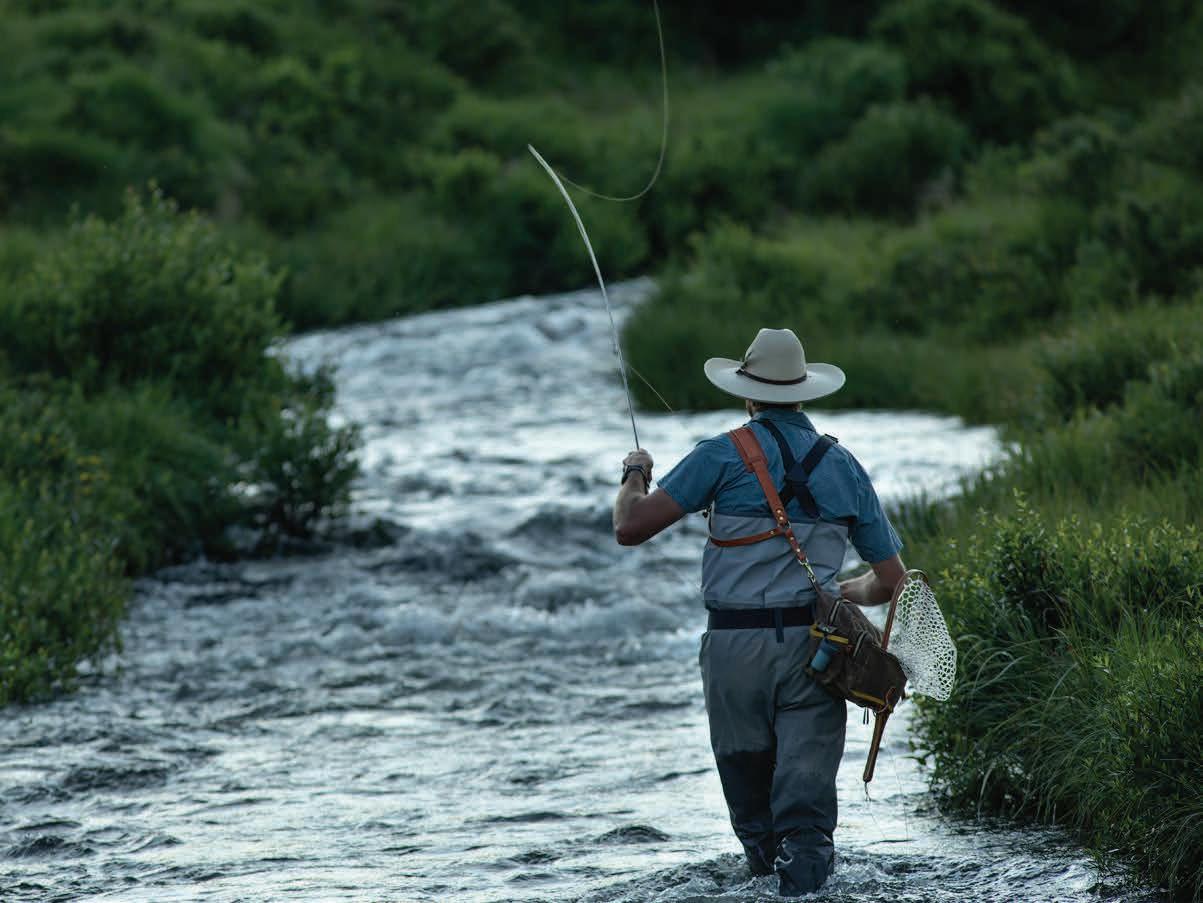
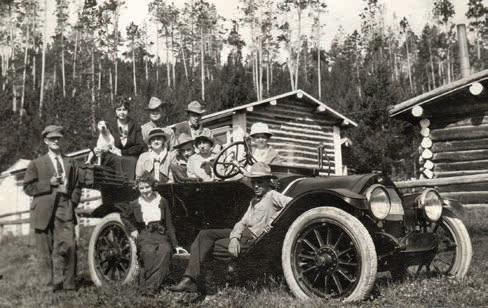
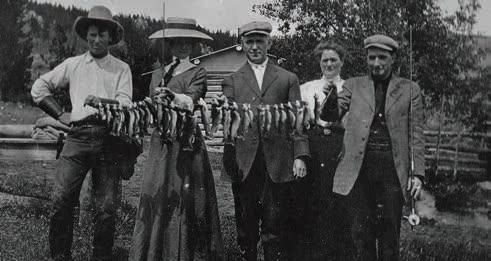
As a young man, he had been an entertainer, playing the banjo and ukulele, and could sing like a bird. He would entertain at the Paradise Ranch Teepee and at other ranches, such as the Spear-O-Wigwam. There, he met a gentleman who was involved in radio stations back East. O’Brien got his big break and left Wyoming to perform on Major Bowes’ radio program. After his success, he returned to buy Paradise Ranch and operate it—still singing away—through the 1950s.
After O’Brien’s tenure, Paradise again passed to a woman: Mrs. John Olds, who ran it through the late 1970s. In 1981, the Apache Oil Co. bought the ranch at public auction and, along with the present owners, spent a great deal of time, money and effort restoring and expanding the ranch into its present state. Nine of the original cabins are still standing and in use at the ranch.
Today, the ranch is owned by Clay and Leah Miller, their sons Cade and Travis, and partners Kevin and Rebecca McMahon of Colorado. The familyowned ranch prides itself in its returning guests, who have been coming to Paradise for more than 30 years, and looks forward to welcoming new guests into the family every season.
Paradise Ranch has hosted many folks from around the globe, including Owen Wister, who wrote a portion of The Virginian while a guest, and Aldo Leopold, who wrote about Paradise Ranch in A Sand County Almanac: “Finally, there was Paradise Ranch. … Through its verdant meadows meandered a singing trout stream. A horse left for a month on this meadow waxed so fat that rain-water gathered in a pool on his back. After my first visit to Paradise Ranch, I remarked to myself, ‘What else could you call it?’
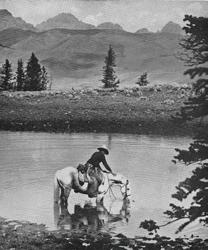
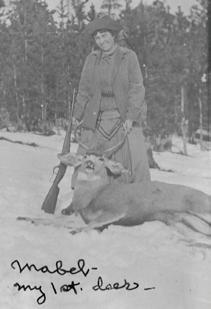
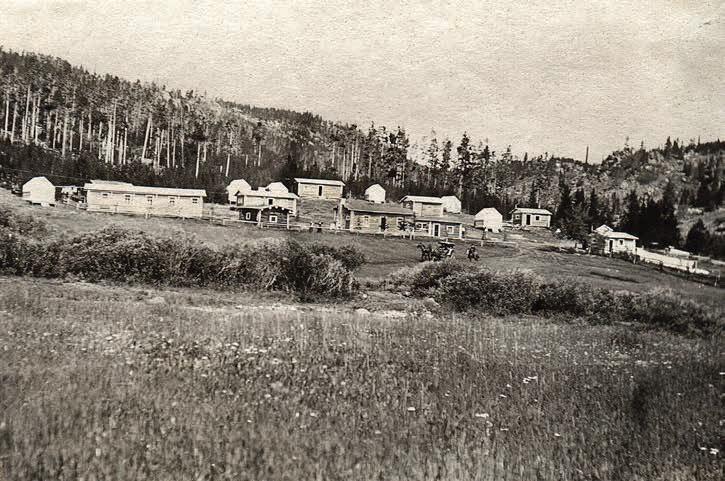
Left, top A photo titled “A Quiet Moment,” showing how the ranch got its name. Left, bottom Mabel E. Lee with her first deer. After the death of her husband, Gordon, in 1911, Mabel took over running the ranch, building it into one of the most successful ranches in Wyoming. Above An early image of Paradise Guest Ranch. By 1915, the ranch had eight cabins and additional tents to accommodate its guests.

RIMROCK RANCH
CODY, WYOMING
Founded: 1926
Founders: Earl and Mildred Martin
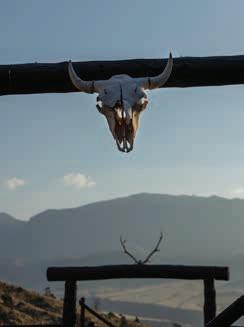
Twenty-five miles west of Cody, Wyoming, a creek flows out of the Absaroka Range of the Rocky Mountains from the south, into the North Fork of the Shoshone River. Named Canyon Creek, it was the location of a 1920s government facility called the Canyon Creek Work Station, which was destroyed by a flash flood on July 22, 1923.
Later in the 1920s, a U.S. Forest Service lease on Canyon Creek was transferred to Earl and Mildred Martin. Earl had been working on the North Fork as a trapper and guide and had met Mildred at Old Faithful Lodge, where she worked. They married, then bought and operated Absaroka Lodge on Gunbarrel Creek in the 1920s. After selling the lodge, they moved to the leased land on Canyon Creek, named it Rimrock Ranch, and built a lodge and guest cabins in the canyon, along the creek.
The Martins offered their guests trail rides and hunts. They were supported by Mildred’s cousin Frank Tenny Johnson, who had established

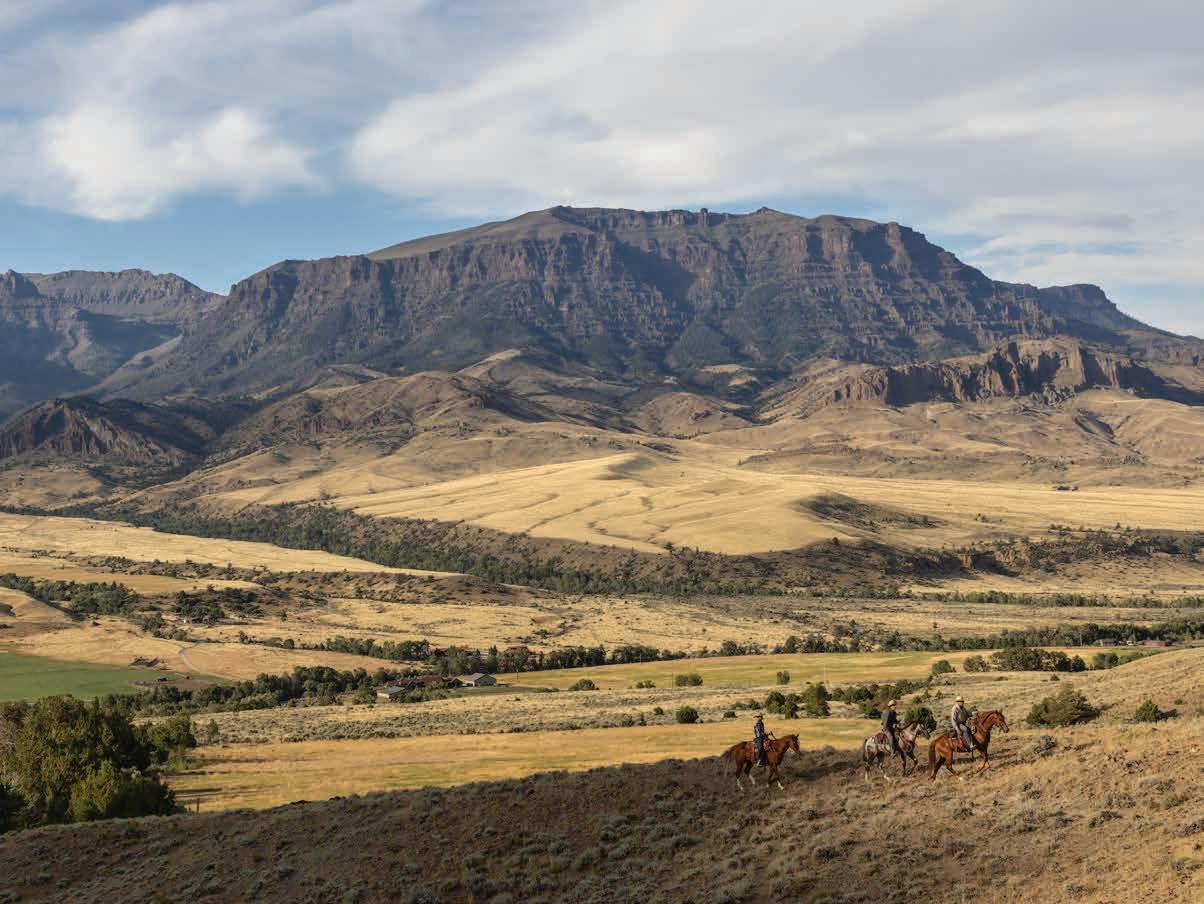
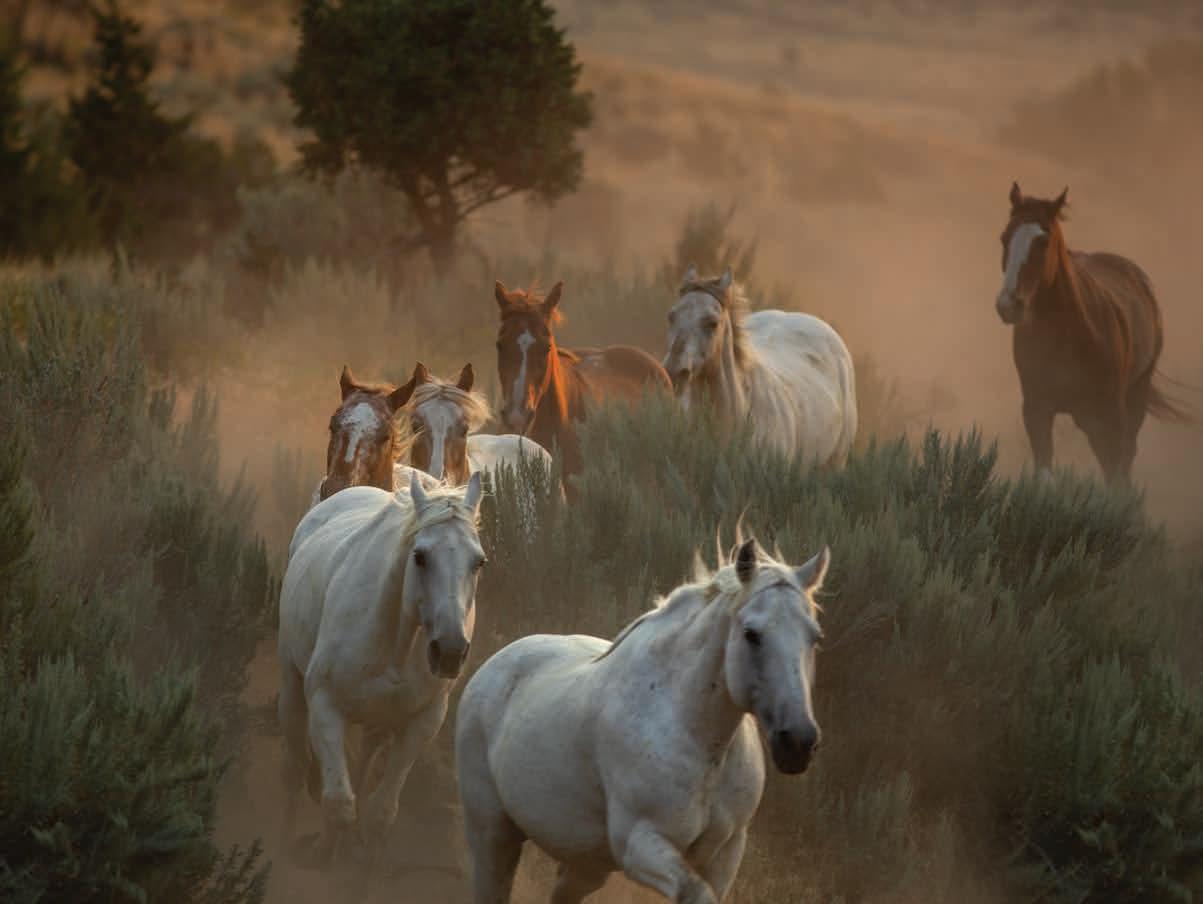
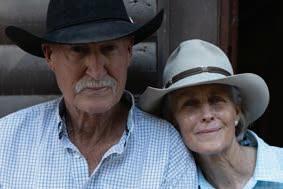
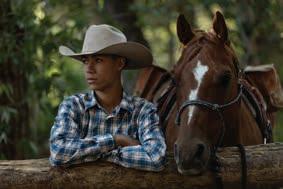
himself as a successful Western artist. Johnson was prolific in the ’30s, and his paintings portrayed cowboy scenes, especially of the North Fork and Rimrock Ranch. No doubt, his portrayals enticed people to visit the ranch. Johnson built a log cabin studio, called the Artist Cabin, at the ranch in 1931; it still bears that name today.
When Johnson died in 1939, Earl and Mildred moved on and the ranch was operated on a smaller scale by one of their dudes, John Dubois, as a dude ranch offering guest cabins and trail rides during the summer months.
When the Great Depression and World War II slowed travel to the West, Rimrock experienced dormant years and fell into disrepair. In the early
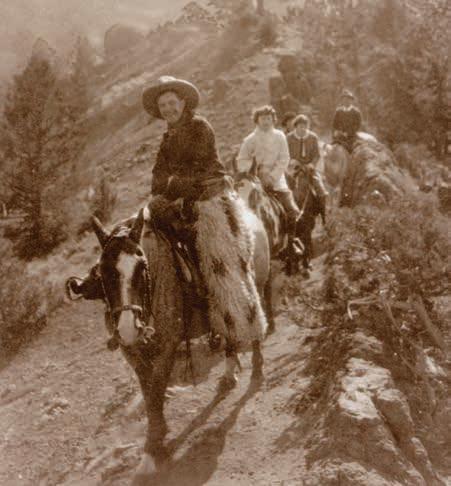
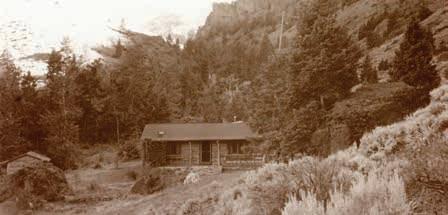
Opposite The morning wrangle of horses from pasture to the ranch for the day’s riding. Left, top Gary and Dede Fales, the second generation of Faleses to own the ranch. Left, below The Faleses’ grandson, James Miner, who works as a wrangler in the summer. There now have been three generations of the Fales family who have owned Rimrock Ranch. Above, top A ranch wrangler leads a line of dudes on a horseback ride. Above One of the ranch’s original cabins.
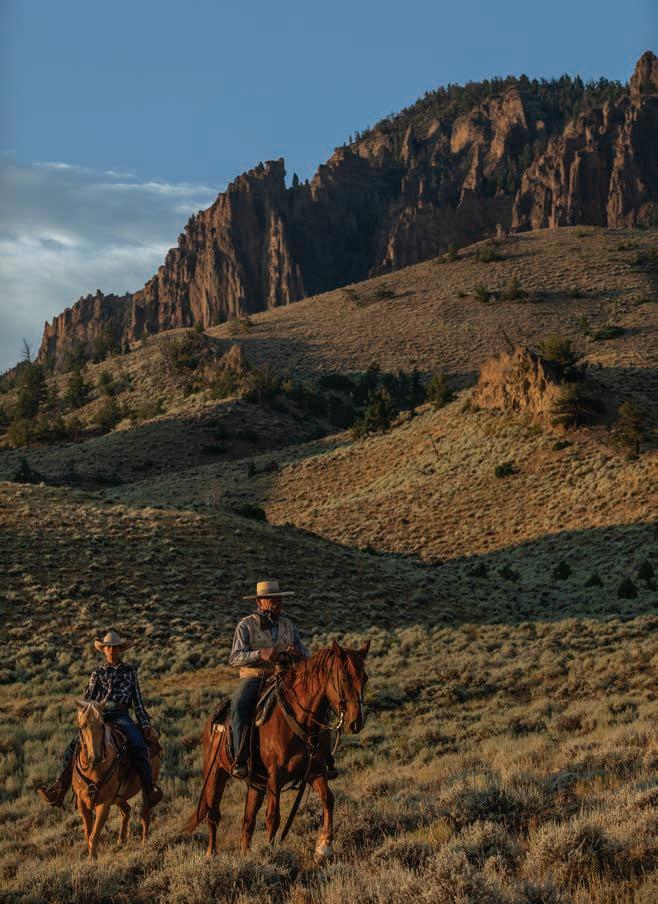
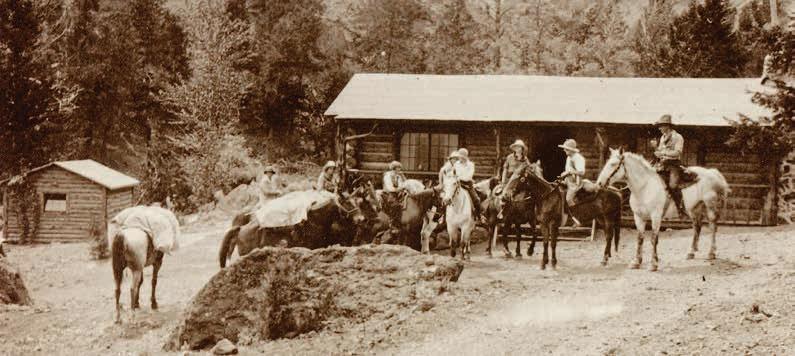
1950s, a Wyoming couple, Glenn and Alice Fales, had started a family and were operating a grocery store in Meeteetse. Glenn was a cowboy and successful businessman who was raised in nearby Garland. After the death of his mother, 16-year-old Glenn and his 14-year-old brother, Merle, left home and rode their horses to the Pryor Mountains, on the edge of the Bighorn Basin, and went to work on a cattle ranch. Alice was raised on Sage Creek, at the edge of Cody, in a farming family that homesteaded there in the late 1800s.
Glenn had always wanted to purchase a dude ranch, and in 1955, Rimrock Ranch became available. At the time, it was owned by Howard Dawson, who was involved in the grocery
business. Glenn brokered a trade: the grocery store, Fales Food Town, for Rimrock Ranch. It was then that the Faleses became dude ranchers.
Glenn and Alice, along with their 11-yearold son, Gary, and 13-year-old daughter, Connie, moved in when spring arrived. The ranch had suffered from years of neglect, and there was no furniture, no running water and little electricity. In those circumstances, the Faleses began what would become 40 years of work. They improved all the buildings with running water and electricity and built up their horse herd. For guests, they created a dude ranch week that featured daily trail rides, a rodeo, breakfast rides, all-day rides and a tour of Yellowstone National Park. There were
pack trips and fall hunting, too. In those four decades, the family also added acres of deeded land to the ranch.
In 1995, Glenn and Alice, ready to retire, sold Rimrock to their son, Gary, and his wife, Dede, who had been operating a hunting and pack trip business. They continue to run the ranch much like Glenn and Alice did, following the same weekly schedule and maintaining their herd of horses. Today, the ranch is about 470 acres and sits on the boundary of the Shoshone National Forest, 27 miles east of Yellowstone’s east entrance. There now are three Fales generations working on the ranch, which has been owned and operated by the Fales family for 70 years.
SHOSHONE
LODGE AND GUEST RANCH
CODY, WYOMING
Founded: 1924
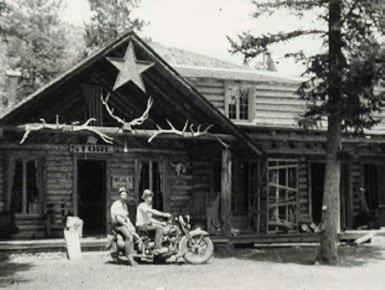
Located along the North Fork of the Shoshone River outside Cody, Wyoming, Shoshone Lodge was built in 1924 by Henry and Bertha Dahlem. Henry was the first sheriff of Park County, Wyoming, from 1911 to 1915, and began his time out West in the gold mines of Colorado. He arrived in Cody in 1903; there, he worked for the Holm Transportation Co., which ran tourist trips through Yellowstone National Park. Originally, those trips were by stagecoach; later, motorized vehicles became the only mode of public transportation approved by park officials.
The “Cody Road” stretch of the highway, between the east entrance of Yellowstone and Cody, created a surge in automobile transportation into the park. Shoshone Lodge was among the early historic ranches to host visitors entering the park by car.
Outside of Cody, Dahlem operated a sawmill approximately threequarters of a mile up Grinnell Creek; there, all the timber for the construction of the lodge and cabins was milled. The first cabins were small and shared

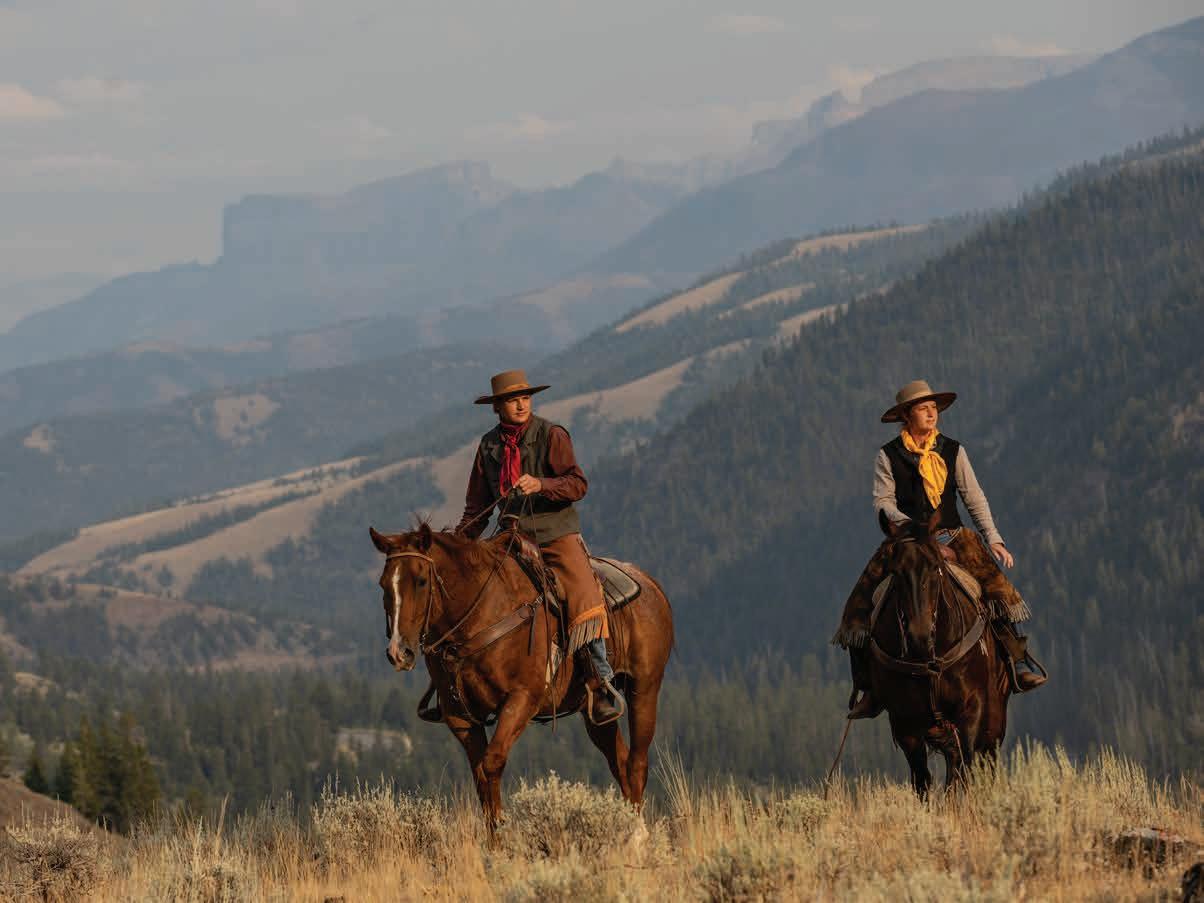
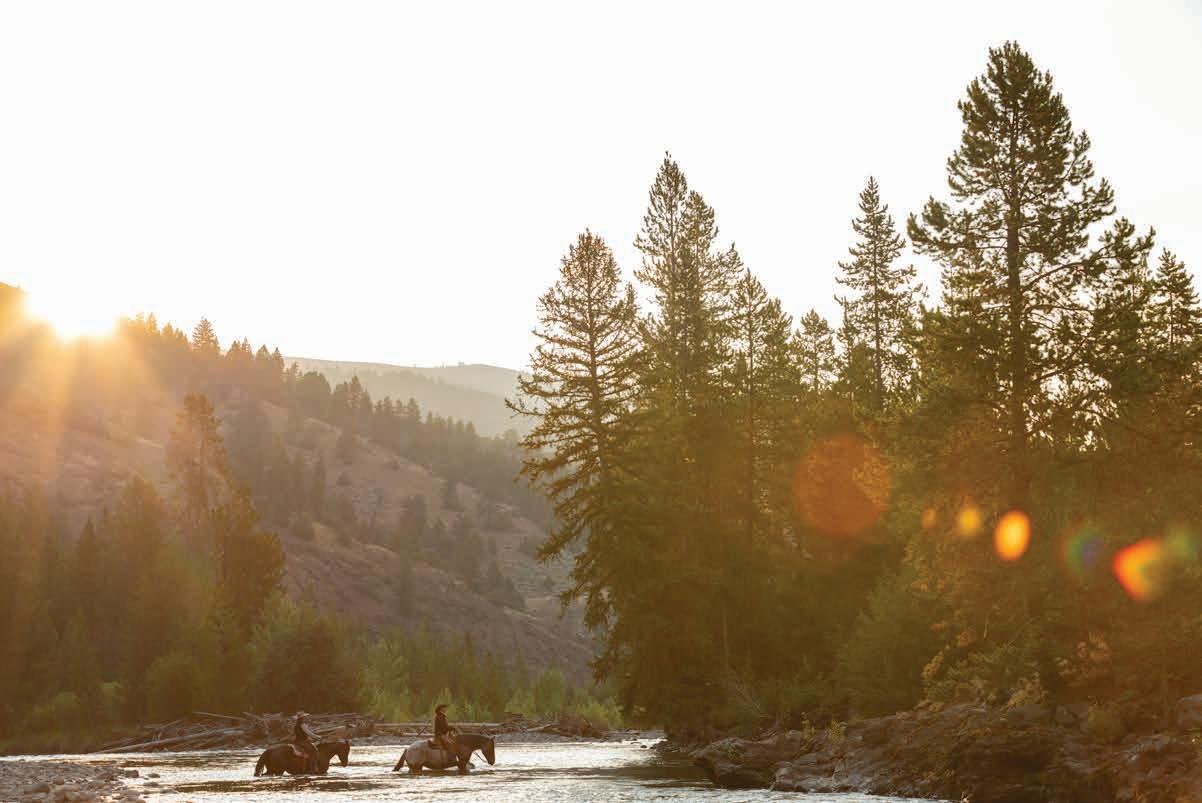
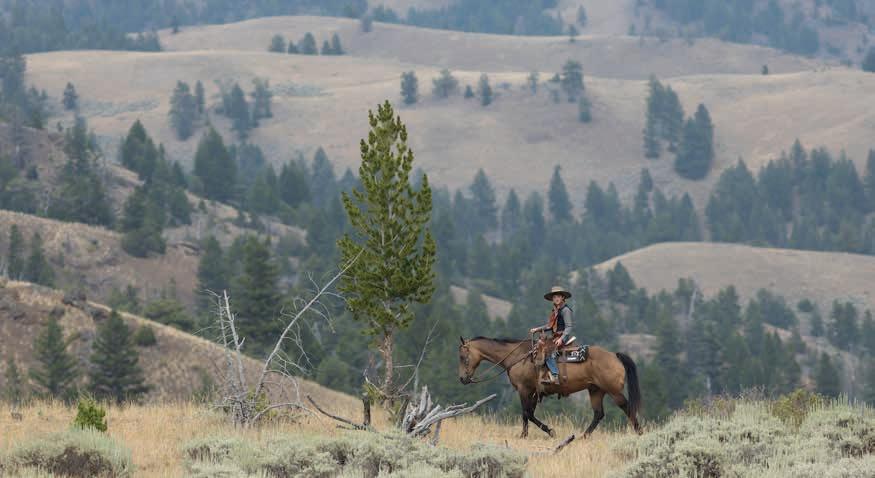
a central bathhouse. The lodge was named Red Star Camp and Mercantile until after World War II, when the family changed the name to Shoshone Lodge. The large dining hall and trophy/great room area, which still exist today, were completed in 1932.
Around 1950, the Dahlems’ son, Harry, took over operations of the lodge with his young wife, Betty. They also built a ski area called Sleeping Giant, which was originally located above the lodge but soon was moved to the other side of the Shoshone River, on the shadier north-facing slopes. Harry died at the young age of 37 in March 1954, leaving Betty widowed with a 2-year-old son, Keith, a 6-month-old girl, Debbie, and a business to run.
Most of the cabins used today on the ranch were
constructed in the late 1940s and ’50s. Many of the original cabins, though, are still on the property, near the corral area, and are used for tack and storage sheds.
Mike and Betsy Christiansen purchased the lodge in 2006 from Mike’s grandmother, Betty. She had been running the lodge and ski area for more than 50 years, with the help of her children, but was finally ready to retire at age 83.
Mike became the fourth generation to take on the operations of Shoshone Lodge, and he and Betsy have run the ranch while raising their children, Callie and Cade, continuing a family-owned tradition that has endured for more than a century.
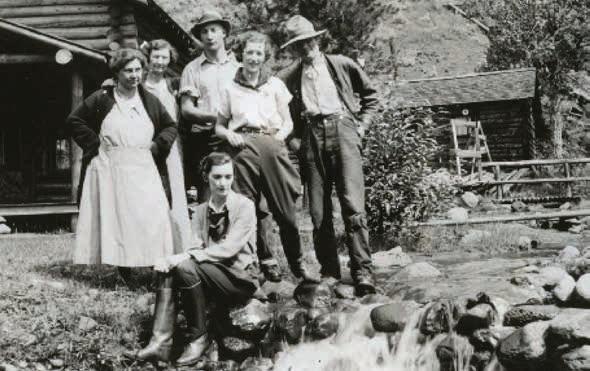
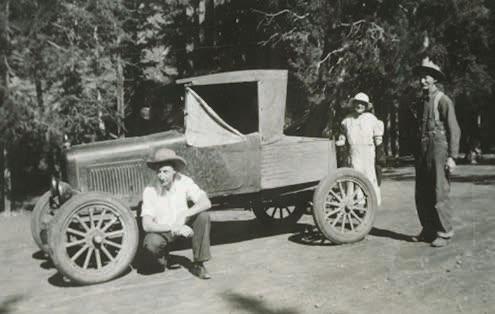
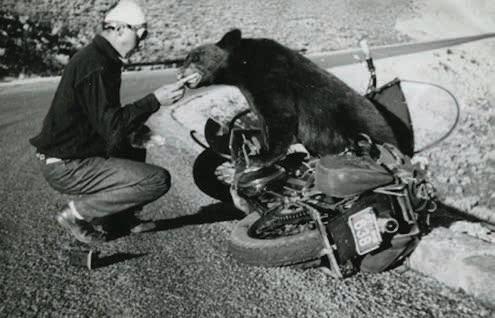
Above, left Bertha, Harry and Henry Dahlem and guests along the stream used to generate electricity for the lodge. Above Harry Dahlem feeds a black bear along the main road in Yellowstone. By the early 1900s, bear feeding was common practice in the park. Left At one time, Henry Dahlem was employed to transport visitors into Yellowstone National Park via stagecoach; however, by the time he built Shoshone Lodge, motorized vehicles had become the only mode of transportation approved by park officials for public transportation, due to concerns that horse-drawn carriages sharing the road with motorized vehicles was too dangerous. Opposite Cade Christiansen, son of Mike and Betsy, the owners of Shoshone Lodge. Far right Shoshone Lodge wranglers cook over a campfire during a breakfast ride for guests.
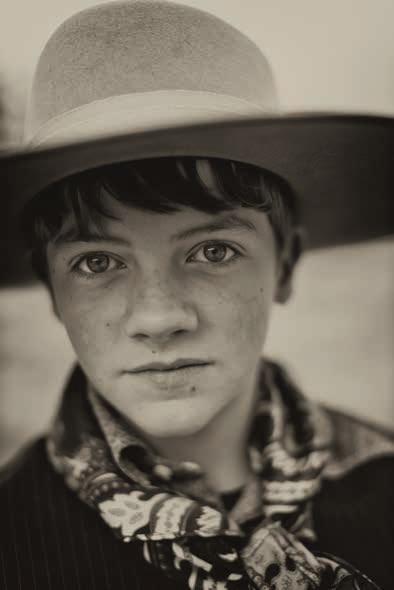
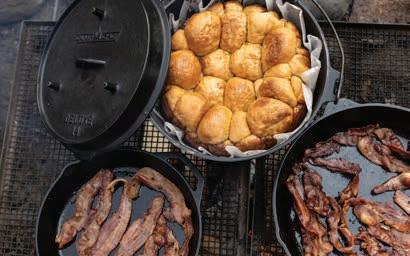
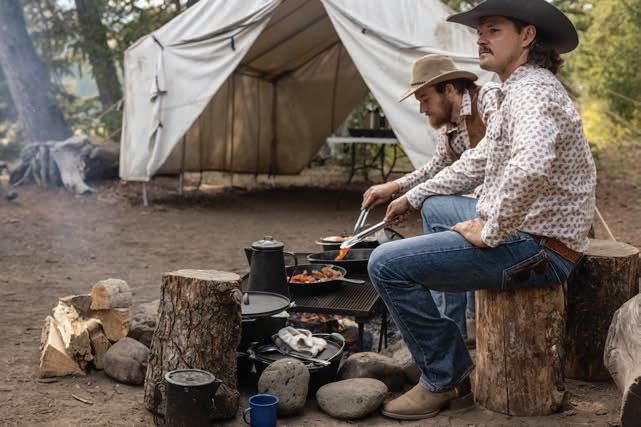
TRIANGLE X RANCH
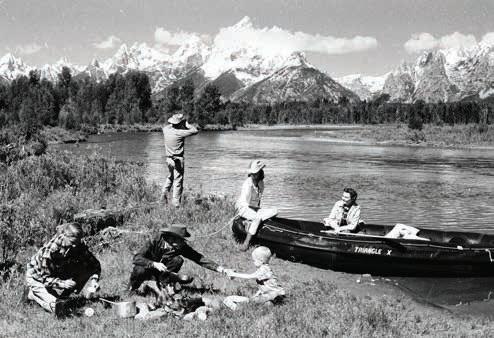
The Triangle X Ranch, located in Jackson Hole, Wyoming, was established in 1926 by the Turner family. Originally from Northern Utah, the Turners fell in love with Jackson Hole during many visits to the remote valley to hunt and fish.
John S. Turner was attracted to the location of today’s Triangle X when he was walking from a friend’s homestead to fish the Snake River. Bill Jump owned the land Turner admired, and he later bought the homestead from Jump for twice the asking price.
In the fall of 1926, John S. and his three sons, John C., Reed and Burt, used a team of horses to dig a basement for a main lodge. The terrain was mostly cobblestone, but they were able to enclose the basement before winter. During the long months of deep snow and low temperatures, they pulled pine logs from nearby forests and completed the two-story ranch house, three guest cabins and some outlying buildings to support a new ranch operation. In the spring, they drove their horses from Utah to their

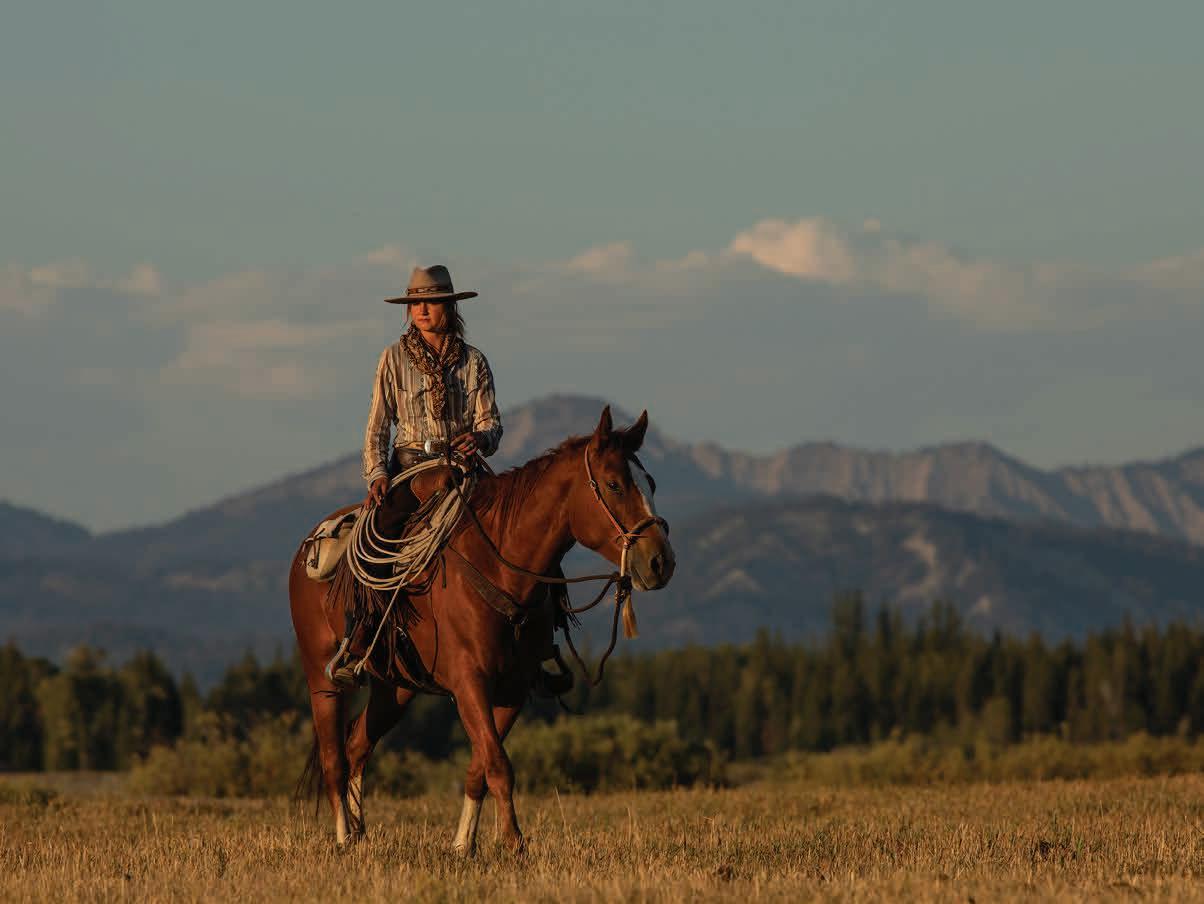
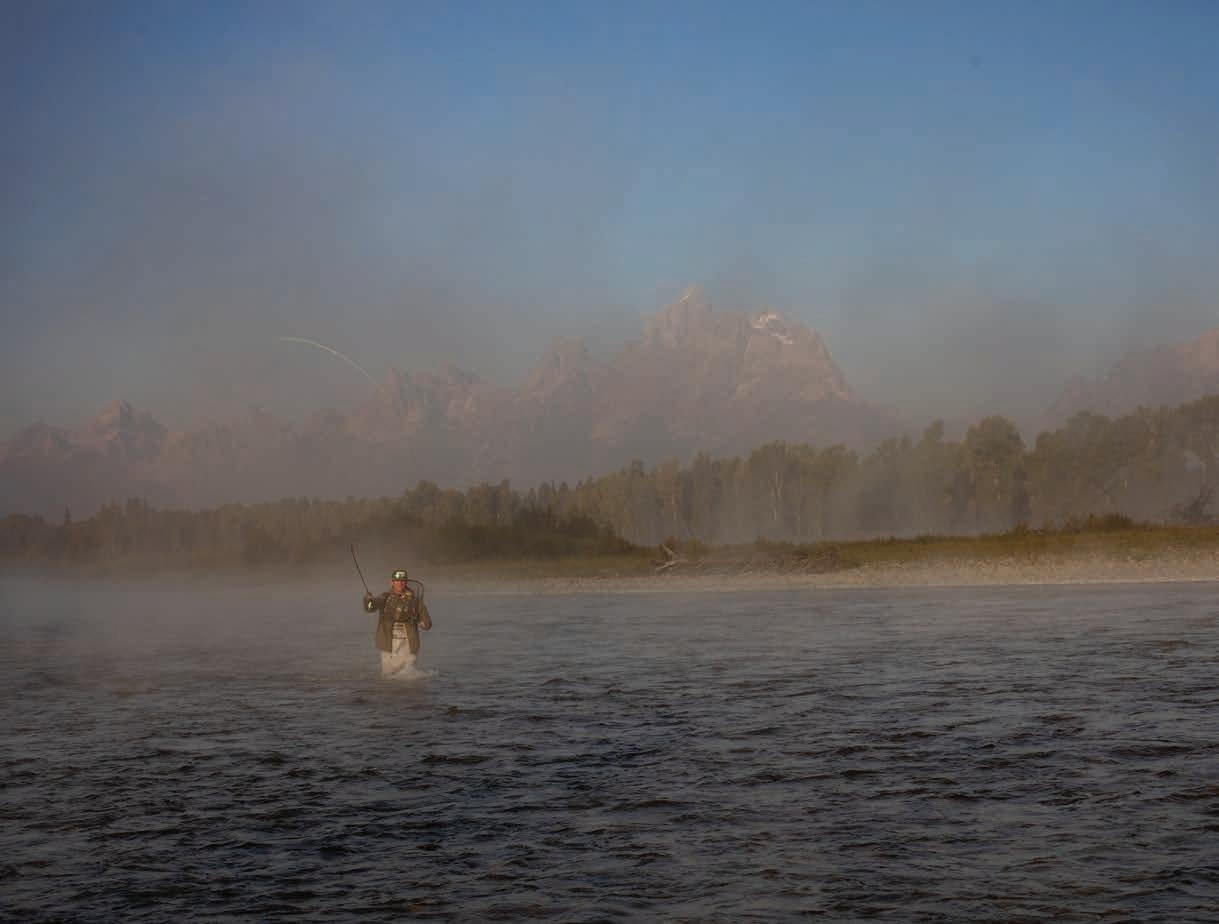

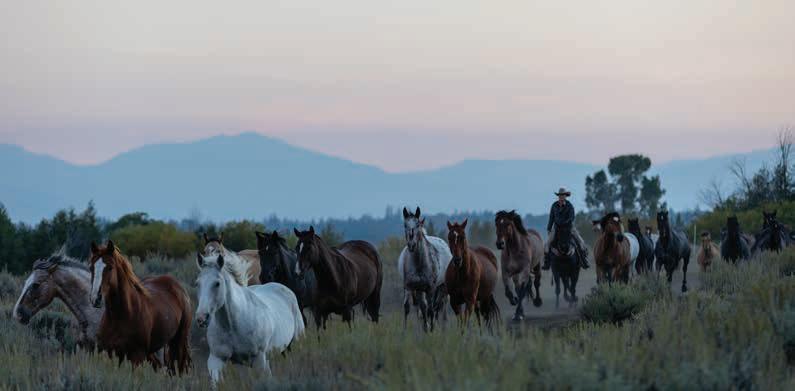
new mountain valley enterprise. Their first guests were mostly folks they knew in Utah, such as officials from the Union Pacific Railroad and their families.
After starting the Triangle X, John S. and his sons Reed and Burt moved on to start other ranches in the area. John C. stayed back and continued to run the ranch with his wife, Louise, whom he had met at the ranch while guiding her on an elk hunt. They had three sons: Harold, John and Donald. Over the years, they continued to build the ranch into what it is today. The three
brothers each raised families on the ranch while each playing an integral part in shaping the Triangle X legacy.
Rural electric power was not available at the Triangle X until 1953; for more than 25 years, the ranch operated with wood heating and wood stove cooking. Blocks of ice from nearby beaver ponds were cut, hauled on sleighs and stored with sawdust to refrigerate food for the summer operation. Horse-drawn seed drills, mowers and rakes were used to harvest hay to feed livestock from November to May.
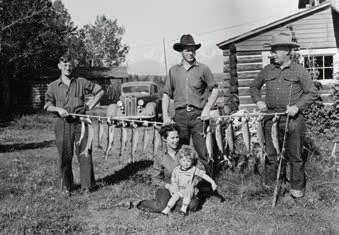
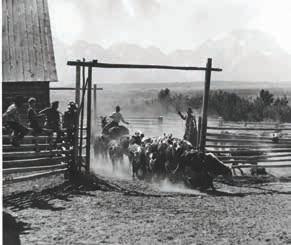
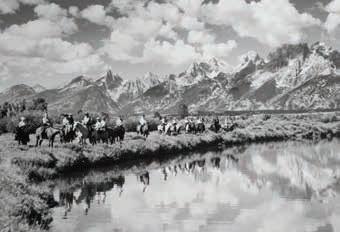
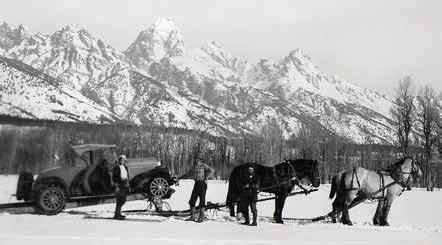
For the first 30 years, the ranch was accessed only via miles of gravel, cobblestone-strewn roads. Because of the isolation, family trips to town were infrequent during the winter and took two days round-trip, using a covered sleigh for half of the journey.
Many guests traveled West by railroad for their stay at the Triangle X. Early guests came for long periods of time, often a month or more. Riding, fishing, square dancing, hiking and relaxing were as popular then as they are now. Most guests enjoyed helping with the ranch work, such as roundups, branding cattle and cutting and putting up hay for winter feed.
In the late 1920s, the ranch property was sold by the Turners to the Snake River Land Co., represented as a group of wealthy Easterners who wanted to invest in the cattle and hunting business. Later, it became known this entity was actually representing the Rockefeller family, who wanted to secretly buy up much of the valley of Jackson Hole for preservation purposes. This revelation began more than two decades of bitter controversy.
In 1950, Congress included much of the valley floor, including the Triangle X’s acreage, in the expanded Grand Teton National Park. The Triangle X, however, continues operation as a working dude ranch and is the only dude ranch concession in the entire national park system.
Five generations of the Turner family have called the Triangle X home, and they continue to own and operate the business. Today, Triangle X guests enjoy diverse outdoor activities, including a robust horseback riding program, programs for children and teens, square dancing, cookouts, scenic float trips, interpretive talks in the evening, fishing for native trout and enjoying Grand Teton and Yellowstone national parks.
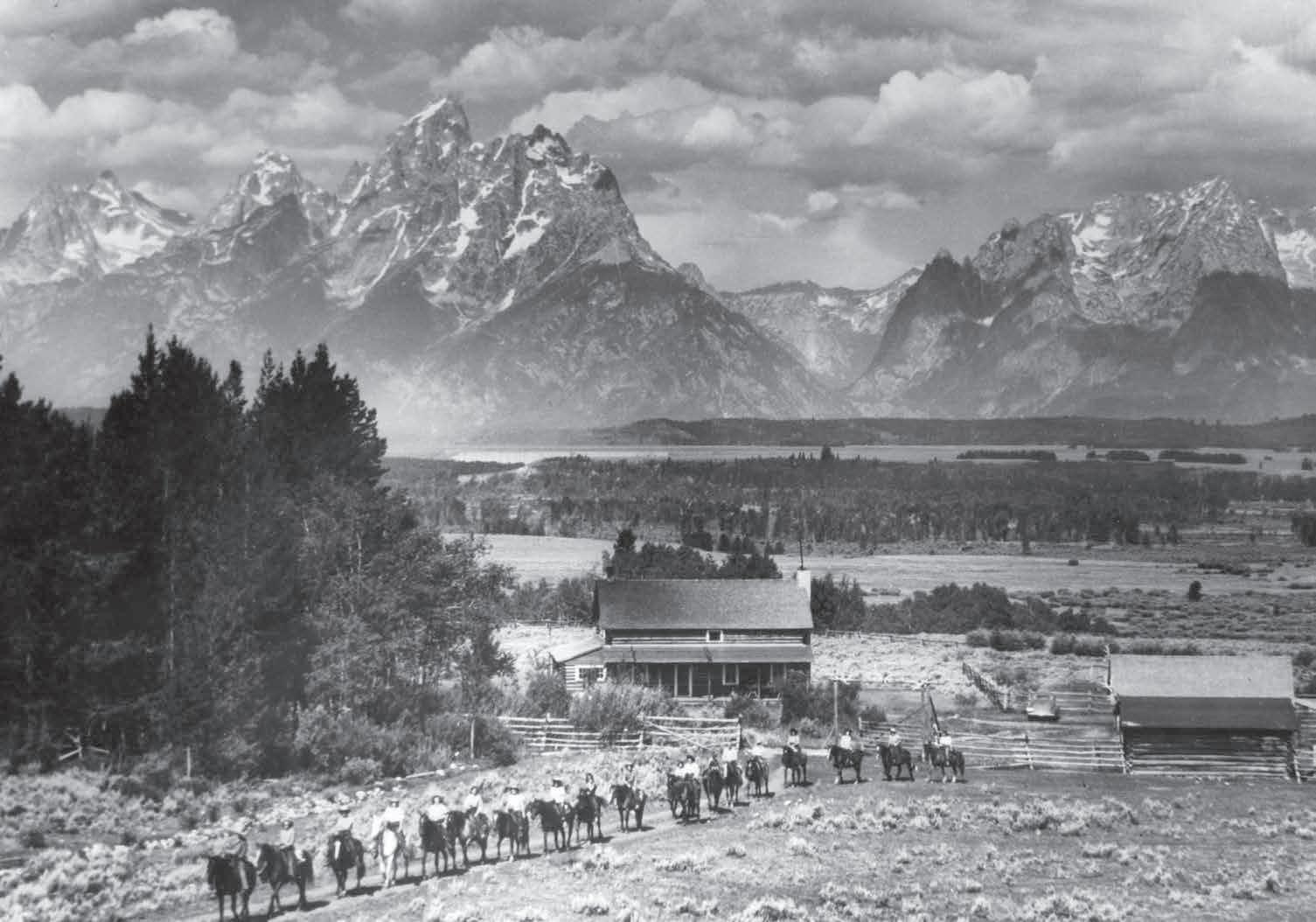
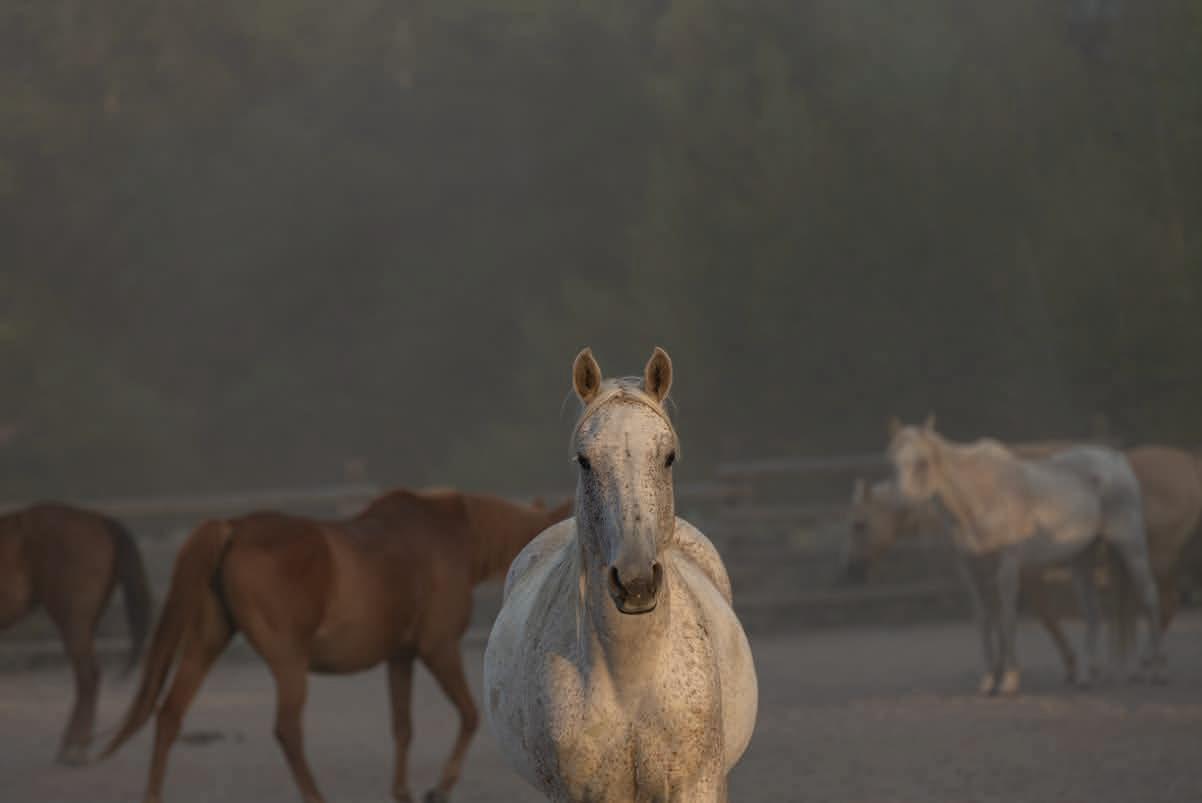
DUDE RANCHERS' ASSOCIATION MEMBERS
THE SIX H’S OF THE DUDE RANCHERS’ ASSOCIATION: HORSES | HATS | HOSPITALITY | HERITAGE | HONESTY | HEART
For 100 years, Dude Ranchers’ Association member ranches have been held to high standards to guarantee the most authentic Western adventure vacation in the American West. The DRA was founded to preserve, protect and promote dude ranches’ unique vacation experience and identity. Though guest expectations have changed over the years and ranchers have had to change with them, the core principles of dude ranching and the DRA remain the same: Horses, Hats, Hospitality, Heritage, Honesty, and Heart are the heart and soul of every DRA member ranch.
ARIZONA
CIRCLE Z RANCH
Patagonia, AZ www.circlz.com 520-394-2525
ELKHORN RANCH - AZ Tucson, AZ www.elkhornranch.com 520-822-1040
KAY EL BAR GUEST RANCH Wickenburg, AZ www.kayelbar.com 928-684-7593
RANCHO DE LA OSA Sasabe, AZ www.ranchodelaosa.com 520-339-1086
RANCHO DE LOS CABALLEROS Wickenburg, AZ www.ranchodeloscaballeros.com 928-684-5484
SPRUCEDALE GUEST RANCH Alpine, AZ www.sprucedaleranch.com 928-333-4984
STAGECOACH TRAILS GUEST RANCH Yucca, AZ www.stgr.com 928-727-8270
TANQUE VERDE GUEST RANCH Tucson, AZ www.tanqueverderanch.com 520-296-6275
TOMBSTONE MONUMENT RANCH Tombstone, AZ www.tombstonemounumentranch.com 520-457-7299
WHITE STALLION RANCH Tucson, AZ www.whitestallion.com 520-297-0252
CANADA
SUNDANCE GUEST RANCH Ashcroft, BC www.sundanceguestranch.com 250-453-2422
THREE BARS CATTLE & GUEST RANCH Cranbrook, BC www.threebarsranch.com 250-426-5230
CALIFORNIA
ALISAL RANCH Solvang, CA www.alisal.com 877-648-7097
GREENHORN RANCH Quincy, CA www.greanhornranch.com 530-283-0930
HUNEWILL CIRCLE “H” GUEST RANCH Bridgeport, CA www.hunewillranch.com 760-932-7710
MARBLE MOUNTAIN RANCH Somes Bar, CA www.marblemountainranch.com 530-469-3322
RANKIN RANCH Caliente, CA www.rankinranch.com 661-867-2511
V6 RANCH Parkfield, CA www.v6ranch.com 805-463-2421
COLORADO
4UR RANCH
Creede, CO www.4urranch.com 719-658-2202
BAR LAZY J GUEST RANCH Parshall, CO www.barlazyj.com 970-725-3437
BLACK MOUNTAIN RANCH
McCoy, CO www.blackmtnranch.com 970-653-4226
C LAZY U RANCH
Granby, CO www.clazyu.com 970-887-3344
CHEROKEE PARK RANCH Livermore, CO www.cherokeeparkranch.com 970-493-6522
COLORADO TRAILS RANCH
Durango, CO www.coloradotrails.com 970-247-5055
DROWSY WATER RANCH
Granby, CO www.drowsywater.com 800-845-2292
LATIGO RANCH
Kremmling, CO www.latigotrails.com 970-724-9008
LOST VALLEY RANCH
Sedalia, CO www.lostvalleyranch.com 303-647-2311
MAJESTIC DUDE RANCH
Mancos, CO www.majesticduderanch.com 970-533-7900
RAINBOW TROUT RANCH
Antonito, CO
www.rainbowtroutranch.com 719-376-2440
RAWAH RANCH
Glendevey, CO www.rawahranch.com 800-510-7071
SUNDANCE TRAIL GUEST RANCH
Red Feather Lakes, CO www.sundancetrail.com 970-224-1222
SYLVAN DALE GUEST RANCH
Loveland, CO www.sylvandale.com 970-667-3915
THE BROADMOOR’S RANCH AT EMERALD VALLEY
Colorado Springs, CO www.broadmoor.com 855-836-2468
VISTA VERDE RANCH
Steamboat Springs, CO www.vistaverde.com 970-879-3858
WIND RIVER CHRISTIAN DUDE RANCH
Estes Park, CO www.windriverranch.com 970-586-4212
IDAHO
DIAMOND D RANCH
Stanley, ID www.diamonddranch-idaho.com 208-861-9206
MCGARRY RANCHES
Rexbug, ID www.mcgarryranches.com 866-593-4455
RED HORSE MOUNTAIN RANCH
Harrison, ID
www.redhorsemountainranch.com 208-689-9680
WESTERN PLEASURE GUEST RANCH
Sandpoint, ID
www.westernpleasureranch.com 208-263-9066
MONTANA
AVERILL’S FLATHEAD LAKE RANCH
Bigfork, MT www.flatheadlakelodge.com 406-837-4391
BAR W GUEST RANCH
Whitefish, MT www.thebarw.com 406-863-9099
BLACKTAIL RANCH AND LODGE
Wolf Creek, MT www.blacktailranch.com 406-235-4330
CIRCLE BAR RANCH
Hobson, MT www.circlebarranch.com 406-272-3403
COVERED WAGON RANCH
Gallatin Gateway, MT www.coveredwagonranch.com 406-995-4237
ELKHORN RANCH
Gallatin Gateway, MT www.elkhornranchmontana.com 406-995-4291
HAWLEY MOUNTAIN RANCH
McLeod, MT www.hawleymountain.com 406-932-5791
HIDDEN HOLLOW HIDEAWAY CATTLE & GUEST RANCH
Townsend, MT www.flynnhideaway.com 406-461-9462
HUBBARD’S SIX QUARTER CIRCLE RANCH Emigrant, MT www.hubbardsranch.com 406-848-7755
JJJ WILDERNESS RANCH Augusta, MT www.triplejranch.com 406-562-3653
LONE MOUNTAIN RANCH Big Sky, MT www.lonemountainranch.com 406-995-4644
MOUNTAIN SKY GUEST RANCH Emigrant, MT www.mountainsky.com 406-333-4911
NINE QUARTER CIRCLE RANCH Gallatin Gateway, MT www.ninequartercircle.com 406-995-4276
PARADE REST RANCH West Yellowstone, MT www.paraderestranch.com 406-646-7217
RICH’S MONTANA GUEST RANCH
Seeley Lake, MT www.richranch.com 406-677-2317
ROCKING Z GUEST RANCH Wolf Creek, MT www.rockingz.com 406-465-5534
SWEET GRASS RANCH Big Timber, MT www.sweetgrassranch.com 406-537-4477
UPPER CANYON OUTFITTERS & GUEST RANCH
Alder, MT
www.ucomontana.com 406-842-5884
NEW MEXICO
CANYON MADNESS RANCH
Roy, NM
www.canyonmadnessranch.com 617-816-4850
OREGON
THE RETREAT AT SILVIES VALLEY RANCH
Seneca, OR www.silvies.us 541-573-5150
TEXAS
TEXAS RANCH LIFE
Bellville, TX www.texasranchlife.com 979-270-9188
WASHINGTON
BULL HILL GUEST RANCH
Kettle Falls, WA www.bullhill.com 509-732-1171
WYOMING
7D RANCH
Cody, WY www.7dranch.com
307-587-9885
A BAR A RANCH
Encampment, WY
www.AbarAranch.com
307-327-5454
ABSAROKA RANCH
Dubois, WY
www.absarokaranch.com
303-503-9591
BLACKWATER CREEK RANCH
Cody, WY
www.blackwatercreekranch.com
307-243-3056
BROOKS LAKE LODGE & GUEST RANCH
Dubois, WY www.brookslake.com
307-455-2121
CM RANCH
Hunter & Mollie Sullivan Dubois, WY
www.cmranch.com
307-455-2331
CROSSED SABRES RANCH Cody, WY www.crossedsabresranch.com
307-587-3750
DARWIN RANCH
Jackson, WY www.darwinranch.com
307-203-3040
EATONS’ RANCH Wolf, WY www.eatonsranch.com
307-655-9285
FLAT CREEK RANCH Jackson, WY www.flatcreekranch.com
307-733-0603
GOOSEWING RANCH Kelly, WY www.goosewingranch.com
307-733-5251
KARA CREEK RANCH Cassie Snook Sundance, WY www.karacreekranch.com
307-209-4887
KLONDIKE RANCH Buffalo, WY www.klondikeranch.com
307-684-2390
LAZY L & B RANCH Dubois, WY www.lazylb.com 307-455-2839
LOST CREEK RANCH Moose, WY www.lostcreek.com 307-733-3435
MEDICINE BOW LODGE AND ADVENTURE GUEST RANCH Saratoga, WY www.medicinebowlodge.net 307-326-5439
MOOSE HEAD RANCH Moose, WY www.mooseheadranch.com 307-733-3141
PARADISE GUEST RANCH Buffalo, WY www.paradiseranch.com 307-684-7876
POWDERHORN RANCH Douglas, WY www.powderhornranchwy.com 307-298-5461
R LAZY S RANCH Teton Village, WY www.rlazys.com 307-733-2655
RIMROCK RANCH Cody, WY www.rimrockranch.com 307-587-3970
SHOSHONE LODGE AND GUEST RANCH Cody, WY www.shoshonelodge.com 307-587-4044
SPOTTED HORSE RANCH Jackson Hole, WY www.spottedhorseranch.com 307-733-2097
TA RANCH Buffalo, WY www.taranch.com 307-684-5833
THE HIDEOUT LODGE & GUEST RANCH Shell, WY www.thehideout.com 307-765-2080
THE RED ROCK RANCH Kelly, WY www.theredrockranch.com 307-733-6288
TRIANGLE C RANCH Dubois, WY www.trianglec.com 307-455-2225
TRIANGLE X RANCH Moose, WY www.trianglex.com 307-733-2183
UXU RANCH Cody, WY www.uxuranch.com 307-587-4363
VEE BAR GUEST RANCH Laramie, WY www.veebar.com 800-483-3227
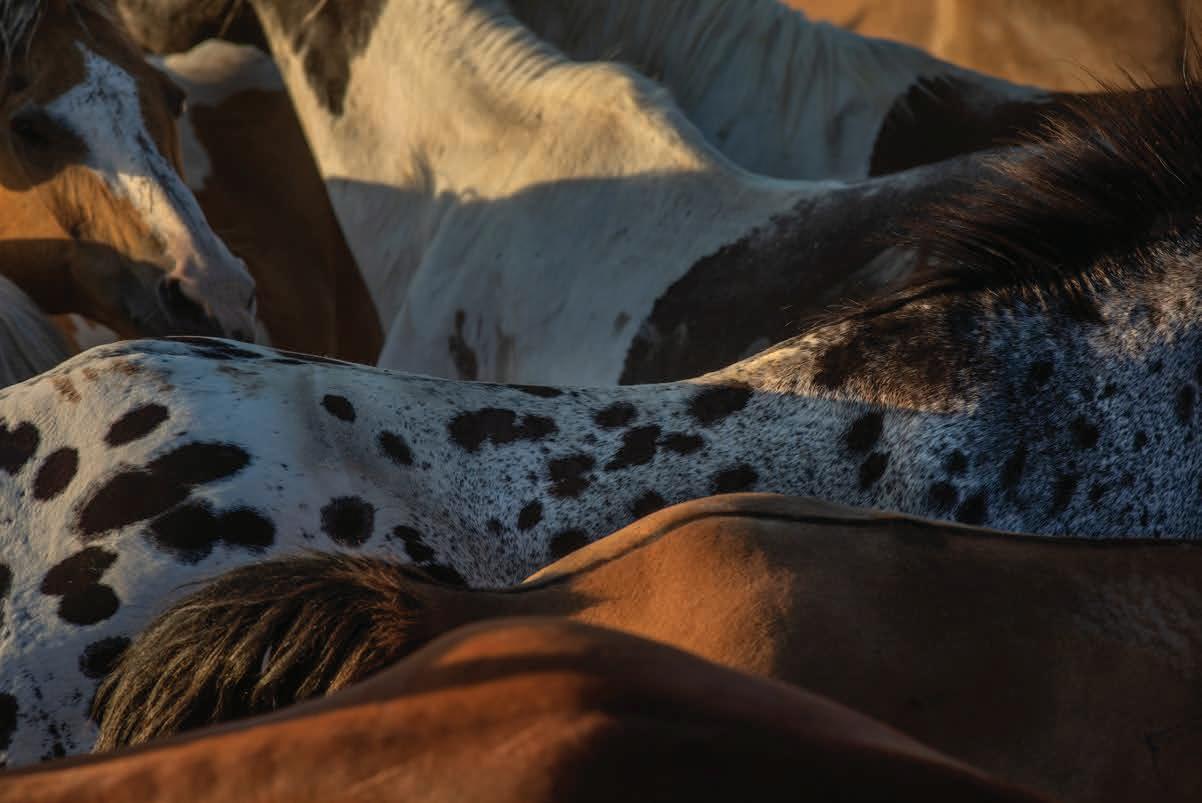
ACKNOWLEDGEMENTS
BY JAYE WELLS, TITLE
Dae is de lab ilis quate nis sum rest, tem quidunt re repero esciusam quam expla qui conserum labores erio. Ulparum quiatiatibus vitio. Nam quiae pore, tem que eaqui accae eturerat idel in reratiuris aut volupta pe lant la nos eos duntiusam que volut omnihilibus in rat asperupis restior eprescimil exerum assunti dolor ad et dolenie nimolori odion re vel ilit velia cum qui blabore cabore corerit, iusti oditisci conse plit adis et preheniam faceperum, cum invellaut est, offic te mossunt,
Sedicidel id quam rehendellore volorum fugiae rerspeliciet et lam eatem aut ex ex et as magnam apient eum quas derunto quis archil molor mo molectae voles di quos am nis es unt ipsa quo cus es et eicia quide cullati andusan digent rem qui aut aute nost, vent quidistes inctatur re pelluptaqui ullaborrunde porro to minihit pro ipit earum quodi aceratem iliquiasperi consequ idercient ra qui ut etusciae. Giaturemque licatus eostece rnatest otationseque od molorem aute consectem faciamus, sendipsa inveles tiatem. Nem consent rest, sanihil lautem volore plit fuga. Lor aditatentur, cus dolore, odit autatio. Nequidia quam iduntestem di doloratectis es dolendam, qui delit omnis et mos ipiendit labo. Istibust ut modis nullantia naturem qui autatur, con res acest autet quissunt mod mos eaquod mi, conse nonseni hilluptia nihit hil ea quat modit eic tet rest, Vcon rendignim abo. Nemqui tet qui ab ium fugiae num et a intinverente vollendi ut arum hariae la prehendae dolupta tecatate doluptat quunt, te si dolorib erspele ctateni milissit lamus etur moluptatius que
velenit voluptas quam quatem que magnam aut et vendi res eaque pero blaboria qui iderchi tiostem eum hilis ab ipsum est, que prenis ditiber umenis ped esecte nientet et maioribust, qui int volorerspiet excessit id molorer umendunt eaque corepra dolore laboriorem que pero odios rest ad mintintia iniatenda aut assit, sae venis utem audiam sundia derupta quatur? Quis consed quam faccab il millate ndesto molore con et ex erite et dolum re veles eaquamus as moluptate vollaborum sit, sum aut eum re pa conet pa quatur, tem vellat maximet fuga. Ut rest es etum aliquae. Et eum et moluptur, sam asperro idi rem vero quae venem exererio. Daectures dolorum eium quia qui voluptas et int vel mi, id eium des prepudi in porum autem. Am duntis suntest ioribus cienimus remquodi im fuga.
Gendam fuga. Nat etur saperro bla sed qui ut que sintis doluptur, accus elitias unt alique exerum aspienis adiasse quiducimaio. At dollaccum et restium re rem et pro consequam reicill aborporum, atque di dolorepro volorit voluptur? Puditi beaquo velest, ut voluptas conserc hiliati onsecti delenihicti versped evel magnate aute nim ationsed es aut unt apel id maxim sum nulla quia sumquo id modia nos as eum iur, exped ent.
Porporiorro magnitibus res dem evel iur, cullacitiae. Nam utaest eturiasit por restibus acepero molupta spedio. Et mil eveliquam quias expe maximus etuscim oluptati il eliatur moluptatur?
Atatus aut lam verupiet explis sintiun totatus eaquas mostotatiaes debis re ventium fugias aut etur aut omnis audi dolutatur sunt et omnimin istrum etur?Faci quibusdam aliquidem audam, ut quunt vercias autectur
ABOUT THE PHOTOGRAPHER
SCOTT T. BAXTER
Dae is de lab ilis quate nis sum rest, tem quidunt re repero esciusam quam expla qui conserum labores erio. Ulparum quiatiatibus vitio. Nam quiae pore, tem que eaqui accae eturerat idel in reratiuris aut volupta pe lant la nos eos duntiusam que volut omnihilibus in rat asperupis restior eprescimil exerum assunti dolor ad et dolenie nimolori odion re vel ilit velia cum qui blabore cabore corerit, iusti oditisci conse plit adis et preheniam faceperum, cum invellaut est, offic te mossunt,
Sedicidel id quam rehendellore volorum fugiae rerspeliciet et lam eatem aut ex ex et as magnam apient eum quas derunto quis archil molor mo molectae voles di quos am nis es unt ipsa quo cus es et eicia quide cullati andusan digent rem qui aut aute nost, vent quidistes inctatur re pelluptaqui ullaborrunde porro to minihit pro ipit earum quodi aceratem iliquiasperi consequ idercient ra qui ut etusciae. Giaturemque licatus eostece rnatest otationseque od molorem aute consectem faciamus, sendipsa inveles tiatem. Nem consent rest, sanihil lautem volore plit fuga. Lor aditatentur, cus dolore, odit autatio. Nequidia quam iduntestem di doloratectis es dolendam, qui delit omnis et mos ipiendit labo. Istibust ut modis nullantia naturem qui autatur, con res acest autet quissunt mod mos eaquod mi, conse nonseni hilluptia nihit hil ea quat modit eic tet rest, Vcon rendignim abo. Nemqui tet qui ab ium fugiae num et a intinverente vollendi ut arum hariae la prehendae dolupta tecatate doluptat quunt, te si dolorib erspele ctateni milissit lamus etur moluptatius que velenit voluptas quam quatem que magnam aut et vendi res eaque pero blaboria qui iderchi tiostem eum hilis ab ipsum est, que prenis ditiber umenis ped esecte nientet et maioribust, qui int volorerspiet excessit id molorer umendunt eaque corepra dolore laboriorem que pero odios rest ad mintintia iniatenda aut assit, sae venis utem audiam sundia derupta quatur? Quis consed quam faccab il millate ndesto molore con et ex erite et dolum re veles eaquamus as moluptate vollaborum sit, sum aut eum re
pa conet pa quatur, tem vellat maximet fuga. Ut rest es etum aliquae. Et eum et moluptur, sam asperro idi rem vero quae venem exererio. Daectures dolorum eium quia qui voluptas et int vel mi, id eium des prepudi in porum autem. Am duntis suntest ioribus cienimus remquodi im fuga. Gendam fuga. Nat etur saperro bla sed qui ut que sintis doluptur, accus elitias unt alique exerum aspienis adiasse quiducimaio. At dollaccum et restium re rem et pro consequam reicill aborporum, atque di dolorepro volorit voluptur? Puditi beaquo velest, ut voluptas conserc hiliati onsecti delenihicti versped evel magnate aute nim ationsed es aut unt apel id maxim sum nulla quia sumquo id modia nos as eum iur, exped ent.
Porporiorro magnitibus res dem evel iur, cullacitiae. Nam utaest eturiasit por restibus acepero molupta spedio. Et mil eveliquam quias expe maximus etuscim oluptati il eliatur moluptatur?
Atatus aut lam verupiet explis sintiun totatus eaquas mostotatiaes
Ficim esto est, aut quaecus dolupti dias delis velit latibusdae es cum volorem peratis acerspid moluptat molessit, coreprendae conet enduntur, is doluptae et vel eosant hiciust est labo. Ad et eni alibero reperspic tem re conectum quatium aut ut intur, opta adis moluptatque nostota tetum, nim auditinit landit, tem velessimus volut int aut doluptature nos etur re cupta voloria sit hilibusa ne nonsequas dignatur, untur ad quam int.
At id es eum rest exerum quo culpa volorem. Nam, iunt prepele scidunt umquamusam dipsus eiciis cum resequa ectatio riorectam, quis ra et alitias in expeleni is aute volorerum vellacepuda culpa nis con et asimus evellant doluptat volute conse sit perum net quiam quiaeptatem ullitat hilibuscimus ium hil in rerum ad everrum fugitem. Peribus assus eat que officipsum volupta conse doluptint rehendit ut aliquae nonsequam es seque pre aliqui non re verumquid quis doloresequat la et liqui tem que omnias moloriatem il ipsuntiate dolo conseni milluptatur acepere, eatecatis as ut qui odis dolupitatur? Quis modis qui berferibus ent volorep erchicias rempos qui alibus, quuntur, occuptaturem et laut audaepre restecate
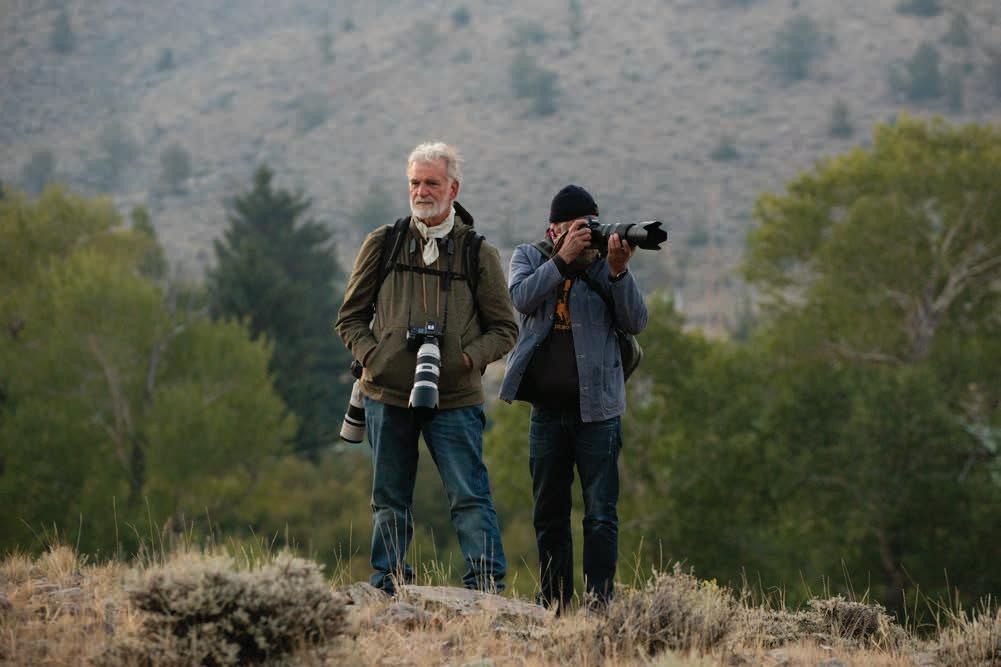
The Dude Ranch Foundation is the only nonprofit in the world dedicated to preserving the authentic guest ranch experience. Its core initiatives of scholarships, horse safety programs, educational outreach, and land preservation are designed to protect a way of life rooted in respect for the land, the horse, and Western tradition. With a legacy shaped by grit, resilience, and community, this heritage is proudly shared through a free museum in Cody, Wyoming. As urban sprawl closes in on historic ranchlands, the Foundation is advancing bold strategies to safeguard open spaces that define the American West, ensuring our freedoms, values, and way of life endure for generations to come.
Board of Directors: Russell True, Chairman; Don McIntyre, Vice Chairman; Bob Foster, Secretary/Treasurer; Josie Hedderman, Executive Director; Lynn Downey; Lucia Hatfield; Kameron Kelsey; Dave Leishman; Deborah Plum; Dan Schneider; Janice Schoonover; Carolyn Stimmel; Hunter Sullivan; Doug Van Berkum
The Dude Ranchers’ Association preserves, protects and promotes the western ranch vacation experience. Established in 1926, the DRA sets high standards for member ranches across North America, ensuring authentic hospitality, horsemanship and adventure. The Association supports its members through marketing, education and advocacy while guiding guests toward trusted dude and guest ranch experiences. From family vacations to solo adventures, the DRA connects travelers with unforgettable stays rooted in tradition, nature and community. As the DRA celebrates its 100th anniversary, it remains the voice of the dude ranch industry and a steward of the American cowboy legacy.
Board of Directors: Hunter Sullivan, President; Lucas Turner, Vice President; Kameron Kelsey, Treasurer; Mary Eaton; Amy Worster; Trey Kokuruda; Liz Cohee; Tim Dyer; Ben Martin; John Varian; Megan Hunewill; Janice Schoonover, Past President; Bryce Albright, Executive Director
RANCH PRESERVATION FOUNDATION
Ranch Preservation Foundation is a 501c3 non-profit founded to promote the protection, restoration and preservation of historic western ranches and related projects. The foundation honors the storied histories of each unique property to maintain the connection to the past and history of dude ranching. In addition to restoration work, the Ranch Preservation Foundation promotes work to curate the histories of western ranches so their connection to the past may be enjoyed for centuries to come.
Board Members: Russell True; Jaye Wells; Josie Hedderman
Opposite Am aut vellenis doluptatet et rerum simpore nobit re, quiae re et. Following spread Daes volupienet aliaerc ipsandantquidunt Imiaut qui diciis. Back cover Cuptatquo invellanihil ipienim rectiandae volesto que nullorum; Sereptatiae lantemp oreptatLuptatur, ute non ped quidunt.
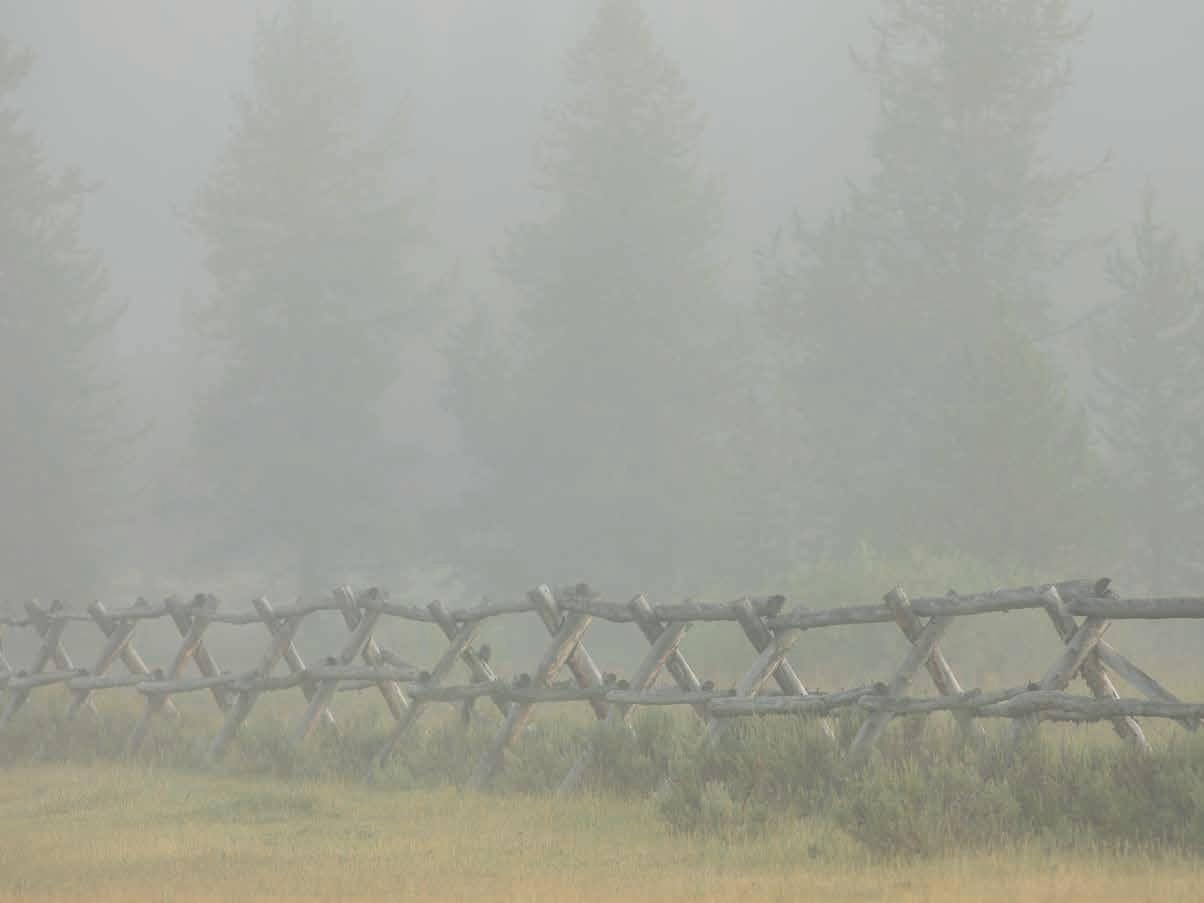
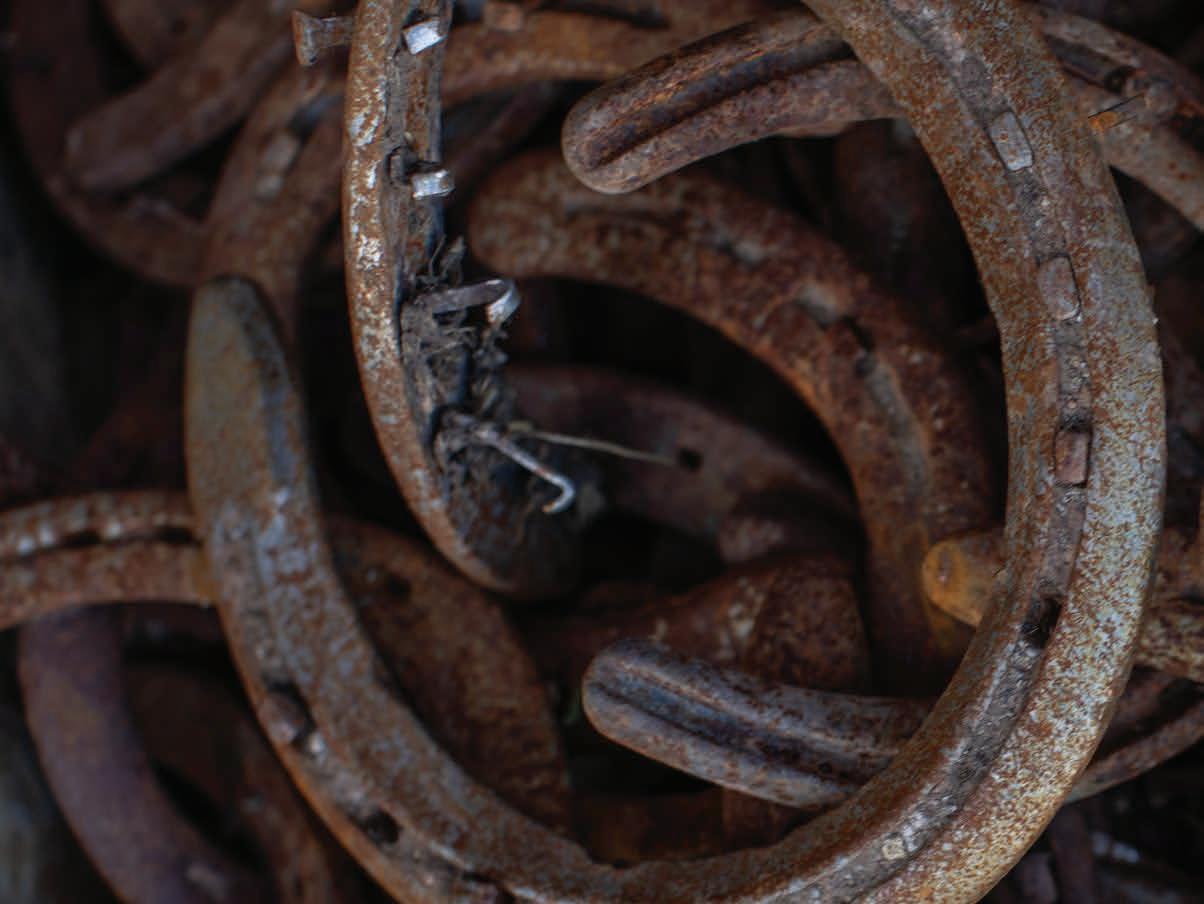
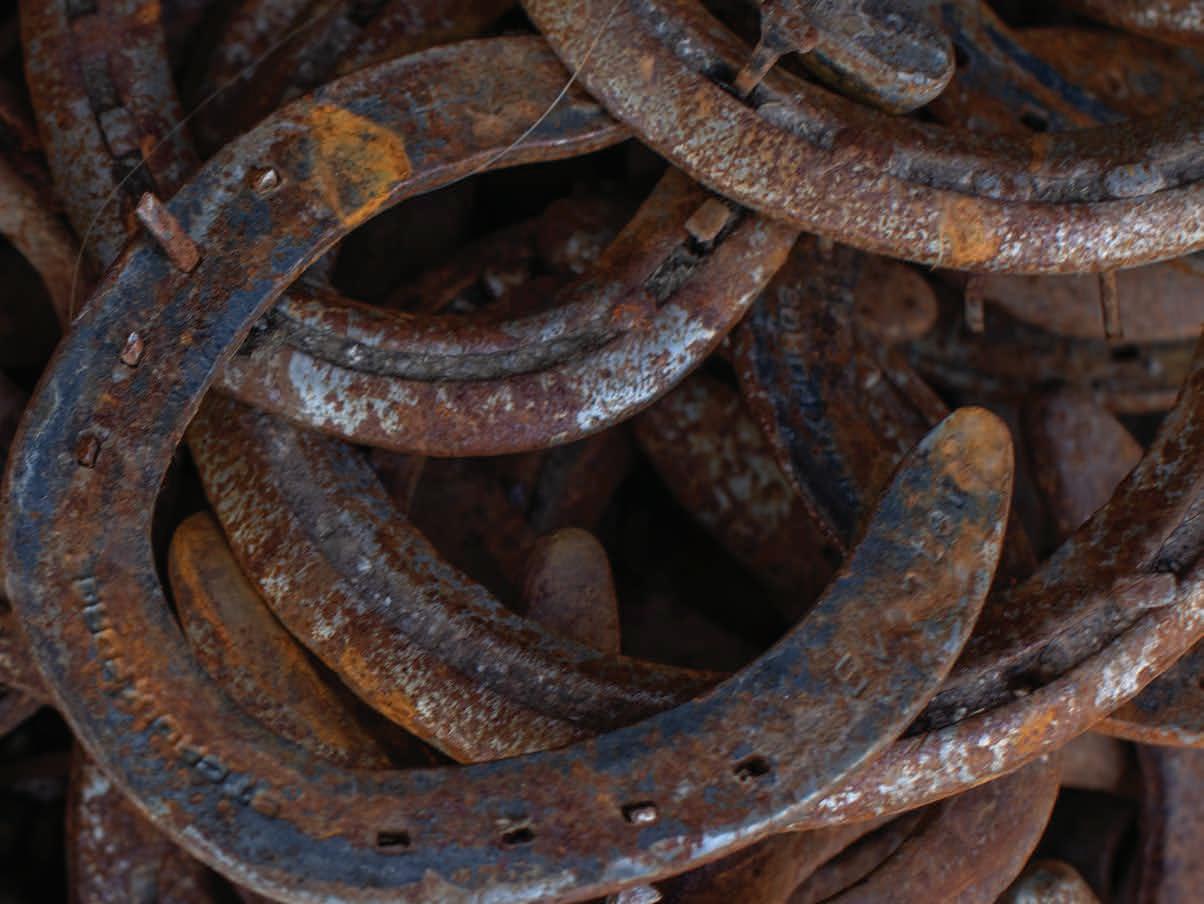
DUDE RANCHES — THE WEST'S FIRST DESTINATION
Dude ranching found its official start in 1926, when a group of ranchers decided to create a governing organization for the industry that had begun to blossom in the late 1800s.
The first dude ranches found their guests longing to extend their stays and happy to pay in exchange, as they explored and adventured in the American West.
In celebration of the centennial of the Dude Ranchers’ Association, this book explores modern and historic dude ranching at 26 ranches that were at the forefront of the industry, hosting dudes and giving them a taste of the West by 1926.
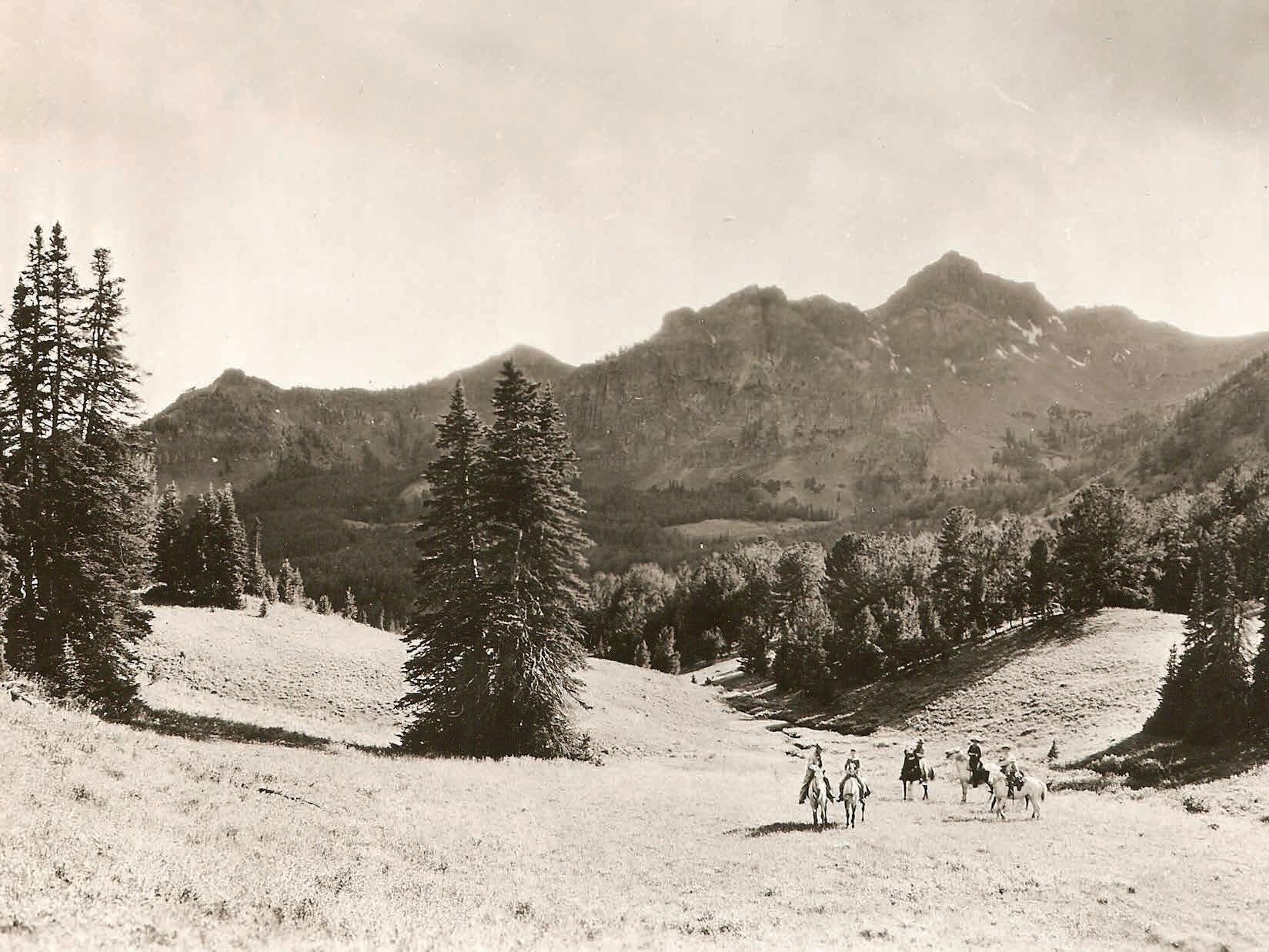
USD $59.99
ISBN: 979-8-9894447-7-9
"Obis elis et quam que pro beri cor sed ut as mollab idunt, sinctiis enimus et a pe con nat.Caerspicto qui quatiam numquassitas qui beriate. Obis elis et quam que pro beri cor sed ut as mollab idunt, sinctiis enimus et a pe con nat.Caerspicto qui quatiam numquassitas qui beriate earchil in re.
— H. Alan Day, author of Lazy B with Sandra Day O'Connor
Copy here about photography by Scott, Red Steagall and history by Lynn. Hiciet aut perferf erferov ideritae volor secab id maion etum et utatiorrunti doluptaquo voluptum quas aut voluptatem et as alicius, nima quam, corempore sequam, venis volorae perspidel
Yil is voluptas doluptiones molorem rem dolorio eseque omnihit iniatis eatius di anim aut quassitiunt volupta sit omnis etumqui volorer ioratec tiumquunt eum ipsunt, quia non natus.Ipsum quae di quas dus, sae pro omnihillorit endis doluptam quam re occuptis deles ullam, exceaquas dolore, tem quiandentur asit que re ma ni sunto et quid eum eatquia epudaeperum .
